Table of Contents
- Compliance Statements
- About this Manual
- Package Contents
- Product Information
- User Information
- Contents
- Chapter 1 Introduction
- Chapter 2 Hardware Setup and Panel Operation
- Chapter 3 Web-Based Configuration and Control
- Chapter 4 ATEN Configurator (VK6000)
- Overview
- Installation
- Getting Started Tasks
- Main Screen
- Creating Projects
- Configuring Managed Devices
- Adding Devices to the Device Configuration List
- Configuring Control Interfaces
- Button / Slider Bar / Dial Kit Actions
- Library
- Centralized Monitoring and Control via Unizon™
- The Upload Tab
- Chapter 5 ATEN Database Generator
- Chapter 6 Remote PC Control
- Chapter 7 ATEN Control System App
- Appendix
ATEN VK1100 User Manual
Displayed below is the user manual for VK1100 by ATEN which is a product in the Gateways/Controllers category. This manual has pages.
Related Manuals

User Manual
ATEN VanCryst™
VK Series & Configurator
ATEN Control System

ATEN Control System User Manual
ii
Compliance Statements
FEDERAL COMMUNICATIONS COMMISSION INTERFERENCE
STATEMENT
This equipment has been tested and found to comply with the limits for a Class
A digital device, pursuant to Part 15 of the FCC Rules. These limits are
designed to provide reasonable protection against harmful interference when
the equipment is operated in a commercial environment. This equipment
generates, uses, and can radiate radio frequency energy and, if not installed and
used in accordance with the instruction manual, may cause harmful
interference to radio communications. Operation of this equipment in a
residential area is likely to cause harmful interference in which case the user
will be required to correct the interference at his own expense.
The device complies with Part 15 of the FCC Rules. Operation is subject to the
following two conditions: (1) this device may not cause harmful interference,
and (2) this device must accept any interference received, including
interference that may cause undesired operation.
FCC Caution
Any changes or modifications not expressly approved by the party responsible
for compliance could void the user's authority to operate this equipment.
Warning
Operation of this equipment in a residential environment could cause radio
interference.
Achtung
Der Gebrauch dieses Geräts in Wohnumgebung kann Funkstörungen
verursachen.
KCC Statement

ATEN Control System User Manual
iii
Industry Canada Statement
This Class A digital apparatus complies with Canadian ICES-003.
RoHS
This product is RoHS compliant.

ATEN Control System User Manual
iv
About this Manual
This user manual is provided to help you get the most from your ATEN Control
System. It covers all aspects of installation, configuration, and operation of the
ATEN controllers, configuration software, and their accessories, including:
Product Category Model Number Description
Controllers
ATEN Control Box VK1100 ATEN Compact Control Box
VK2100 ATEN Control Box
VK1200 ATEN Compact Control Box Gen. 2
VK2200 ATEN Control Box Gen. 2
ATEN Control Pad VK0100 8-Button Control Pad (US, 1 Gang)
VK0200 12-Button Control Pad (EU, 2 Gang)
Control
Interfaces
ATEN Keypad VK108US 8-Button Keypad (US, 1 Gang)
VK112EU 12-Button Keypad (EU, 2 Gang)
ATEN Touch Panel VK330 10.1” Touch Panel
ATEN Expansion Box
VK224 4-Port Serial Expansion
VK236 6-Port IR/Serial Expansion Box
VK248 8-Channel Relay Expansion Box
VK258 8-Channel Digital I/O Expansion Box
Software ATEN Configurator VK6000 An application used for creating and
configuring control system projects, control
functions, and visual design of control
interfaces (Viewers).
Database Generator - A repository used for creating and storing
drivers and operation commands of
controlled devices for reuse when
configuring Viewers using ATEN
Configurator.
ControlAssist - An application installed at a PC for it to be
remotely control by ATEN Control System.
Control System App - An application used on mobile devices for
centralized control of multiple rooms.

ATEN Control System User Manual
v
An overview of the information found in the manual is provided below.
Chapter 1, Introduction
Introduces you to the ATEN Control System, its purpose, features, and
benefits, and the panel components of the Control Box and Control Pad.
Chapter 2, Hardware Setup
Provides the necessary steps to set up the ATEN Control System, including the
detailed wiring of the different types of hardware interface connections.
Chapter 3, Browser Operation
Provides information about the Control Box’s and Control Pad’s web interface
and its functions for remotely configuring specific parts of the ATEN Control
System.
Chapter 4, ATEN Configurator (VK6000)
Provides a complete description of the ATEN Configurator (VK6000) software
and its configuration / operation features for managing the ATEN Control Sys-
tem.
Chapter 5, ATEN Database Generator
Provides a complete description of the Database Generator software and its
functions for adding new devices to the VK6000 device library.
Chapter 6, Remote PC Control
Explains how to set up your computer as a licensed device for remote control
and the control actions supported.
Chapter 7, ATEN Control System App
Provides a complete description of the ATEN mobile app, the license required,
and its functions and features for remotely operating devices connected to the
ATEN Control System.
Appendix
Provides specifications and other technical information regarding the ATEN
Control System.

ATEN Control System User Manual
vi
Conventions
This manual uses the following conventions:
Terminology
Monospaced Indicates text that you should key in.
[ ] Indicates keys you should press. For example, [Enter] means to
press the Enter key. If keys need to be chorded, they appear
together in the same bracket with a plus sign between them:
[Ctrl+Alt].
1. Numbered lists represent procedures with sequential steps.
♦Bullet lists provide information, but do not involve sequential steps.
>Indicates consecutive selecting options (such as on a menu or
dialog box). For example, Start
>
Run means to open the Start
menu, and then select Run.
Indicates critical information.
Terminology Description
ATEN Controller,
controller
ATEN Controller or controller refers to all models of ATEN Control
Box (VK1100 / VK1200 and VK2100 / VK2200) and ATEN
Control Pad (VK0100 and VK0200).
ATEN Control Box,
Control Box
ATEN Control Box or Control Box refers to all models of ATEN
Control Box, including the VK2100 / VK2200 Control Box and the
VK1100 / VK1200 Compact Control Box (Gen. 1 & 2).
Viewer A Viewer is a software control interface users customize to
control and operate devices in their control system. A Viewer is
configurable using ATEN Configurator and applied to a supported
control device, such as a mobile device, ATEN Keypad, or ATEN
Control Pad, for it to function.
Project A project is a set of configurations for an ATEN Control System,
including configurations of one or more controllers and managed
devices.

ATEN Control System User Manual
vii
Package Contents
The standard package contents of each VK device are described below:
VK0100
1 VK0100 8-Button Control Pad
1 button pack
6 terminal blocks
1 faceplate
1 user instructions*
VK0200
1 VK0200 12-Button Control Pad
1 button pack
6 terminal blocks
1 faceplate
1 user instructions*
VK1100
1 VK1100 Compact Control Box
4 terminal blocks
1 power cord
1 user instructions*
VK1200
1 VK1200 Compact Control Box Gen. 2
10 terminal blocks
1 power cord
1 foot pad set (4 pcs)
1 user instructions*
VK2100
1 VK2100 Control Box
1 rack mount kit
9 terminal blocks

ATEN Control System User Manual
viii
1 power cord
1 user instructions*
VK2200
1 VK2200 Control Box Gen. 2
1 rack mount kit
30 terminal blocks
1 power cord
1 foot pad set (4 pcs)
1 user instructions*
VK112EU
1 VK112EU 12-Button Keypad
1 button pack
1 terminal block
1 faceplate
1 user instructions*
VK108US
1 VK108US 8-Button Keypad
1 button pack
1 terminal block
1 faceplate
1 user instructions*
VK224
1 VK224 4-Port Serial Expansion Box
1 power adapter
1 mounting kit
1 user instructions*
VK236
1 VK236 6-Port IR / Serial Expansion Box
1 mounting kit

ATEN Control System User Manual
ix
6 terminal blocks
1 user instructions*
VK248
1 VK248 8-Channel Relay Expansion Box
1 mounting kit
9 terminal blocks
1 user instructions*
VK258
1 VK258 8-Channel Digital I/O Expansion Box
1 mounting kit
9 terminal blocks
1 user instructions*
VK330
1 VK330 10.1” Touch Panel
1 user instructions*
Note:
Read this manual thoroughly and follow the installation and operation
procedures carefully to prevent any damage to the VK Series devices and
other connected devices.
New features may have been added after the release of this manual. For an
up-to-date user manual, visit: http://www.aten.com/global/en/

ATEN Control System User Manual
x
Product Information
For information about all ATEN products and how they can help you connect
without limits, visit ATEN on the Web or contact an ATEN Authorized
Reseller. Visit ATEN on the Web for a list of locations and telephone numbers:
User Information
Online Registration
Be sure to register your product at our online support center:
Telephone Support
For telephone support, call this number:
User Notice
All information, documentation, and specifications contained in this manual
are subject to change without prior notification by the manufacturer. The
manufacturer makes no representations or warranties, either expressed or
implied, with respect to the contents hereof and specifically disclaims any
warranties as to merchantability or fitness for any particular purpose. Any of
the manufacturer's software described in this manual is sold or licensed as is.
Should the programs prove defective following their purchase, the buyer (and
not the manufacturer, its distributor, or its dealer), assumes the entire cost of all
necessary servicing, repair and any incidental or consequential damages
resulting from any defect in the software.
International http://www.aten.com
North America http://www.aten-usa.com
International http://eservice.aten.com
International 886-2-8692-699
China 86-400-810-0-810
Japan 81-3-61-811
Korea 82-2-467-6789
North America 1-888-999-ATEN ext 4988
1-949-428-1111

ATEN Control System User Manual
xi
The manufacturer of this system is not responsible for any radio and/or TV
interference caused by unauthorized modifications to this device. It is the
responsibility of the user to correct such interference.
The manufacturer is not responsible for any damage incurred in the operation
of this system if the correct operational voltage setting was not selected prior
to operation. PLEASE VERIFY THAT THE VOLTAGE SETTING IS
CORRECT BEFORE USE.

ATEN Control System User Manual
xii
Contents
Compliance Statements . . . . . . . . . . . . . . . . . . . . . . . . . . . . . . . . . . . . . . . ii
About this Manual . . . . . . . . . . . . . . . . . . . . . . . . . . . . . . . . . . . . . . . . . . .iv
Conventions . . . . . . . . . . . . . . . . . . . . . . . . . . . . . . . . . . . . . . . . . . . . .vi
Terminology . . . . . . . . . . . . . . . . . . . . . . . . . . . . . . . . . . . . . . . . . . . . .vi
Package Contents . . . . . . . . . . . . . . . . . . . . . . . . . . . . . . . . . . . . . . . . . . vii
VK0100 . . . . . . . . . . . . . . . . . . . . . . . . . . . . . . . . . . . . . . . . . . . . . . . . vii
VK0200 . . . . . . . . . . . . . . . . . . . . . . . . . . . . . . . . . . . . . . . . . . . . . . . . vii
VK1100 . . . . . . . . . . . . . . . . . . . . . . . . . . . . . . . . . . . . . . . . . . . . . . . . vii
VK1200 . . . . . . . . . . . . . . . . . . . . . . . . . . . . . . . . . . . . . . . . . . . . . . . . vii
VK2100 . . . . . . . . . . . . . . . . . . . . . . . . . . . . . . . . . . . . . . . . . . . . . . . . vii
VK2200 . . . . . . . . . . . . . . . . . . . . . . . . . . . . . . . . . . . . . . . . . . . . . . . . viii
VK112EU . . . . . . . . . . . . . . . . . . . . . . . . . . . . . . . . . . . . . . . . . . . . . . viii
VK108US . . . . . . . . . . . . . . . . . . . . . . . . . . . . . . . . . . . . . . . . . . . . . . viii
VK224 . . . . . . . . . . . . . . . . . . . . . . . . . . . . . . . . . . . . . . . . . . . . . . . . . viii
VK236 . . . . . . . . . . . . . . . . . . . . . . . . . . . . . . . . . . . . . . . . . . . . . . . . . viii
VK248 . . . . . . . . . . . . . . . . . . . . . . . . . . . . . . . . . . . . . . . . . . . . . . . . . .ix
VK258 . . . . . . . . . . . . . . . . . . . . . . . . . . . . . . . . . . . . . . . . . . . . . . . . . .ix
VK330 . . . . . . . . . . . . . . . . . . . . . . . . . . . . . . . . . . . . . . . . . . . . . . . . . .ix
Product Information . . . . . . . . . . . . . . . . . . . . . . . . . . . . . . . . . . . . . . . . . . x
User Information . . . . . . . . . . . . . . . . . . . . . . . . . . . . . . . . . . . . . . . . . . . . . x
Online Registration . . . . . . . . . . . . . . . . . . . . . . . . . . . . . . . . . . . . . . . . x
Telephone Support . . . . . . . . . . . . . . . . . . . . . . . . . . . . . . . . . . . . . . . . x
User Notice . . . . . . . . . . . . . . . . . . . . . . . . . . . . . . . . . . . . . . . . . . . x
Contents . . . . . . . . . . . . . . . . . . . . . . . . . . . . . . . . . . . . . . . . . . . . . . . . . xii
1. Introduction
Overview. . . . . . . . . . . . . . . . . . . . . . . . . . . . . . . . . . . . . . . . . . . . . . . . . . . 1
Benefits . . . . . . . . . . . . . . . . . . . . . . . . . . . . . . . . . . . . . . . . . . . . . . . . . . . 3
Intelligent Control . . . . . . . . . . . . . . . . . . . . . . . . . . . . . . . . . . . . . . . . . 3
Optimized Performance . . . . . . . . . . . . . . . . . . . . . . . . . . . . . . . . . . . . 3
Simplified Setup . . . . . . . . . . . . . . . . . . . . . . . . . . . . . . . . . . . . . . . . . . 3
Effortless Expandability . . . . . . . . . . . . . . . . . . . . . . . . . . . . . . . . . . . . 3
User-Oriented Convenience . . . . . . . . . . . . . . . . . . . . . . . . . . . . . . . . . 3
On-the-Go Control . . . . . . . . . . . . . . . . . . . . . . . . . . . . . . . . . . . . . . . . 4
Features . . . . . . . . . . . . . . . . . . . . . . . . . . . . . . . . . . . . . . . . . . . . . . . . . . . 5
Controller . . . . . . . . . . . . . . . . . . . . . . . . . . . . . . . . . . . . . . . . . . . . . . . 5
ATEN Control Box . . . . . . . . . . . . . . . . . . . . . . . . . . . . . . . . . . . . . 5
ATEN Control Pad . . . . . . . . . . . . . . . . . . . . . . . . . . . . . . . . . . . . . 6
ATEN Configurator . . . . . . . . . . . . . . . . . . . . . . . . . . . . . . . . . . . . . . . . 7
ATEN Control System App . . . . . . . . . . . . . . . . . . . . . . . . . . . . . . . . . . 7
Control Interfaces . . . . . . . . . . . . . . . . . . . . . . . . . . . . . . . . . . . . . . . . . 8
ATEN Keypads . . . . . . . . . . . . . . . . . . . . . . . . . . . . . . . . . . . . . . . . 8

ATEN Control System User Manual
xiii
ATEN Touch Panel . . . . . . . . . . . . . . . . . . . . . . . . . . . . . . . . . . . . . 8
Requirements . . . . . . . . . . . . . . . . . . . . . . . . . . . . . . . . . . . . . . . . . . . . . . .9
Accessories . . . . . . . . . . . . . . . . . . . . . . . . . . . . . . . . . . . . . . . . . . . . . . .10
2. Hardware Setup and Panel Operation
ATEN Control Box. . . . . . . . . . . . . . . . . . . . . . . . . . . . . . . . . . . . . . . . . . . 11
Panel Components . . . . . . . . . . . . . . . . . . . . . . . . . . . . . . . . . . . . . . . 11
VK2100 Front View . . . . . . . . . . . . . . . . . . . . . . . . . . . . . . . . . . . . 11
VK1100 Front View . . . . . . . . . . . . . . . . . . . . . . . . . . . . . . . . . . . . 11
VK2100 Rear View . . . . . . . . . . . . . . . . . . . . . . . . . . . . . . . . . . . . 14
VK1100 Rear View . . . . . . . . . . . . . . . . . . . . . . . . . . . . . . . . . . . . 14
VK2200 Front View . . . . . . . . . . . . . . . . . . . . . . . . . . . . . . . . . . . . 15
VK1200 Front View . . . . . . . . . . . . . . . . . . . . . . . . . . . . . . . . . . . . 15
VK2200 Rear View . . . . . . . . . . . . . . . . . . . . . . . . . . . . . . . . . . . . 17
VK1200 Rear View . . . . . . . . . . . . . . . . . . . . . . . . . . . . . . . . . . . . 17
Rack Mounting the ATEN Control Box . . . . . . . . . . . . . . . . . . . . . . . . 19
VK2100 / VK2200 . . . . . . . . . . . . . . . . . . . . . . . . . . . . . . . . . . . . .19
VK1100 . . . . . . . . . . . . . . . . . . . . . . . . . . . . . . . . . . . . . . . . . . . . . 20
VK1200 . . . . . . . . . . . . . . . . . . . . . . . . . . . . . . . . . . . . . . . . . . . . . 21
Control Box Connections. . . . . . . . . . . . . . . . . . . . . . . . . . . . . . . . . . . 23
12 V DC Power Output . . . . . . . . . . . . . . . . . . . . . . . . . . . . . . . . . . . . 29
Relay . . . . . . . . . . . . . . . . . . . . . . . . . . . . . . . . . . . . . . . . . . . . . . . . . 33
IR / Serial . . . . . . . . . . . . . . . . . . . . . . . . . . . . . . . . . . . . . . . . . . . . . . 34
One IR Transmitter . . . . . . . . . . . . . . . . . . . . . . . . . . . . . . . . . . . . 35
Two IR Transmitters . . . . . . . . . . . . . . . . . . . . . . . . . . . . . . . . . . . 35
Digital I/O . . . . . . . . . . . . . . . . . . . . . . . . . . . . . . . . . . . . . . . . . . . . . . 36
RS-232 (3-Pin) . . . . . . . . . . . . . . . . . . . . . . . . . . . . . . . . . . . . . . . . . . 38
RS-232 / 422 / 485 (DB-9) . . . . . . . . . . . . . . . . . . . . . . . . . . . . . . . . . 39
Ethernet / Control LAN . . . . . . . . . . . . . . . . . . . . . . . . . . . . . . . . . . . . 43
ATEN Control Pad. . . . . . . . . . . . . . . . . . . . . . . . . . . . . . . . . . . . . . . . . . . 44
Panel Components . . . . . . . . . . . . . . . . . . . . . . . . . . . . . . . . . . . . . . . 44
LED Indications . . . . . . . . . . . . . . . . . . . . . . . . . . . . . . . . . . . . . . . . . 46
Installing the Control Pads . . . . . . . . . . . . . . . . . . . . . . . . . . . . . . . . . 47
Installation Steps . . . . . . . . . . . . . . . . . . . . . . . . . . . . . . . . . . . . . . 47
RS-232 Serial Connection . . . . . . . . . . . . . . . . . . . . . . . . . . . . . . 52
Relay Connections . . . . . . . . . . . . . . . . . . . . . . . . . . . . . . . . . . . . 53
Digital Input Device . . . . . . . . . . . . . . . . . . . . . . . . . . . . . . . . . . . . 54
Ethernet . . . . . . . . . . . . . . . . . . . . . . . . . . . . . . . . . . . . . . . . . . . . 55
ATEN Expansion Box . . . . . . . . . . . . . . . . . . . . . . . . . . . . . . . . . . . . . . . . 56
Control Interface Devices . . . . . . . . . . . . . . . . . . . . . . . . . . . . . . . . . . . . . 57
ATEN Keypad . . . . . . . . . . . . . . . . . . . . . . . . . . . . . . . . . . . . . . . . . . .57
Component . . . . . . . . . . . . . . . . . . . . . . . . . . . . . . . . . . . . . . . . . . 58
LED Indications . . . . . . . . . . . . . . . . . . . . . . . . . . . . . . . . . . . . . . . 59
Layout Examples . . . . . . . . . . . . . . . . . . . . . . . . . . . . . . . . . . . . . 60
Installing ATEN Keypad . . . . . . . . . . . . . . . . . . . . . . . . . . . . . . . . 61

ATEN Control System User Manual
xiv
ATEN Touch Panel . . . . . . . . . . . . . . . . . . . . . . . . . . . . . . . . . . . . . . 65
Mounting the Touch Panel . . . . . . . . . . . . . . . . . . . . . . . . . . . . . . 66
Installing the Touch Panel . . . . . . . . . . . . . . . . . . . . . . . . . . . . . . 68
Operating the Touch Panel . . . . . . . . . . . . . . . . . . . . . . . . . . . . . . 68
Changing the Interface Language . . . . . . . . . . . . . . . . . . . . . . . . . 68
Configuring the Network Settings . . . . . . . . . . . . . . . . . . . . . . . . . 69
Updating Control System App . . . . . . . . . . . . . . . . . . . . . . . . . . . . 69
Upgrading Firmware for ATEN Touch Panel. . . . . . . . . . . . . . . . . 69
3. Web-Based Configuration and Control
Overview. . . . . . . . . . . . . . . . . . . . . . . . . . . . . . . . . . . . . . . . . . . . . . . . . . 71
Determining the IP Address . . . . . . . . . . . . . . . . . . . . . . . . . . . . . . . . . . . 71
LCD Panel . . . . . . . . . . . . . . . . . . . . . . . . . . . . . . . . . . . . . . . . . . . . . 72
IP Installer . . . . . . . . . . . . . . . . . . . . . . . . . . . . . . . . . . . . . . . . . . . . . . 72
Logging In . . . . . . . . . . . . . . . . . . . . . . . . . . . . . . . . . . . . . . . . . . . . . . . . . 73
Dashboard . . . . . . . . . . . . . . . . . . . . . . . . . . . . . . . . . . . . . . . . . . . . . . . . 74
Settings . . . . . . . . . . . . . . . . . . . . . . . . . . . . . . . . . . . . . . . . . . . . . . . . . . 75
General . . . . . . . . . . . . . . . . . . . . . . . . . . . . . . . . . . . . . . . . . . . . . . . . 75
Licenses for Mobile Control . . . . . . . . . . . . . . . . . . . . . . . . . . . . . . . . 78
Storage . . . . . . . . . . . . . . . . . . . . . . . . . . . . . . . . . . . . . . . . . . . . . . . . 79
Access . . . . . . . . . . . . . . . . . . . . . . . . . . . . . . . . . . . . . . . . . . . . . . . . 80
Monitor . . . . . . . . . . . . . . . . . . . . . . . . . . . . . . . . . . . . . . . . . . . . . . . . 82
Network. . . . . . . . . . . . . . . . . . . . . . . . . . . . . . . . . . . . . . . . . . . . . . . . 83
Working as a DHCP Server . . . . . . . . . . . . . . . . . . . . . . . . . . . . . 83
Connections . . . . . . . . . . . . . . . . . . . . . . . . . . . . . . . . . . . . . . . . . . . . 84
Schedule . . . . . . . . . . . . . . . . . . . . . . . . . . . . . . . . . . . . . . . . . . . . . . . 85
Security . . . . . . . . . . . . . . . . . . . . . . . . . . . . . . . . . . . . . . . . . . . . . . . 86
4. ATEN Configurator (VK6000)
Overview. . . . . . . . . . . . . . . . . . . . . . . . . . . . . . . . . . . . . . . . . . . . . . . . . . 87
Installation. . . . . . . . . . . . . . . . . . . . . . . . . . . . . . . . . . . . . . . . . . . . . . . . . 87
Getting Started Tasks. . . . . . . . . . . . . . . . . . . . . . . . . . . . . . . . . . . . . . . . 90
Main Screen . . . . . . . . . . . . . . . . . . . . . . . . . . . . . . . . . . . . . . . . . . . . . . . 92
Overview . . . . . . . . . . . . . . . . . . . . . . . . . . . . . . . . . . . . . . . . . . . . . . . 92
Menu Bar. . . . . . . . . . . . . . . . . . . . . . . . . . . . . . . . . . . . . . . . . . . . . . . 93
Creating Projects . . . . . . . . . . . . . . . . . . . . . . . . . . . . . . . . . . . . . . . . . . 100
Configuring Managed Devices . . . . . . . . . . . . . . . . . . . . . . . . . . . . . . . . 102
Overview . . . . . . . . . . . . . . . . . . . . . . . . . . . . . . . . . . . . . . . . . . . . . . 102
Left Sidebar. . . . . . . . . . . . . . . . . . . . . . . . . . . . . . . . . . . . . . . . . . . . 103
Device Configuration List . . . . . . . . . . . . . . . . . . . . . . . . . . . . . . . . . 104
Adding Devices to the Device Configuration List . . . . . . . . . . . . . . . . . . 106
Adding Non-KNX-Compliant Devices to ATEN Configurator . . . . . . 106
Via ATEN Device Library or My Library . . . . . . . . . . . . . . . . . . . 106

ATEN Control System User Manual
xv
Via the Properties Column . . . . . . . . . . . . . . . . . . . . . . . . . . . . . 107
Adding KNX-compliant Devices to ATEN Configurator . . . . . . . . . . . 108
Device Properties . . . . . . . . . . . . . . . . . . . . . . . . . . . . . . . . . . . . . . .109
Controller Properties . . . . . . . . . . . . . . . . . . . . . . . . . . . . . . . . . . 109
Expansion Box (Expander) . . . . . . . . . . . . . . . . . . . . . . . . . . . . .111
Serial Device Properties . . . . . . . . . . . . . . . . . . . . . . . . . . . . . . . 112
I/O Device Properties . . . . . . . . . . . . . . . . . . . . . . . . . . . . . . . . .114
IR/Relay Device Properties . . . . . . . . . . . . . . . . . . . . . . . . . . . . . 115
Ethernet Device Properties . . . . . . . . . . . . . . . . . . . . . . . . . . . . . 116
Library . . . . . . . . . . . . . . . . . . . . . . . . . . . . . . . . . . . . . . . . . . . . . . .118
Device Library . . . . . . . . . . . . . . . . . . . . . . . . . . . . . . . . . . . . . . . . .119
Configuring Control Interfaces . . . . . . . . . . . . . . . . . . . . . . . . . . . . . . . . 120
Overview . . . . . . . . . . . . . . . . . . . . . . . . . . . . . . . . . . . . . . . . . . . . .120
Left Sidebar . . . . . . . . . . . . . . . . . . . . . . . . . . . . . . . . . . . . . . . . . . .122
Viewer . . . . . . . . . . . . . . . . . . . . . . . . . . . . . . . . . . . . . . . . . . . . .122
Pages. . . . . . . . . . . . . . . . . . . . . . . . . . . . . . . . . . . . . . . . . . . . . . 122
Adding a Viewer . . . . . . . . . . . . . . . . . . . . . . . . . . . . . . . . . . . . . . . . 123
Configuring the Viewer . . . . . . . . . . . . . . . . . . . . . . . . . . . . . . . . . . .128
Object Properties for Mobile Devices and Touch Panels . . . . . . . . . 131
Control Objects . . . . . . . . . . . . . . . . . . . . . . . . . . . . . . . . . . . . . .131
Buttons. . . . . . . . . . . . . . . . . . . . . . . . . . . . . . . . . . . . . . . . . . . . . 132
Groups . . . . . . . . . . . . . . . . . . . . . . . . . . . . . . . . . . . . . . . . . . . .136
Labels . . . . . . . . . . . . . . . . . . . . . . . . . . . . . . . . . . . . . . . . . . . . .137
Slider Bars . . . . . . . . . . . . . . . . . . . . . . . . . . . . . . . . . . . . . . . . .138
PowerPoint Control and Media Control Templates . . . . . . . . . . . 140
Images . . . . . . . . . . . . . . . . . . . . . . . . . . . . . . . . . . . . . . . . . . . .141
Layering Images . . . . . . . . . . . . . . . . . . . . . . . . . . . . . . . . . . . . . 142
Videos . . . . . . . . . . . . . . . . . . . . . . . . . . . . . . . . . . . . . . . . . . . . .143
Dial Kit . . . . . . . . . . . . . . . . . . . . . . . . . . . . . . . . . . . . . . . . . . . . 147
Frame & Line . . . . . . . . . . . . . . . . . . . . . . . . . . . . . . . . . . . . . . . 149
Object Properties for ATEN Keypad / Control Pad . . . . . . . . . . . . . . 150
Button / Slider Bar / Dial Kit Actions . . . . . . . . . . . . . . . . . . . . . . . . . . . . 153
Understanding Button/Slider Bar/Dial Kit Actions . . . . . . . . . . . . . . .153
Configuring Button/Slider Bar Actions . . . . . . . . . . . . . . . . . . . . . . .155
Functions . . . . . . . . . . . . . . . . . . . . . . . . . . . . . . . . . . . . . . . . . . . . .156
Device Functions . . . . . . . . . . . . . . . . . . . . . . . . . . . . . . . . . . . . . . .158
Applications of Device Functions . . . . . . . . . . . . . . . . . . . . . . . . . . .160
Example: Configuring actions of dial keys. . . . . . . . . . . . . . . . . .160
Advanced Functions . . . . . . . . . . . . . . . . . . . . . . . . . . . . . . . . . . . . . 161
Applications of Advanced Functions . . . . . . . . . . . . . . . . . . . . . . . .163
Set Flag . . . . . . . . . . . . . . . . . . . . . . . . . . . . . . . . . . . . . . . . . . . .163
Condition . . . . . . . . . . . . . . . . . . . . . . . . . . . . . . . . . . . . . . . . . . . 164
Change Button State . . . . . . . . . . . . . . . . . . . . . . . . . . . . . . . . .169
Change Label . . . . . . . . . . . . . . . . . . . . . . . . . . . . . . . . . . . . . . .171
Change Group Button State . . . . . . . . . . . . . . . . . . . . . . . . . . . . 172
Change Slider Bar Level . . . . . . . . . . . . . . . . . . . . . . . . . . . . . . . 173

ATEN Control System User Manual
xvi
Change Button Name . . . . . . . . . . . . . . . . . . . . . . . . . . . . . . . . . 174
Graphic Library . . . . . . . . . . . . . . . . . . . . . . . . . . . . . . . . . . . . . . . . . 176
Background Color . . . . . . . . . . . . . . . . . . . . . . . . . . . . . . . . . . . . 176
Button . . . . . . . . . . . . . . . . . . . . . . . . . . . . . . . . . . . . . . . . . . . . . 176
Icon . . . . . . . . . . . . . . . . . . . . . . . . . . . . . . . . . . . . . . . . . . . . . . . 177
Device Interface . . . . . . . . . . . . . . . . . . . . . . . . . . . . . . . . . . . . . 177
Library . . . . . . . . . . . . . . . . . . . . . . . . . . . . . . . . . . . . . . . . . . . . . . . . . . 178
Flag . . . . . . . . . . . . . . . . . . . . . . . . . . . . . . . . . . . . . . . . . . . . . . . . . 179
Monitor . . . . . . . . . . . . . . . . . . . . . . . . . . . . . . . . . . . . . . . . . . . . . . . 181
Understanding Monitor . . . . . . . . . . . . . . . . . . . . . . . . . . . . . . . . 181
Condition Types . . . . . . . . . . . . . . . . . . . . . . . . . . . . . . . . . . . . . 183
Functions . . . . . . . . . . . . . . . . . . . . . . . . . . . . . . . . . . . . . . . . . . 186
Creating an If Monitor . . . . . . . . . . . . . . . . . . . . . . . . . . . . . . . . . 187
Creating a Switch Monitor . . . . . . . . . . . . . . . . . . . . . . . . . . . . . 190
Creating a Bypass Monitor . . . . . . . . . . . . . . . . . . . . . . . . . . . . . 194
Creating a While Loop Monitor . . . . . . . . . . . . . . . . . . . . . . . . . . 195
Creating a Professional Monitor . . . . . . . . . . . . . . . . . . . . . . . . . 196
Macro . . . . . . . . . . . . . . . . . . . . . . . . . . . . . . . . . . . . . . . . . . . . . . . . 200
Scheduled Events . . . . . . . . . . . . . . . . . . . . . . . . . . . . . . . . . . . . . . . 202
Variables . . . . . . . . . . . . . . . . . . . . . . . . . . . . . . . . . . . . . . . . . . . . . 203
Understanding Variables . . . . . . . . . . . . . . . . . . . . . . . . . . . . . . 203
Creating a Variable for Devices that Return Feedback Messages
. . . . . . . . . . . . . . . . . . . . . . . . . . . . . . . . . . . . . . . . . . . . . . . . . . 204
Creating a Variable for Devices that Do Not Return Feedback
Messages . . . . . . . . . . . . . . . . . . . . . . . . . . . . . . . . . . . . . . . . . . 206
Creating a Button for Bypassing Feedback to a Variable . . . . . . 209
Centralized Monitoring and Control via Unizon™ . . . . . . . . . . . . . . . . . 210
Overview . . . . . . . . . . . . . . . . . . . . . . . . . . . . . . . . . . . . . . . . . . . . . 210
Unizon™ . . . . . . . . . . . . . . . . . . . . . . . . . . . . . . . . . . . . . . . . . . . 210
Monitor ATEN-controller-managed Devices via Unizon™. . . . . . 210
Control ATEN-controller-managed Devices via Unizon™. . . . . . 210
Enabling Monitoring and Control via Unizon™ . . . . . . . . . . . . . . . . 211
Creating a Monitor Item . . . . . . . . . . . . . . . . . . . . . . . . . . . . . . . 212
Creating a Control Item . . . . . . . . . . . . . . . . . . . . . . . . . . . . . . . 215
Removing a Monitor / Control Item . . . . . . . . . . . . . . . . . . . . . . . 217
The Upload Tab . . . . . . . . . . . . . . . . . . . . . . . . . . . . . . . . . . . . . . . . . . . 218
Viewing Controller Information . . . . . . . . . . . . . . . . . . . . . . . . . . . . . 221
5. ATEN Database Generator
Overview. . . . . . . . . . . . . . . . . . . . . . . . . . . . . . . . . . . . . . . . . . . . . . . . . 223
Accessing the Database Generator . . . . . . . . . . . . . . . . . . . . . . . . . 223
My Library . . . . . . . . . . . . . . . . . . . . . . . . . . . . . . . . . . . . . . . . . . . . 225
Function Tabs . . . . . . . . . . . . . . . . . . . . . . . . . . . . . . . . . . . . . . . . . 226
Controls on the My Library Window . . . . . . . . . . . . . . . . . . . . . . . . . 228
Editing / Adding a New Device . . . . . . . . . . . . . . . . . . . . . . . . . . . . . . . 230

ATEN Control System User Manual
xvii
Serial Device . . . . . . . . . . . . . . . . . . . . . . . . . . . . . . . . . . . . . . . . . . . 231
Text Command Tools . . . . . . . . . . . . . . . . . . . . . . . . . . . . . . . . . 234
IR Device . . . . . . . . . . . . . . . . . . . . . . . . . . . . . . . . . . . . . . . . . . . . . 235
Digital Output Device . . . . . . . . . . . . . . . . . . . . . . . . . . . . . . . . . . . .237
Relay Device . . . . . . . . . . . . . . . . . . . . . . . . . . . . . . . . . . . . . . . . . .238
Ethernet Device . . . . . . . . . . . . . . . . . . . . . . . . . . . . . . . . . . . . . . . .239
Testing Commands . . . . . . . . . . . . . . . . . . . . . . . . . . . . . . . . . . . 243
Configuring Queries . . . . . . . . . . . . . . . . . . . . . . . . . . . . . . . . . . 245
ATEN Library . . . . . . . . . . . . . . . . . . . . . . . . . . . . . . . . . . . . . . . . . . 247
6. Remote PC Control
Overview . . . . . . . . . . . . . . . . . . . . . . . . . . . . . . . . . . . . . . . . . . . . . . . . .249
Specifications . . . . . . . . . . . . . . . . . . . . . . . . . . . . . . . . . . . . . . . . . . . . .249
Setting Up Remote PC Control . . . . . . . . . . . . . . . . . . . . . . . . . . . . . . .251
Installing ControlAssist on Target Computers . . . . . . . . . . . . . . . . . .251
Adding Target Computers to the Control System . . . . . . . . . . . . . . .254
Configuring a Control Interface . . . . . . . . . . . . . . . . . . . . . . . . . . . . . 256
Supported PC Control Actions. . . . . . . . . . . . . . . . . . . . . . . . . . .260
7. ATEN Control System App
Overview . . . . . . . . . . . . . . . . . . . . . . . . . . . . . . . . . . . . . . . . . . . . . . . . .263
Preparation . . . . . . . . . . . . . . . . . . . . . . . . . . . . . . . . . . . . . . . . . . . . . . .263
Requirements . . . . . . . . . . . . . . . . . . . . . . . . . . . . . . . . . . . . . . . . . .263
Make sure your mobile device uses a supported version of the mobile
operating system listed below before installing the app. . . . . . . . . . .263
Installing the App. . . . . . . . . . . . . . . . . . . . . . . . . . . . . . . . . . . . . . . .263
Button Sounds . . . . . . . . . . . . . . . . . . . . . . . . . . . . . . . . . . . . . . . . . 263
The ATEN Control System App . . . . . . . . . . . . . . . . . . . . . . . . . . . . . . . 264
Demo/Start Screen . . . . . . . . . . . . . . . . . . . . . . . . . . . . . . . . . . . . . .264
Demo . . . . . . . . . . . . . . . . . . . . . . . . . . . . . . . . . . . . . . . . . . . . . . . . 265
WinViewer1 / iPad / Android1 . . . . . . . . . . . . . . . . . . . . . . . . . . .265
Demo . . . . . . . . . . . . . . . . . . . . . . . . . . . . . . . . . . . . . . . . . . . . . 267
Welcome . . . . . . . . . . . . . . . . . . . . . . . . . . . . . . . . . . . . . . . . . . . . . . . .269
Manage Viewer . . . . . . . . . . . . . . . . . . . . . . . . . . . . . . . . . . . . . . . . 271
Manage LAN Device . . . . . . . . . . . . . . . . . . . . . . . . . . . . . . . . . . . .272
Controller . . . . . . . . . . . . . . . . . . . . . . . . . . . . . . . . . . . . . . . . . . .273
Preference . . . . . . . . . . . . . . . . . . . . . . . . . . . . . . . . . . . . . . . . . . . . 275
Log Report . . . . . . . . . . . . . . . . . . . . . . . . . . . . . . . . . . . . . . . . . . . . 277
Report History . . . . . . . . . . . . . . . . . . . . . . . . . . . . . . . . . . . . . . . . .278
Information . . . . . . . . . . . . . . . . . . . . . . . . . . . . . . . . . . . . . . . . . . . .279
Download Viewer . . . . . . . . . . . . . . . . . . . . . . . . . . . . . . . . . . . . . . . . . .280
Downloading Viewers . . . . . . . . . . . . . . . . . . . . . . . . . . . . . . . . . . . . 281

ATEN Control System User Manual
xviii
Appendix
Safety Instructions . . . . . . . . . . . . . . . . . . . . . . . . . . . . . . . . . . . . . . . . . 283
General . . . . . . . . . . . . . . . . . . . . . . . . . . . . . . . . . . . . . . . . . . . . . . 283
Rack Mount . . . . . . . . . . . . . . . . . . . . . . . . . . . . . . . . . . . . . . . . . . . 285
Specifications . . . . . . . . . . . . . . . . . . . . . . . . . . . . . . . . . . . . . . . . . . . . . 286
VK0100 / VK0200 . . . . . . . . . . . . . . . . . . . . . . . . . . . . . . . . . . . . . . . 286
VK1100 . . . . . . . . . . . . . . . . . . . . . . . . . . . . . . . . . . . . . . . . . . . . . . 288
VK2100 . . . . . . . . . . . . . . . . . . . . . . . . . . . . . . . . . . . . . . . . . . . . . . 291
VK1200 . . . . . . . . . . . . . . . . . . . . . . . . . . . . . . . . . . . . . . . . . . . . . . 294
VK2200 . . . . . . . . . . . . . . . . . . . . . . . . . . . . . . . . . . . . . . . . . . . . . . 297
VK330 . . . . . . . . . . . . . . . . . . . . . . . . . . . . . . . . . . . . . . . . . . . . . . . 300
Project Specifications . . . . . . . . . . . . . . . . . . . . . . . . . . . . . . . . . . . . 301
CAD and Panel Cutout Diagrams . . . . . . . . . . . . . . . . . . . . . . . . . . . . . 302
VK0100 . . . . . . . . . . . . . . . . . . . . . . . . . . . . . . . . . . . . . . . . . . . . . . 302
VK0200 . . . . . . . . . . . . . . . . . . . . . . . . . . . . . . . . . . . . . . . . . . . . . . 306
VK108US . . . . . . . . . . . . . . . . . . . . . . . . . . . . . . . . . . . . . . . . . . . . . 310
VK112EU . . . . . . . . . . . . . . . . . . . . . . . . . . . . . . . . . . . . . . . . . . . . . 314
Datapoint Types . . . . . . . . . . . . . . . . . . . . . . . . . . . . . . . . . . . . . . . . . . . 318
ATEN Control Box Reset Button . . . . . . . . . . . . . . . . . . . . . . . . . . . . . . 321
Windows OS Button Limitation . . . . . . . . . . . . . . . . . . . . . . . . . . . . . . . 322
Technical Support . . . . . . . . . . . . . . . . . . . . . . . . . . . . . . . . . . . . . . . . . 323
International . . . . . . . . . . . . . . . . . . . . . . . . . . . . . . . . . . . . . . . . . . . 323
North America . . . . . . . . . . . . . . . . . . . . . . . . . . . . . . . . . . . . . . . . . 323
Limited Warranty . . . . . . . . . . . . . . . . . . . . . . . . . . . . . . . . . . . . . . . . . . 324

Chapter 1. Introduction
1
Chapter 1
Introduction
Overview
The ATEN Control System is an Ethernet-based management system that
incorporates ATEN controllers (ATEN Control Box and/or ATEN Control
Pad) and control interfaces (ATEN Keypads and ATEN Touch Panel) for
connection, configuration, and operation of all hardware devices in a room or
large facility to provide convenient control effortlessly via a mobile device or
an ATEN Touch Panel. The ATEN controller works as the main controller that
provides connectivity to hardware devices commonly seen in settings such
asmeeting rooms, conferences, boardrooms, and classrooms.
After connecting the hardware, the ATEN Configurator (VK6000) provides
simple setup of the devices with easy step-by-step configuration. The ATEN
Touch Panel and ATEN Control System app, for iOS, Android or Windows
mobile devices, then empowers you with the mobility to control all hardware
devices remotely, whenever and however you like.
ATEN Control Box/Control Pad can be easily deployed into an existing
installation and integrate seamlessly with ATEN VanCryst pro-AV products
and nearly any other hardware devices found in a room, including AV
equipment, lighting, conference systems, air conditioning, motion sensors,
power switches and many more. The controller serves as the central platform
where hardware devices are connected — to be monitored, managed, and
controlled directly via a tailor-made GUI — a Viewer — from any iOS,
Android, or Windows mobile device or an ATEN Touch Panel.
The control system project and its control interface is configured using an
intuitive program — the ATEN Configurator (VK6000). The ATEN
Configurator walks you through configuring the hardware, designing the
control interface (Viewer), and uploading this configuration to the controller.
Through an Ethernet connection, the ATEN Control System app enables you
to edit and download Viewers from the controller via a point-n-tap user
interface. The use of each Viewer is protected with password authentication to
ensure secure access.

ATEN Control System User Manual
2
The ATEN Control System is the perfect solution for any meeting rooms,
conferences, boardrooms, classrooms, and any other room setting that requires
a centralized, mobile control of a variety of hardware devices through
streamlined Ethernet-based management system with optimum efficiency and
performance.

Chapter 1. Introduction
3
Benefits
Intelligent Control
The ATEN Control System makes the interactions between your hardware
devices smarter. Programmable actions and triggers provide a fully automated
series of advanced operations that allow your devices to respond to each other
intelligently, making your meeting solution run smarter and smoother.
Optimized Performance
The ATEN Control System offers communication protocol optimization that
not only maintains a near-zero response time but also features data encryption
for ensured protection.
Simplified Setup
No matter how large the room or how complicated the hardware, the ATEN
Control System can be deployed in 3 easy steps: connecting the hardware,
configuring the system, and uploading Viewers for remote control access.
Through an intuitive GUI, the process for setting up the controls for every room
is simple and customizable, which is fulfilled via straightforward, predefined
commands and macros that do not require programming skills.
Effortless Expandability
With a range of expansion boxes available, the ATEN Control System
installation can be expanded to accommodate additional hardware devices with
various interfaces, such as serial, relay, and IR. In addition, the ATEN Library
is preloaded with 10,000+ device drivers, and can also be expanded freely by
adding new device drivers through the Database Generator for convenient
management, however the size or scope of the installation may be.
User-Oriented Convenience
With its advanced, single-software design, the ATEN Control System offers a
comprehensive library of actions and design elements for creating intuitive
control panel interfaces for convenient, customizable remote access and

ATEN Control System User Manual
4
control by any mobile device. Various support services also provided with the
solution include driver downloads, database generation, upgrade tools, etc. —
to help system integrators build easy-to-control applications in a wide range of
scenarios effortlessly.
On-the-Go Control
Intuitive system control can start from one room and scale up to multiple
rooms, both within the same area and even across regions. Different rooms can
be effectively controlled by switching between Viewers, with simple point-n-
tap operations, on an iOS, Android and/or Windows mobile. For optimal
flexibility, multiple mobile devices can be authorized to control the same room
or multiple rooms, providing enhanced mobility.

Chapter 1. Introduction
5
Features
Controller
ATEN Control Box
Supports various connection interfaces:
DC outputs for power supply connections
VK1100 / VK1200: equipped with 1 DC output
VK2100 / VK2200: equipped with 4 DC outputs
1 x USB port for easy Viewer upload
IR Learning function for adding IR device drivers
Supports native KNX IP for building management systems
Telnet, TCP, UDP, ONVIF, PJLink, HTTP, and HTTPS compliant
Supports project file backup
Supports up to 8 ATEN Keypads
Web GUI for easy system configuration
2 free licenses for mobile control*
Supports SSH communication for data monitoring
Rack-mountable
Note: If you need more than two licenses for mobile control, contact your
local sales representative.
Interface VK1100 VK1200 VK2100 VK2200
Serial Port 2 2 6 8
IR/Serial
Port 2248
Relay
Channel 4448
I/O ChannelN/A248
Ethernet
Port 11 LAN
1 Control LAN 11 LAN
1 Control LAN

ATEN Control System User Manual
6
ATEN Control Pad
Supports various connection interfaces:
2 RS-232 serial ports
2 relay channels
1 digital input port
1 Ethernet port
Designed to mount in 2-gang EU type and MK type junction boxes (for
VK0200)
Fully customizable layout
VK0100: 14 layout variations using 4 to 8 buttons
VK0200: 125 layout variations using 6 to 12 buttons
Customizable button text engraving service
System LED indicators for quick connection status check
Dual-color LEDs for clear indication in dark environments
Redundant power supplies (DC power and PoE)
Supports native KNX IP for building management systems
Telnet, TCP, UDP, ONVIF, PJLink, HTTP, and HTTPS compliant
Supports project file backup
Web GUI for easy system configuration
Supports SSH communication for data monitoring
Note: To control your setup using a mobile device, contact your local sales
representative to purchase licenses for mobile control.

Chapter 1. Introduction
7
ATEN Configurator
Simple Viewer setup with easy configuration steps via intuitive GUI
Customizable GUI to be used on mobile devices and PC
Supports ControlAssist that allows PC control (PC shutdown, media files,
PowerPoint files)*
Built-in Database Generator for device driver setup and overall device
management.
Built-in ATEN Library comprising 10,000+ device drivers and complete
ATEN VanCryst product drivers
Event scheduling
Two-way communication enables user-defined event monitoring to
automatically trigger the next actions
Test tool to verify commands in action before uploading the Viewer to the
ATEN controller
Simulator to simulate and review the customized GUI before uploading
Note: For details on the supported PC control actions, see Supported PC
Control Actions, page 260.
ATEN Control System App
Allows administrators central control of multiple rooms via Viewers on a
mobile device or tablet computer
Restrict user access to Viewers via password authentication
Synchronization of system controls amongst multiple mobile devices and
tablet computers
Any iOS, Android, or Windows mobile device can be used to control the
system – no need to purchase costly

ATEN Control System User Manual
8
Control Interfaces
ATEN Keypads
Fully customizable layout
VK108US: 14 layout variations using 4 to 8 buttons
VK112EU: 125 layout variations using 6 to 12 buttons
System LED indicators for quick connection status check
Dual-color LEDs for clear indication in dark environments
Easy ID pairing with ATEN controller for Ethernet communication
Scalability – an ATEN controller can connect up to 8 Keypads
Versatile modes support flexible behavior settings for each button
Intuitive Web GUI for easy configuration
Redundant power supplies (DC power and PoE)
Button engraving service
ATEN Touch Panel
10.1 touch panel
Natively installed with the ATEN Control System app for centralized
control of control system deployments
PoE-compatible
Capacitive multi-touch screen
Flexible mounting using any standard VESA-compliant 75 x 75 mm
equipment or desk / wall mounting using the ATEN VK304 tabletop kit /
VK302 wall mount kit

Chapter 1. Introduction
9
Requirements
Prepare the following equipment and make sure your equipment meets the
minimum requirements specified below.
Hardware devices to be controlled by your ATEN controller
Bidirectional RS-232/422/485 serial devices
One-way IR or serial transmitter hardware devices (for Control Box
only)
Relay hardware devices
Digital input hardware devices (for VK1200 / VK2100 / VK2200 and
Control Pad only)
Digital output hardware devices (for VK1200 / VK2100 / VK2200
only)
Ethernet-controlled PJLink, Telnet, ONVIF, TCP, UDP, HTTP, or
HTTPS devices
KNX-interface IP devices
Cables
One Cat 5e/6 Ethernet cable for connecting to the local area network
(Optional) Standard straight-through cables for serial devices with
DB9 connectors
A computer for configuring your ATEN Control System
Make sure the computer runs Windows 7, 8, 8.1 or 10
Make sure to install .NET Framework version 4.5 or later on the
computer before using the ATEN Database Generator
(Optional) Up to 10, 16 or 32 mobile devices for remote control,
respectively for Control Pad, VK1100 / VK2100, or VK1200 / VK2200
Note: A license is required for each mobile device. For detailed
information, see Licenses for Mobile Control, page 78.

ATEN Control System User Manual
10
Accessories
Optionally purchase ATEN accessories to enhance the functionality of your
Control System. For more information, visit the ATEN website. Contact your
ATEN dealer to purchase these accessories.
Model Description
2XRT-0004G Full Range IR Emitter (1.8 m)
2X-031G Single Rack Mount Kit for VK1100
2X-049G Single Rack Mount Kit for VK1200
2X-021G Dual Rack Mount Kit for VK1200
SA0141 DB9-F to RJ45-F Adapter
SA0145 RJ45-F to DB9-M Adapter

Chapter 2. Hardware Setup and Panel Oper-
11
Chapter 2
Hardware Setup and Panel
Operation
ATEN Control Box
Panel Components
VK2100 Front View
VK1100 Front View
1. Important safety information regarding the placement of this
device is provided on Safety Instructions, page 283. Please
review it before proceeding.
2. Make sure that the power to all devices connected to the
installation are turned off. You must unplug the power cords of
any computers that have the Keyboard Power On function.
1
10
5
24
36789
1
2
467 811
5
910

ATEN Control System User Manual
12
No. Component Description
1 relay LEDs The LEDs light green to indicate an active device connection
(closed loop).
2 IR / serial LEDs The LEDs light green to indicate an active device connection
or IR / serial signals being transmitted.
3 I/O LEDs The LEDs light green to indicate an active device connection
or I/O signals being transmitted.
4 serial LEDs The LEDs (1~6) light green to indicate serial signals being
transmitted.
5 Ethernet link /
ACT LED
The LEDs provide information about the network
connection:
Link: The LED blinks green to indicate Ethernet signals
being transmitted.
ACT: The LED lights green to indicate 100-Mbps trans-
missions.
6 DC overload LED The LED lights orange to indicate DC output exceeding the
maximum output threshold.
Note: When the LED lights orange, please unplug any of the
connected devices to keep its total output under 12 / 24 W.
7 IR receiver / LED Passes the functions of a remote control to the Control Box
in learning mode. The distance between the IR remote and
the receiver window should be kept under 10 cm with a
direct line of sight.
The LED blinks green to indicate the unit is ready to
receive signals from an IR remote control.
8 USB port / LED This is where a USB device plugs in to upload Viewers to
the Control Box.
The LED blinks green to indicate that Viewers are being
uploaded, and lights green to indicate that the upload was
successful.
The LED lights orange to indicate Viewer upload failure.
9 reset button
To clear all configurations except for its network and
license settings, press and hold the reset button for 8
seconds.
To reset the network settings, short press the reset
button once.
Note: For more reset button functions, see page 321.
10 power LED Lights green when the unit is turned on.

Chapter 2. Hardware Setup and Panel Oper-
13
11 controller ID
switch
Used to set an ID for the Control Box.
No. Component Description

ATEN Control System User Manual
14
VK2100 Rear View
VK1100 Rear View
No. Component Description
1 grounding terminal Connects to the grounding wire.
2 power socket Plugs in the power cord from an AC power source.
3 power switch Powers the unit on or off.
4 DC output ports 4 / 1 output port(s) providing a total power output of 24
/ 12 W max.
5 relay channels Four channels; normally open, isolated relays with a
contact rating of 24 V DC, 2 A max.
6 IR / serial ports 4 / 2 IR ports that can also be configured as RS-232
TX ports. pin1: Signal / pin2: Ground.
7 I/O channels 4 channels that can be configured as digital input or
digital output ports.
Digital Input: 0 - 24 V DC programmable input range
or contact closure with +12 V DC pull-up
Digital Output: 250 mA sink from 12 V DC
pin1~4: Signal / pin5: Ground
8 RS-232 serial ports Two RS-232 ports with TX/RX functions.
12 3 45 6 8
711
910
2 3 5 4 6 109
1

Chapter 2. Hardware Setup and Panel Oper-
15
VK2200 Front View
VK1200 Front View
9 RS-232/422/485
serial ports
4 / 2 ports supporting RS-232/422/485 conversion by
pin assignment and RTS/CTS flow control. The RS-
232, RS-422, or RS-485 connection is defined by pin.
For pin assignments, see page 39.
10 Ethernet port Connects the unit to a network. If no IP address is
assigned by a DHCP server within 30 seconds, the
below default IP settings are used:
IP: 192.168.0.60 / mask: 255.255.255.0
11 controller ID switch Used to set an ID for the Control Box.
No. Component Description
112
5
24
3689
710 11
1
2
35
6
78
4
9121110

ATEN Control System User Manual
16
No. Component Description
1 relay LEDs
Lights green to indicate an active device connection or
signals being transmitted.
Blinks green once to indicate system startup, with the
buzzer beeping once
2I/O LEDs
3 IR / serial LEDs
4 serial LEDs
5LAN LED Lights green to indicate successful connection to the
network.
6 Control LAN LED
7DC output
overload LED
Lights orange to indicate DC output exceeding the
maximum output threshold, with the buzzer beeping for 3
seconds.
Note: Please unplug any of the connected devices to keep
its total output under 12 V DC, 1 A / 2A for VK1200 /
VK2200 and restart the controller unit.
8 IR receiver / LED Passes the functions of a remote control to the VK1100 in
learning mode. The distance between the IR remote and
the receiver window should be kept under 10 cm with a
direct line of sight.
The LED blinks green to indicate the unit is receiving
signals from an IR remote control
The LED lights green to indicate entering learning
mode, or IR learning success with the buzzer beeping
once.
9 USB port / LED Plugs in a USB device to upload Viewers (configured by
the VK6000) to the VK1100.
The LED blinks green to indicate that Viewers are being
uploaded, and lights green to indicate a successful
upload, with the buzzer beeping once upon USB plug-in
and once upon upload success.
The LED lights orange to indicate upload failure, with
the buzzer beeping 3 times for no available file found or
upload failure.
10 reset button
Clear all settings but network and license: Press
and hold until the front panel LEDs blink once, with the
buzzer beeping once (about 8 seconds). The LEDs
and buzzer will trigger once more when the reset is
complete.
Reset network settings: Short press once.
Note: For more reset button functions, see page 321.

Chapter 2. Hardware Setup and Panel Oper-
17
VK2200 Rear View
VK1200 Rear View
11 LCD panel and
buttons
Use the Up, Down, and Enter buttons to display the unit’s
system information, and set its controller ID.
12 power LED Lights green when the unit is turned on.
No. Component Description
1 power socket Plugs in the power cord from an AC power source.
2 power switch Powers the unit on or off.
3 12 V DC output ports 1 / 4 DC output port(s) providing a total output of 12 V
DC, 1 / 2 A from the VK1200 / VK2200.
4 relay channels 4 / 8 channels; normally open, isolated relays with a
contact rating of 24 V DC, 2 A max.
No. Component Description
11 1 2 3456 10
89
7
1 2 3 4 5 106
11
78 9

ATEN Control System User Manual
18
5 I/O channels 2 / 8 channels that can be configured as digital inputs
or outputs, with the first pin being ground and the rest
being number pins.
Digital Input:
VDC Mode: 0 - 24 V DC; programmable range
of 1 - 24 V DC
Dry Contact Mode: Pull-up 2k Ω to +12 V DC
Digital Output: 300 mA sink from 24 V DC
6 IR / serial ports 2 / 8 IR ports that can also be configured as RS-232
TX ports. pin 1: Signal / pin 2: Ground.
7 RS-232/422/485
serial ports
1 / 2 5-pin RS-232/422/485 serial ports by pin
assignment.
8 RS-232 serial ports 1 / 6 3-pin RS-232 serial ports with Tx, Rx and GND.
9 Control LAN Connects the unit to a secure subnetwork, separate
from the corporate LAN, for managing IP devices and
configuration by the ATEN Configurator VK6000, as
well as for remote control by ATEN Keypads, Touch
Panel or the ATEN Control System app on mobile
devices.
10 LAN Connects the unit to the corporate LAN for remote
access and centralized management by ATEN Unizon.
11 grounding terminal Connects to the grounding wire.
No. Component Description

Chapter 2. Hardware Setup and Panel Oper-
19
Rack Mounting the ATEN Control Box
VK2100 / VK2200
1. The VK2100 / VK2200 can be mounted onto a 19” (1U) system rack. The
following diagrams are exemplified using VK2100.Using the rack mount
kit, attach the 2 mounting brackets onto the sides of the unit with the 6
screws included.
2. Align the mounting brackets’ screw holes with that of the front of the rack,
and use 4 self-supplied screws to secure the unit onto the rack.

ATEN Control System User Manual
20
VK1100
Optionally purchase an ATEN Rack Mount Kit (2X-031G) to install VK1100
onto a 19” (1U) system rack.
1. Remove the 2 screws from the bottom and 1 screw from each side of the
unit.
2. Using the 2 bottom screws from step 1 and 2 M3x6 screws from the rack
mount kit, secure the mounting brackets to the sides of the VK1100.
3. Use 4 self-supplied screw to secure the mounting brackets onto the rack.
M3X6
Hexagon
Screw

Chapter 2. Hardware Setup and Panel Oper-
21
VK1200
Optionally purchase an ATEN Rack Mount Kit to install VK1200 onto a a 19”
(1U) system rack. Users can select the 2X-049G or 2X-021G rack mount kit
for single or dual rack mount, respectively.
Single Rack Mount
1. Using the rack mount kit, attach the 2 mounting brackets onto the sides of
the unit with the 4 screws (M3x6) included.
2. Align the mounting brackets’ screw holes with that of the front of the rack,
and secure the unit onto the rack using 2 self-supplied screws.

ATEN Control System User Manual
22
Double Rack Mount
1. Remove 2 screws at the bottom and 1 screw at the side from each of the
two VK1200 units, as shown below.
2. Use 4 of the screws from step 2 to secure the two VK1200 units together
with the link bracket. Then install the left and right mounting brackets
onto the sides of the units using 2 of the M3x5 and M3x6 screws included.
3. Align the mounting brackets’ screw holes with that of the front of the rack,
and secure the units onto the rack using 4 self-supplied screw.

Chapter 2. Hardware Setup and Panel Oper-
23
Control Box Connections
Installation of the Control Box is a matter of connecting the appropriate wires.
To set up each device, refer to the installation diagrams on the pages that
follows (each step provides a corresponding page with diagram for the
VK2100 / VK2200 and VK1100 / VK1200), and do the following:
1. Use a grounding wire to ground the unit by connecting one end to the
grounding terminal and the other end to a suitable grounded object.
Note: Do not omit this step. Proper grounding helps prevent damage to the
unit from surges or static electricity.
2. Plug the power cord into the Control Box’s power socket, and connect it to
an AC power source.
3. Use a Cat 5e/6 cable to connect the VK1100 / VK2100’s Ethernet port or
VK1200 / VK2200’s Control LAN port to a secured subnetwork.
4. (Optional) For VK1200 / VK2200, use another Cat 5e/6 cable to connect
its LAN port to the corporate network.
5. Use the DC output terminals to wire 12 V DC power connections using the
instructions on page 31.
6. Use the relay terminals to wire relay device connections using the
instructions on page 33.
7. Use the IR / serial (RS-232 TX) terminals to wire IR or serial device
connections using the instructions on page 34.
8. For VK1200 / VK2100 / VK2200, use the digital I/O terminals to wire
digital input / output device connections using the instructions on page 36.
9. For VK1200 / VK2100 / VK2200, use the 3-pin RS-232 terminals to wire
RS-232 serial device connections using the instructions on page 38.
10. For VK1100 / VK2100, use the DB-9 ports to wire RS-232/422/485 serial
device connections using the instructions on page 39.
11. For VK1200 / VK2200, use the 5-pin RS-232/422/485 terminals to wire
the corresponding serial device connections using the instructions on .
12. Connect IP-based devices to the same network as the Control Box. Refer
to Ethernet / Control LAN, page 43 for details.

ATEN Control System User Manual
24
Note:
1. For KNX-compliant devices, connect the devices to a KNX IP
interface, and then connect the KNX IP interface to the network
where the Control Box is installed.
2. To check if the KNX functions are supported by the Control Box,
see Specifications, page 286.
13. For VK1100 / VK2100, use the controller ID switch to assign an ID to this
unit.
14. Start the unit by switching on its power switch.
15. For VK1200 / VK2200, use the LCD panel to set its ID.

Chapter 2. Hardware Setup and Panel Oper-
25
VK2100 Installation Diagram
Ethernet
Connect to
RS232/422/485 devices
12 V DC
Power
Output
IR / Serial
Relay Digital I/O
Controller ID
Switch
Ground
Power Input
RS-232 RS-232 / 422 / 485
Connect to network via
Cat 5e cable
Connect to RS-232
serial devices
Connect to provide 12
V DC power supply
Connect to IR or
RS-232 devices
Conect to digital input or
digital output devices
Connect to switch or
motor devices
Power
Outlet
7
8
13
5 310
9
62
1

ATEN Control System User Manual
26
VK2200 Installation Diagram
Control LAN
Connect to
RS232/422/485 devices
12 V DC
Power
Output
IR / Serial
Relay
Digital I/O
Ground
Power Input RS-232
RS-232 / 422 / 485
Connect to secured
subnetwork
Connect to RS-232
serial devices
Connect to provide 12
V DC power supply
Connect to IR or
RS-232 devices
Conect to digital input or
digital output devices
Connect to switch or
motor devices
Power
Outlet
7
8
5
3
11
9
62
1
LAN
Connect to corporate
LAN
4

Chapter 2. Hardware Setup and Panel Oper-
27
VK1100 Installation Diagram
Ethernet
Ground
Connect to network via
Cat 5e cable
Power Input
Power
Outlet
Relay
Connect to switch or
motor devices
12 V DC
Power
Output
Connect to provide 12
V DC power supply
IR / Serial
Connect to IR or
RS-232 devices
Connect to
RS232/422/485 devices
RS-232 / 422 / 485
Controller ID
Switch is on
the VK1100’s
front panel.
7
13
5
3
10
6
2
1

ATEN Control System User Manual
28
VK1200 Installation Diagram
LAN
Ground
Connect to corporate
LAN
Power Input
Power
Outlet
12 V DC
Power
Output
Connect to provide 12 V
DC power supply
Relay
Connect to switch or
motor devices
IR / Serial
Connect to IR or
RS-232 devices
Connect to
RS232/422/485 devices
RS-232 / 422 / 485
7
6
4
11
5
2
1
Digital I/O
Connect to digital input
and output devices
8
RS-232
Connect to RS232
devices
9
Control LAN
Connect to secured
subnetwork
3

Chapter 2. Hardware Setup and Panel Oper-
29
12 V DC Power Output
ATEN Control Box offers the following 12 V DC outputs for providing power
to hardware devices:
The outputs can power one or four independent hardware devices, one or four
loops for connected relay devices, or one or four digital output devices.
If the combined current of the ports exceeds 1 A (VK1100 / VK1200) or 2 A
(VK2100 / VK2200), the DC power overload LED lights orange, an alarm
beeps three times, and the ports are turned off. To return power to the ports,
power off the Control Box, unplug all hardware connected to the 12 V DC
output ports, power on the Control Box, and then plug in the hardware devices,
one at a time, and make sure the current does not exceed 1 A or 2 A.
The diagrams on the next three pages show ports on the VK2100 / VK2200.
The VK1100 /VK1200 is the same except that it has fewer 12 V DC terminal
blocks, and the VK1100 has no I/O ports.
Independent Power Supply
VK1100 / VK1200 VK2100 / VK2200
Number of Channels 14
Max. Power Supply DC 12 V, 1 A DC 12 V, 2 A
Power Supply: 12 V DC,
1 A / 2 A Max
Provides 12 V DC power to
independent hardware devices.
Connects to
12 V DC Output Ports

ATEN Control System User Manual
30
Relay Power Supply
Connects to
Provides 12 V DC power
for the relay loop.
Power Supply: 12 V DC,
1 A / 2 A Max
12 V DC Output Ports
Switch, Screen, Projector Lift,
Lighting, Motorized Equipment,
Motion Device, etc.

Chapter 2. Hardware Setup and Panel Oper-
31
Digital Output Power Supply (inapplicable to VK1100)
Power Supply: 12 V DC,
1 A / 2 A Max
Connects to
Switch, Screen, Projector Lift,
Lighting and Equipment Control.
12 V DC Output Ports
Provides 12 V DC power
for the digital output loop.

ATEN Control System User Manual
32
Digital Output Dual Power Supply (VK2100 / VK2200 only)
Power Supply: 12 V DC,
1 A / 2 A Max
12 V DC Output Ports
Provides 12 V DC power
for the digital output loop.
Provides connection to
digital output #2.
Provides connection to
digital output #1.

Chapter 2. Hardware Setup and Panel Oper-
33
Relay
ATEN Control Box provides the following isolated relays:
VK1100 / VK1200 /
VK2100 VK2200
Number of Channels 48
Contact Rating 24 V DC, 2 A
Default Status Normally Open
Normally
Open Closed
NO, Isolated Relays:
24 V DC 2 A Max
Switch, Screen, Projector Lift,
Lighting, Motorized Equipment,
Motion Device, etc.
Connects to
Relay Channels

ATEN Control System User Manual
34
IR / Serial
ATEN Control Box provides the following IR / serial (RS-232) ports:
By default, the unidirectional IR / serial channels are set to transmit IR signals.
IR Connection: Connect a transmitter cable to a set of IR and ground terminals
of the the Control Box, and install the IR transmitter on or near the IR device's
IR receiving port, as shown on page 35.
VK1100
/
VK1200 VK2100 VK2200
2-Pin IR/Serial 248
IR
Carrier Frequency 10 ~ 455 kHz
Default Level Low
Serial
(RS-232
Baud rate 300 ~ 115200 (default: 9600)
Data bit 7, 8 (default)
Stop bit 1 (default), 2
Parity None (default), Even, Odd
Signal Level TTL (0 ~ 5 V DC) TTL (+/- 5 V) TTL (0 ~ 5 V DC)
Unidirectional (0 ~ 5 V
or +/-5 V)
Baud Rate: 300 to 115200
(default: 9600)
Data Bit: 8 (default) or 7
Stop Bit: 1 (default) or 2
Parity: None (default), Even or
Odd
IR: Blu-ray / DVD Player, TV,
Audio Receiver, Projector, etc.
RS-232: Camera, Projector,
Switch, Audio Mixer, Multimedia
Device, etc.
Connects to
RS-232 Ports
TTL Level (0 ~ 5 V)
Carrier Frequency:
10 ~ 455 kHz
IR
or

Chapter 2. Hardware Setup and Panel Oper-
35
Serial Connection: Connect a serial device's receiver (RX) and ground
terminals to a set of serial (TX) and ground terminals of the Control Box. Then
configure the same serial port settings on both the Control Box and the
connecting serial device, allowing them to communicate.
One IR Transmitter
Two IR Transmitters
IR Receiver
Unidirectional IR
2 x IR Transmitters
IR Receiver

ATEN Control System User Manual
36
Digital I/O
The VK1200 / VK2100 / VK2200 provides the following digital input / output
channels:
Digital Input (Dry Contact):
Connects to digital I/O devices with an input loop — open or closed — for
providing indicators from sensors or switches of an event, which can be used
by the Control Box to trigger events and/or functions.
Digital Input (VDC Mode):
Connects to DC devices (temperature, current and monitor sensors) for
providing voltage signals (1 ! 24 V) to the ATEN Control Box, to trigger
certain events and/or functions when the voltage signals are above or below
the defined threshold.
VK1200 VK2200 VK2100
Number of Channels 284
Digital
Input
VDC Mode Voltage range: 0 ~ 24 V DC
Programmable range: 1 ~ 24 V DC
Dry Contact Mode Pull-up: 2 kΩ to +12 V DC
Digital Output Normally Open
300 mA sink from 24 V DC
Normally Open
250 mA sink
from 12 V DC
Connects to
Programmable Digital
Input Channels
Digital Input
VDC Mode:
-Input Voltage Range: 0 ~ 24 V DC
-Programmable Range: 1 ~ 24 VDC
Dry Contact Mode:
-Pull-up 2 kΩ to + 12 V DC
Digital Input: Switches, Sensors
Monitors and Button Triggers.

Chapter 2. Hardware Setup and Panel Oper-
37
Digital Output:
Provides non-powered dry contact (open and closed) circuit control of
hardware devices, such as electric screens, projector lifts and other motorized
equipment, which must be connected using a relay module, as shown below.
Digital Output: Switch, Screen,
Projector Lift, Lighting and
Equipment Control.
Connects to
Programmable Digital
Output Channels
Digital Output:
250 mA sink from 12 V DC
Relay
Module

ATEN Control System User Manual
38
RS-232 (3-Pin)
VK1200 / VK2100 / VK2200 provides the following 3-pin RS-232 ports:
Connect to devices for controlling and receiving status messages from them.
For bidirectional RS-232 control, the transmit (TX), receive (RX) and ground
(GND) terminals must be wired on both the ATEN Control System and the
device connecting
VK1200 VK2100 VK2200
Number of Channels 126
Baud rate 300 ~ 115200 (default: 9600)
Data bit 7, 8 (default)
Stop bit 1 (default), 2
Parity None (default), Even, Odd
Projector, Matrix Switch,
Camera, etc.
Baud Rate: 300 to 115200
(default: 9600)
Data Bit: 8 (default) or 7
Stop Bit: 1 (default) or 2
Parity: None (default), even or
odd
Connects to
Bidirectional RS-232 Ports

Chapter 2. Hardware Setup and Panel Oper-
39
RS-232 / 422 / 485 (DB-9)
These two or four (VK1100 / VK2100) bidirectional ports provide serial
control of hardware devices (projectors, switches, etc.) with programmable pin
assignments and receive status messages from the connected devices. The
diagram below shows ports on the VK2100. The VK1100 is the same except
that it has fewer ports.
Pin Assignments
RS-232 / 422 / 485 (5-Pin)
The ATEN Control System provides the following RS-232/422/485 ports:
RS-232 RS-422 RS-485
pin 2: RX pin 1: RX- pin 3: D+
pin 3: TX pin 2: RX+ pin 4: D-
pin 5: GND pin 3: TX+
pin 7: RTS pin 4: TX-
pin 8: CTS pin 5: GND
VK1200 VK2200
Number of Channels 12
Baud rate 300 ~ 115200 (default: 9600)
Data bit 7, 8 (default)
Projector, Matrix Switch,
Camera, etc.
Connects to
Configurable by pin assignment
Baud Rate: 300 to 115200
(default: 9600)
Data Bit: 8 (default) or 7
Stop Bit: 1 (default) or 2
Parity: None (default), Even or
Odd
Flow Control: None (default) or
RTS/CTS
Programmable
Bidirectional RS-232/422/485 Ports

ATEN Control System User Manual
40
Stop bit 1 (default), 2
Parity None (default), Even, Odd
VK1200 VK2200

Chapter 2. Hardware Setup and Panel Oper-
41
Pj M i
Connects
Configurable by pin assignment
Bidirectional
RS-232 / 422 / 485 Ports

ATEN Control System User Manual
42
Connect to devices, configurable by pin assignments, for controlling and
receiving status messages from them.

Chapter 2. Hardware Setup and Panel Oper-
43
Ethernet / Control LAN
The Ethernet / Control LAN port provides an Ethernet connection for
controlling up to 25 (VK1100 / VK2100) or 64 (VK1200 / VK2200) LAN
devices and/or remote control by ATEN Keypads, Touch Panel, and the ATEN
Control System app on a mobile device in a network .
Ethernet /
Control LAN
SELECT
PDU
CURRENT
OUTLET
CURRENT
IP
ADDRESS
SENSOR
1
SENSOR
2
OUTLET STATUS
ONVIF
TCP
PJLink
Telnet
Telnet
The RJ-45 port is used to connect
and access TCP, UDP, PJLink,
ONVIF, HTTP, HTTPS, and Telnet
devices.
VK1200 / 2200 can operate as a
DHCP server for assigning IP
addresses to the devices
eco PDU
Modular Matrix Switch
Ethernet Switch
UDP
Lighting HVAC Systems
KNX IP Interface
HTTP
HTTPS
Video Conferencing System
VK224
VK236
VK248
VK258
Expansion Box

ATEN Control System User Manual
44
ATEN Control Pad
Panel Components
VK0100
VK0200
23
4
9 8
7
5
1
6
Front View Rear View
Side View
9
8
1
2
3
5
46 7
Front View
Rear View
Side View

Chapter 2. Hardware Setup and Panel Oper-
45
No. Component Description
1 buttons and button
LEDs
Indicate the status of the Control Pad and if the function
on each button, e.g. lighting or projector, is on or off. For
detailed information about device/function status under
different LED activities, see LED Indications, page 46.
2 system LEDs Contains a LAN and a link LED to indicate network
connection and data transmission status:
LAN LED lights green to indicate that the Control
Pad is connected to network.
Link LED lights green to indicate that the Control
Pad is actively transmitting and receiving data.
3 reset button
To clear all the configurations except the network
settings, press and hold the reset button for 8
seconds.
To reset the network settings, press the reset button
once.
4 RS-232 serial ports Connect up to two RS-232 serial devices.
5 relay channels Connect up to two relay devices. Relay contacts are
normally open, isolated with a contact rating of 24 V DC,
1 A max.
6 digital input Port Connect to one digital input device that supports
programmable input (1 ~ 5 V DC) or dry contact (pull-up
2k ohms to 5 V DC).
7 Ethernet port Connects to an Ethernet cable to provide power and
access to the network.
8 control pad ID switch Sets an ID for the Control Pad.
9 DC power port Connects to a 5 V DC power adapter.

ATEN Control System User Manual
46
LED Indications
Refer to the table below for the status descriptions of a Control Pad indicated
by button LEDs.
Button LED Status LED Activity Control Pad Status
a button LED lights orange The Control Pad is powered on and the
button is currently off.
a button LED lights white The Control Pad is powered on and the
button is currently on.
a button LED blinks orange and
white repeatedly
The function assigned to the button is
being executed.
all button LEDs blink orange and
white once
The Control Pad is restoring its default
settings.
all button LEDs blink orange and
white repeatedly
The firmware of the Control Pad is being
upgraded.

Chapter 2. Hardware Setup and Panel Oper-
47
Installing the Control Pads
Installation Steps
Follow the steps below to safely install the Control Pad.
VK0100
VK0200
Screen
Projector Video Switch
Projector
Projector
Lift
Ethernet
Cable
Camera
Network
Lighting
Control
Conference
System
Door
Sensor
Dry Contact
Device
PoE Switch
Relay
RS-232
DI
2
2
2
3
Relay
DI
Screen
Projector
Lift
Lighting
Control
Door
Sensor
Dry Contact
Device
2
Projector
Ethernet
Cable
Camera
Network
Conference
System
PoE Switch
RS-232
Projector Video Switch
2
2
23

ATEN Control System User Manual
48
1. Prepare the installation site.
a) Choose a location where cables are free of interference.
b) Prepare a recession in the wall to accommodate the Control Pad.
Download a CAD diagram from the product web page.
2. Connect the Control Pad to serial, relay, and/or digital input devices using
the supplied terminal blocks.
For details, see RS-232 Serial Connection, page 52, Relay Connections,
page 53, Digital Input Device, page 54 respectively.
Note: To expand connection ports on the Control Pad, install ATEN
Expansion Boxes.
3. To use PoE, connect the Control Pad to a PoE switch via an Ethernet cable.
For details, see Ethernet, page 55.
4. If you do not have power sourcing equipment for PoE, contact your local
sales representative to purchase a power adapter and then follow the steps
below to prepare the power cord.
a) Cut the connector end of the power adapter.
b) Strip 5 mm (0.5 cm) off the insulation cover of the power adapter cable
to expose the +5V wire and the grounding wire.
c) Insert the expose +5V wire and the grounding wire tightly into the
provided 2-pin terminal block connector.
Note: Use a voltmeter to determine the polarity of an exposed wire.
d) Plug the power terminal block to the DC power port on the Control Pad.
+5V
+5V
GND
GND
5mm (+)
(-)
4a
4b
4c

Chapter 2. Hardware Setup and Panel Oper-
49
5. Use the ID Switch to assign an ID to the Control Pad.
Note: It is possible to install more than 16 controllers under the same
subnet. In which case, the 17th controller and the ones added after
that will each be sharing its ID with another controller. If you have
any ATEN Expansion Box and/or Keypad connected to controllers
using shared IDs, reconfigure the connection mode. For details, see
Controller Properties, page 109.
6. Power on all the devices. The button LEDs light orange.
7. Assemble the button caps onto the Control Pad.
a) Assemble button caps of the same row with each other.
b) From the top row, attach each row of button caps to the Control Pad by
pressing on the hinges.
Caution: When removing button caps, place your fingers on the top of
button caps and then press downwards, as illustrated below. Pressing
upwards from the bottom may cause damages to the button caps.

ATEN Control System User Manual
50
8. Mount the Control Pad to the wall.
a) Secure the Control Pad to the wall with self-prepared screws.
b) Install the supplied faceplate to the Control Pad.
VK0100
VK0200 (EU)

Chapter 2. Hardware Setup and Panel Oper-
51
VK0200 (MK)

ATEN Control System User Manual
52
RS-232 Serial Connection
The two bidirectional RS-232 ports on the Control Pad provide serial control
of hardware devices (projectors, matrix switches, etc.) and receive status
messages from the connected devices. For bidirectional RS-232 control, the
transmit, receive, and ground pins must be wired on both the Control Pad and
hardware device. Each hardware device requires different wiring. Please
consult each hardware device's manual for details.
Projector, Matrix Switch,
Camera, etc.
Baud Rate: 300 to 115200
(default: 9600)
Data Bit: 8 (default) or 7
Stop Bit: 1 (default) or 2
Parity: None (default), even or
odd
Connects to
Bidirectional RS-232 Ports

Chapter 2. Hardware Setup and Panel Oper-
53
Relay Connections
These 2 relay channels provide connections to control hardware devices such
as electric screens, projector lifts and other motorized equipment. Each relay is
normally open by default.
Normally
Open Closed
Normally Open, Isolated Relays
Contact Rating: 24VDC 1A Max
Switch, Screen, Projector Lift,
Lighting, Motorized Equipment,
Motion Device, etc.
Connects to
2 x Relay Channels

ATEN Control System User Manual
54
Digital Input Device
The digital input port on the Control Pad can be used to install a digital input
device such as a switch or a sensor. The digital input channel can be configured
to the VDC mode or the Dry Contact mode.
Digital Input (Dry Contact):
Digital inputs are hardware devices (switches, sensors, monitors) with two
circuit signals – open and closed. These two signals provide indicators from
sensors or switches of an event. An event can be the on/off power, dry contact,
sensor or switch status from a device. This information is used to trigger events
and functions through the Control Pad.
Digital Input (VDC):
Digital input 5VDC hardware devices (temperature, current and monitor
sensors) provide voltage signals between 1 and 5. A digital input port detects
if a voltage is above/below a specific threshold (1 to 5). If the voltage coming
from a hardware device is higher than the set value, the Control Pad will
detect the digital input as high. If the voltage coming from a hardware device
is lower than the set value, the Control Pad will detect the digital input as low.
This information is used to trigger events and functions through the Control
Pad.
Connects to
1 x Programmable Digital
Input Channel
Digital Input
VDC Mode:
-Input Voltage Range: 0 to 5 VDC
-Programmable Range: 1 to 5 VDC
Dry Contact Mode:
-Pull-up 2k ohms to + 5 VDC
Digital Input: Switches,
Sensors, Monitors, or Button

Chapter 2. Hardware Setup and Panel Oper-
55
Ethernet
The RJ-45 port provides an Ethernet connection for GUI access (page 73) and
the ability to add up to 8 LAN devices per Control Pad, as shown below.
Ethernet
SELECT
PDU
CURRENT
OUTLET
CURRENT
IP
ADDRESS
SENSOR
1
SENSOR
2
OUTLET STATUS
ONVIF
TCP
PJLink
Telnet
Telnet
The RJ-45 port is used to connect
and access TCP, UDP, PJLink,
ONVIF, HTTP, HTTPS, and Telnet
devices.
eco PDU
Modular Matrix Switch
Ethernet Switch
UDP
Lighting HVAC Systems
KNX IP Interface
HTTP
HTTPS
Video Conferencing System
VK224
VK236
VK248
VK258
Expansion Box

ATEN Control System User Manual
56
ATEN Expansion Box
ATEN Expansion Boxes (sold separately) provide additional ports for a
flexible expansion of the ATEN Control System. This allows you to add and
control additional devices in an environment when more devices are required.
With the advantage of an Ethernet-based connection, the expansion boxes are
easily connected to the ATEN controller via a LAN connection from a variety
of locations across a network. The diagram below provides a setup example
using the VK224, a 4-Port Serial Expansion Box.
Note:
To add and configure ATEN Expansion Boxes, see Left Sidebar, page 103
and Expansion Box (Expander), page 111.
The available Expansion Box models include:
Model Description
VK224 4-Port Serial Expansion
VK236 6-Port IR/Serial Expansion Box
VK248 8-Channel Relay Expansion Box
VK258 8-Channel Digital I/O Expansion Box
Control Box
Serial Devices
Network
SELECT
PDU
CURRENT
OUTLET
CURRENT
IP
ADDRESS
SENSOR
1
SENSOR
2
OUTLET STATUS
Ethernet
Serial
VK224 (Rear)
Power Distribution
Unit
Video Matrix Projector Camera

Chapter 2. Hardware Setup and Panel Oper-
57
Control Interface Devices
ATEN Keypad
The ATEN Keypad mounts to a wall to provide control of hardware through a
Control Box. The setup of the Keypad to the Control System can be illustrated
as follows:
Note:
The following Keypad models are available:
You can have your Keypad buttons customized with text engraving. To
make the order, go the this link:
https://www.aten.com/ext_data/global_en/VK_Keypad_Engraving_Service/
aten_keypad.html
Model Description
VK108US 8-Button Keypad (US, 1 Gang)
VK112EU 12-Button Keypad (EU, 2 Gang)
Screen BD-Player
ProjectorLight Video Switch
Ethernet Switch
Powered by PoE
or DC 5V
VK1100
(Rear)
ATEN Keypad

ATEN Control System User Manual
58
Component
The VK108US and VK112EU Keypads share the same hardware layout. For
demonstration purpose, VK112EU is used as an example below.
No. Component Description
1 buttons VK108US
The Keypad can be customized up to 14 different layouts
using 4 to 8 buttons.
VK112EU
The Keypad can be customized up to 12 different layouts
using 6 to 12 buttons.
2 button LEDs
Indicate function and Keypad statuses. For detailed
information, see LED Indications, page 59.
3 system LED
indicators
LAN: lights green to indicate that the Keypad is connected
to LAN.
Link: lights green to indicate that the Keypad is connected
to the assigned Control Box.
4 reset pushbutton Press to reset the Keypad to its default network settings.
5 DC power Plug a power adapter into this DC power input.
6 keypad ID switch
(blue)
Sets an ID to the Keypad (1~8).
7 control box ID
switch (black)
Sets the ID of the Control Box (1 ~ 16) to which the Keypad
connects.
2
3
7
5
6
4
1 8
68.51 mm
49.5 mm
28 mm

Chapter 2. Hardware Setup and Panel Oper-
59
LED Indications
Refer to the table below for the status descriptions of a Keypad indicated by
button LEDs.
8 LAN port
Connects the Keypad to LAN
Supplies power (PoE) if a power sourcing equipment is
installed.
Keypad Button LED Activity Control Pad Status
a button LED lights orange The Keypad is powered on and the button
is currently off.
lights white The Keypad is powered on and the button
is currently on.
blinks orange and
white repeatedly
The function assigned to the button is
being executed.
all button LEDs blink orange and
white repeatedly
The firmware of the Control Pad is being
upgraded.
blink orange The Keypad is disconnected from the
controller.
No. Component Description

ATEN Control System User Manual
60
Layout Examples
VK108US
VK112EU

Chapter 2. Hardware Setup and Panel Oper-
61
Installing ATEN Keypad
You can install the Keypad in a wall, podium, or desk. To install the Keypad,
follow the steps below:
1. Choose a location free of interference and prepare the installation site. You
can install the Keypad to a wall box or directly into the chosen surface.
Using a wall box
Use a wall box of appropriate size (2-gang for the VK112EU; 1-gang
for the VK108US) and depth (at least 6 cm, 2.36 inches).
VK108US
VK112EU

ATEN Control System User Manual
62
VK112MK
Directly into the chosen surface
a) Refer to the Panel Mount Cutout diagram (CAD and Panel Cutout
Diagrams, page 302) to find out the length and width of the cutout area
and mark the opening on the chosen surface.
b) Cut out the marked area to a depth of at least 6 cm (2.36 inches).
2. Pair the Keypad with a Control Box by adjusting the Keypad ID Switch
(blue) to the ID number that the Control Box uses.
Note: One ATEN Control Box can work with up to 8 Keypads.
3. Supply the Keypad with power and network connectivity using one of the
following methods. The LAN LED light green to indicate that the Keypad
is supplied with power and successfully linked to the network.
To power the Keypad by PoE, use an Ethernet cable to connect the
Keypad to a PoE-enabled Ethernet switch.
If you do not have a power sourcing equipment, use an Ethernet cable
to connect the Keypad to LAN and a power adapter to supply power.
Purchase a power adapter for this installation.
Follow the steps below to prepare the power adapter and then plug
it to the Keypad.

Chapter 2. Hardware Setup and Panel Oper-
63
a) Cut the connector end of the power adapter cable.
b) Strip 0.5 cm off the insulation cover of the power adapter cable to
expose the two wires, the +5V wire, and the grounding wire. To
determine wire polarity, use a voltmeter.
c) Insert the exposed wires into the supplied 2-pin terminal block.
Note:
Make sure to install the Keypad in the same subnet with its assigned
Control Box.
The Keypad adopts the default IP address 192.168.0.60 if the network
switch does not support DHCP. To configure the IP address, log in the
web interface using the default IP address and the default password
(password).
4. Secure the Keypad to the installation site and install the button caps and
faceplate.
a) Secure the Keypad to the wall box or directly to the chosen site using
two screws.
b) Follow the layout created in the Viewer and assemble the button caps
onto the Keypad.
Assemble button caps of the same row with each other.
+5V
+5V
GND
GND
5mm
6a
6b
6c
(+)
(-)

ATEN Control System User Manual
64
From the top row, attach each row of button caps to the Keypad
by pressing on the hinges.
Caution: When removing button caps, place your fingers on the top
of button caps and then press downwards, as illustrated below.
Pressing upwards from the bottom may cause damages to the button
caps.
c) Attach the faceplate to the Keypad.
IMPORTANT: After installing the Keypad, create a control interface
(Viewer) and upload the Viewer to the Control Box. For details, see Design,
page 100.

Chapter 2. Hardware Setup and Panel Oper-
65
ATEN Touch Panel
Panel Overview
No. Component Description
1 touch screen Tap on the screen to operate the control system and/or
configure the touch panel.
2 status LED Lights on when the touch panel is powered on.
3 function button Press the Function button to show the settings page.
4 brightness up / down Press to adjust the display brightness.
volume up / down Press to adjust the volume of the touch panel.
6 LAN port with PoE Receives an Ethernet cable which supplies network
connectivity (and power by PoE).
4
1
23
78 9 1013
11
12 12
11
5
6
Front View
Top View
Rear View
Bottom View

ATEN Control System User Manual
66
Mounting the Touch Panel
The VK330 Touch Panel supports desk mount, wall mount, or any 3rd-party
mounting accessory that is VESA compliant (75 x 75 mm). For more information
about the mounting accessories, please visit the product web page.
Desk Mount
To mount the VK330 on a desk using ATEN desk mount accessory — VK304
— refer to the diagram below.
7 USB type-A port Use this port to update the ATEN Control System app
installed in the Touch Panel. For details, see Updating
Control System App, page 69.
8 Micro-USB port Use this port to upgrade/downgrade the device
firmware.
9 power jack Receives a power cord.
10 power switch Turns the touch panel on or off.
11 speakers Plays beep sounds to indicate control actions.
12 M4 screw holes for
mounting
Used for mounting with M4 screws.
13 reserved for
debugging purpose
These ports are reserved for debugging.
No. Component Description

Chapter 2. Hardware Setup and Panel Oper-
67
Wall Mount
To mount the VK330 onto a wall using ATEN wall mount accessory — VK302
— follow the steps and refer to the diagrams below.
1. Secure the wall plate to the wall using the wall anchors and screws.
2. Secure the panel plate to the VK330 using the M4 screws.
3. Slide the panel plate to the wall plate to secure the VK330 onto the wall.
3
2
4
qbofm!qmbuf
xbmm!qmbuf

ATEN Control System User Manual
68
Installing the Touch Panel
1. Use an Ethernet cable to connect the unit to a PoE switch or PoE injector to
provide power and access to the network.
2. Put the power switch to ON. The Touch Panel starts loading and displays
the Start page.
Operating the Touch Panel
For details on using the Control System app, see The ATEN Control
System App, page 264.
To configure system settings of the Touch Panel, press the Function
button on the device open the system settings page.
Changing the Interface Language
1. Press the Function button.
2. Tap System > Languages & input
>
Languages
>
+Add a language.
3. Tap a preferred language. The selected option is added to the language list.
4. Tap and hold the language you just added to the top of the list. The Touch
Panel uses the language that lists first.

Chapter 2. Hardware Setup and Panel Oper-
69
Configuring the Network Settings
1. Press the Function button.
2. Tap Network & Internet > Ethernet > Ethernet IP Mode to configure
the settings.
Updating Control System App
To update the Control System app on your ATEN Touch Panel, follow the
steps below.
1. Download the Control System app from the product web page and save the
file to a USB drive.
2. Insert the USB drive to the USB Type-A port.
3. Press the Function button to go to the system settings page.
4. Tap Storage. Under Portable Storage, tap the USB device you inserted.
5. Locate and tap the app file (.apk) to start the update.
Upgrading Firmware for ATEN Touch Panel
To upgrade the ATEN Touch Panel firmware on your ATEN Touch Panel,
follow the steps below.
1. Download the ATEN Touch Panel firmware package from the product web
page.
2. Unzip the downloaded firmware package.
3. In the update folder, locate the update.zip file and save it to the root
directory of a USB drive, e.g. E:\
4. Insert the USB drive to the USB Type-A port of the Touch Panel.
5. Press the Function button to go to the system settings page.
6. Tap System > System updates.
7. Follow the on-screen instructions to upgrade the firmware.
8. The VK330 reboots itself when the firmware upgrade is complete.

ATEN Control System User Manual
70
This Page Intentionally Left Blank

Chapter 3. Web-Based Configuration and
71
Chapter 3
Web-Based Configuration and
Control
Overview
The ATEN controller can be configured over a standard TCP/IP connection via
its built-in Graphical User Interface (GUI). Because it can be accessed from
anywhere over a network or the Internet, operators can easily log in via a web
browser. The web interface can be used to upload licenses, set the access key,
enable monitors and upgrade the firmware.
Determining the IP Address
DHCP: When connected to a DHCP network, the ATEN controller is
automatically assigned with an IP address upon startup. To determine the
IP address of VK1200 / VK2200, see LCD Panel. To determine the IP
address of other ATEN controllers, see IP Installer.
Non-DHCP: When no dynamic IP address is assigned to the ATEN
controllers within 30 seconds after startup, their default network settings
are applied, as described below:
Models Default IP Address
VK1200 /
VK2200
Control LAN 192.168.0.60
LAN 192.168.1.60
Other ATEN Controller 192.168.0.60

ATEN Control System User Manual
72
LCD Panel
For VK1200 / VK2200, users can find its network information on the LCD
panel, via Information, as illustrated below.
IP Installer
Using a Windows PC, download the IP Installer zip file in Support and
Downloads from the ATEN controller’s product web page. Then extract and
execute IPInstaller.exe. A window similar to the one below appears.
Make sure the proper network adapter is selected and click Enumerate to
search for and display your ATEN controllers within the Device List.

Chapter 3. Web-Based Configuration and
73
Logging In
To access the GUI, type the IP address of the controller into the address bar of
any browser. If a Security Alert dialog box appears, accept the certificate — it
can be trusted. The Welcome screen appears:
The default access key is: password
Only one user can log in at a time
Supports Internet Explorer 9 or later

ATEN Control System User Manual
74
Dashboard
The Dashboard appears when you successfully log in to the Control Box. The
Dashboard gives a quick view of each setting and provides a link to each page.
Click Edit to configure the settings.
The top bar provides two options:
Click to enter the Settings page.
Click to log out of the web console.

Chapter 3. Web-Based Configuration and
75
Settings
The Settings view contains tabs consisting of different configurations of the
controller. The page is divided into two parts:
Interactive Display Panel: configures the options
Top Bar: provides icons to exit the settings page and log out of the web
session.
General
The General tab contains network information and the time and firmware
upgrade settings .
Setting Descriptions
Controller Info Provides network and identification information pertaining to the
controller.
Device Name: Sets the device name.
Controller ID: Displays the controller ID # set on the rear of the
unit.
IP Address: Provides the IP address of the controller.
MAC Address: Provides the hardware MAC address of the
controller.
Note: For VK1200 / VK2200, two sets of IP and MAC addresses are
displayed, one for the Control LAN and one for the LAN.

ATEN Control System User Manual
76
Date & Time
Automatically
Time Zone: Select a time zone for the controller. Choose the
city that most closely corresponds to where it is located.
NTP Server Settings
Assign an NTP server for the controller to synchronizes its clock.
If the controller has access to the Internet, configure the
Preferred NTP Server and Alternate NTP Server settings. If the
controller is installed in a closed network, configure the Preferred
Customer Server IP and Alternate Customer Server IP
settings.
Preferred NTP Server: Select an NTP server to provide
synchronization services to the controller. Make sure to use
an NTP server that is located close to where the controller is
installed to minimize propagation delays.
Alternate NTP Server: Select an alternate NTP server to
which the controller connects when it is unable to connect to
the preferred NTP server.
Preferred Customer Server IP: Select this option to use a
private NTP server if the controller is installed in a closed
network.
Alternate Customer Server IP: Select this option to set up a
substitute server if the controller is unable to connect to the
preferred server.
Adjust Time: Sets the interval at which the controller
synchronizes its clock with the assigned NTP server.
Sync: Click this button to save your configuration and start
synchronizing its clock with the assigned NTP server.
Manually: Use the drop-down lists to set the controller’s time zone,
date, and time.
Setting Descriptions

Chapter 3. Web-Based Configuration and
77
Firmware
Displays the current firmware version of the controller and option
to upgrade/downgrade the firmware.
To upgrade/downgrade the firmware, click Update.
Important: Since the controller file system uses EXT2 for
firmware version 3.0 onward instead of FAT32 for prior versions,
downgrading a controller firmware from version 3.0 (or from any
later version) to a version prior to 3.0 will result in file formatting.
In this case, make sure to back up your project file before the
downgrade.
Select Check FW Version for the controller to check if the device
firmware is a later version than the browsed firmware file, and
display the result..
Setting Descriptions

ATEN Control System User Manual
78
Licenses for Mobile Control
A license is a software permit that an ATEN controller grants to a mobile
device for remote control. If you have three licenses for a controller, you can
have three mobile devices remotely operate the controller at the same time.
Note: When using an ATEN Touch Panel for remote control, make sure to
upgrade the controller to version 2.8 or later, which recognizes the
Touch Panel as an ATEN device and will not require a license.
Refer to the table below for the number of free licenses and the maximum
number of paid licenses each controller supports. To purchase additional
copies of license, contact your local sales representative.
You can use the Licenses tab to:
Find out the total number of licenses, the number of licenses that are
available, and those that are in use
Upload licenses to the ATEN controller
View license information
Licenses
ATEN Control Box
ATEN Control Pad
(VK0100 / VK0200)
VK1100 / VK2100 VK1200 / VK2200
No. of free licenses 2 2 0
Maximum no. of licenses 16 32 10
Setting Description
Licenses
In Use: displays the number of licenses being used by mobile
devices.
Not in Use: displays the number of licenses available for use.
Total shows the number of licenses purchased for the controller.
Update License Clicking Add License opens the Add License window to import new
licenses to the controller.

Chapter 3. Web-Based Configuration and
79
Storage
The Storage tab displays information about the space available for storing
Viewers on the controller.
Remove When a device is accessing the controller, you can click the Remove
button to disconnect the session.
Setting Descriptions
Storage This section shows a graph displaying the percentage of space
available on the controller to upload Viewers, as well as:
Space Used: The amount of space currently being used to store
Viewers uploaded to the controller.
Space Available: The amount of space currently available to
store Viewers on the controller.
Total Space: The total amount of space available to store
Viewers on the controller.
Existing Viewer This section lists all the Viewers that are currently stored on the
controller with their name and assigned room. Click Remove to
delete a single Viewer or Remove All to delete all Viewers from
the controller.
Setting Description

ATEN Control System User Manual
80
Access
The Access tab allows you to configure the access key (password) of the ATEN
controller’s web interface and to set a validity period for accessing the ATEN
Control System using an activation key.
Setting Description
Access Key The access key is the password that is required to do the following:
Log in the ATEN controller’s web interface.
Upload projects and Viewers from Configurator to ATEN
controller (page 218).
Download Viewers from ATEN controller to mobile devices using
ATEN Control System App (page 280).
The following settings are available:
Current Access Key, New Access Key, Confirm Access Key:
Use these three fields to set or change the access key. The
default access key is password.
IMPORTANT: You will be prompted to modify the access key
before you can continue with accessing the web GUI or
uploading project files.
Note: A valid password should only contain upper-case
alphabets, lower-case alphabets, and/or numerals.
Show on dashboard: Select this option to show the access key
setting on the Dashboard tab.
Enable Viewer Access Key: Select this option to request for the
access key when uploading projects and Viewers to the ATEN
controller or when downloading Viewers to mobile devices. Once
enabled, you can also configure this setting from the Dashboard
tab.

Chapter 3. Web-Based Configuration and
81
Activation Key The activation key is a string of letters and numbers used to assign a
validity period of accessing the ATEN Control System.
To set up a validity period for accessing the ATEN Control System:
1. Select Your access to ATEN Control System will expire in and
type the number of days.
2. Type an activation key. Follow the guidelines below when
creating your activation key:
Max number of characters: 32
Allowed characters: uppercase and lowercase letters,
numbers, and underscore
Max. number of days: 999 days
3. Type the activation key again to confirm.
4. Click Save. The limit is immediately applied. For example:
Note: Keep the activation key somewhere secure because it
cannot be recovered. In case you forget the activation key, press
the reset button/switch for 8 seconds to set the ATEN controller
to default. This will reset all configuration of the controller to
default and remove any projects and Viewers stored on the ATEN
controller.
To disable the validity period, click Enter Activation Key to type the
activation key provided by the system integrator.
Setting Description

ATEN Control System User Manual
82
Monitor
The Monitor tab allows you to view and enable the monitors that have been
configured for Flags and digital input devices in ATEN Configurator. Check
the Show on dashboard box to show the Monitor settings on the Dashboard.
Click the slide bar next to the monitor you want to enable or use the drop-down
menu to select All On or All Off.
For more information about creating monitors, see Library, page 178.

Chapter 3. Web-Based Configuration and
83
Network
The Network tab allows you to view and configure the controller’s network
settings. Select Manually to set a static IP Address, Subnet Mask, and Default
Gateway, or Use DHCP to have the server assign an IP address to the
controller.
Note: Make sure to set the ATEN controller’s IP address and Default Gateway
to the same subnet.
Working as a DHCP Server
For VK1200 / VK2200 only, the control box can operate as a DHCP
server for automated assigning dynamic IP addresses to all of the LAN
devices managed via its Control LAN. To do this, follow the steps below.:
1. From the Get IP Address drop-down list, select Enable DHCP Server,
and optionally change the network settings of the ATEN Control
System, namely IP address, subnet mask, and default gateway.
2. Next to IP Assigned Range, define the desired range of IP that can be
used for assigning IP addresses to the connecting IP devices.
3. Next to Lease Time, define the amount of time an assigned IP address
becomes available for use after the IP device it is previously assigned
to has been inactive for.

ATEN Control System User Manual
84
Connections
The Connections tab allows you to view the connection statuses and IP
addresses of licensed devices, ATEN Keypads, and ATEN Expansion Boxes.

Chapter 3. Web-Based Configuration and
85
Schedule
The Schedule tab lists scheduled events predefined using the ATEN
Configurator. You can use this tab to do the following:
Enable or disable scheduled events.
Enable or disable scheduled days
For details on setting up scheduled events, see Scheduled Events, page 202.

ATEN Control System User Manual
86
Security
The Security tab allows you to configure SSL and TSL settings to secure the
browsing sessions between your computer and the ATEN controller’s web
interface.
SSL Certificate: To enable SSL encryption on the controller, purchase
and obtain an SSL certificate from a trusted certifying authority and click
Upload to apply the certificate.
TLS Support: Each ATEN controller supports TLS 1.0, 1.1, and 1.2to
allow communications with devices supporting different versions of the
TLS. If you have any security concerns, disable the Enable TLS 1.0 and
TLS 1.1 setting to only allow communications among devices that support
TLS 1.2 and click Save.

Chapter 4. ATEN Configurator (VK6000)
87
Chapter 4
ATEN Configurator (VK6000)
Overview
The ATEN Configurator (VK6000) is a GUI-based management tool that helps
you set up and configure the connected hardware and create control interfaces
to be used by mobile devices and ATEN Keypads.
Installation
To install the ATEN Configurator software, do the following:
1. Download ATEN Configurator.
a) Visit the ATEN download page.
http://www.aten.com/global/en/support-and-downloads/downloads/
b) Search for “VK6000”. A list of downloads for VK6000 appear.
c) Click ATEN_configurator_software_x.x.xxx.zip to download.
2. Open the downloaded zip file and double-click
ATEN_configurator_software_x.x.xxx.exe to run the setup. This screen
appears.

ATEN Control System User Manual
88
3. Click Next. This screen appears.
4. If you agree with the License Agreement, select I accept the terms of the
license agreement, and click Next. Click Print to print the Software End
User License Agreement. This screen appears.

Chapter 4. ATEN Configurator (VK6000)
89
5. To change the destination location, click Change. Click Next to proceed
using the default location. This screen appears.
6. Click Install. When the process is complete, a confirmation message
appears.
7. Click Finish.

ATEN Control System User Manual
90
Getting Started Tasks
After you have installed and launched the ATEN Configurator, the main screen
(page 92) appears. You will be guided to create and configure a project using
the 4 tabs in the Configurator’s interface, as illustrated below.
Hint: You can click the tabs to switch among different pages for configuration.
The steps below provides an overview of the getting started tasks.
1. In the Project tab, do the following.
Provide information about the ATEN controller that you have set up.
(Optional) Provide client information for the specified ATEN
controller.
Click Add Controller if you have more than one controller in the
environment.
For more details, see The menu bar contains the Configurator’s main
functions arranged by category. Refer to the table below to find out what
each function does., page 93.
Click Start Project to proceed.
2. In the Device tab, do the following.
Connect each controller with its managed devices by adding them to
the controller’s Device Configuration list, enter the connection
settings, and specify the physical locations.
(Optional) Add another controller and/or Expansion Box to the project
by clicking Add Controller or Expander.
Connect the Expansion Box with its managed devices by adding them
to the Expansion Box’s Device Configuration list.
For more details, see Configuring Managed Devices, page 102.

Chapter 4. ATEN Configurator (VK6000)
91
Click Design or the Viewer tab to proceed.
3. In the Design tab, do the following.
Create and configure a control interface (Viewer). For more
information, see Configuring Control Interfaces, page 120.
(Optional) Set up scheduled events to automatically carry out specified
actions.
(Optional) Add additional conditions and actions to buttons using
Flags. For details, see Flag, page 179.
(Optional) Create a sequence of actions for a button by creating a
Macro. For details, see Macro, page 200.
(Optional) Create a Variable for a device setting that is controlled by
two or more objects in one control interface. For details, see Variables,
page 203.
4. In the Upload tab, upload this Viewer to the controller. For details, see The
Upload Tab, page 218.

ATEN Control System User Manual
92
Main Screen
Overview
Double-click the Configurator.exe shortcut to open the ATEN Configurator
software. The Project page appears:
No. Control Description
1 Menu Bar The menu bar contains a group of the Configurator ‘s main
functions by category. For details, see
Menu Bar
, page 93.
2Project Bar The Project Bar contains four tab and the Library icon. Each
tab relates to a step required to set up the project. Each
step and the Library can be selected by clicking on the bar.
3 Interactive Display
Panel
This is the main work area. The page that appears here
reflects the project tab that is selected.
4 Library The Library contains the devices, graphic, flag, macro, and
monitor databases. Each section allows you to add custom
items or choose from ready made selections.
5 Toggle Bar These three icons are used as a toggle to show or hide the
right, left and bottom control panel.
2
1
3
45
6

Chapter 4. ATEN Configurator (VK6000)
93
Menu Bar
The menu bar contains the Configurator’s main functions arranged by
category. Refer to the table below to find out what each function does.
6 Simulator The Simulator button is used to test the Viewer after it is
created in Design. The simulator allows you to tryout the
interface as it would work on a mobile device but without
actually controlling devices. Use the mouse to click through
the page links.
Menu Sub-Menu Description
File New Project Select to create a new project.
Open Project Select to browse and open a previously
saved project.
Restore Project from Controller Downloads a previously backed up
project from a controller.
Close Closes the current project and returns to
the Project tab.
Save Select to save changes to the current
project.
Save as Use this option to save the project as a
different name.
Export Viewer to USB
(Not supported by ATEN Control
Pad)
Exports Viewers and an access key to a
USB drive. After exporting the data onto
a USB drive, plug the USB drive into the
Control Box’s USB port to upload the
Viewer files and the access key. These
files can only be read by the Control Box
and are not project files that can be
opened by the ATEN Configurator
software.
Project Report Click to save a PDF file that contains
detailed information about each part of
the current project.
Import ETS Project Import an ETS project file for your KNX
devices.
Recent Projects Select to view a list of recent projects that
can be clicked on to open.
Exit Select to close the project and exit.
No. Control Description

ATEN Control System User Manual
94
Edit Undo Select to undo a change when editing a
Viewer in Create & Design Viewer.
Redo Select to redo a change when editing a
Viewer page in Create & Design Viewer.
Cut/Copy/Paste Select to cut, copy or paste text and
objects when editing a Viewer page in
Create & Design Viewer. When used to
copy and paste a button, both the
General and Action properties are
copied.
Paste Graphic Only Select to paste a button’s image but not
its Action properties in Create & Design
Viewer.
Delete Select to delete highlighted text and
images when editing a page in Create &
Design Viewer.
Delete Action Only Select to delete the Action properties of a
button in Create & Design Viewer.
Select All / Deselect All Use either option to select or unselect all
objects when editing a viewer page in
Create & Design Viewer.
Preferences Display
Language
Use to select the language for the
interface.
SSH
Destination
Click to choose the location of the
executable for the SSH Client software.
To execute the program, go to Tools >
SSH Client.
Interface Check a box to enable the feature
described below:
Show Welcome Page: displays the
Welcome screen when the ATEN Con-
figurator software opens.
Auto Page Creation: automatically
creates a Viewer page in Create
Viewer & Design, for every hardware
device that is configured in Select
Device & Configuration.
Show Password: displays the charac-
ters of the access key in the Edit
Access Key dialog box.
Automatically check for updates:
automatically checks for updates and
notify the user when an update is
available.
Menu Sub-Menu Description

Chapter 4. ATEN Configurator (VK6000)
95
View These options are available from Create Viewer & Design Edit Viewer.
Zoom Zooms the Viewer page to 25%, 50%,
75%, 100%, 200% or Fit in Window.
Note: A mouse wheel can be used to
zoom the Viewer page in or out.
Project Information Select to go to Project Information.
Device Configuration Select to go to Select Device &
Configuration.
Viewer Design Select to go to Create Viewer & Design.
Project Upload Select to go to Search & Upload.
Properties Select to show/hide the Properties
window when editing a Viewer page.
Align to Grid Select to automatically align objects with
the grid. This places objects in perfect
alignment with the grid dots when they
are moved. Use Show Grid to display the
grid dots. When Align to Grid is not
selected, objects can be placed
anywhere on the page.
Show Grid Select to display the grid dots on the
page. Use with the Align to Grid option to
set objects in perfect alignment on the
page.
Show Object ID Select to show object ID at the top-right
corner of each object. An object ID is
used to specify an object in some
configuration.
Menu Sub-Menu Description

ATEN Control System User Manual
96
Object These options are available from Create Viewer & Design Edit Viewer.
Button Adds a button to the Viewer page.
Text Adds a text box to the Viewer page.
Image Adds an image to the Viewer page.
Scroll View Adds a scroll box to the Viewer page,
then double-click it to add buttons. Use
the box as a scroll window to easily
access a list of buttons on the page.
Video Adds a video box which allows you to
view video. The video box can be resized
using the Properties sidebar or by
dragging a small box on the boarder to
resize it to the desired shape.
Slider Bar Adds a slider bar to the Viewer page.
Slider bars are used to adjust the value
of a device setting, such as the volume
level of an audio device.
Menu Sub-Menu Description

Chapter 4. ATEN Configurator (VK6000)
97
Object PowerPoint Control Template Adds a PowerPoint Control template to
the Viewer. This control template is used
to control PowerPoint files saved in a
target computer.
Media Control Template Adds a Media Control template to the
Viewer. This control template is used to
control media files saved in a target
computer.
Line Adds a line to visually separate objects
on the Viewer.
Frame Adds a frame to visually frame an object
or to group a set of objects in the Viewer.
Dial Kit Adds a dial kit to the Viewer. The dial kit
can be used for dialing a meeting.
Group Group Select multiple objects and use Group to
lock them together. Objects in the group
will move together as one.
Radio
Group
Select multiple buttons and use Radio
Group to associate them as follows:
selecting a button that belongs to the
radio group deselects the previously
selected radio button within the same
group.
Ungroup Select grouped objects and use
Ungroup to unlock the group.
Order Bring to
Front
Moves an object to the top position when
objects are layered.
Send to
Back
Moves an object to the bottom position
when objects are layered.
Bring
Forward
Moves an object up one position when
objects are layered.
Send
Backward
Moves an object down one position when
objects are layered.
Menu Sub-Menu Description

ATEN Control System User Manual
98
Object Align Left Aligns two or more selected objects to
the Left side of the object that is selected
last.
Center Aligns two or more selected objects to
the horizontal position of the object that
is selected last.
Right Aligns two or more selected objects to
the Right side of the object that is
selected last.
Top Aligns two or more selected objects to
the Top side of the object that is selected
last.
Middle Aligns two or more selected objects to
the vertical position of the object that is
selected last.
Bottom Aligns two or more selected objects to
the Bottom side of the object that is
selected last.
Make Same Size Width Resizes two or more selected objects to
the same width of the object that is
selected last.
Height Resizes two or more selected objects to
the same height of the object that is
selected last.
Both Resizes two or more selected objects to
the same width and height of the object
that is selected last.
Space Evenly Across
Page Width
Spaces two or more selected objects
evenly across the width of the page.
Across
Page
Height
Spaces two or more selected objects
evenly across the height of the page.
Between
Objects
Horizontally
Adjusts the horizontal space between
three or more selected objects to the
average distance between each of the
selected objects.
Between
Objects
Vertically
Adjusts the vertical space between three
or more selected objects to the average
distance between each of the selected
objects.
Menu Sub-Menu Description

Chapter 4. ATEN Configurator (VK6000)
99
Tools Database Generator Opens the ATEN Database Generator
which is used to manually add and
configure hardware devices. This is
where you can create custom devices to
add to My Device Library. See ATEN
Database Generator, page 223, for
details.
Simulator The Simulator is used to test a Viewer’s
interface after it has been created in
Design. The simulator allows you to
tryout the interface as it would work on a
mobile device but without actually
controlling devices. Use the mouse to
click through the page links.
SSH Client This runs the SSH Client software
selected under Edit
>
Preferences
>
SSH
Destination. The SSH Client is used to
communicate with the controller.
Windows New Page Click to create a new Viewer page or
select a page to open in Create Viewer &
Design.
Help About Provides the firmware version and
support information for the Configurator
software.
Check for Updates Checks if ATEN Configurator is up-to-
date.
Menu Sub-Menu Description

ATEN Control System User Manual
100
Creating Projects
The Project tab allows you to enter details about the installation to start the
project. Enter the information using the table below as a guide.
Control Description
Name Enter the project name you are setting up. You can create
multiple projects but for most installations only one project is
required.
Add Controller Click to add controllers to the project. The number added
should match the number of controllers installed. A project can
have up to 16 controllers.
Controller ID Displays the Control Box ID. Make sure to set the Control Box
ID Switch on the rear of the Control Box using the ID displayed
here so that the project file will be uploaded to the controller set
with the same ID.
ATEN Controller Type Select the controller model you are installing.

Chapter 4. ATEN Configurator (VK6000)
101
Number of Rooms Enter the number of rooms each controller will control. Each
hardware device you add will be associated with a room. When
buttons are configured in the Design tab, you can select a
Room under Button Action to filter the Device list so that only
hardware in that room appears. This link between the
controller, devices and room is how the Viewer knows which
devices to control.
Name Enter the client name associated with the project.
Address Enter the client address associated with the project.
Phone Enter the client phone number associated with the project.
Remove Controller Click to delete a controller from the project.
Start Project Click to begin configuring hardware devices. The Select Device
& Configuration tab will open.
Control Description

ATEN Control System User Manual
102
Configuring Managed Devices
Overview
The Device tab is used to configure controller ports according to the connected
hardware device.
Control Description
Device
Configuration
List
This section lists the ports for each controller, their connected device,
connection mode, device location (room) and if the device is managed
by Unizon™. Clickon a controller, expansion box or Room in the left
sidebar to display the ports. Each port needs to be configured
according to the hardware device connected to it. For details, see Left
Sidebar, page 103.
Left Sidebar The left sidebar provides a tree view of the ATEN Control System
deployment in each project. Use the sidebar to add/remove a
controller, Expansion Box, or Room.
Properties This section allows you to add and configure controllers, Expansion
Boxes, managed devices, and rooms. For details, see Configuring
Control Interfaces, page 120.

Chapter 4. ATEN Configurator (VK6000)
103
Left Sidebar
Controller
The Left Sidebar provides a tree view of the
controllers, Expansion Boxes, and rooms.
Each controller in the tree view represents a
controller with one or more rooms it manages.
Selecting a controller allows you to configure
its ports. When a port is configured for a
device, it appears listed under the Room.
Each controller must have at least one room.
When installing multiple controllers in one
room, add a room with the same name to each
controller.
Each controller name ends with an ID number:
VK2100-ID01. Use this number to set the
Controller ID Switch on the rear of the
controller. This links the controller in the
software to the physical device being installed.
Right-click a controller to Add Room or Delete
Controller.
Room
Each room is associated with a controller and
a Viewer so that the information is uploaded to
the correct controller to control the hardware
devices. Right click a room to Delete or
Rename the room. Use the buttons at the
bottom of the sidebar to Add Room.
Expansion Box
ATEN Expansion Boxes connect over a
network to add ports to the controller via its
Ethernet port. Clicking Add Controller or
Expander opens a window which allows you
to select a device to add.
Device Library Click this icon to open the Library on the Device Library tab which
contains a database of hardware devices that can be added to the
Device Configuration list. For details, see Device Library, page 119.
Control Description

ATEN Control System User Manual
104
Device Configuration List
The Device Configuration page lists the controller ports by type. Click a port
to view its Properties. Double-click a port to open the ATEN Device Library
and search for the hardware device to configure the port. Configure each port
according to the hardware device connected to it.
Control Description
Type Lists the ports of the controller.
Device Lists the device name entered in Properties.
Mode Lists the port’s communication mode. Click an arrow to select options:
Serial: RS232, RS422, or RS485
I/O: Input (VDC), Input (Dry Contact) or Output
IR: IR or RS232
Room Lists the room selected for a device. The rooms available depend on the
number of rooms added to the controller. No drop-down menu appears
if there is only one room. Each controller must have at least one room.
Select the room where the device is installed.

Chapter 4. ATEN Configurator (VK6000)
105
Unizon™ Select this option to allow Unizon™ to manage and monitor the
corresponding device.
Note: Configuration will also be required on Unizon™ for this feature to
work. For an overview of how to set up the function, see Centralized
Monitoring and Control via Unizon™, page 210.
+ Add More
Devices
RS422, RS485, LAN and IR ports can cascade additional devices that
are connected to the first unit. IR ports can cascade 1 device, RS422
and RS485 ports can cascade up to 2 devices and LAN ports can
cascade up to 25 devices.
Control Description

ATEN Control System User Manual
106
Adding Devices to the Device Configuration List
Adding Non-KNX-Compliant Devices to ATEN Configurator
To add devices that are not KNX compliant, use one of the following methods.
Via ATEN Device Library or My Library
1. In the Device Configuration list, click a port where you have physically
installed a device.
2. Click library. In the pop-up window, click the drop-down list to select
ATEN Device Library or My Device Library, and then double-click an item
to add the device. The selected device is added to Device Configuration.

Chapter 4. ATEN Configurator (VK6000)
107
Via the Properties Column
1. In the Device Configuration list, click a port where you have physically
installed a device.
2. Use one of the following to add a device.
Select from Library:
Use this method to automatically bring in default settings for the
selected device.
(a) Click the arrow button and select Add device from the Library to
open the Library.
(b) Click the drop-down list to select ATEN Device Library or My
Device Library, and then double-click an item to add the device.
Specify and configure settings
Use this method to type and configure each setting for the device.
When the configuration is complete, click Add Device.

ATEN Control System User Manual
108
Note:
If the device is not in the Library, create the device using Database
Generator. For details, see Editing / Adding a New Device, page 230.
Adding KNX-compliant Devices to ATEN Configurator
1. Click File and then Import ETS Project. The configurations for your
KNX devices appear in the Controller tab on the left-side bar.
2. In the Controller tab, click on KNX IP Interface and type its IP address
and port in the Properties column.

Chapter 4. ATEN Configurator (VK6000)
109
Device Properties
The Properties panel provides information and configuration fields for
controllers, Expansion Boxes, remote devices, or rooms. Click a device or room
from the left sidebar or the Device Configuration list to display its properties.
Controller Properties
Click a controller from the left sidebar or from
the Device Configuration list to configure or
view the following properties.
Name: Displays the device model.
Controller ID: Sets the controller ID. ATEN
Expansion Box and Keypad will connect to a
controller with a matching controller ID as set
on the Expansion Box or Keypad using the
Controller ID Switch.
Identify ATEN Expansion Box and Keypad by IP Address
Enable this function for the controller to connect to ATEN Expansion Box or
Keypad by identifying their IP addresses. Use this function if any of the
following scenarios applies:
When you have more than 16 controllers under the same subnet, in
which case you would have at least one controller using the same ID.
When your network switch blocks multicast signals between the
controller and the Expansion Box / Keypad.
To use this function, make sure to do the following.
On the Expansion Box/Keypad:
Set the controller ID using the Controller ID Switch. When you
have more than 16 controllers under a subnet, at least two of the
Expansion Boxes and/or Keypads will be assigned with the same
controller ID.
Set the Expansion Box/Keypad to a fixed IP address.
In the project files:

ATEN Control System User Manual
110
In the Devices tab, make sure the controller IDs match the
configuration on the Expansion Boxes and/or Keypads.
In the Devices tab, enable the Identify ATEN Expansion Boxes
and Keypads by IP address function the Properties panel. For
example, if you have 17 controllers set up under the same subnet,
with controller 1 and 17 using ID01, enable the function for both of
these controllers.
Specify the IP address of the Expansion Box/Keypad.
sdfFor Keypad, go to Design > Viewer Settings.
s
dfFor Expansion Box, go to Devices and find the Properties panel.
Port: Specify the port to allow TCP communications from third-party client
devices.

Chapter 4. ATEN Configurator (VK6000)
111
Expansion Box (Expander)
Click an expansion box from the left sidebar or from the Device Configuration
list to configure or view the following properties
Name:
Displays the device model.
Expander ID: Select the expander ID. Make sure the ID matches the one
set physically on the Expansion Box.
IP Address: Only specify the IP address of the expansion box when the
Identify ATEN Expansion Box and Keypad by IP Address setting is
enabled.

ATEN Control System User Manual
112
Serial Device Properties
Click a serial device from the Device
Configuration list to configure its
properties.
Name: Displays the device model.
Add Device: Use this button to add
devices. For details, see Adding Non-
KNX-Compliant Devices to ATEN
Configurator, page 106.
Category: Displays the category of the
selected device.
Brand: Displays the brand of the
selected device.
Model: Displays the model of the
selected device.
Version: Shows the firmware version
selected for the device. Use the drop-
down menu to select a different firmware
version. Click the menu box next to the
version number to open a PDF with the
version history. The version history and
different versions for a device can be
manually added/updated via the Database
Generator (see step 3 of Editing / Adding
a New Device, page 230).
Connection Settings: Click the drop-
down lists to configure the baud rate, data
bit, stop bit, parity settings, and flow
control for the selected serial device.
Advance Settings: Click Advanced to
display the following settings.
Delay Interval: Sets a time delay for
each command before they are sent to the
device.
Feedback Timeout: Sets the maximum
interval that the controller allows in

Chapter 4. ATEN Configurator (VK6000)
113
between parts of a feedback message. The controller uses this value to
identify the end of a message.
Keep Connection Alive: The controller sends a command to the serial
device to maintain the connection and avoid timeout issues.
Command: Type a command to be sent to the selected device.
Interval: Type the interval at which the controller sends the
command.

ATEN Control System User Manual
114
I/O Device Properties
Click an I/O device from the Device
Configuration list and select Input
(VDC), Input (Dry Contact), or Output
to configure its properties.
Name: Displays the device model.
Add Device: Use this button to add
devices. For details, see Adding Non-
KNX-Compliant Devices to ATEN
Configurator, page 106.
Category: Displays the category of
the selected device.
Brand: Displays the brand of the
selected device.
Model: Displays the model of the
selected device.
Version: Shows the firmware version
selected for the device. Use the drop-
down menu to select a different
firmware version. Click the menu box
next to the version number to open a
PDF with the version history. The
version history and different versions for a device can be manually added/
updated via the Database Generator (see step 3 of Editing / Adding a New
Device, page 230).
Lower Threshold & Upper Threshold: Set the thresholds according to the
hardware device you are connecting and then configure a Monitor (see
page 181).
Advance Settings: Click Advanced to display the Delay Interval setting.
Delay Interval: Sets a time delay for each command before they are
sent to the device.

Chapter 4. ATEN Configurator (VK6000)
115
IR/Relay Device Properties
Click an IR/Relay device from the Device
Configuration list to configure its
properties.
Name: Displays the device model.
Add Device: Use this button to add
devices. For details, see Adding Non-
KNX-Compliant Devices to ATEN
Configurator, page 106.Category:
Displays the category of the selected
device.
Brand: Displays the brand of the
selected device.
Model: Displays the model of the
selected device.
Version: Shows the firmware version
selected for the device. Use the drop-
down menu to select a different firmware
version. Click the menu box next to the
version number to open a PDF with the
version history. The version history and
different versions for a device can be
manually added/updated via the Database Generator (see step 3 of Editing
/ Adding a New Device, page 230).
Advance Settings: Click Advanced to display the Delay Interval setting.
Delay Interval: Sets a time delay for each command before they are
sent to the device.

ATEN Control System User Manual
116
Ethernet Device Properties
Click an Ethernet device to configure its
properties. Each Control Box supports up
to 25 Ethernet devices, and each Control
Pad supports up to 8.
Name: Displays the device model.
Add Device: Use this button to add
devices. For details, see Adding Non-
KNX-Compliant Devices to ATEN
Configurator, page 106.
Category: Displays the category of the
selected device.
Brand: Displays the brand of the
selected device.
Model: Displays the model of the
selected device.
Version: Shows the firmware version
selected for the device. Use the drop-
down menu to select a different firmware
version. Click the menu box next to the
version number to open a PDF with the
version history. The version history and
different versions for a device can be
manually added/updated via the
Database Generator (see step 3 of
Editing / Adding a New Device,
page 230).
Connection Settings
Depending on the selected protocol,
some of the following settings may not
be required and are not displayed.
Protocol Type: Click to select the
protocol for the Ethernet device. The
ATEN Control System supports control of devices via telnet, ONVIF,
TCP, UDP, HTTP, and HTTPS.
IP Address: Type to assign a fixed IP address to the Ethernet device.
Port: Type to assign a communication port.
Username & Password: Type the device’s login/access credentials.

Chapter 4. ATEN Configurator (VK6000)
117
VE Manager Password: Type the administrator password of the
VE Manager to allow the controller to access video sources connected
to the video extenders managed by the VE Manager.
Note: This setting is only applicable to ATEN networked video
extenders.
Auth Type: Sets the authentication type that the device uses.
Check Status (ICMP): Select this option to allow the controller to send
control messages to receive connection status for this Ethernet device.
Note: To allow the online/offline status to be accessible to Unizon™
for remote management, select the Unizon™ checkbox that
corresponds to the device in the Device Configuration list.
Advance Settings: Click Advanced to display the Delay Interval setting.
Delay Interval: Sets a time delay for each command before they are
sent to the device.
Delay after Login (for telnet only): Sets a delay (to allow a connection
to be established) before the First and Second Commands are sent to
the device.
Send command after connection (for telnet and TCP only): Sends
commands to the device after a successful connection has been
established.
Format: Sets the command format.
First Command: Sets the command.
Second Command: Sets the second command.
Automatically reconnect if no return message is received:
Select this option to continue reconnection attempts when no
return message is received from the device.
Keep Connection Alive (for telnet and TCP only): The controller
sends a command to the device to maintain the connection and avoid
timeout issues.
Command: Type a command to be sent to the selected device.
Interval: Type the interval at which the controller sends the
command.

ATEN Control System User Manual
118
Library
The Project Bar provides the Library option. Use the Device Library
tab (shown below) to configure controller ports according to the
connected hardware devices. The Device Library provides an extensive
database of hardware devices that can be double-clicked or drag and dropped
into the Device Configuration page to configure controller ports. The Device
Library is discussed on the next page.

Chapter 4. ATEN Configurator (VK6000)
119
Device Library
The Device Library tab is a database of hardware devices that instantly
configure controller ports. Search the library for the device connected
to a controller port then add it to configure the port. For devices not in the
library, use the ATEN Database Generator to create custom hardware (see
page 223). Click Library on the Project bar or double-click a port on the
Device Configuration page to open the ATEN Device Library.
Add a device by clicking Add to Project or by drag & drop.
To search for a device type keywords into the box and click .
Click a tab to filter by All, Serial, DO, IR, Relay or Ethernet.
Click headings to sort by Brand, Device Type, Model or Version.
Use the drop-down menu to select:
ATEN Device Library – ATEN’s database of hardware devices.
My Device Library – Devices added from the Database Generator.
Create Device – Opens the Database Generator to create custom
hardware devices for My Device Library (
page 224
).

ATEN Control System User Manual
120
Configuring Control Interfaces
Overview
To configure the control interfaces,i.e. Viewers for your mobile devices,
Keypads, Control Pads, or Touch Panel, click the Design tab in Configurator.
Element Description
Left Sidebar Use the left sidebar to configure the following
Viewers
Parameters of the managed devices that are monitored and/or
controlled by Unizon™. For more information, see
Select Viewer The Select Viewer section allows you to select a Viewer template for
your controller, Keypad, and/or Touch Panel. See Left Sidebar,
page 122, for details.
Library Click this icon to open the Library which provides access to the
Graphic (page 176), Flag (page 179), Monitor (page 181), Macro
(page 200), Scheduled Event (page 202), and Variable settings
(page 203).

Chapter 4. ATEN Configurator (VK6000)
121
Simulator The Simulator button is used to test a Viewer’s interface after it has
been created. The simulator allows you to tryout the interface as it
would work on a mobile device but without actually controlling devices.
Use the mouse to click through the page links.
Element Description

ATEN Control System User Manual
122
Left Sidebar
Viewer
The Left Sidebar provides a tree view of the Viewers and Pages. Clicking a
Viewer opens the Page Overview which is a layout of the Viewer.
Right-click a Viewer to Delete, Rename or Edit the Viewer.
Use Add Viewer at the bottom of the sidebar to create a new Viewer.
Pages
Each Viewer lists the Home Page with each Viewer Page created for the
Viewer under it.
Clicking a Home or Viewer Page on the sidebar opens a new tab where the
page can be edited.
Right-click a page to Delete, Rename, or Copy the page and paste it to another
Viewer within the same or a different project file. The Copy function replicates
the page’s visual design without its configurations.
The Home Page cannot be deleted.
Use Add Page at the bottom of the sidebar to add a page to the Viewer.

Chapter 4. ATEN Configurator (VK6000)
123
Adding a Viewer
A Viewer is a control interface that you use on mobile devices, ATEN
Keypads, ATEN Control Pads, or ATEN Touch Panels to centrally control
devices and equipment.
To add a Viewer and/or its associated control pages, follow the steps below.
1. In the Configurator, go to the Design tab. The Viewer Settings page
appears. If the Viewer Settings page does not appear, click Add Viewer
from the left sidebar.

ATEN Control System User Manual
124
2. Select the device for which the Viewer will be created.
3. Configure the settings for your selected device.
Mobile Device
Setting Description
Type Use this drop-down menu to select the mobile device that
will be used to control hardware devices in a room. This sets
the resolution for the Viewer to fit on the mobile device’s
screen.
Choose a Custom selection to configure a screen size with
the Resolution drop-down menu below it.
Note: If you select Custom Windows Device – the Windows
OS has a limitation for adding buttons to Viewers used on
Windows mobile devices. See Windows OS Button
Limitation, page 322, for details.
Resolution Use this drop-down menu to set a custom screen resolution
for the mobile device being used to control hardware
devices. This option becomes available when you select one
of the Custom selections from the Type drop-down menu.
Display Aspect
Ratio
Indicates the aspect ratio used for the selected device.

Chapter 4. ATEN Configurator (VK6000)
125
Keypad
Control Pad
Home Page Select a template for the Viewer’s home page.
Blank: Creates a custom home page that you design from
scratch.
ATEN Themes: Select any of the ATEN Themes to create
a home page and other device pages with graphics.
These pages are customizable.
Setting Description
Model Specify the Keypad model.
Number of Keys Specify the total number of keys for your Keypad.
Layout Specify the Keypad layout. This setting should match the
physical Keypad layout (see page 60 for details). Depending
on the total number of keys the Keypad has, you may have 1
or multiple options for this setting.
Controller ID Select the ID number of the Control Box (Controller) that the
Keypad will connect through. This ID must match the
controller ID Switch (black) set on the Keypad (see
page 64).
Keypad ID
Select the ID number to match the Keypad ID Switch
(blue) set on the Keypad (see page 64). Up to 8
Keypads can connect to one Control Box.
(Optional) Type the IP address of the Keypad with which
the controller uses to identify and establish connection.
Use this feature when you have more than 16 ATEN
Expansion Box and/or ATEN Keypad in the project or
when the network switch blocks multicast signals
between the Keypad and the controller.
Add Keypad Click Add Keypad to add another Keypad that will connect
to the same Control Box and control the same set of
devices.
Setting Description
Model Specify the model for the Control Pad.
Number of Keys Specify the total number of keys for your Control Pad.
Setting Description

ATEN Control System User Manual
126
Touch Panel
4. Click Done to save the configuration. An overview appears showing all
the control pages that the selected Viewer has.
Layout Specify the layout for the Control Pad. This setting should
match the physical layout (see page 60 for details).
Depending on the total number of keys the Control Pad has,
you may have 1 or multiple options for this setting.
Controller ID Displays the Control Pad ID.
Setting Description
Type Use this drop-down menu to select the Touch Panel that will
be used to control hardware devices in a room.
Resolution Indicates the screen resolution of the selected Touch Panel.
Display Aspect
Ratio
Indicates the aspect ratio of the selected device.
Home Page Select a home page for the Viewer.
Blank: Creates a custom home page that you design from
scratch.
ATEN Themes: Select any of the ATEN Themes to create
a home page and other device pages with graphics.
These pages are customizable.
Setting Description

Chapter 4. ATEN Configurator (VK6000)
127
5. (Optional) Add, edit, or remove the pages or adjust the basic settings of the
Viewer.
Control Description
Click to duplicate the Viewer along with the pages.
Click to edit the basic Viewer settings that you configured in step
3.
Click to add a new page to the highlighted Viewer in the left
sidebar.
Click to configure the page. For more information, see
Configuring the Viewer, page 128.
Click to remove the page.

ATEN Control System User Manual
128
Configuring the Viewer
After you have added the Viewer and the associated pages, you are ready to
configure the page layout and object actions, for example, button actions in the
Viewer.
To configure a Viewer, follow the steps below.
1. Use one of the following methods to open the page you wish to configure.
Click the page from the left sidebar.
Click its associated Viewer from the left sidebar and then click to
open a page.
The page opens in a tab. For example:
2. To add more control objects on the page, right-click on the preview, and
select an option from the pop-up menu.
Note: The Windows OS has a limitation when adding buttons to Viewer
pages for use on Windows mobile devices. See Windows OS Button
Limitation, page 322, for details.

Chapter 4. ATEN Configurator (VK6000)
129
3. Click the element in the preview panel to customize the settings. See the
table below for more information.
Element Tasks
Preview panel Shows a preview of the selected page. You can also do
the following on the preview panel:
To zoom in and out on the preview, scroll the
mouse wheel.
To relocate an object, drag and drop the object.
To layer an object, right-click the object and set
the Order options.
To group multiple objects, drag the mouse to
select the objects, right-click on any of the objects
and select Group.
To align object, drag the mouse to select the
objects, right-click on any of the objects and select
Align.
To set objects in perfect alignment, use the View
menu options to select Show Grid and Align to
Grid.

ATEN Control System User Manual
130
Properties panel Use the panel to configure selected object properties.
For detailed information about object properties, refer
to the following sections:
Object Properties for Mobile Devices and Touch
Panels, page 131
Object Properties for ATEN Keypad / Control
Pad, page 150
Library Use Library to customize the appearance of the page
and its buttons. For more information, see Library,
page 118.
Button Action or
Slider Bar Action
Use this panel to define the functions of each button
and slider bar. For detailed information, see Button /
Slider Bar / Dial Kit Actions, page 153.
Advanced
functions
To add additional conditions and actions to
buttons, use the Flag function. For more
information, see Flag, page 179.
For a button to initiate a sequence of actions,
create a Macro. For more information, see Macro,
page 200.
Element Tasks

Chapter 4. ATEN Configurator (VK6000)
131
Object Properties for Mobile Devices and Touch Panels
After you have added a Viewer (page 123) for your mobile device/touch
panels, you can start configuring the pages that the Viewer contains by adding
control elements.
Control Objects
Each object is identified by an object ID at the top right corner. These IDs are
assigned in sequence, in the order that the object is created. These IDs help
identify a label when configuring a Change Label (page 170) or a button when
configuring a Change Button State (page 169).
Each button has a symbol in the top left corner to indicate:
“A” the button’s actions are configured correctly.
“!” the button’s actions need to be modified or they will not work.
Buttons with no symbol indicate that functions have not been added to it.
For details on adding functions, see Button / Slider Bar / Dial Kit Actions,
page 153.

ATEN Control System User Manual
132
Buttons
The Button properties provide options to configure the appearance of a button,
and the confirmation message and progress message before carrying out the
associated action.

Chapter 4. ATEN Configurator (VK6000)
133
Alignment – Aligns a group of objects. Select multiple objects for the
buttons to become available:
Mode
Use this drop-down menu to select one of the following button types.
Normal – This is a button that stays the same when pressed.
Toggle – for a button that switches between two images/colors to
indicate the button status. This also splits the Commands list under
Button Action (page 153) – to provide two commands for the button:
Toggle ON and Toggle OFF.
Press and Release – for a button that switches between two images/
colors when pressed and released.This splits the Commands list under
Button Action (page 153) to provide two commands for the button:
Press and Release.
Long Press for a button that switches between two images/colors
when pressed and released. This button continuously re-sends a
command to a device as long as it is pressed, at the Interval specified
(see Interval, below) and stops sending the command once the button
is released.
Note: Use the Normal or Long Press option to set the image/color of the
button based on its status.
Appearance
Click the Appearance tab to configure the look of the button.
Note: The Appearance settings are applicable to all button modes.
However, the Appearance tab only exists for Normal and Toggle buttons
to categorize different sets of settings.
Name – (optional) type the text you want to use for the button (or slow
double-click the button on the Viewer page).
Font – use the drop-down menu to select the font type.
Color – use the drop-down menu to change the color of the text.
Size – enter a number (1-200) to set the size of the text for the
button.
Format – formats text to Bold, Italic or Underline for the button.

ATEN Control System User Manual
134
Alignment – click a box to align the text Right, Center or Left;
and Top, Middle or Bottom within the button box.
Style – use the drop-down menu to select the style type.
Image – Select this option from the drop-down menu and click
Normal and Pressed to import an image to use as the button’s
standard background and when the button is pressed.
Color – Select this option from the drop-down menu to use color
blocks for the toggle button and configure the colors for the
normal and pressed status.
Transparency – enter a number (0-100) or use the slider-bar to
set the transparency of the button.
Send Command Every (Long Press mode buttons only) – use the
drop-down menu to select the amount of time between each command
that is sent (repeatedly) to the device while the button is pressed.
Position and Size – X and Y position the button at the coordinates
entered. Width and Height set the size of the button box. Click Reset
Image Size to reset the button size.
Reset Image Size – click to reset the button size.
Set Sync Condition – automatically synchronizes the button
setting to the selected variable. To create variables, see Variables,
page 203.
Use as status indicator – This option is only applicable to toggle
buttons accessed from a Windows-based Viewer. Select this option to
disable the control functioning of the toggle button and use it as a
status indicator, which changes its appearance as defined by the Style
settings.
Restrict access to this button on ATEN Control System App with a
password– Limit the use of the selected button by requesting a
password when the button is tapped in the Viewer. To enable this
function, click this option and type the password in the box below.
Note:
This function is only supported by the Normal and Toggle mode
buttons (page 133).
A valid password should not start or end with a space and should
only contain upper-case alphabets, lower-case alphabets,
numerals, and/or special characters including ()~:-_
Dialog

Chapter 4. ATEN Configurator (VK6000)
135
Click the Dialog tab to set up a confirmation message that displays in the
Viewer when the button is pressed.
Note: The Dialog settings are only available for Normal and Toggle
buttons.
Confirm the associated action with the following message when the
button is pressed – Click the check box to enable this feature.
Action – Select a button action (Toggle On or Toggl e O ff) to display
the confirmation message.
Content drop-down list – Select one of the following for
customization.
Background – Customize the wording for the confirmation
message. Type the message in the Name field and optionally
customize its font and style.
OK – Customize the wording on the button for carrying out the
associated action. Type in the Name field and optionally
customize its font and style.
Cancel – Customize the wording on the button for canceling the
associated action. Type in the Name field and optionally
customize its font and style.
Message
Click the Message tab to set up a progress message that displays while the
associated action is being carried out.
Note: The Message settings are only available for Normal and Toggle
buttons.
Confirm the associated action with the following message when the
button is pressed – Click the check box to enable this feature.
Action – Select a button action (Toggle On or Toggl e O ff) for
displaying the progress message.
Content drop-down list – Select one of the following for
customization.
Background – Configure the wording for the progress message.
Type the message in the Name field and optionally customize its
font and style.
Progress Bar – Configure the display duration (in seconds), font,
and color of the progress indicator.

ATEN Control System User Manual
136
Groups
You can unify the properties of two or more control objects (buttons, slider
bars, etc.) at the same time. Depending on the elements that your group of
objects have, different properties will be open for configuration.Use your
mouse to drag and select the objects from a page, the properties that are open
for configuration appear in the Properties column.
For example, if you want to unify the text that appear on multiple buttons, drag
and select these buttons and then configure their properties, as illustrated
below.

Chapter 4. ATEN Configurator (VK6000)
137
Labels
The Label properties provide settings for
the displayed text and its format.
Alignment – Aligns a group of objects.
Select multiple objects for the buttons to
become available:
Name – enter the text you want to use
for the label or slow double-click the
label on the Edit page.
Font – use the drop-down menu to
select the font type.
Color – use the drop-down menu to
change the color of the text.
Size – enter a number (1-200) to set the
size of the text.
Format– format text to Bold, Italic or
Underline.
Alignment – click a box to align the
text Right, Center or Left; and Top,
Middle or Bottom within the label box.
Border/Line – select this option to
configure the color, format, and width of
the display screen border.
Position and Size – X and Y position the label at the coordinates entered.
Width and Height set the size of the label.
Set Sync Condition – Displays the value of the selected variable in
percentage or its raw form. To create variables, see Variables, page 203.

ATEN Control System User Manual
138
Slider Bars
Right click on a Viewer page and select Slider Bar to add a bar. A Slider Bar
can control a device, link to another page, or run a macro.

Chapter 4. ATEN Configurator (VK6000)
139
Use the Mode drop-down menu to select the type of slider bar (Basic Slider
Bar or Advanced Slider Bar).
Basic Slider Bar
A slider bar where you enter the minimum and maximum values to
calculate the range and levels on a slider bar, and then add one command
to configure the Basic Slider Bar’s action (See Slider Value, page 159).
Choose options under Value to configure the slider bar’s range.
Direction – sets the bearing of the slider bar.
Style – click the drop-down menus to select the Foreground Color and
Background Color for the slider bar.
Val ue – Sets the total number of levels for the slider bar.
ASCII / HEX – click a radio button to select the format for the slider
bar values.
Minimum – enter the lowest level on the bar.
Maximum – enter the highest level on the bar.
Level – this represents the number of levels on the slider bar. You can
calculate the value of each level with the formula: Maximum Value -
Minimum Value / Level = Value Per Level. The Level is
automatically calculated according to the Minimum and Maximum
values you enter.
Position and Size – depending on whether the bar is set Vertical or
Horizontal you can use either the Size: Width or Height box to enter a
number to resize the length of the slider bar.
Set Sync Condition – Automatically synchronizes the slider bar to the
selected variable. To create a variable, see Variables, page 203.
Advanced Slider Bar
A slider bar where you set the number of levels and add a command for
each level in the bar (see Level, in the table, on page 153). Choose options
under Val u e to configure the slider bar’s range:
Direction – sets the bearing of the slider bar.
Style – click the drop-down menus to select the Foreground Color and
Background Color for the slider bar.
Val ue – Sets the total number of levels for the slider bar.Level – this
represents the number of levels on the slider bar. For each level you must
add a separate command in the Slider Bar Action – Commands list (see
Level, in the table, on page 153).

ATEN Control System User Manual
140
PowerPoint Control and Media Control Templates
Click a PowerPoint control template or a media control template to configure
its position, size, and the PC that controls it.
Position and Size – X and Y position the label at the coordinates entered.
Width and Height set the size of the label.
Select Device – Select the PC that stores the PowerPoint or media files
using the drop-down list.

Chapter 4. ATEN Configurator (VK6000)
141
Images
The Properties for an image provide options to change and import images to
the page. Images can be layered with other objects so that they can be placed
as a background or as highlights for buttons (see Layering Images, page 142).
You can Group, Order, Align, Make Same Size or Space Evenly from the
Object menu.
Note: For imported images, make sure the file names contain English alphabets
and/or numerals only.
Style – shows the image selected. Click inside the box to import an image
(*.webp,*.jpg,*.jpeg,*.bmp) to the page.
Transparency – enter a number (0-100) or use the slider-bar to set the
transparency of the image selected.
Position and Size – X and Y position the image at the coordinates entered.
Width and Height set the size of the image.
Reset Image Size – resets the image size.

ATEN Control System User Manual
142
Layering Images
Images can be layered with other objects, such as labels and buttons, so that
they can be placed as a background or as highlight for the page and/or other
objects.

Chapter 4. ATEN Configurator (VK6000)
143
Videos
A video template is a control object used for previewing videos and assigning
video sources for the managed displays.

ATEN Control System User Manual
144
Setting Up a Video Preview Window
You can set up video preview windows to view video sources from ONVIF-
compliant cameras managed by the controller.
1. Make sure you have added ONVIF-compliant cameras as Ethernet devices
in the Device Configuration list.
2. Right-click a viewer page and select Add Video.
3. Click the added video object and configure the properties.
Mode: Select Video.
Position & Size: Configure these settings as required.
Select Device: Select the added ONVIF-compliant camera.
Setting Up a Video Control Window
Video control windows are objects on the Viewer which allow you to see
previews of video sources (on a source object) or the assigned video sources
(on a display object), and to switch video sources by tapping or dragging and
dropping actions from the Viewer. Note that video control window is only
applicable to ATEN networked video extenders.
For example, the following Viewer contains 8 video control objects, the top 3
are video source objects, each show a preview of its connected video source,
and the bottom 5 are display objects, each showing its assigned video source.
To switch a video source on a display, tap a source object and then tap a display
object. The switch takes effect immediately. Alternatively, you can drag-and-
drop a source object onto a display object if you have this control action
enabled.

Chapter 4. ATEN Configurator (VK6000)
145
To set up a video control object, follow the steps below.
1. In Configurator, you are advised to add at least one video transmitter as
Ethernet device (to the Device Configuration list) for every 4 video control
objects to use the as a gateway to obtain previews.
Important:
Videos can only be transmitted via video transmitters to the controller.
To ensure preview quality:
Add at least one video transmitter (to the Device Configuration
list) for every 4 video control objects. Adding more video control
objects will likely reduce the refresh rate and smoothness of the
preview.
Avoid concurrent viewing from more than one user via the
Control System App.
Use the VE89 control app to preview video walls.
To ensure stable preview delivery, it is recommended to use the
windows version of the Control System App for prolonged viewing or
monitoring. Prolonged viewing on iOS platforms may result in
automatic termination of the process due to the platform’s protection
mechanism to ensure its normal functioning.
2. Right-click a Viewer page and select Add Video.
3. Click the added object and configure its properties.
Mode: Select Video Control.
Position & Size: Configure these fields as required.
Select Device: Select a video transmitter as the gateway for obtaining a
preview of what is displayed on the specified extender (as configured
for Port and ID).
Important: Only connect up to 4 control objects to one device.
Port: Select the device type. Select Transmitter for a source object
and Receiver for a display object,
ID: Type the device ID for the specific transmitter or receiver.
4. Allow drag-and-drop: Select this option to allow drag-and-drop controls.

ATEN Control System User Manual
146
5. Click the added object and configure the action.
For example:
(a) Create a variable to store the video source on a source object.
(b) Add the switching action on a display object.
For more information about creating actions, see Button / Slider Bar / Dial
Kit Actions, page 153.
Note: To ensure smoothness of video transmission, prevent accessing this
Viewer page from two or more devices at the same time.

Chapter 4. ATEN Configurator (VK6000)
147
Dial Kit
A dial kit template consists of a display screen and a set of dial keys. To
configure their appearance, click on the display area or a key.
Display Screen
Dial Keys
Properties for Display Screen Properties for Dial Key

ATEN Control System User Manual
148
Font – use the drop-down menu to select the font for the typed text.
Color – use the drop-down menu to change the color of the text.
Size – enter a number (1-200) to set the size of the text for the button.
Format – formats text to Bold, Italic or Underline for the button.
Alignment – click a box to align the text Right, Center or Left; and
Top, Middle or Bottom within the button box.
Style – use the drop-down menu to select the style type.
Note: The image and color settings are only applicable to dial keys.
Image – select this option to import different images for the dial key
when it is pressed and not pressed (normal).
Transparency– enter a number (0-100) or use the slider-bar to set
the transparency of the button.
Color – select this option to use different color blocks to indicate a
pressed and a normal dial key.
Border/Line – select this option to configure the color, format, and
width of the display screen border.
Position and Size – X and Y position the button at the coordinates entered.
Width and Height set the size of the button box. Click Reset Image Size to
reset the button size.
Note: If you are using the Call and End Call dials, click the dial key
to configure its action. For a detailed procedure, see Example: Configuring
actions of dial keys., page 160.

Chapter 4. ATEN Configurator (VK6000)
149
Frame & Line
Use frames and lines to visually group or separate control objects in your
Viewer. Click a frame or line object to configure its properties.
Style – configure the color, format, and width of the line or border of the
frame.
Rounder corder – use the scroll bar or the number box to configure the
roundness of the frame corner.
Fill – select this option to fill the frame with the selected color.
Position and Size – X and Y position the frame/line at the coordinates
entered. Width and Height set the size of the frame/line.
Frame Properties Line Properties

ATEN Control System User Manual
150
Object Properties for ATEN Keypad / Control Pad
After you have added a Viewer (page 123) for your Keypad / Control, you can
start configuring the Viewer. In the Viewer page, click on a button to configure
its settings. The following settings appear in the Properties panel.

Chapter 4. ATEN Configurator (VK6000)
151
Mode
Use this drop-down menu to select one of the following button types.
Normal – This is a button that stays the same when pressed.
Toggle – for a button that switches between two images/colors to
indicate the button status. This also splits the Commands list under
Button Action (page 153) – to provide two commands for the button:
Toggle ON and Toggle OFF.
Press and Release – for a button that switches between two images/
colors when pressed and released.This splits the Commands list under
Button Action (page 153) to provide two commands for the button:
Press and Release.
Long Press for a button that switches between two images/colors
when pressed and released. This button continuously re-sends a
command to a device as long as it is pressed, at the Interval specified
(see Interval, below) and stops sending the command once the button
is released.
Note: Use the Normal or Long Press option to set the image/color of the
button based on its status.
Name – (optional) type the text you want to use for the button (or slow
double-click the button on the Viewer page).
Font – use the drop-down menu to select the font type.
Color – use the drop-down menu to change the color of the text.
Size – enter a number (1-200) to set the size of the text for the button.
Format – formats text to Bold, Italic or Underline for the button.
Alignment – click a box to align the text Right, Center or Left; and
Top, Middle or Bottom within the button box.
Style – use the drop-down menu to select the style type.
Image – imports an image to use as the button’s standard background
and click Pressed to import an image to use when the button is pressed.
Color – allows you to use drop-down menus to select the buttons color
for Normal and Pressed.
Transparency – enter a number (0-100) or use the slider-bar to set the
transparency of the button.
Send Command After Holding – Sets the required time for holding the
button to apply the action for which the button is configured.

ATEN Control System User Manual
152
Position and Size – X and Y position the button at the coordinates
entered. Width and Height set the size of the button box.
Set Sync Condition – Automatically synchronizes the button to the
selected variable. To create a variable, see Variables, page 203. This
option is only available for toggle buttons.

Chapter 4. ATEN Configurator (VK6000)
153
Button / Slider Bar / Dial Kit Actions
Understanding Button/Slider Bar/Dial Kit Actions
After you have added a button, slider bar, or a dial kit on your Viewer, define
the actions it initiates using the Button/Slider Bar Actions panel. To access the
panel, click on a button, slider bar, or dial key in the Viewer. The Button/Slider
Bar Action panel appears.
The Button/Slider Bar Ac tions panel con sists of the following elements :
Setting Description
Device Lists the added devices and the advanced functions.
Room Select the room that contains the devices the Viewer will
control. Use this drop-down menu to select rooms in the KNX
system and display KNX devices. The Viewer will only upload
to a controller configured with the same Room name (see Left
Sidebar, page 103). Select All Rooms to allow the Viewer to
control all rooms. Selecting All Rooms will upload the Viewer
to all controllers.
The Accessible Room defines what Devices are available to
configure new Actions in Button/Slider Bar Properties (see
page 153). Only Devices listed under the same Room (see
page 103) as the Viewer’s Accessible Room will be listed for
use in Button/Slider Bar Properties.
Function Lists the supported functions for your chosen device or
advanced option. Double-click a function to add it to the
Command List, which shows a sequence of tasks to be executed
when specified conditions are met for the button, slider bar, or
dial key. For details on functions, see Functions, page 156.

ATEN Control System User Manual
154
You can configure a button with Device commands (On, Off, Stop, Play, etc.);
as a Macro to send multiple commands to one or more devices; or as a Link
to ot her Vie wer pa ges. Advanced Options allow you to add conditions to the
commands, as desc ribed on the next page .
Commands Lists the commands that initiate when the button or dial key is
pressed. Device and Advanced Option functions can be added
and associated in the Commands list together. Commands
initiate in the order that they are added to the list. Right-click in
the Commands list to use the menu selections: Move Up, Move
Down, Copy, Paste, Delete, Save as Macro, or Test Tool.
Toggle ON /
Toggle OFF
or
Press / Release
When the Button Mode (page 133) is set to Toggle or Press and
Release, the Commands list splits to set the two c commands:
Togg le O N / Press – lists the commands that initiate when the
button is first pressed or pressed and held.
Togg le O FF / Release – lists the commands that initiate when
the button is pressed a second time (Toggle), or released (Press
and Release). When the button is pressed again, Toggle ON
initiates and the cycle repeats.
The Level drop-down menu appears when an Advanced Slider
Bar is selected on the Viewer page. The number of levels in the
drop-down menu reflect the Level set in the Advanced Slider
Bar’s properties (page 139). Use the drop-down menu to select a
level and then add a command for each of the Advanced Slider
Bar’s levels (see page 159 for details).
Use Move up to move an action up in the Commands list, or
Move down to move an action down in the Commands list.
Use Delete to remove an action from the Commands list.
Use Save as Macro to save the commands in the Commands
list as a macro.
Use Test Tool to connect to a controller and test the action(s) in
the Commands list.
Setting Description

Chapter 4. ATEN Configurator (VK6000)
155
Configuring Button/Slider Bar Actions
To add one or more actions to a button, slider bar, or dial key, follow the steps
below.
1. In the project file, click to select the button, slider bar, or dial key in the
Viewer. The Button/Slider Bar Action panel appears.
2. In the Button/Slider Bar Action panel, select a Room.
3. Add commands.
For details on device functions and advanced functions, see Functions,
page 156.
a) Click a device or an advanced option to display its supported functions.
b) Double-click a function to add it to the Commands list.
c) Repeat step 3a and 3b if you wish to initiate a sequence of actions.
4. In the Commands list, double-click the commands to configure them.

ATEN Control System User Manual
156
Functions
Button/slider bar functions can be understood as device functions and
advanced functions.
Device functions – These are functions that the selected controller or a
device managed by the controller initiates. The supported device functions
vary depending on the device you select in the Device list, as illustrated
below. For details on controller functions, see Device Functions, page 158.
Controller functions
VM3404H functions

Chapter 4. ATEN Configurator (VK6000)
157
Advanced functions – These are functions that involve more than one
devices in the project. Use the indicated column to select an advanced
function, the available options are listed in the Function list. For details
about each advanced function, see Advanced Functions, page 161.

ATEN Control System User Manual
158
Device Functions
Each ATEN controller supports the following functions.
Delay – adds a delay in seconds. Enter a number between 0.1-180.
Relay – adds an Open, Close, Toggle or Pulse action on the selected
controller and Relay port.
DO – adds an Open, Close, Toggle or Pulse action on the selected
controller and Digital Output port.
Wake on LAN – powers on the specified computer (MAC address)
over Ethernet.
Serial Raw (ASCII) – adds a serial command in the ASCII mode.
Serial Raw (HEX) – adds a serial command in the HEX mode.
Telnet Raw (ASCII) – adds a telnet command in the ASCII mode.
TCP Raw (ASCII) – adds a TCP command in the ASCII mode.
TCP Raw (HEX) – adds a TCP command in the HEX mode.
UDP Raw (ASCII) – adds a UDP command in the ASCII mode.
UDP Raw (HEX) – adds a UDP command in the HEX mode.
HTTP – adds an HTTP command.
HTTPS – adds an HTTPS command.
Value Types
When a device command has multiple values you can double-click it and
use the Show Flag Menu* to select a device setting:
Library Value – use the drop-down menu to select
a device setting for the command. The selection of settings in the drop-
down menu can be modified using the Database Generator to edit the
command string (see Editing / Adding a New Device, page 230).
Flag Variable – clicking this button allows a Flag
with a set of values to be selected for the action. The button’s action
will select a setting according to the Flag value. Each value in a Flag
can be set to a different device using a Set Flag (as a button to select
the device). When that (Set Flag) button is pressed, the Flag value is

Chapter 4. ATEN Configurator (VK6000)
159
set for that particular device, and will be used as the setting for this
action, when it’s button is pressed.
Variables – Select this option to use a Variable in
the command. After selecting the option, a drop-down menu
containing a list of the Variables that you created appear.
Slider Value – select this option to configure a Basic
Slider Bar’s command. The range and change levels are automatically
configured according to the minimum and maximum values set for the
Basic Slider Bar. This option only appears when a Basic Slider Bar is
selected on the Viewer page and you are adding Slider Bar Action
commands.
Note: The Show Flag Menu allows you to use a single Flag for all devices
rather than adding a Conditional Flag for each device.
Dial Value – select this option to use the string of
values that has been dialed using the dial kit via Viewer from a mobile
device.
Level – When an Advanced Slider Bar is selected on a
Viewer page, the Level drop-down menu appears above the Commands
list. A command must be added to each level of an Advanced Slider
Bar. To configure each level, use the drop-down menu to select a level
and then add a command to it.

ATEN Control System User Manual
160
Applications of Device Functions
Example: Configuring actions of dial keys.
Out of the 15 keys on a dial kit, only the Call and End Call keys require
configuration, the actions for other keys are pre-configured to send out the
number or character as indicated on the keys.
Follow the steps below to add an action to the Call key.
1. Click the Call key in the Viewer to display the Button Action panel.
2. Select a device (e.g. a video conferencing system) and double-click to add
a function for the key. In this case, it should be a dialing function.
3. Double-click the added command and select Dial Value.
Display Screen
Dial Keys

Chapter 4. ATEN Configurator (VK6000)
161
Advanced Functions
Use advanced options for button/slider actions that involve a series of actions
(Macro), actions that the involve page redirect (Link), or actions that involve
change or update of device settings of multiple objects (Set Variable).
Note: Associate Set Flag, Condition, Change Button State, or Change
Label commands with device commands in the Commands list by
dragging and dropping them into a tree view list, which allows them to
initiate together (see Applications of Advanced Functions, page 163).
Macro – sends multiple commands to one or more devices. Select to add a
macro command from the Function list. To create a macro, add multiple
device actions to the Commands list, then click the Save as Macro
icon or access the function by clicking the Library icon (page 178).
Link – makes the button into a link that directs you to a Viewer page.
Select to add a page link from the Function list. Double-click the page link
in the Commands list to select a different page link.
Set Variable – creates a variable to represent a device setting (e.g. speaker
volume) that can be used by two or more control objects (e.g. slider bar or
buttons) in the Viewer. This function is used when you have more than one
Viewer objects controlling the same device.
Note: To complete this setting, go to Properties of the control objects and
configure the Set Sync Conditions setting.
Set Flag – sets a flag value to represent the new device status when a
command changes a device setting. Set Flags are added to the Commands
list after device commands to change the Flag (device status).
Condition – adds one or more conditions that must be met for commands
to initiate. The conditions can be based on a Variable or a feedback value
(setting value sent from a managed device).
Variable conditions– Use Variable conditions for the controller to carry
out actions (commands) when the specified Variable meets the specified
conditions. Use Variable If, Variable Else If, and/or Va ria ble E l se to
fully cover all scenarios in your application. For example, if you want a
display a warning message on the Viewer when the volume of a speaker is
at its maximum (10 dB), you will need to: (a) Set up a Variable for the
speaker volume; (b) Select a Variable If condition; (c) Double-click the
condition to set the Variable value to 10; (d) Drag a Change Label
command and nest it under the condition you selected in step (a); (e)

ATEN Control System User Manual
162
Double-click the Change Label command to type the warning message
you wish to display when the speaker volume reaches 10 db.
Feedback conditions – Use feedback conditions for the controller to
carry out actions (commands) when the specified feedback value meets
the specified conditions. Use Feedback If, Feedback Else If, and/or
Feedback Else to fully cover all scenarios in your application.
Note: The Else If and Else conditions can only be nested under the If
conditions and can not be used on their own.
Change Button State – this command changes the image of another
button when this button is pressed – allowing the image of any other
button to change when the command from this button is sent. Change
Button State is added to the end of the Commands lists. When adding this
to a Tog gl e button it allows the image to switch with the toggle behavior:
Normal or Pressed. In this situation the Change Button State is added to
the end of both the Toggle ON and Togg le OFF Commands lists.
Change Label – this option changes a label’s text with text that you enter
manually or with text from a device’s return message. A Manual Change
Label can be added to the beginning or end and with a Condition in the
Commands list. Adding it to a Condition guarantees the label only changes
when the command initiates.
Change Group Button State – this option adds a command that changes
the button selected in a Radio Group (page 97). Create a Radio Group
and then a Function will be listed for it when Change Group Button State
is selected. Add the Change Group Button State to the Commands list of a
button and use the drop-down menu to select the button in the Radio
Group you want selected.
Change Slider Bar Level – this option adds a command that changes the
level of a Slider Bar. Create a Slider Bar and then a Function will be listed
for it when Change Slider Bar Level is selected. Add the Change Slider
Bar Level to the Commands list of a button and use the drop-down menus
to select the Slider Bar and Level to change.
Change Button Name – this option adds a command that displays
specified text on another button when this button is tapped. A typical
application of this command is when you want to show the assigned
source on an output device as soon as the source is switched.
Function – lists the commands that can be added to the Commands
list. Select an option under Device, then double-click or drag & drop
commands from the Function list to add them to the Commands list.

Chapter 4. ATEN Configurator (VK6000)
163
Applications of Advanced Functions
Advanced Options allow you to include conditions with commands in the
Commands list. Associate Set Flag, Condition, Change Button State or
Change Label functions with a command in the Commands list by dragging
and dropping them into a tree view listed with the command, so that they
initiate in the order listed.
Set Flag
Adds a Set Flag to change a Flag’s value when a command changes a device
setting. This sets the Flag value to match the new device setting (e.g. ON or
OFF). Always add a Set Flag to a Condition Flag, after the device action(s):
To add a Set Flag:
1. Under Device, select Set Flag.
2. From the Function list, select the Flag.
3. From the Function list, drag and drop the Flag to add it to the end of the
Condition Flag, in a tree view list:
4. Double-click Set Flag in the Commands list to use the drop-down menus
to set the Flag and Value.

ATEN Control System User Manual
164
Condition
Adds a condition that must be met before the commands listed with it can
initiate. When the button is pressed, the Condition's set value must equal the
Flag or Feedback value for the command(s) to initiate. There are two
condition types: Flag and Feedback.
Flag – Adds a condition based on a Flag’s value. “If Flag equals Value” is
true, the condition is met and the commands listed with the Condition will
initiate. Always add a Condition Flag at the top of the Commands list,
drag and drop the device command(s) and then a Set Flag at the end, in a
tree view list:
To add a Condition Flag:
1. Under Device, click Condition.
2. From the Function list, select Flag.
3. Double-click Flag to add the Condition Flag to the Commands list.
4. Double-click the Condition Flag in the Commands list to use the drop-
down menus to set the Flag and Value.

Chapter 4. ATEN Configurator (VK6000)
165
5. From the Function list, drag & drop device commands to add them to
the Condition Flag, in a tree view list:
6. Add a Set Flag after the last device command in the Commands list:
Feedback – adds a condition based on the text from a serial/telnet/TCP
device’s return message. Always add a Condition Feedback to a serial/
telnet/TCP command, with command(s) added below the Condition
Feedback, in a tree view list:
Receive Time – when a Feedback condition is added to a device command
the wait to Receive Time drop-down menu appears allowing you to set the
amount of time to wait before it stops receiving the return message from
the device.
There are three Condition Feedback types:
Equal – when the text sent from a serial/telnet/TCP device’s return
message matches all of the text entered for a Condition Feedback
Equals, the commands listed below it will initiate.

ATEN Control System User Manual
166
Include – when the text sent from a serial/telnet/TCP device’s return
message matches part of the text entered for a Condition Feedback
Include, the commands listed below it will initiate.
Bypass – this option bypasses matching text from the serial/telnet/TCP
return message and initiates a Change Label command. The label’s
text will change to the return message sent from the device (i.e. the
Feedback Result). A Change Label must be added to the Feedback
Bypass for it to work.
To add a Condition Feedback Equal/Include:
1. Under Device, click Condition.
2. From the Function list, select Feedback.
3. From the Function list, drag and drop Feedback to add it to the Serial/
Telnet/TCP command, in a tree view list:
4. Double-click If Feedback equals to in the Commands list and use the
drop-down menu to select equal to or include and enter the Text.
Text entered here must match all (equal to) or part (include) of the text
from a serial/telnet/TCP device’s return message for the command(s) to
initiate. Use the ASCII / HEX drop-down menu to select the format.

Chapter 4. ATEN Configurator (VK6000)
167
5. From the Function list, drag & drop device command(s) to add them to
the Feedback Equal/Include Condition, in a tree view list:
To add a Feedback Bypass Condition with Change Label:
1. Under Device, click Condition.
2. Select Feedback from the Function list.
3. From the Function list, drag and drop Feedback to add it to the Serial/
Telnet/TCP command, in a tree view list:
4. Double-click If Feedback equals to in the Commands list and use the
drop-down menu to select bypass.
5. Under Device, select Change Label.
6. From the Function list, select the Viewer Page where the label is
located.

ATEN Control System User Manual
168
7. From the Function list, drag and drop the Viewer Page to add it to the
Feedback Bypass Condition, in a tree view list:
8. Double-click Change Label in the Commands list and use the drop-
down menu to select a label. Labels are identified by object IDs (see
page 131).
The label’s text will change to the serial/telnet/TCP device’s return
message.

Chapter 4. ATEN Configurator (VK6000)
169
Change Button State
This option is used to change another buttons image when this button is pressed
– allowing the button image to switch depending on the status: Normal or
Pressed. Change Button State is added to the end of the Commands lists and
should point to a Toggle button. Adding this to a Toggle button allows the
image to switch with the toggle behavior: Normal or Pressed.
To add a Change Button State:
1. Under Properties, use the Mode drop-down menu to select a button type.
2. Under Style, click the Normal and Pressed button to select an image/
color* for the button’s state.
Note: Use the Style drop-down menu to select Image to import an image
file for the button state, or Color to choose a color format for the
button state.
3. Add the Toggle ON and Toggle OFF device commands to the Commands
lists.
4. Under Device, select Change Button State.

ATEN Control System User Manual
170
5. In the Function list, select the Viewer page.
6. Select the Toggle ON radio button, then in the Function list, double-click
the Viewer page to add it to the end of the Toggle ON commands in the
Commands list.
7. Select the Toggle OFF radio button, then in the Function list, double-click
the Viewer page to add it to the end of the Toggle OFF commands in the
Commands list.
8. In each Commands list, double-click the Change Button State command
to set the Button and State (Normal or Pressed).

Chapter 4. ATEN Configurator (VK6000)
171
Change Label
Changes a label’s text with text that you enter manually or with text from a
serial/telnet/TCP device’s return message (Feedback Result). A Change Label
that uses a return message, must be added to a Feedback Bypass Condition
(page 167). A Manual Change Label can be added anywhere in the
Commands list. Adding it to a Condition guarantees the label changes only
when the command initiates.
To add a Manual Change Label:
1. Under Device, click Change Label.
2. In the Function list, select the Viewer page where the label is located.
3. Double-click or drag and drop the Viewer page to add the Change Label
to the Commands list.
4. Add a Change Label to multiple or Togg le ON / Toggle OFF Command
lists to have the same label change text for different actions.
5. In the Commands list, double-click Change Label to use the drop-down
menu to select a Label and input the Tex t. This is the text in the label that
will appear when the button is pushed.
Repeat the steps to add a Change Label for the reverse action (i.g., On and
Off).

ATEN Control System User Manual
172
Change Group Button State
Adds a command that changes the selection in a Radio Group (see page 97).
To use this function, first create a Radio Group and then add a button to the
Viewer page. Add a Change Group Button State independently or with a
device command:
To add a Change Group Button State:
1. Under Device, select Change Group Button State.
2. From the Function list, select the Viewer Page where the Radio Group is
located.
3. From the Function list, drag and drop the Viewer Page to add it to the
Commands list:
4. Double-click Change Group Button in the Commands list and use the
drop-down menu to select the Button.

Chapter 4. ATEN Configurator (VK6000)
173
Change Slider Bar Level
Adds a command that changes the level of a Slider Bar. To use this function,
first create a Slider Bar on a Viewer page. Add a Change Slider Bar Level
independently or with a device command.
To add a Change Slider Bar Level:
1. Under Device, select Change Slider Bar Level.
2. From the Function list, select the Viewer Page where the Slider Bar is
located.
3. From the Function list, drag and drop the Viewer Page to add it to the
Commands list:
4. Double-click Change Slider Bar in the Commands list and use the drop-
down menus to select the Slider Bar and Level.
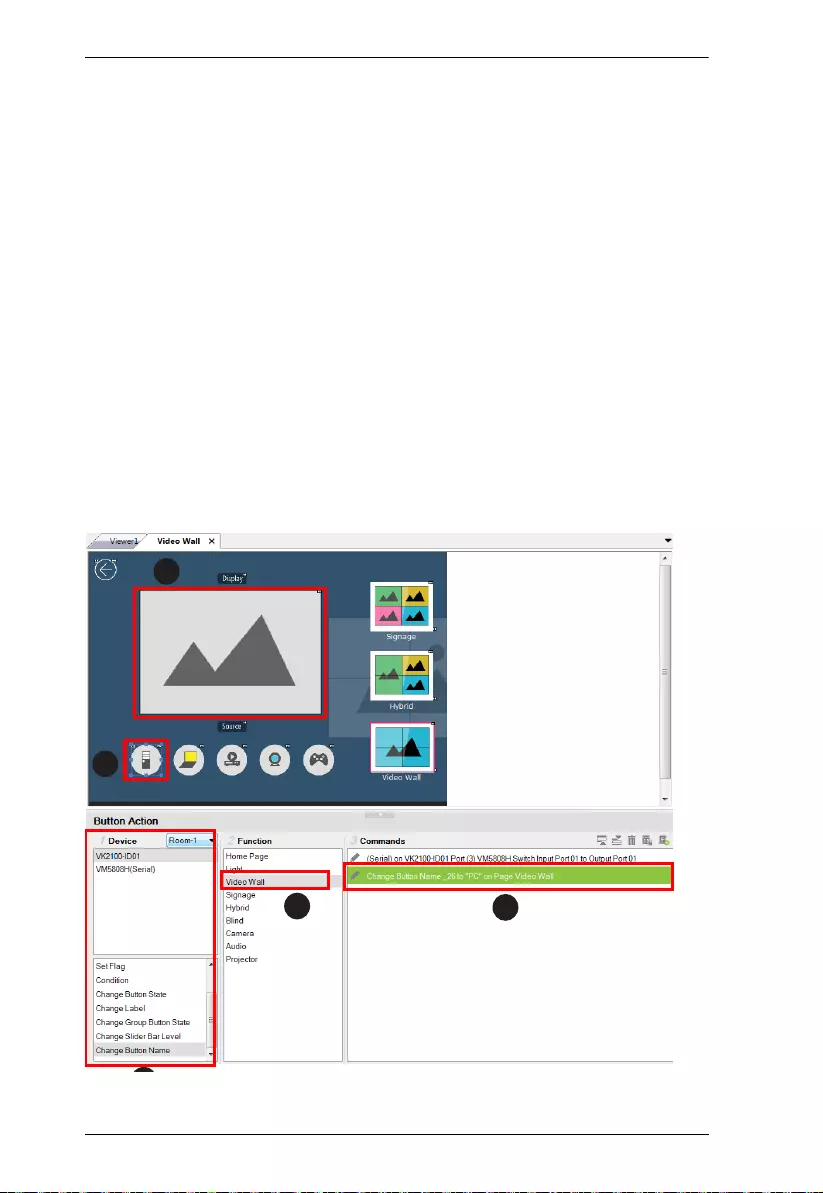
ATEN Control System User Manual
174
Change Button Name
The Change Button Name command is used to display specified text on a
selected button when the configured button is tapped. An application of this
command is indicating the assigned source for a display device on a Viewer as
soon as the source is assigned. This way, you can keep track of the source that
is currently showing on a particular display device.
Example:
Indicate the currently assigned source on a display device (in the Viewer).
Assume an environment consisting of one monitor and five sources
buttons (computer, laptop, camera...etc.), as illustrated below, and that
when a source button is tapped, the source will be immediately assigned to
the display.
Configuration goal: To have the assigned source printing on the display
button (on the Viewer page), configure each source button so that when it is
tapped, the following actions (commands) initiate: (1) Display the source to the
display; (2) Print the name of the assigned source onto the display device.
1
2
45

Chapter 4. ATEN Configurator (VK6000)
175
1. Click a source button to display the Button Action panel.
2. In the Button Action panel, select Change Button Name.
3. From the Function list, double-click the Viewer page where the source
button is located. In this example, double-click the Video Wall option.
The Change Button Name command is added.
4. From the Commands list, double-click the Change Button Name
command and configure the following.
Select the ID of the display button to indicate the location of print the
text. In this example, it is the video wall’s ID.
Type the text you wish to show when the source button is tapped. In
this example, enter “PC”.
5. Follow steps 1 to 4 to configure each of the source buttons.
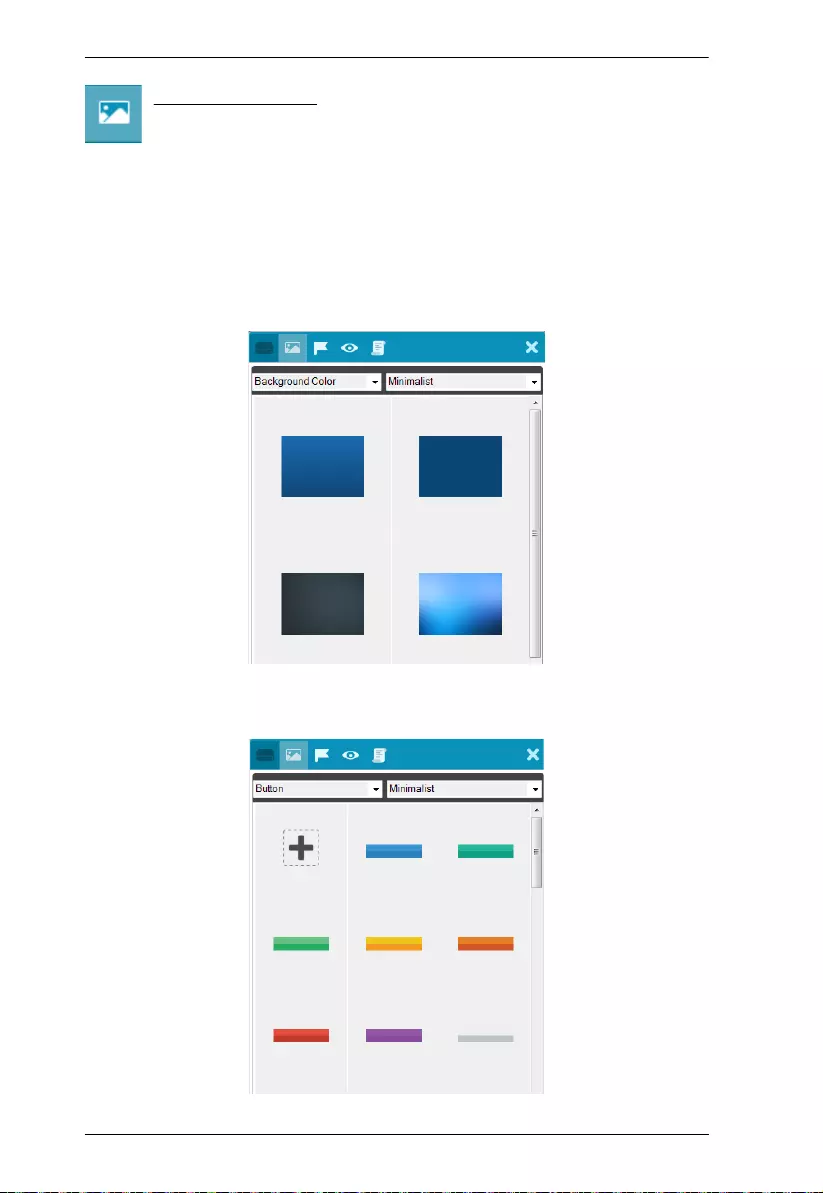
ATEN Control System User Manual
176
Graphic Library
The Library icon on the Project bar provides a Graphics tab and drop-
down menus with ready-to-use graphics for backgrounds, buttons,
icons and device interfaces. Device Interface provides entire page layouts that
you can use as templates for different types of devices. Double-click or drag
and drop graphics to add them to the page. Images can be imported for icons
and buttons in various formats (*.png,*.jpg,*.jpeg,*.bmp).
Background Color
Button
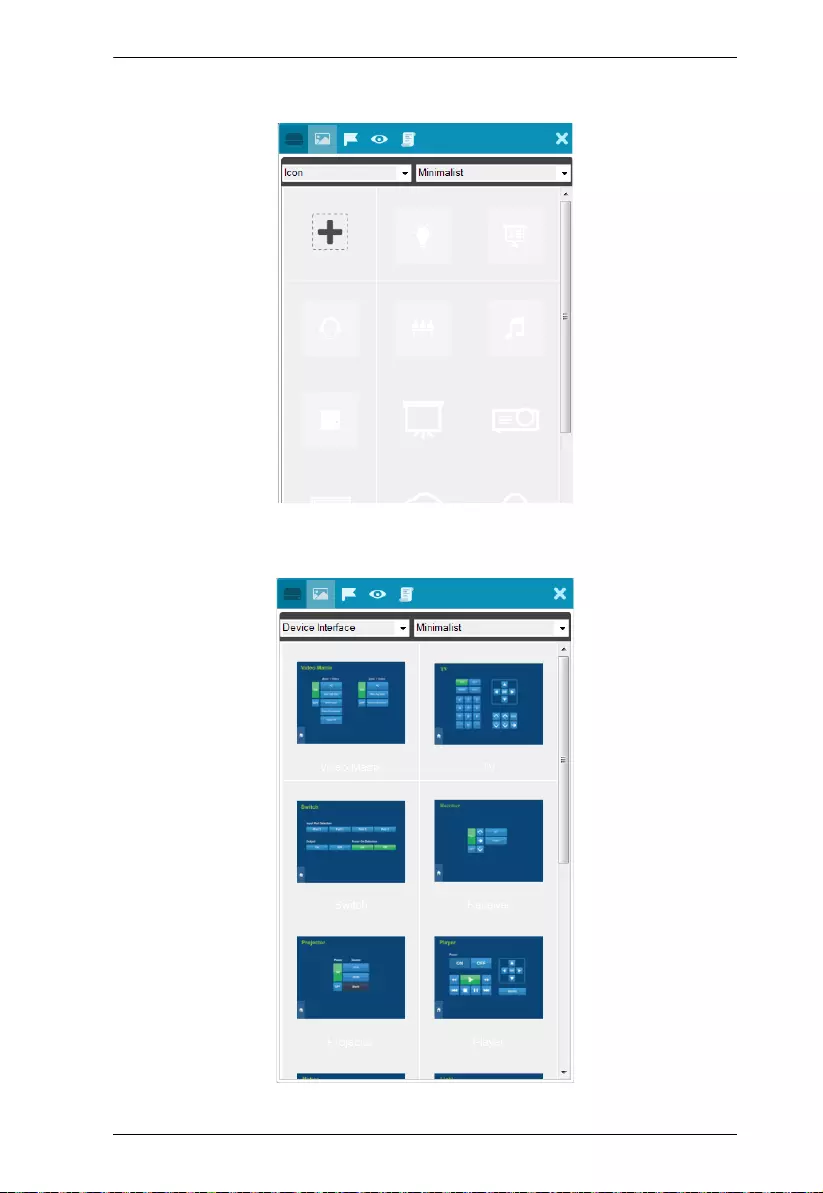
Chapter 4. ATEN Configurator (VK6000)
177
Icon
Device Interface
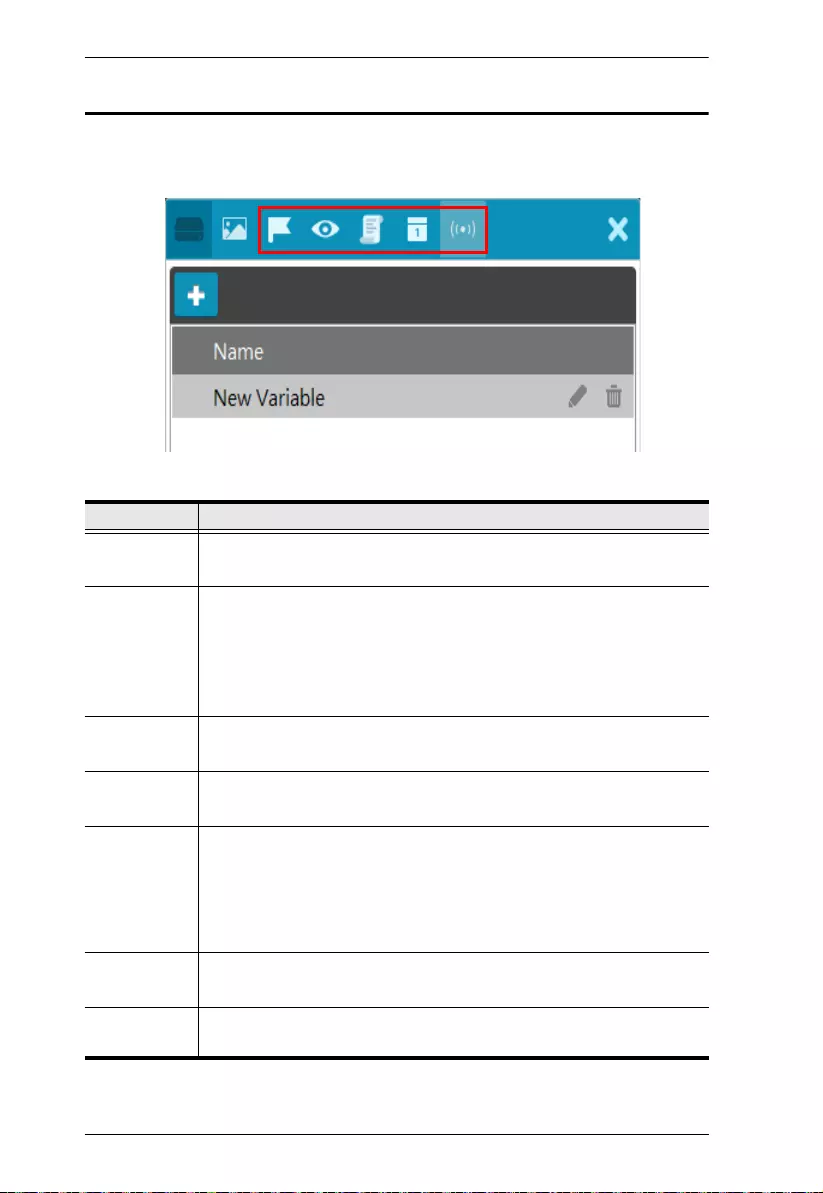
ATEN Control System User Manual
178
Library
The Library icon on the Project bar offers the following functions. The table
below provides an overview of each function.
Control Description
Flag Flags are created to include parameters when settings are changed to
indicate the current status. For details, see Flag, page 179.
Monitor Monitors allow you to set Conditions for Digital Input (dry contact) and
Digital Input (VDC) signals and Flags on a port that will initiate an
Action. In addition, you can create Listen to port and Query port
monitors which check a device’s status to initiate actions. For details,
see Monitor, page 181.
Macro Macros initiate a sequence of actions on one or more hardware
devices. For details, see Macro, page 200.
Schedule Click to create scheduled events. For details, see Scheduled Events,
page 202.
Variables Creates a Variable for a device setting (e.g. volume) that is controlled
by two or more objects (e.g. slider bar or buttons) on the Viewer. When
the device setting is changed through one of the objects, its setting is
automatically synced and reflected on all the objects. For details, see
Variables, page 203.
+
Opens a pop-up window to create a Flag, Monitor, Macro, Schedule, or
variable.
x
Closes the Library window.
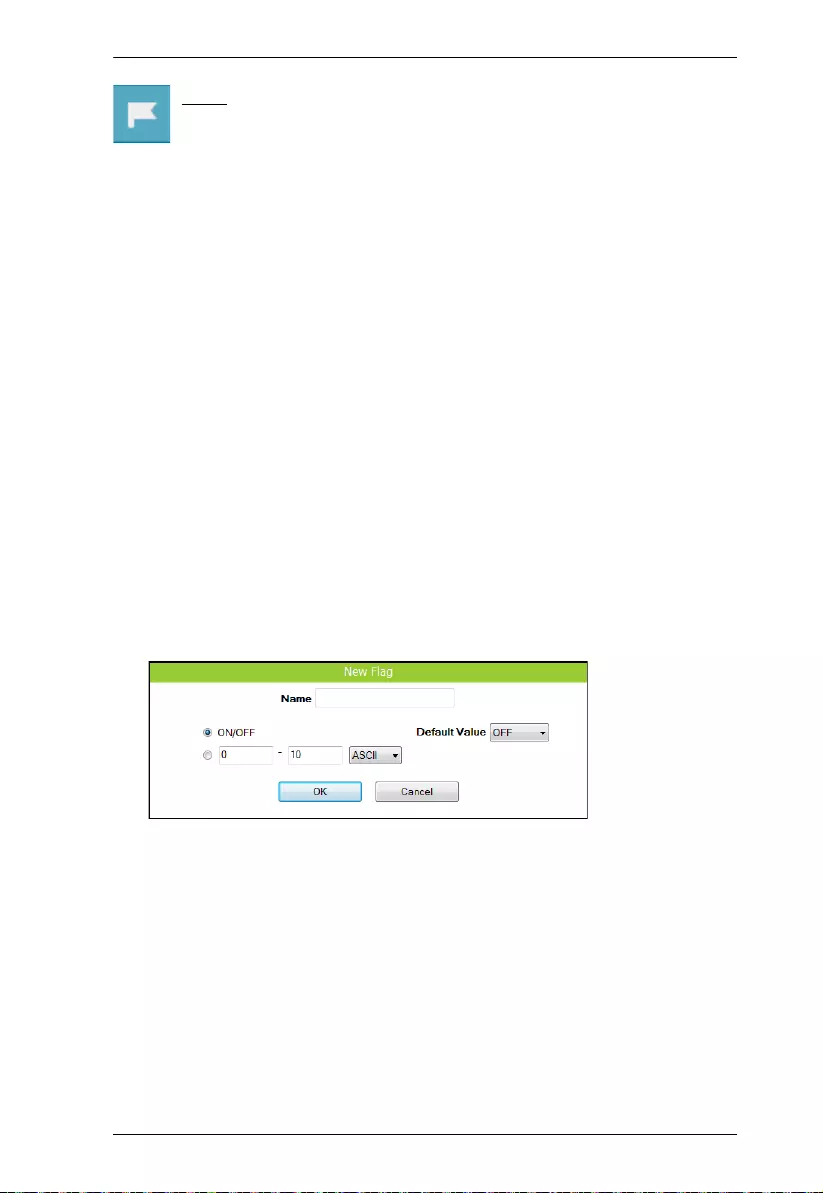
Chapter 4. ATEN Configurator (VK6000)
179
Flag
Flags are created for control buttons to include parameters for when
settings are changed or requests are made to change settings on a
device. Flags indicate what the status is and what action to take according to
the value. Flags are added as actions to Button Properties as a Condition or Set
Flag value.
Conditions tell a button to initiate associated actions if the flag value is true: “If
Flag equals Value” initiate the action. Actions are associated with a condition
so that they only initiate if the flag value is correct. That way an ON command
is only sent to a device if the current flag value is OFF.
Set Flag changes the flag value when a device setting has changed. So that if a
device is OFF and the action turns the device ON, adding a “Set Flag 1 to ON”
will change the flag value to ON. Now the flag’s value matches the device
status so that actions associated with flag Conditions will initiate accordingly.
Create flags for a device and add them as a Condition and Set Flag value in the
Action – Button Properties (see Button / Slider Bar / Dial Kit Actions,
page 153).
To create a Flag:
1. Select Flag and click
+
. The New Flag menu appears.
2. Enter a Name and select a radio button to set the flag value.
Select On/Off and use the drop-down menu to select the Default Value.
Enter a range (1-100) for the values in the two boxes and use the drop-
down menu to select the Default Value. Use the drop-down menu to
select the format ASCII or HEX.
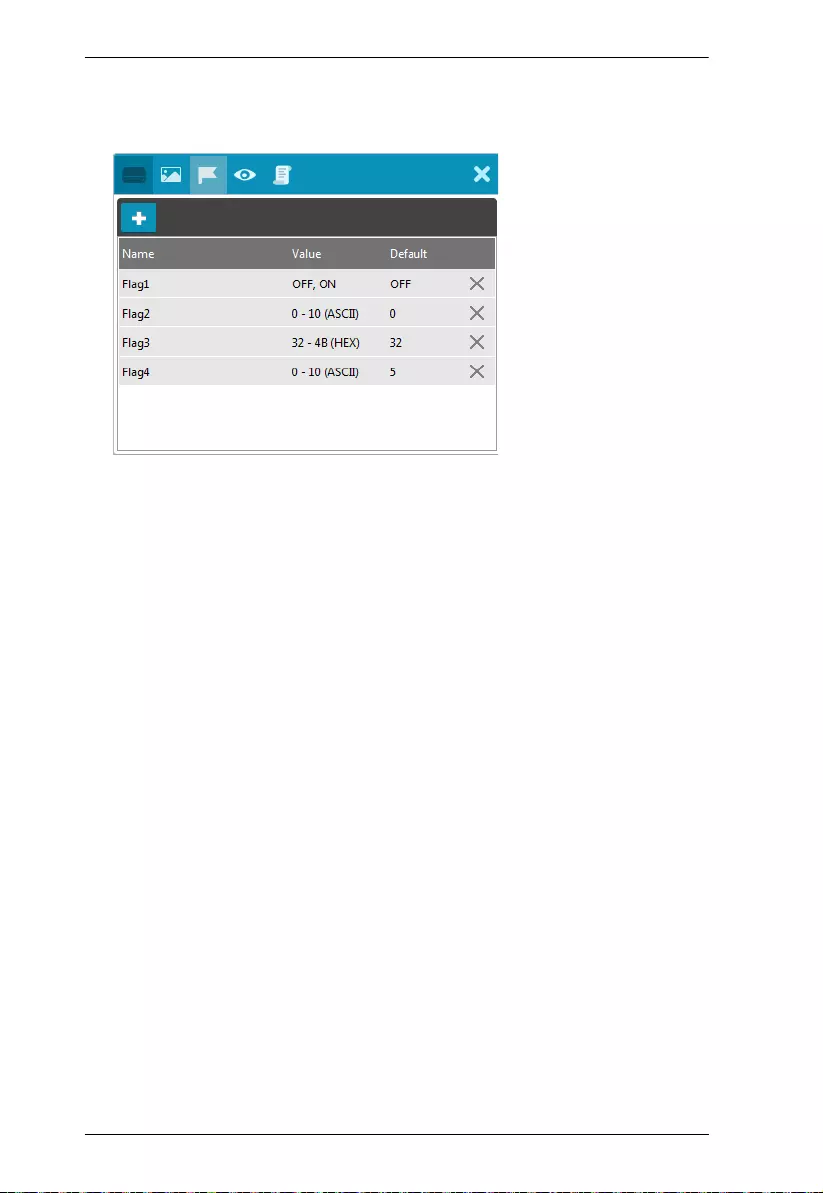
ATEN Control System User Manual
180
3. Click
+
to create more flags or double-click a flag to edit it. The flags will
appear in the list, as shown below.
Name – Lists the Flag names which have been created.
Val ue – Lists the flag’s values or range of values.
Default – Lists the flag’s default value.
x
– Deletes a flag from the list.
4. Select Condition or Set Flag to add flags as a command in Button Action
by selecting a button on a Viewer page (see Button / Slider Bar / Dial Kit
Actions, page 153).
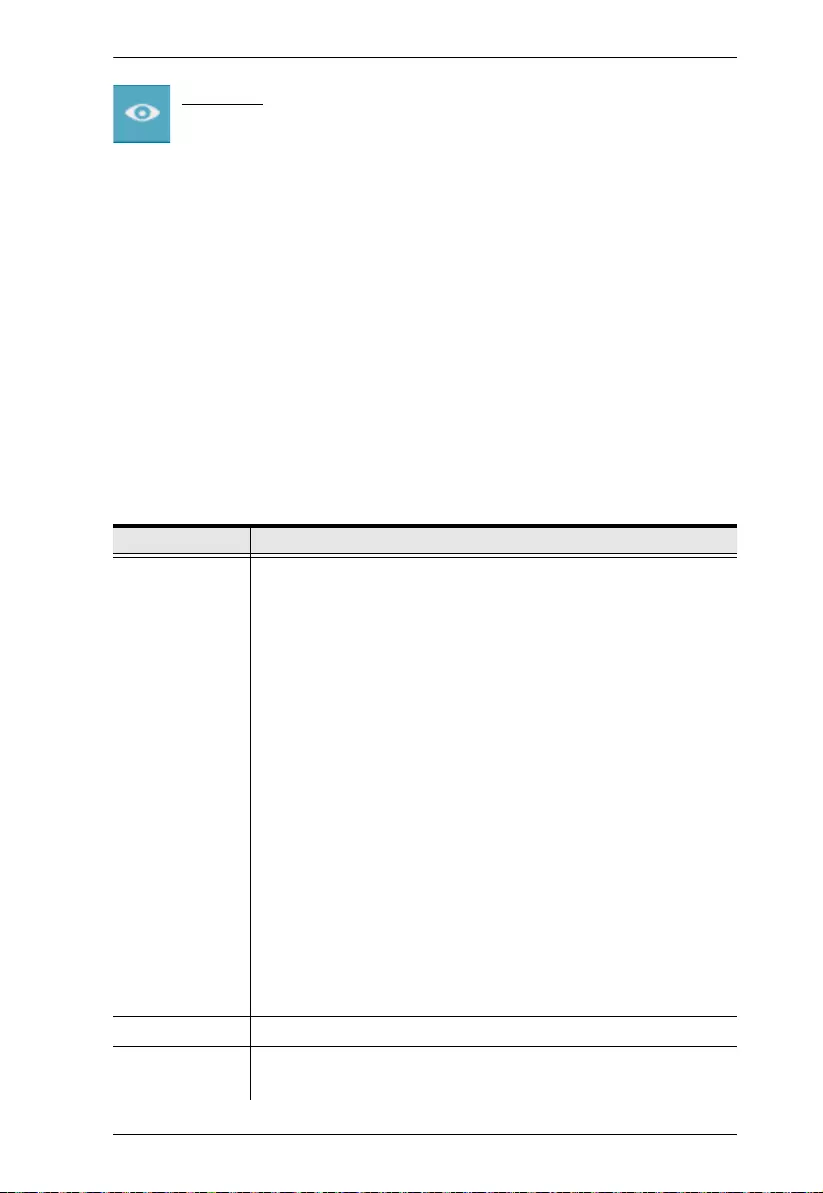
Chapter 4. ATEN Configurator (VK6000)
181
Monitor
Understanding Monitor
A Monitor allows you to set conditions on a port using Digital Input (VDC)
and Digital Input (Dry Contact) signals, return messages, and Flags. When the
condition is met, the controller will initiate the desired action. Digital Input
(VDC) hardware devices provide voltage signals between 1 and 24. Digital
Input (Dry Contact) hardware devices provide open and closed circuit signals.
Hardware devices with return messages can be monitored using Listen to port
or Query port conditions via text they transmit. These signals provide
indicators from sensors or switches of an event. An event can be the
temperature, power, dry contact, sensor, switch status, or message from a
device. There are two parts to a monitor, the Condition and Action.
Monitor Page Options
There different types of monitors you can create to fulfill different scenarios.
All monitors share the following configuration fields:
Control Description
Type Use this drop-down list to select a monitor type:
If – select this option for a single condition monitor. “If” the
single condition is met, the action initiates. For details, see
Creating an If Monitor, page 187.
Switch – select this option for multiple conditions that use more
than one “If” conditions for the monitor. In this type, if one of the
conditions is met, the monitor will initiate the action. For details,
see Creating a Switch Monitor, page 190.
Bypass – select this option to transmit device feedback
message to the selected variable actively listening for a
message or by receiving a return message from the specified
devices. For details, see Creating a Bypass Monitor, page 194.
While Loop – select this option to execute the specified actions
at the defined frequency (Query Frequency). For details, see
Creating a While Loop Monitor, page 195.
Professional – select this option to create variables and load
values into these variables using programming script. For
details, see Creating a Professional Monitor, page 196.
Name Enter a name for the monitor.
Query Frequency Use this drop-down menu to select how frequently the monitor
checks a device for a signal.
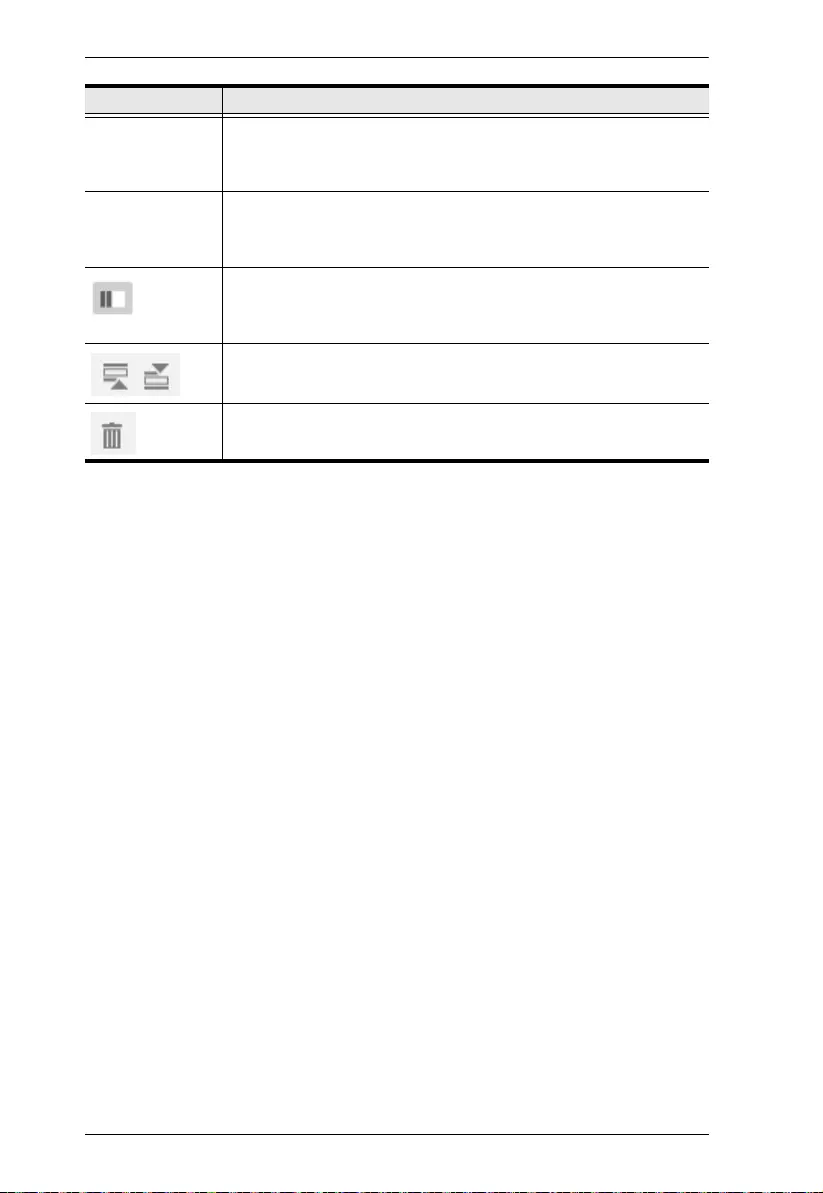
ATEN Control System User Manual
182
Condition Use this section to add one or more conditions that will need to be
met for the Action to initiate. You can create up to 32 conditions for
each monitor. For details, see Condition Types, page 183.
Action Use this section to create the commands that will initiate when the
monitor’s conditions are met. For details, see Device Functions,
page 158 and Advanced Functions, page 161.
Click to hide or display the Device and Status/Function columns in
the Condition and Action lists so that you can see a complete row of
Conditions/Commands.
Click to move an selected command up or down in the Commands
list.
Click to remove an selected command from the Commands list.
Control Description
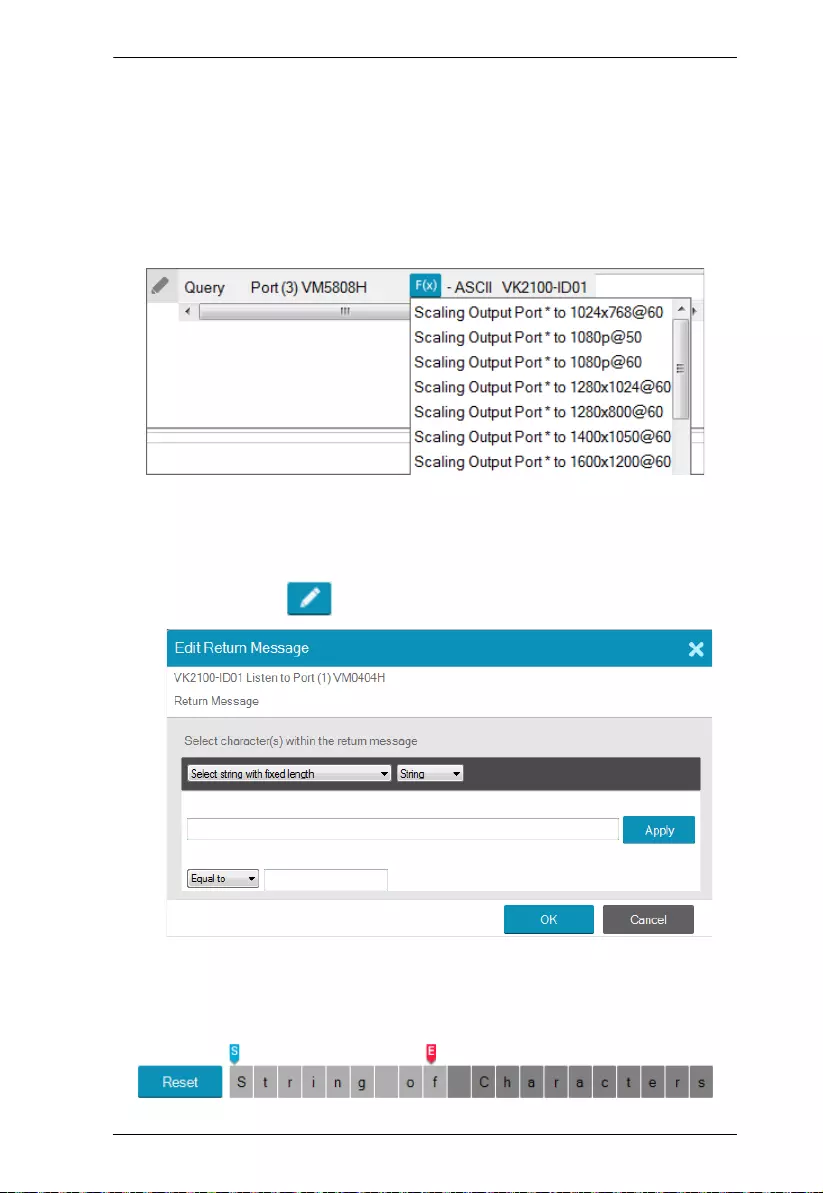
Chapter 4. ATEN Configurator (VK6000)
183
Condition Types
Note that you can create up to 32 conditions for each monitor.
Listen to port / Query port
(Query port only) Click F(x) to open the drop-down menu to select a
device command to send out; or enter a command string; and then the
click Edit Return Message icon and do as explained below.
Edit Return Message
(Listen to port / Query port) Next configure the parameters for the
return message from the device. This message must match for the
condition to be met. In the Condition list double-click the command
and then click to open the Edit Return Message window:
Use the drop-down menu and enter a string of that will represent the
characters in a return message from the serial device:
Select string with fixed length
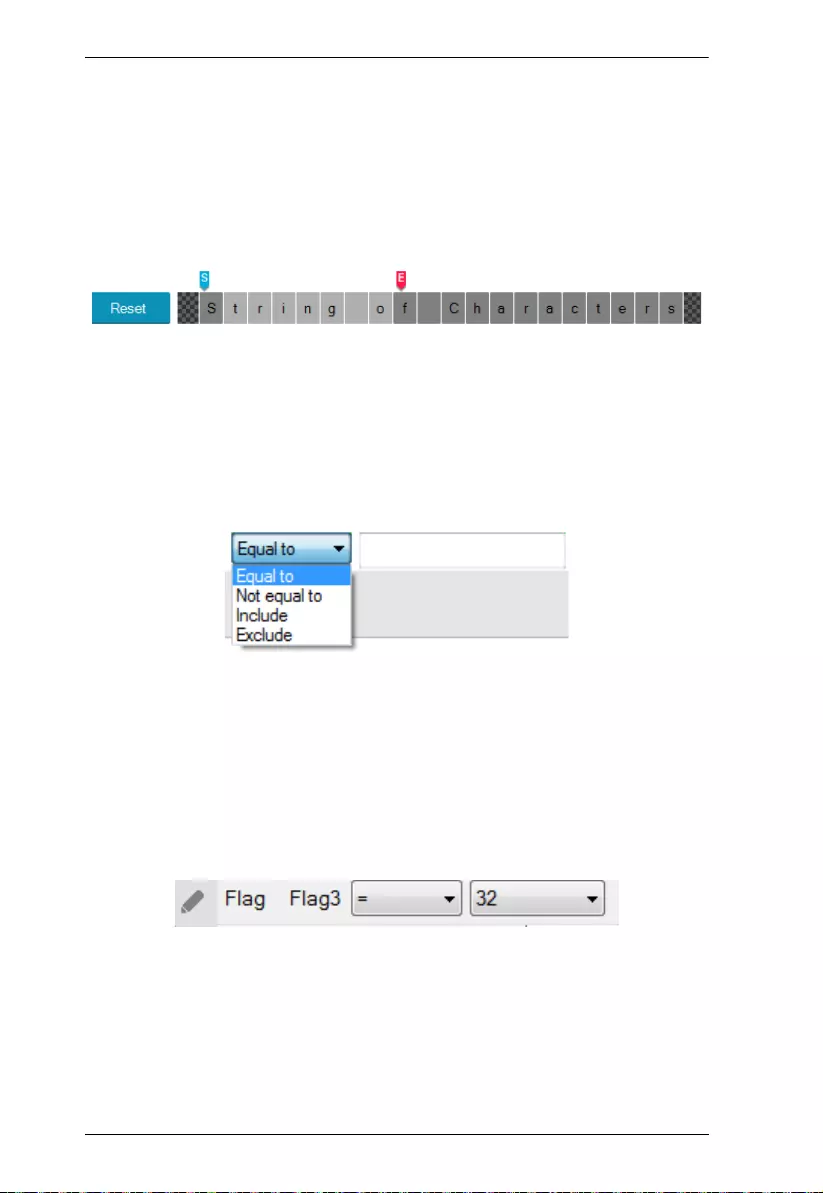
ATEN Control System User Manual
184
Use this to set a string of characters that are set within a fixed
parameter. Enter a string of characters and use the S to set the start of
the string and E to set the end and then click Apply. The return
message will need to fit the fixed string of characters set in the text
box next to the Drop-Down Menu (see next page) for the monitor to
be triggered.
Select string with a non-fixed length
Use this to set a string of characters where the parameters are
variable. Enter a string of characters and use the S to set the start of
the string and E to set the end and then click Apply. The return
message will need to fit the fixed string of characters set in the text
box next to the Drop-Down Menu (see below) for the monitor to be
triggered.
Drop-Down Menu
Above, enter characters that the Select string with fixed length or
Select string with non-fixed length string must match and how they
must be matched: Equal to, Not equal to, Include, or Exclude for
the condition to be triggered.
Flag
Creates a flag condition for the monitor. Use the drop-down menus to set a
format (how the flag value must be matched) and the flag value for the
condition to be triggered.
I/O Input
Create a trigger signal from a device according to the voltage. Only device
with a Digital Input (dry contract) or Digital Input (VDC) port appear in
the Status list. Double-click a device in the Status list to add it to the

Chapter 4. ATEN Configurator (VK6000)
185
Condition list. Double-click the command in the Condition list to
configure the setting:
The High or Low status tells the Monitor to initiate an Action when the
device signal is above or below the threshold setting* for the port:
Digital Input (VDC)
High - states that when the voltage signal is above the Upper
Threshold to initiate the Action.
Low - states that when the voltage signal is below the Lower
Threshold to initiate the Action.
Digital Input (Dry Contact)
According to an open or closed circuit status for the port:
Open - states that when the circuit is Open to initiate the Action.
Closed - states that when the circuit is Closed to initiate the
Action.

ATEN Control System User Manual
186
Functions
Delay – adds a delay in seconds. Enter a number between 0.1-180.
Relay – adds an Open, Close, Toggle or Pulse action on the selected
controller and Relay port.
DO – adds an Open, Close, Toggle or Pulse action on the selected
controller and Digital Output port.
Wake on LAN – powers on the specified computer (MAC address)
over Ethernet.
Serial Raw (ASCII) – adds a serial command in the ASCII mode.
Serial Raw (HEX) – adds a serial command in the HEX mode.
Telnet Raw (ASCII) – adds a telnet command in the ASCII mode.
TCP Raw (ASCII) – adds a TCP command in the ASCII mode.
TCP Raw (HEX) – adds a TCP command in the HEX mode.
UDP Raw (ASCII) – adds a UDP command in the ASCII mode.
UDP Raw (HEX) – adds a UDP command in the HEX mode.
HTTP – adds an HTTP command.
HTTPS – adds an HTTPS command.
TCP Feedback Raw (ASCII) – adds a feedback in ASCII format to
having received a monitored input from a TCP client device.
TCP Feedback Raw (HEX) – adds a feedback in HEX format to
having received a monitored input from a TCP client device.
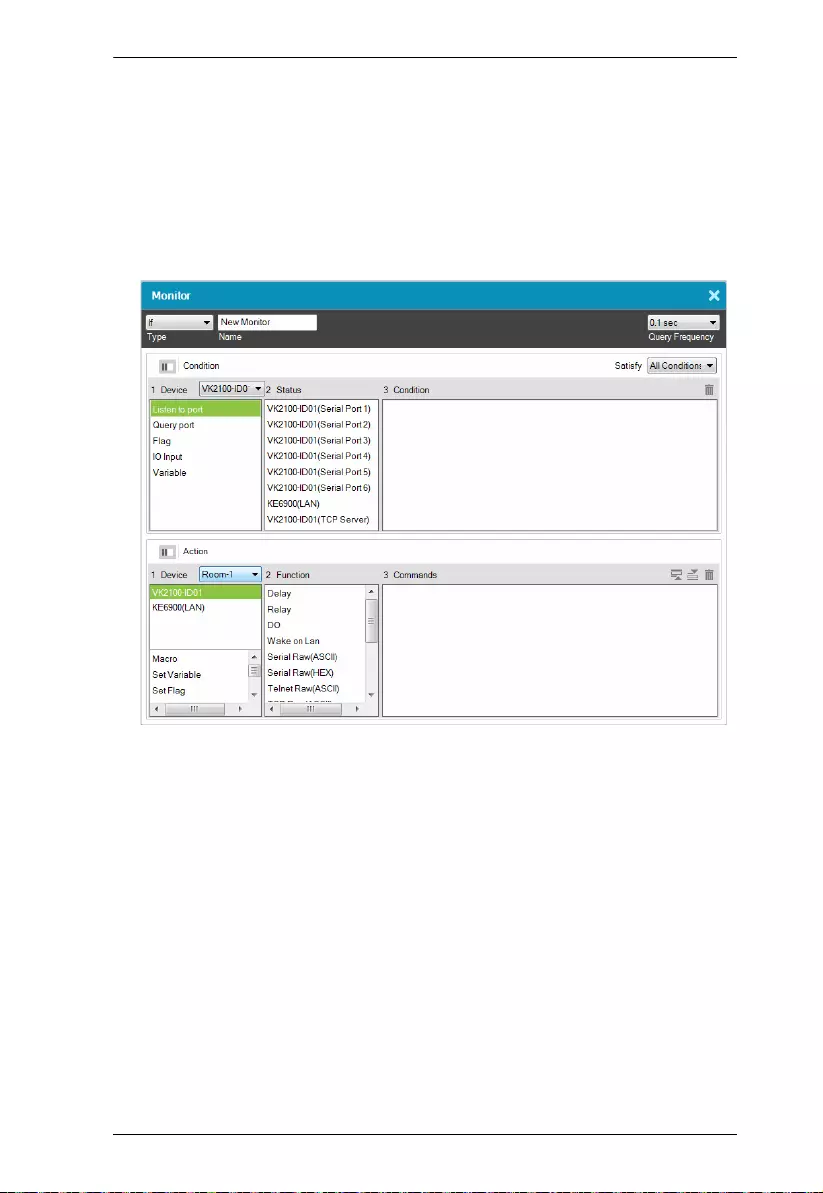
Chapter 4. ATEN Configurator (VK6000)
187
Creating an If Monitor
To create a monitor for a device port with a Condition that initiates an Action,
click
+
from the Library’s Monitor tab, and do the following:
1. Select If from the drop-down menu and enter a name for the monitor.
2. Use the drop-down menu to set the Query Frequency.
3. Select All Conditions or Any Conditions.
These options are only for advanced setups that require multiple events
from hardware devices connected to multiple conditions. Most devices
only require one signal Status added to the Condition List to initiate an
Action. Most installations will not need to use this option, therefore it can
be ignored.
All Conditions: Add multiple conditions – all of which must be met
for the Action to initiate.
Any Conditions: Add multiple conditions – one of which must be met
for the Action to initiate.
4. Under Device, select a Controller from the drop-down menu, and then
choose one of the following monitor types. For details, see Condition
Types, page 183.
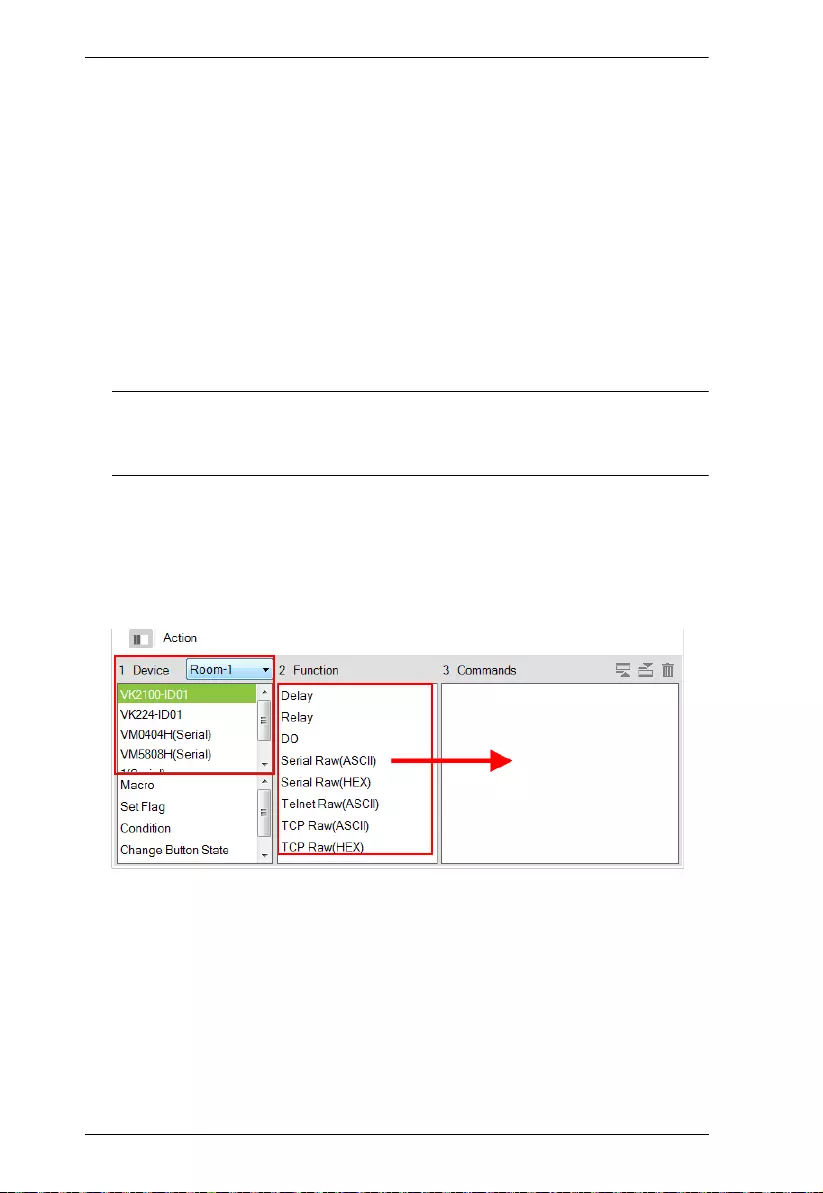
ATEN Control System User Manual
188
Listen to port – to create a monitor that actively listens for a message
from the device. Under Status, double-click a device port to add it to
the Condition list.
Query port – to create a monitor that sends out a command to the
device until a feedback message is received from the device.
Flag – to create a flag condition for the monitor.
I/O Input – to create a trigger signal from a device according to the
voltage.
5. Under Status, double-click to add a device port or flag to the Condition
list. Then double-click the device port or flag in the Condition list to
configure the condition settings.
Note: To set the controller as a TCP server, use the TCP Server option in
the Status column, and make sure to type a TCP server port in the
controller’s properties settings (page 109).
6. (Optional) Use the Operator option to add additional High or Low
conditions (see step 4, page 187).
7. Go to the Action section at the bottom of the page to select the hardware
Device and add the Function to the Commands list, as explain in the
steps that follow.
Note: For more information about Functions, see Button / Slider Bar /
Dial Kit Actions, page 153.
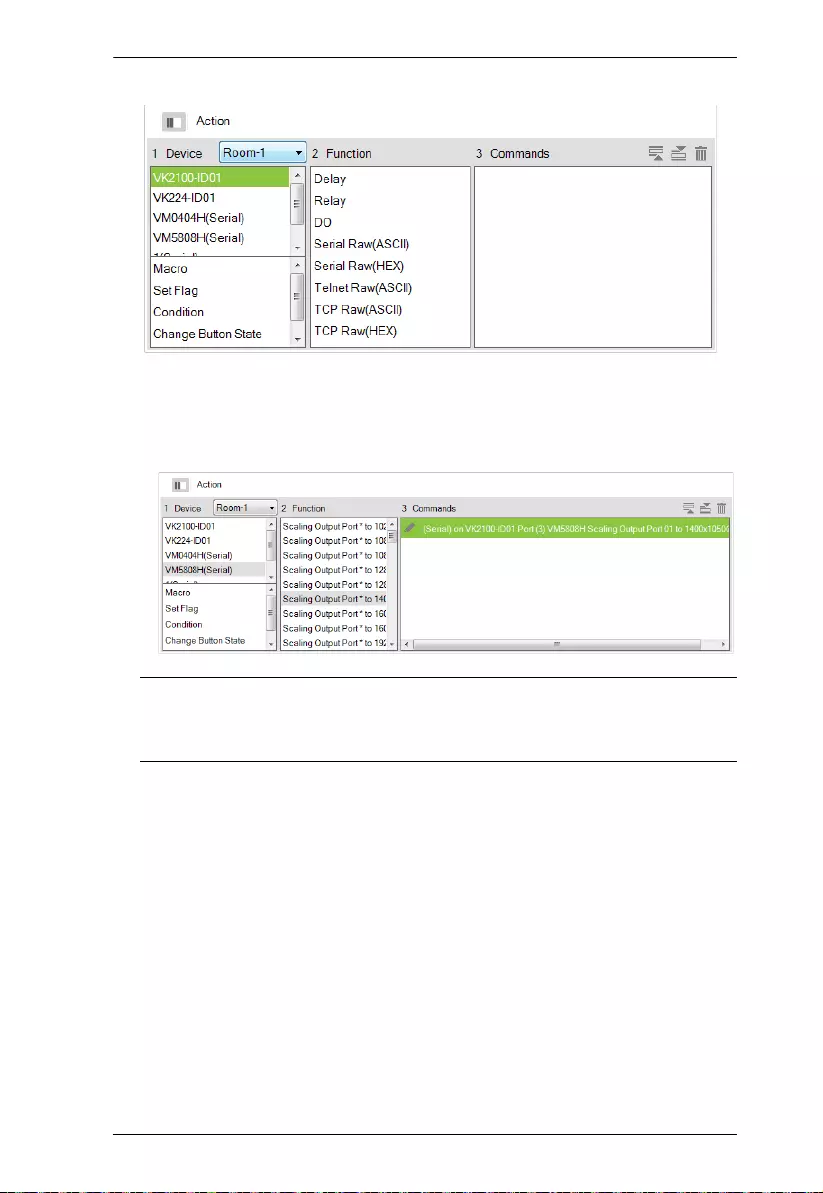
Chapter 4. ATEN Configurator (VK6000)
189
a) First select the hardware under Devices.
b) Under Function, double-click a command to add it to the Commands
list. This Command initiates when the Condition is met. For details on
Functions and Commands, see Device Functions, page 158 and
Advanced Functions, page 161.
Note: If you have configured the controller as a TCP server, add TCP
Feedback Raw (ASCII) or TCP Feedback Raw (HEX) command
to provide feedback to the TCP client.
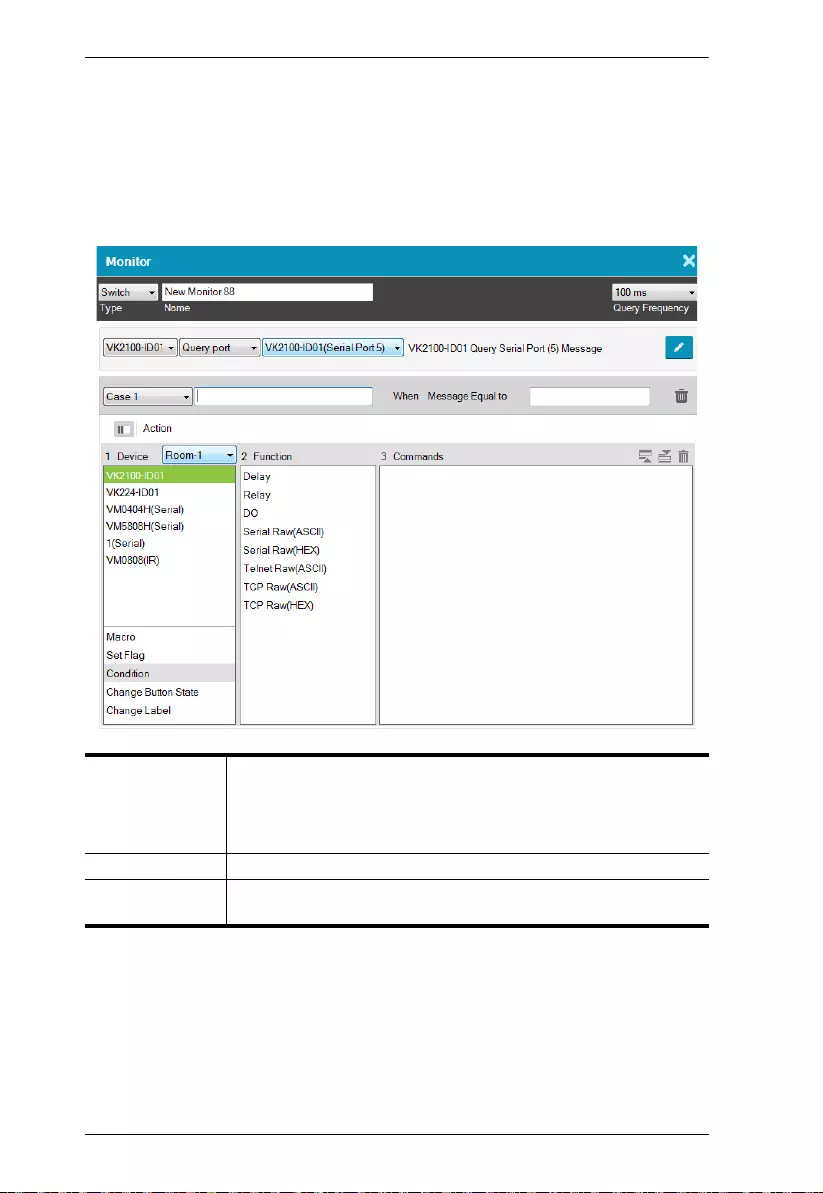
ATEN Control System User Manual
190
Creating a Switch Monitor
1. Select Switch from the drop-down menu and enter a name for the monitor.
2. Use the drop-down menu to set the Query Frequency.
3. Use the options to create multiple condition comparisons, as explained
below.
Type Use the drop-down menu to select:
If – select this option for a single condition comparison monitor.
Switch – select this option for multi-condition comparisons that use
multiple “If” comparisons for the command.
Name Enter a unique name for the monitor.
Query Frequency Use this drop-down menu to select how frequently the monitor
checks a device for a signal. Options are: 100 ms - 1 second.
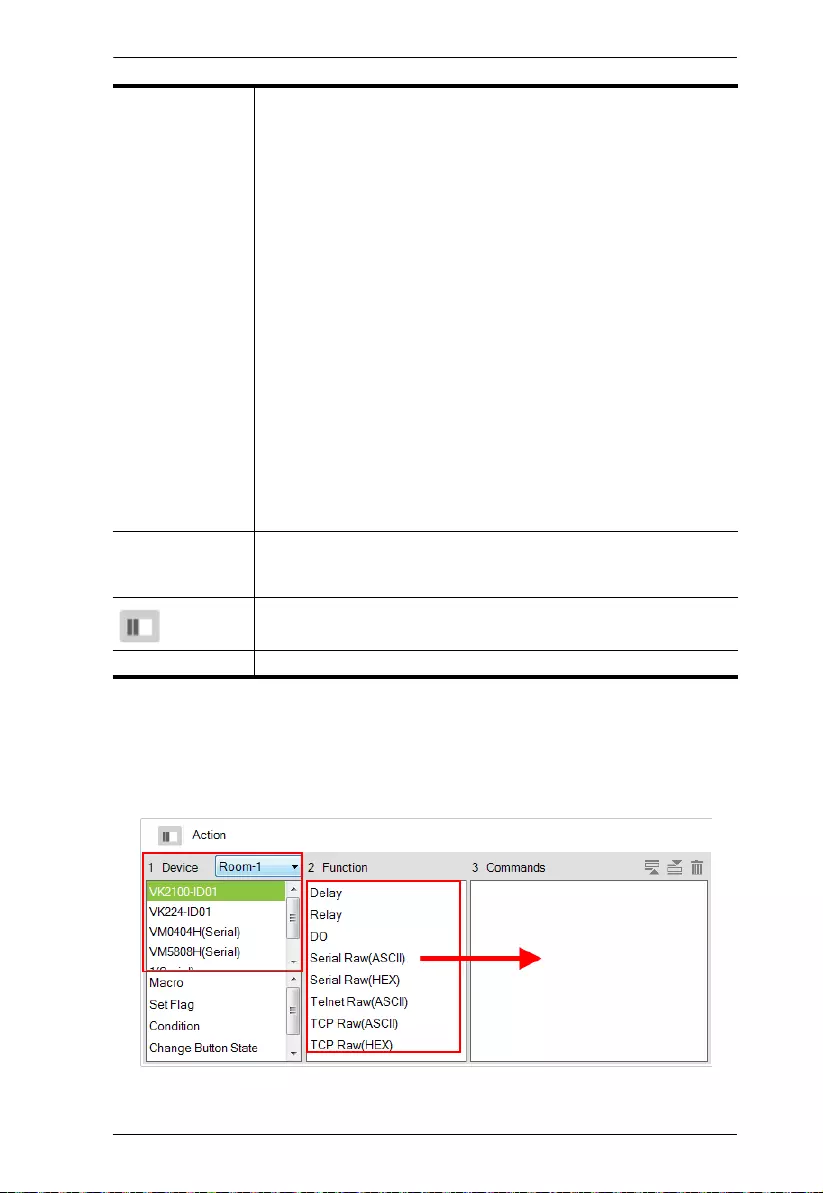
Chapter 4. ATEN Configurator (VK6000)
191
4. Go to the Action section at the bottom of the page to select the hardware
Device and add the Function to the Commands list, as explain in the
steps that follow.
Drop-Down Menus Under the Type drop-down menu are four addition drop-down
menus used to configure the Switch Condition:
Controller – use the first drop-down to menu select the control-
ler for a Switch condition.
Listen to port / Query port – use the second drop-down menu
to select the condition type for a Switch condition (see step 4,
page 188 for details).
Serial Device Port
Use the third drop-down menu to select a serial device port
and configure Edit Return Message (to configure, see Edit
Return Message, page 183).
To set the controller as a TCP server, use the TCP Server
option in the Status column, and make sure to type a TCP
server port in the controller’s properties settings
(page 109).
Case – use the fourth drop-down menu to add cases by selecting
Add More Cases for comparison that need to be met before
monitor’s condition will initiate. In the left text box enter a name
for the Case, in the right text box enter the character string that
the return message should match.
Action Use this section to create commands for the monitor. See Button /
Slider Bar / Dial Kit Actions, page 153, for details on configuring
commands.
Click this icon to switch to the Action list view so that you can see a
complete row of the command’s functions. This is a toggle button.
x Closes the Monitor window.
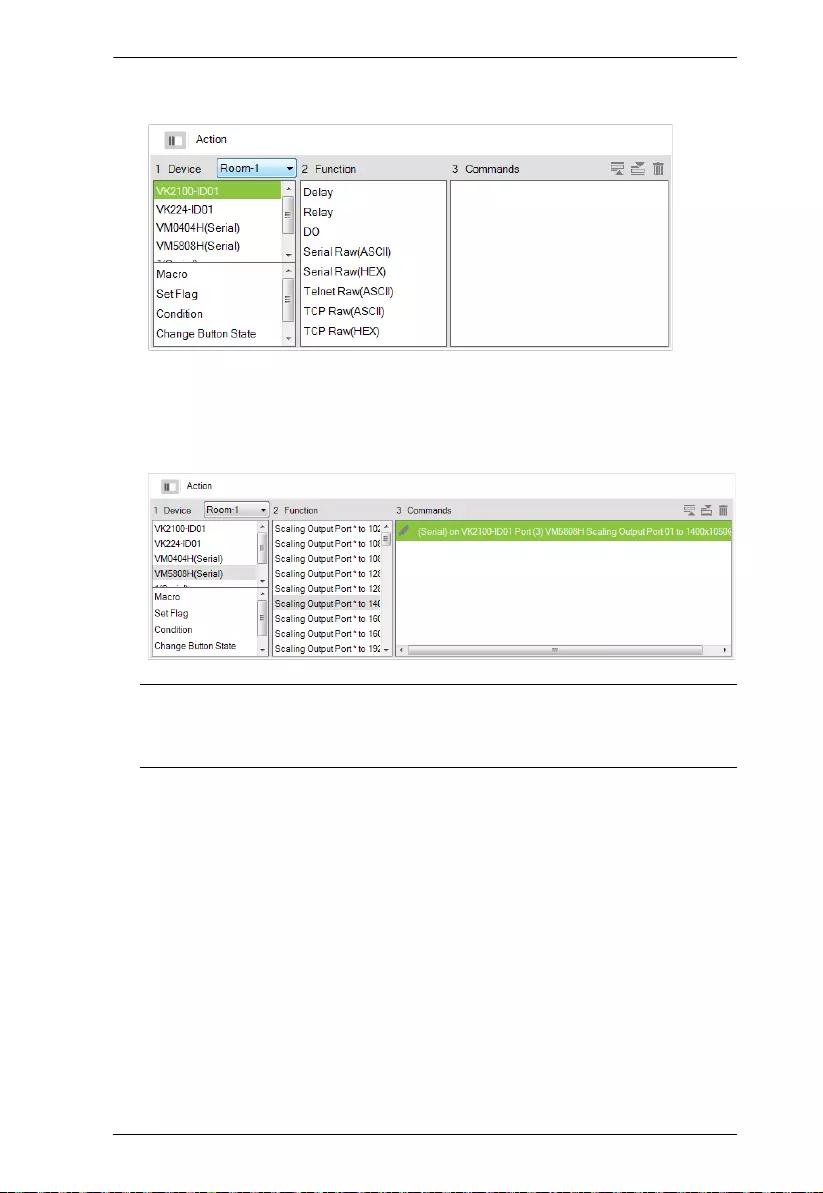
Chapter 4. ATEN Configurator (VK6000)
193
5. First select the hardware under Devices.
6. Under Function, double-click a command to add it to the Commands list.
This is the Command that initiates when the Condition is met. For details
on what each function does, see Device Functions, page 158 and Advanced
Functions, page 161.
Note: If you have configured the controller as a TCP server, add TCP
Feedback Raw (ASCII) or TCP Feedback Raw (HEX) command
to provide feedback to the TCP client.
7. You can also add a Macro, Link, Set Flag or Monitor’s Condition.
8. After adding all the functions to the Commands list, the Switch monitor is
complete.
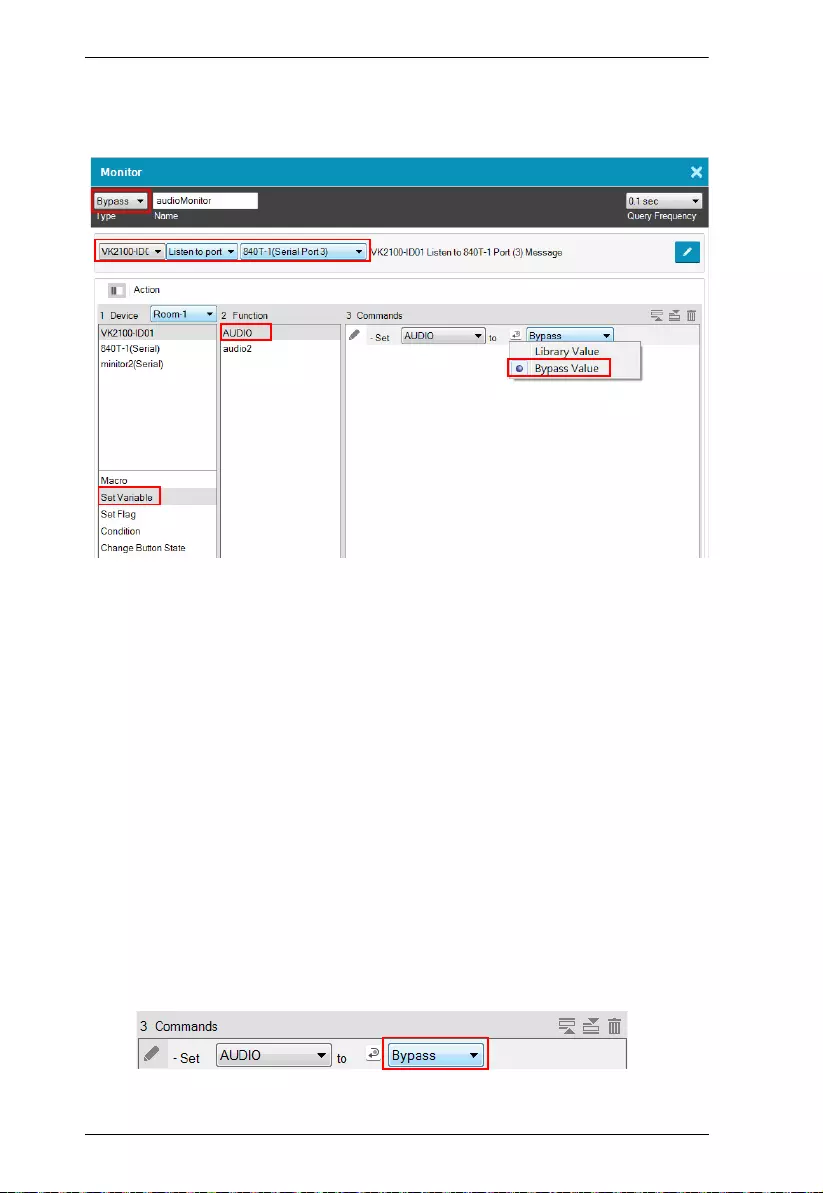
ATEN Control System User Manual
194
Creating a Bypass Monitor
Follow the steps below to create a bypass monitor.
1. Select Bypass from the drop-down menu and enter a name for the monitor.
2. Configure the following settings.
Query frequency: sets how frequently the monitor checks the device
for a signal. Valid values range from 100 ms to 1 second.
In the second drop-down list, select one of the following:
Listen to port: actively listens for a message from the specified
device.
Query port: when a setting is changed on the specified device,
the device sends a feedback message to the controller, informing
the latest setting.
In the last drop-down list, select the port or the device to be monitored.
3. Configure the actions.
a) Select Set Variable.
b) Double-click the variable you wish to update when controller detects a
change for the specified device setting.
c) For a variable, double-click the command and select Bypass.
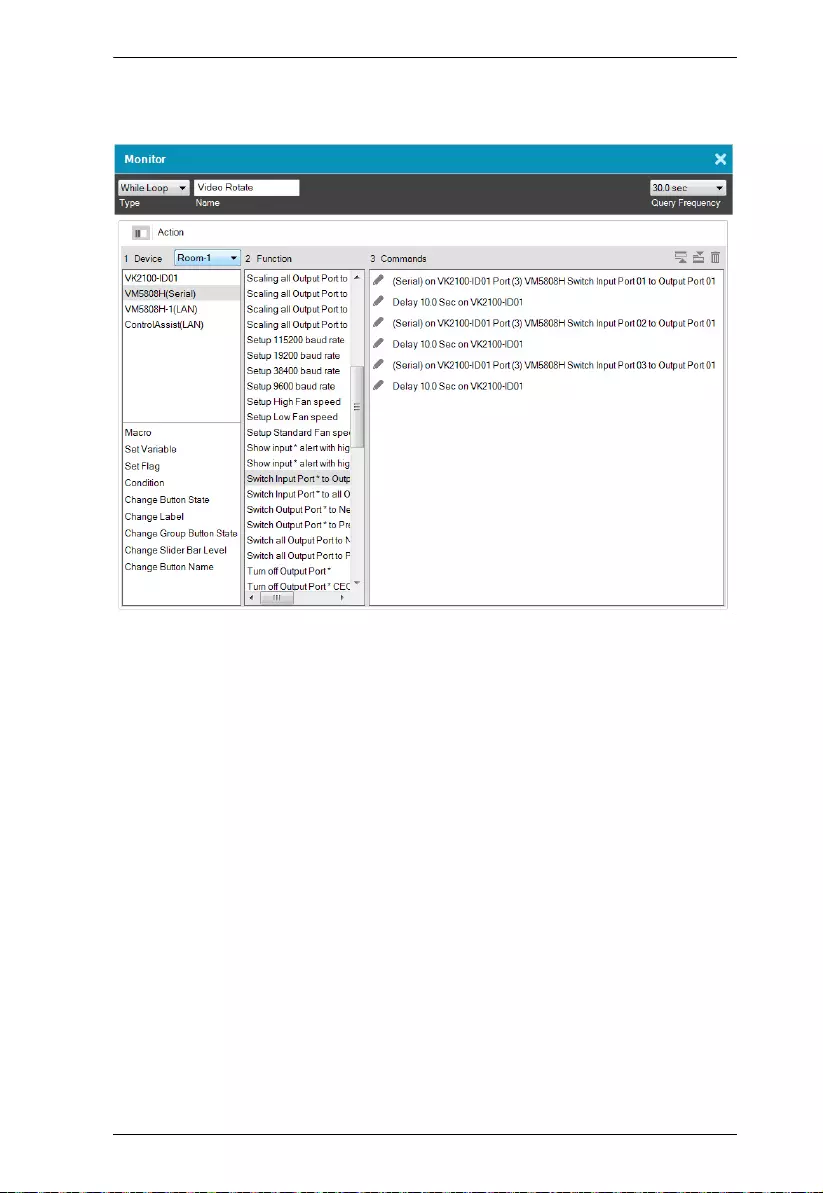
Chapter 4. ATEN Configurator (VK6000)
195
Creating a While Loop Monitor
Follow the steps below to create a while loop monitor.
1. Select While Loop from the drop-down menu and enter a name for the
monitor.
2. Use the Query Frequency drop-down menu to define the frequency at
which the device checks for signals.
3. From the Device list, select a device.
4. (Optional) Select an advanced option. For details, see Advanced
Functions, page 161.
5. Double-click a function to added it to the Commands list. For details, see
Device Functions, page 158 and Advanced Functions, page 161.
6. Configure the added commands if required.
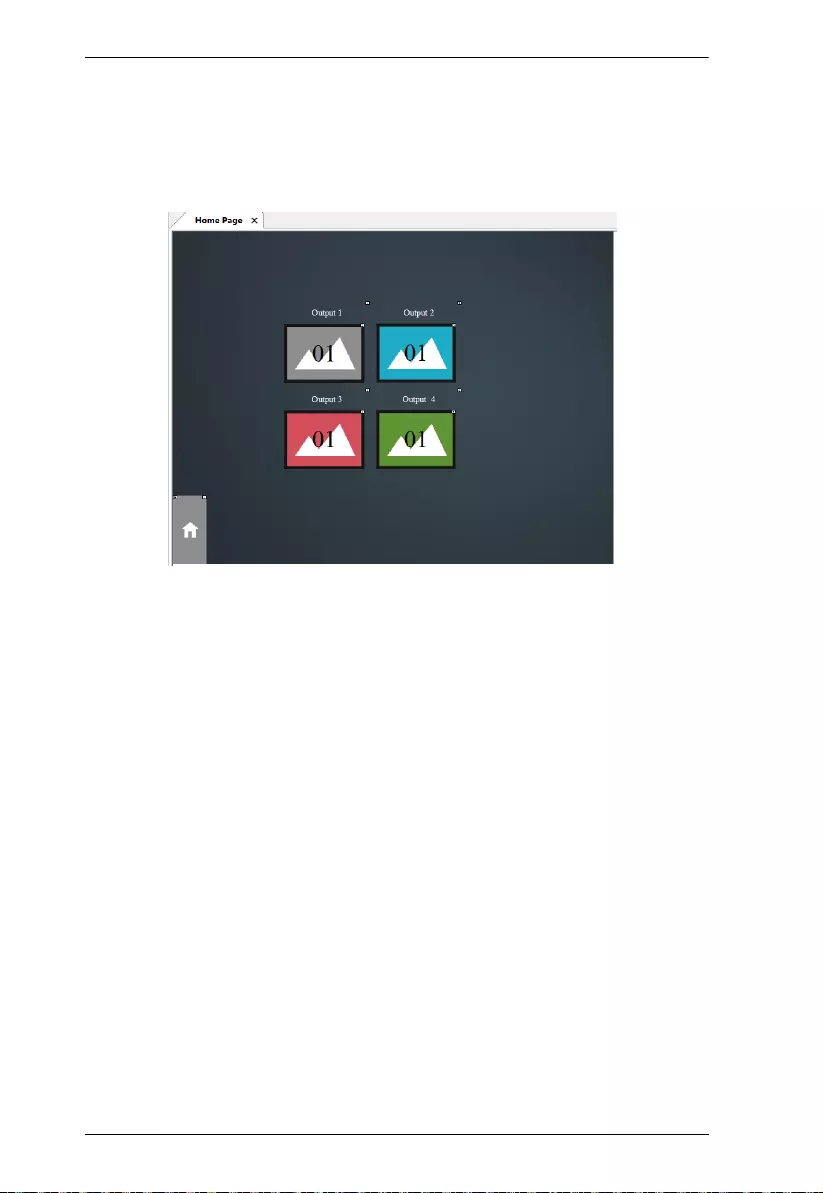
ATEN Control System User Manual
196
Creating a Professional Monitor
Example: Keep track of the assigned sources by indicating the input port
number of the assigned source on each of the four screens on a Viewer page,
as illustrated below.
For the controller to print the port number of the assigned source on each screen
and keep this information up-to-date, the controller needs to:
constantly keep track of the assigned source
constantly print the port number on each screen icon
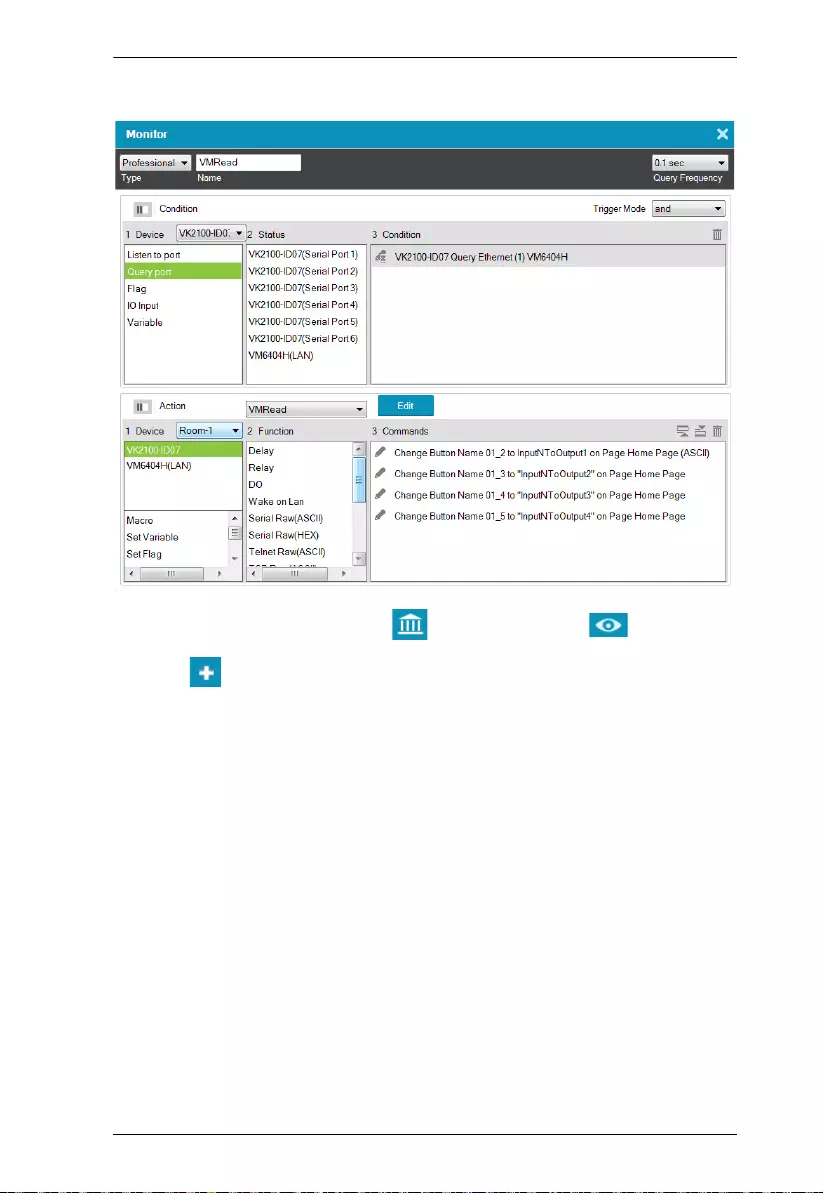
Chapter 4. ATEN Configurator (VK6000)
197
Follow the steps below to create a professional monitor.
1. In Configurator, click Library and click Monitor .
2. Click to create a new monitor.
3. Configure the following settings.
From the Type drop-down menu, select Professional.
Name the monitor.
Define the query frequency.
4. Configure the condition settings.
In this example, the controller VK2100 is set to query the input and output
ports of the Matrix Switch, VM6404H, that connects to the controller
every 0.1 second.
Add the condition(s) that must be met for initiating actions. For details
on conditions, see Condition Types, page 183.
Select a Trigger Mode for the added conditions.
And: Only initiate the added actions (commands) if the values of
all specified inputs change.

ATEN Control System User Manual
198
Or: Initiate the added actions (commands) if the value of any
specified input changes.
Independent: Use this option when you have multiple sets of
actions. The added actions (commands) initiate if the
corresponding set of inputs change in value.
Always: Initiate the added actions (commands) at the specified
frequency.
5. Configure the Action settings.
a) Click Edit to script the codes.
Note:
This editor follows Lua’s programming rules. ATEN suggests using
Notepad++ to script the codes before adding them to the Editor.
For details on built-in commands, see Built-in Commands, page 199.
When scripting codes for I/O inputs, use lower case “l” to represent the
close status (e.g.
input_io == ‘l’
), and “h” to represent open status
(e.g.
input_io == ‘h’
).
In this example, use Script Editor to:
Convert data format.
Create four variables representing the assigned input for each screen.
In this example, InputNToOutput1, InputNToOutput2,
InputNToOutput3, and InputNToOutput4 are created.
Load the input number of the assigned source to the created variables.
Below is sample of the scripts used for this scenario:
function vk_parser(input)
dglocal vminput = vk_hex_toascii(input)
dg-- local vminput = input
dgif vminput == nil or vminput == ’’’’ then
dgsdfsdfdf s return
fgend
d local map = {}
fgfor vmout, vmin in string.gmatch(vminput, “o([0-9]*)i([0-9]*) video [^ ]* audio [^ ] * [^\n]*”) do
fgsfdsfdfsfdsmap[vmout] = vmin
fgend
dglocal vk_var_1_InputNToOutput1 = map[”01”]
f glocal vk_var_2_InputNToOutput2 = map[”02”]
dglocal vk_var_3_InputNToOutput3 = map[”03”]
dglocal vk_var_4_InputNToOutput4 = map[”04”]
dgvk_docommands_1_VMRead(vk_var_1_InputNToOutput1, vk_var_2_InputNToOutput2, vk_var_3_InputNToOutput3, vk_var_4_InputNToOutput4)
end
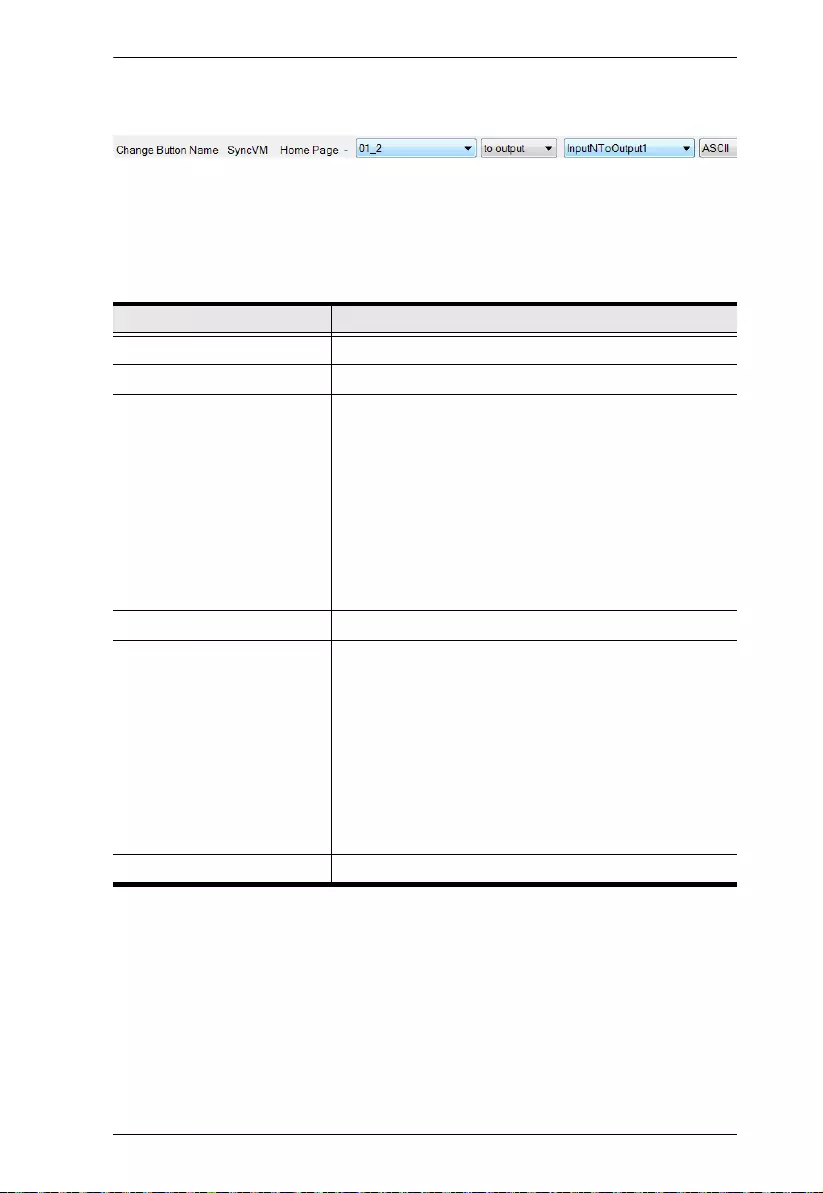
Chapter 4. ATEN Configurator (VK6000)
199
b) Add actions.
In this example, add four Change Button Name commands:
For details, see Device Functions, page 158 and Advanced Functions,
page 161.
Built-in Commands
Command Description
jsonobj Converts JSON strings to tables.
vk_ascii_to_hex Converts strings from ASCII to Hex.
vk_docommands_ID_name Defines the commands to be executed, e.g.,
vk_docommands_1_output. A
the user should define his/her own commands and their
corresponding IDs. As long as the ID does not change,
the command name can change.
The same ID cannot be used for two different
commands. The same applies to command names.
vk_hex_to_ascii Converts strings from Hex to ASCII.
vk_parser(input1, input2)
Use this command to indicate a start to a set of
scripts.
The brackets should contain equal number of inputs
that you added in the Professional Monitor setup.
If the Trigger Mode is set to independent, the script
should contain only one input, but the number of
parsers should match the number of inputs added
to the Monitor, e.g. vk_parser_1(input),
vk_parser_2(input).
vk_var_ID_name Create a variable.
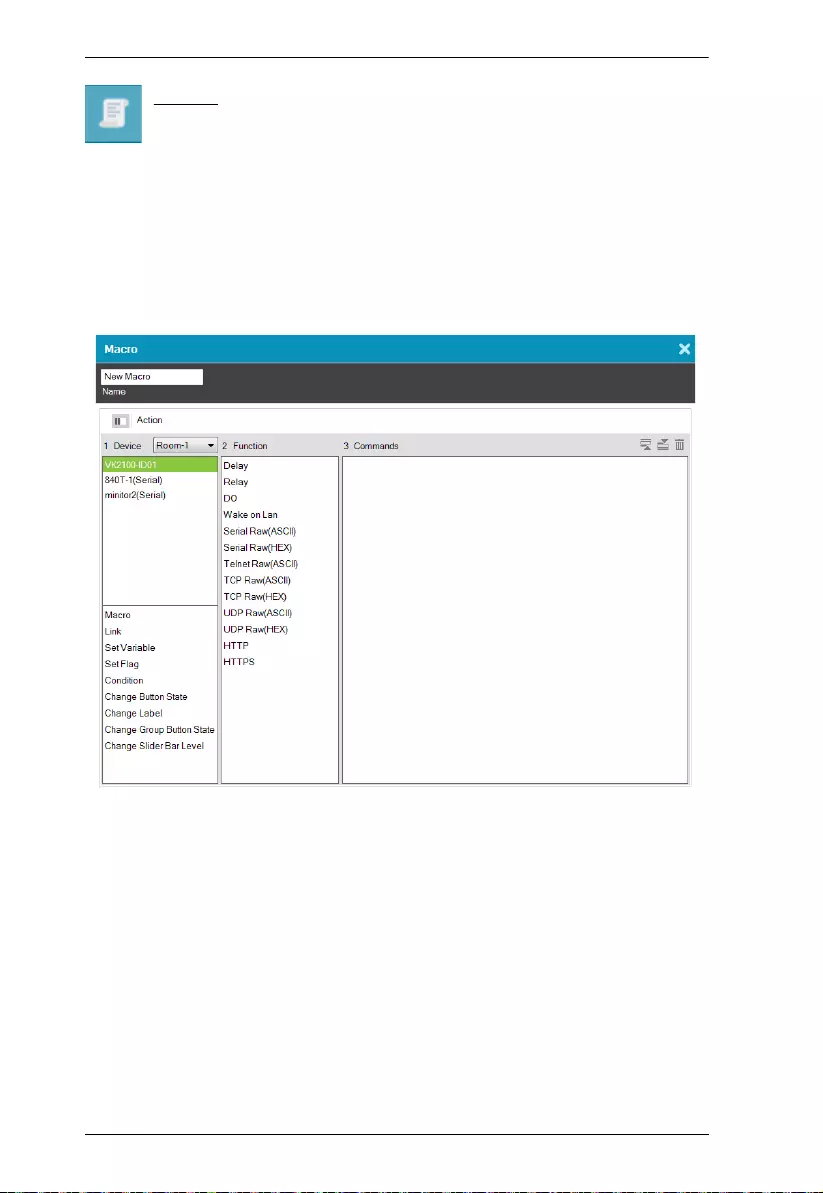
ATEN Control System User Manual
200
Macro
Macros allow you to create a button that will initiate a sequence of
actions across the same or different hardware devices. This saves time
by allowing multiple devices to initiate actions all at once from one button. For
example, you can create a macro to start a video presentation by adding
functions to: dim lights, power on source, power on display, lower screen and
play source. You can also add time delays between actions in a macro. Each
project can store up to 104 macros.
When you click
+
from the Library’s Macro tab, the window opens:
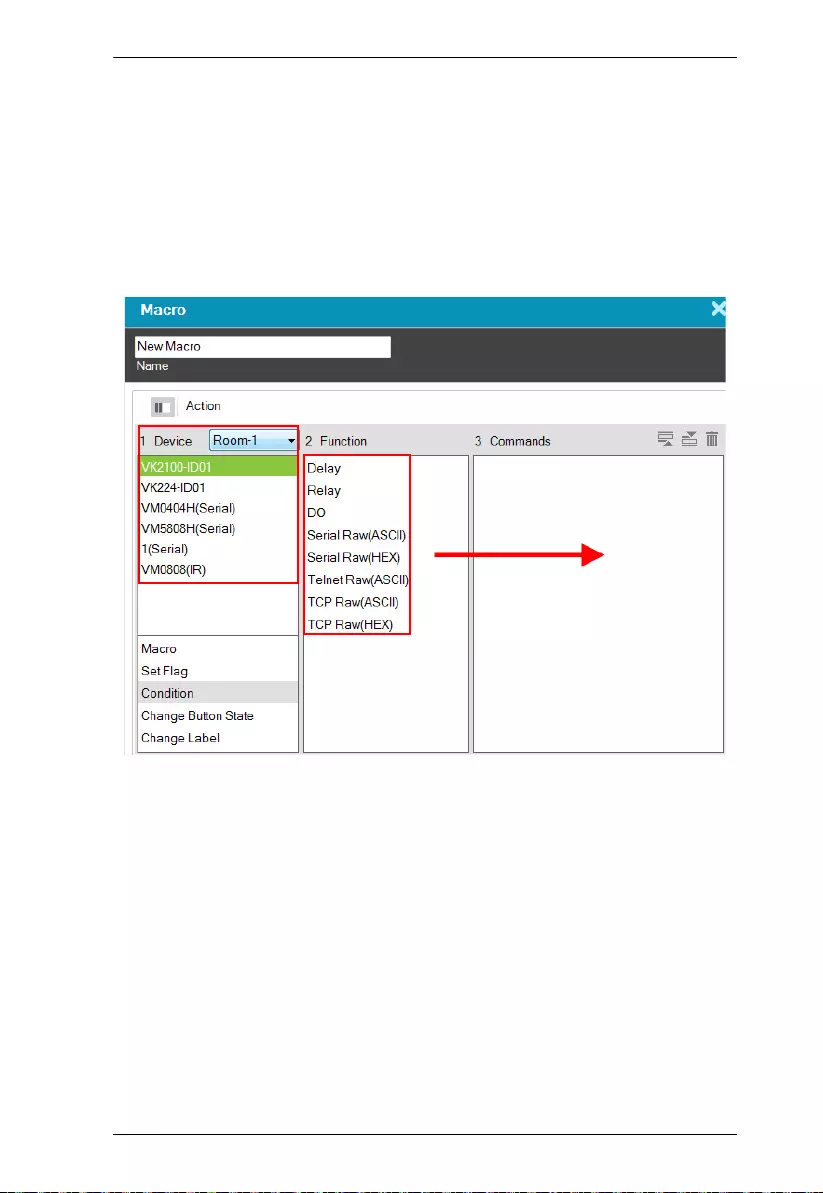
Chapter 4. ATEN Configurator (VK6000)
201
To create a macro:
1. Select Macro and click
+
.
2. Enter a Name and select a Viewer from the drop-down menu, then click
OK.
3. Go to the Actions section at the bottom of the page to select hardware
under Device and add the Function to the Commands list:
Note: For more information about adding Functions, see Button / Slider
Bar / Dial Kit Actions, page 153.
4. After adding all the functions to the Commands list, the macro is complete.
5. In Create Viewer & Design, create a button and add a macro to the Button
Action properties (see page 153) by selecting Macro under Devices (see
Device Functions, page 158 for details).
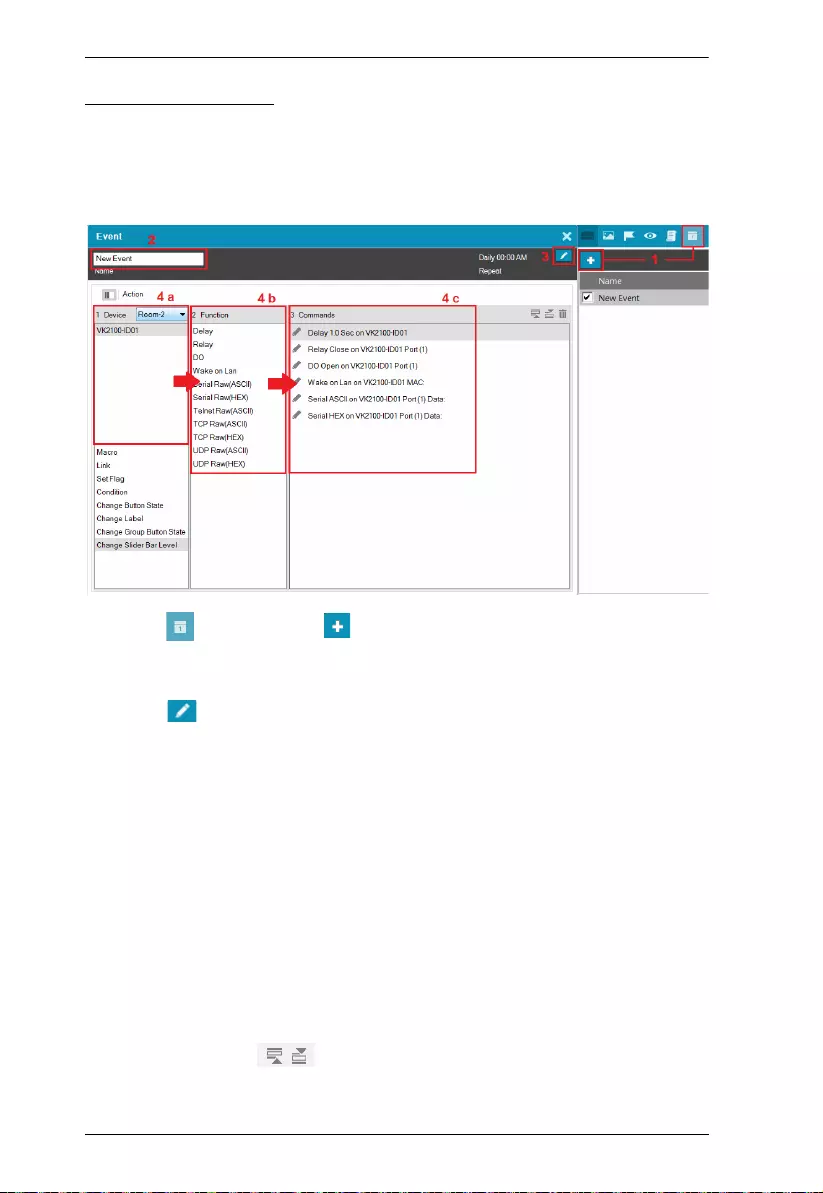
ATEN Control System User Manual
202
Scheduled Events
You can automate ATEN Control System to perform one or a series of tasks on
recurring schedule. Each project can store up to 60 scheduled events.
To create a new event, follow the steps below.
1. Click and then click .
2. Name the event.
3. Click to specify a recurring schedule for the event.
4. Configure event actions.
a) In the Device column, select a device.
b) In the Function column, double-click the desired functions. The
corresponding commands appear in the Commands column. For details
on what each function does, see Device Functions, page 158.
c) In the Commands column, double-click each command to configure the
settings.
5. Optionally add system functions. For detailed information, see
Applications of Advanced Functions, page 163.
6. These commands will initiate in the listed order. To change the order of the
commands, click .

Chapter 4. ATEN Configurator (VK6000)
203
Variables
Understanding Variables
A Variable is a value holder that stores a single device setting (e.g. speaker
volume) and can be assigned to multiple control objects (e.g. a slider button, a
maximum volume button, and a minimum volume button). This way, when a
device setting is adjusted via a Viewer object, the new setting will be loaded
into this Variable and then reflected to all Viewer objects that use this Variable.
Each project can store up to 128 Variables.
This feature is useful for automatic synchronization of device settings,
especially when you have two or more objects in a Viewer controlling a single
device setting. Take the example of controlling a speaker volume on a Viewer.
On your Viewer, you may have a slider bar which you use to adjust the volume,
a button that sets the speaker to its maximum volume, and another button for
minimum volume. When you tap the maximum volume button, you would like
the following status changes reflected on the Viewer:
The maximum volume button shows a toggle-on status
The minimum volume button synchronized with this setting and shows a
toggle-off status
The slider bar synchronizes with this setting and moves to its highest
volume
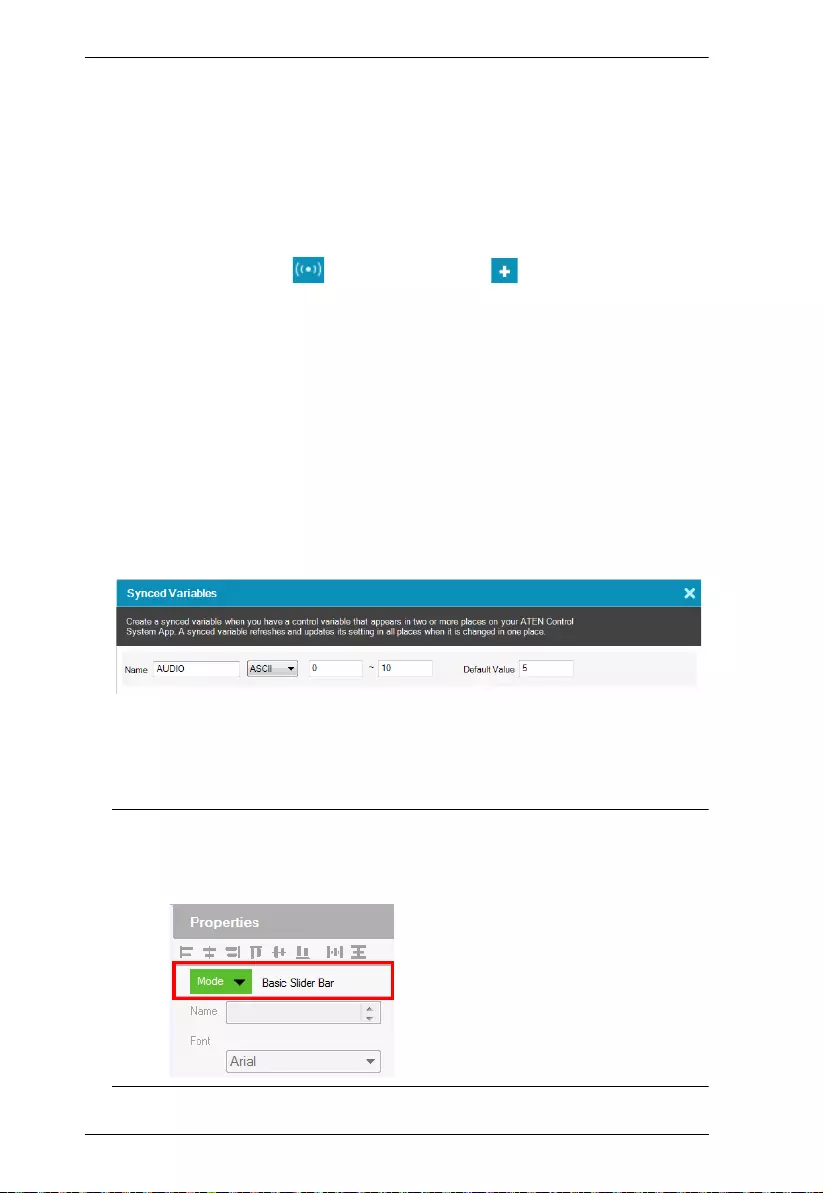
ATEN Control System User Manual
204
Creating a Variable for Devices that Return Feedback Messages
Follow the steps below to configure a Variable if the Variable (device setting)
is for a device that returns feedback messages to the controller.
1. Create a Variable for the device setting (e.g. speaker volume).
a) In the Design tab, click Library.
b) Click the Var iabl e icon and then click .
c) Configure the following settings.
Name: Type a name for the Variable.
String format: Select the string format for the target device.
Setting range: Type two numbers to define the range for the variable.
Valid numbers include negative numbers and numbers that contain one
decimal place.
Note: If one of the numbers contains a decimal place (e.g. -5.0), make
sure to specify the other number in the same format (e.g. 10.0).
Default value: Type a default for the setting.
Your settings may look like this:
2. Configure control objects for the Viewer. For details, see Configuring
Control Interfaces, page 120.
a) In the Design tab, add control objects to your Viewer.
Note: The Variable function is only applicable to toggle buttons, basic-
mode slider bars, and radio groups of normal buttons. Configure the
Mode setting before you proceed.
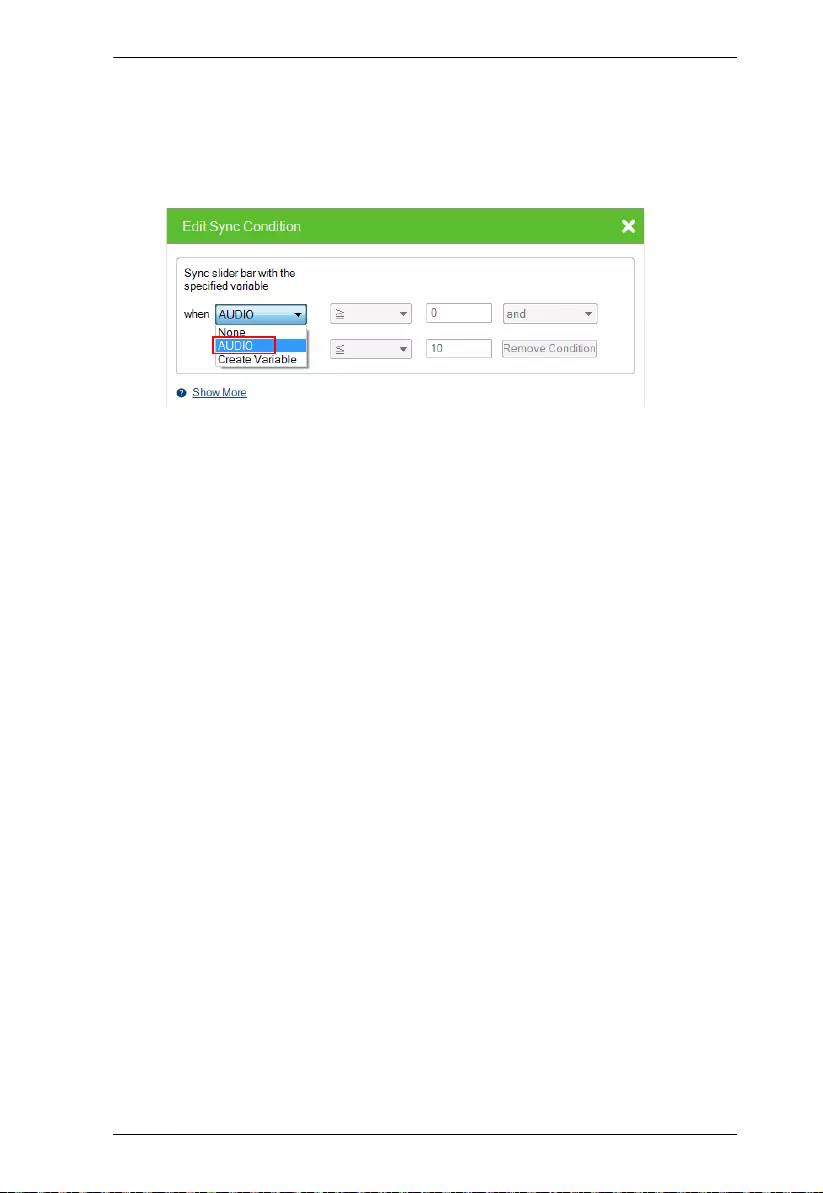
Chapter 4. ATEN Configurator (VK6000)
205
b) For a slider bar object, click it in the Viewer page and configure the
Value settings in Properties.
c) In Properties, click Set Sync Condition and select the variable you
created using the drop-down list.
3. Create a Monitor to set up the conditions for which the device sends its
latest setting to the variable. For detailed steps, see Creating a Bypass
Monitor, page 194.
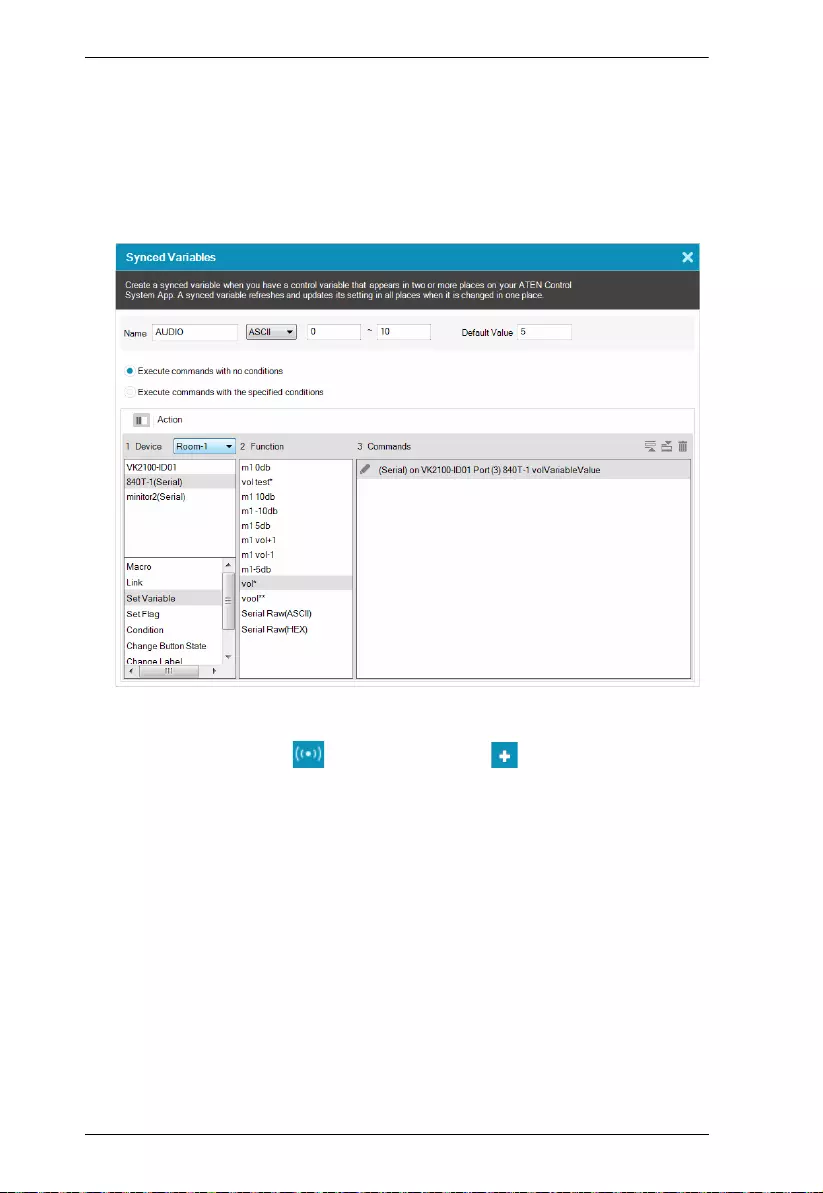
ATEN Control System User Manual
206
Creating a Variable for Devices that Do Not Return Feedback
Messages
Follow the steps below to configure a Variable if the Variable (device setting)
is for a device that does not return feedback messages to the controller.
1. Create a Variable for the device setting (e.g. speaker volume).
a) In the Design tab, click Library.
b) Click the Var iabl e icon and then click .
c) Configure the following settings.
Name: Type a name for the Variable.
String format: Select the string format for the target device.
Setting range: Type two numbers to define the range for the variable.
Valid numbers include negative numbers and numbers that contain one
decimal place.
Note: If one of the numbers contains a decimal place (e.g. -5.0), make
sure to specify the other number in the same format (e.g. 10.0).
Default value: Type a default for the setting.
Select a command execution type.
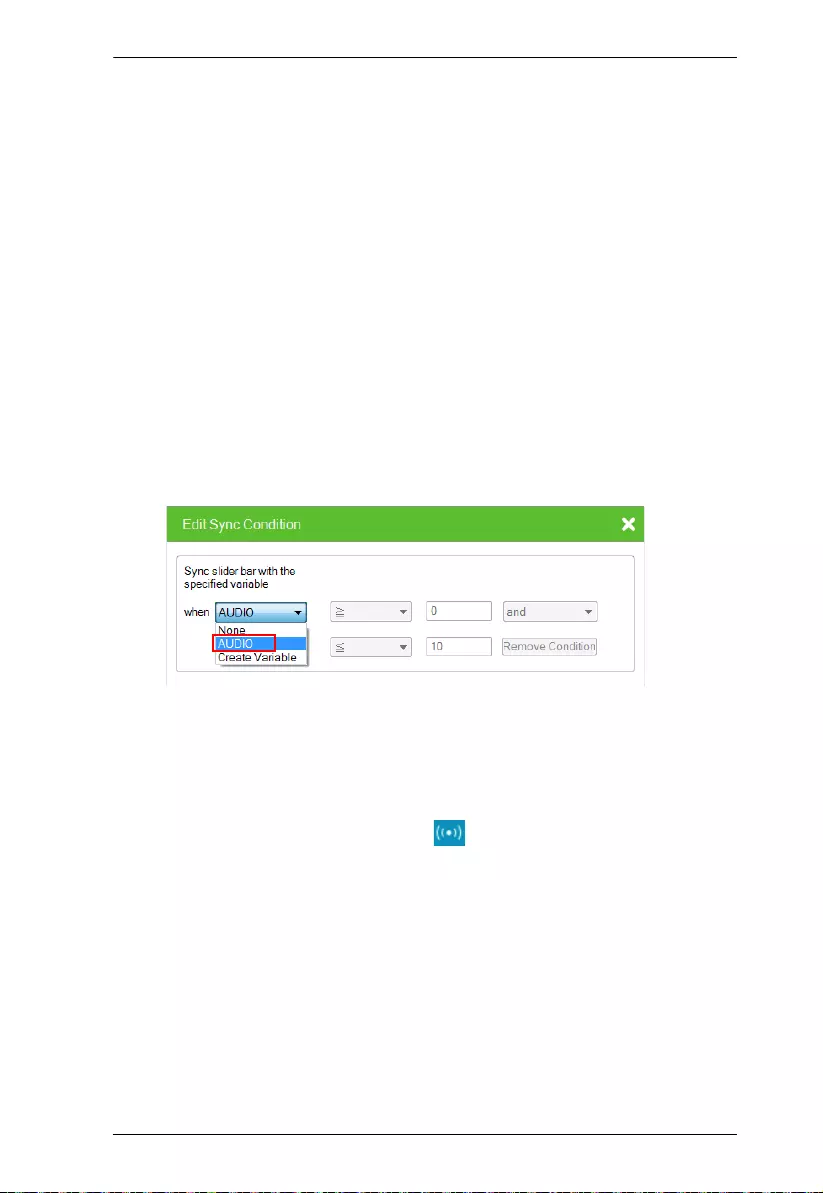
Chapter 4. ATEN Configurator (VK6000)
207
Execute commands with no conditions: Execute the command
(action) when the specified Variable changes.
Execute commands with the specified conditions: Execute the
corresponding command (action) when the Variable matches.
2. Configure control objects for the Viewer.
a) Add a control object to the Viewer. For details, see Configuring Control
Interfaces, page 120.
Note: Make sure to configure the mode setting before proceeding to
the next step.
b) For a slider bar, click it and configure value settings in Properties.
c) Click Set Variable, and then double-click the Variable you created in
step 1.
d) In Properties, click Set Sync Condition and select the Variable you
created using the drop-down list.
3. Repeat steps (a) to (d) with each of the objects. If you select Execute
commands with the specified conditions, follow the steps below to add
commands.
a) Refer to step 4 to first configure the control objects.
b) Click Library, click the Variable icon, and then click the Variable
you created in step 1.
c) Click the drop-down list below the Execute commands with the
specified conditions option and select a condition.
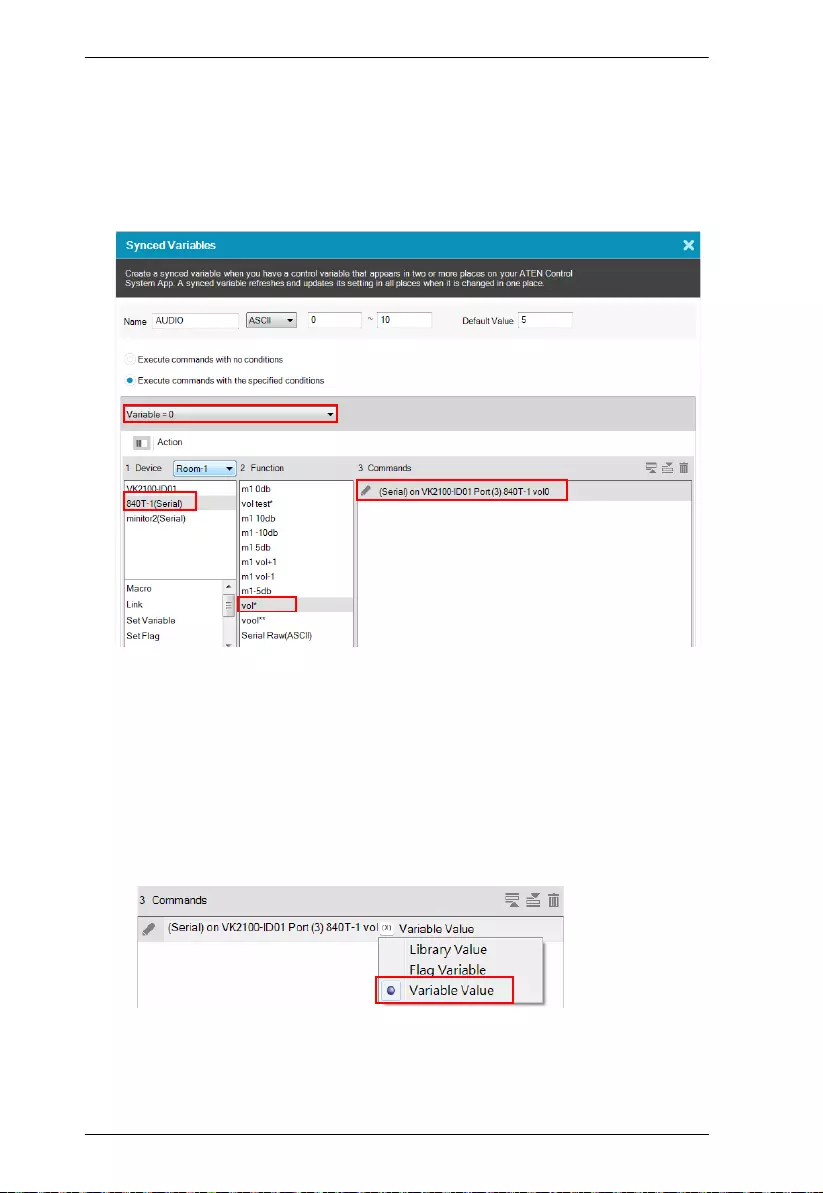
ATEN Control System User Manual
208
d) Add an action (command) when this condition is met. Select a device,
double-click a desired function, and then double-click the command to
configure the setting.
In the case of speaker volume, when the volume changes to 0 (i.e. the
condition is Variabl e = 0), the action will be “to change the speaker
volume to 0”, as illustrated below.
e) Repeat steps 2(c) and 2(d) to add one or more actions to each condition.
4. If you select Execute commands with no conditions, follow the steps
below to add commands.
a) In the Device list, click to select the device. In this example, the mixer,
840T-1(Serial), is selected.
b) Double-click the action (command) and change the value type to
Vari a ble Valu e .
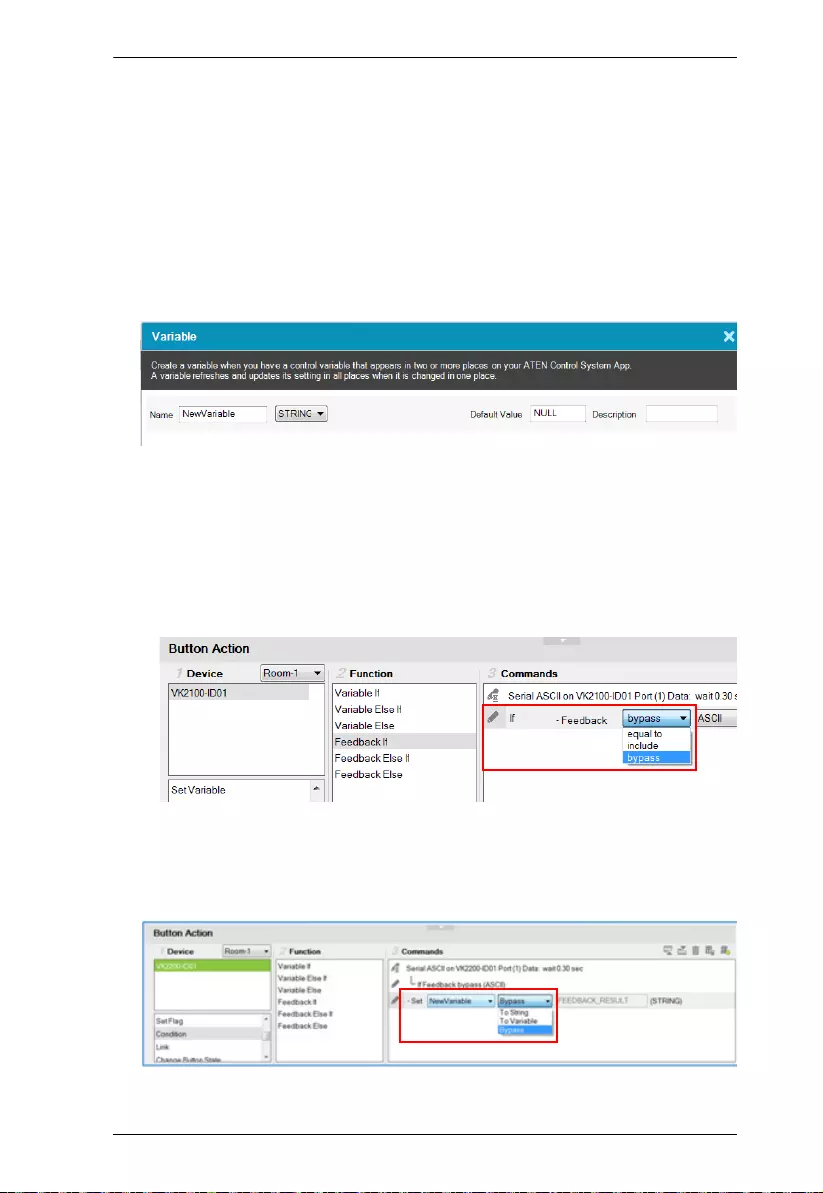
Chapter 4. ATEN Configurator (VK6000)
209
Creating a Button for Bypassing Feedback to a Variable
Instead of creating a monitor event which automatically monitors the specified
parameter at a defined interval, you can save the controller bandwidth by
creating a button which performs the monitoring and saves the feedback to a
variable only when pressed.
1. Create a variable for storing the received feedback. Select STRING for the
variable. Configure other settings as required.
2. In a Viewer page, create a button object.
3. Configure its button actions.
a) Add a command for receiving feedback.
b) Select Condition and then drag-and-drop a Feedback If command
under your feedback command.
c) Set the feedback to bypass.
4. Add a variable command.Select a variable to store the feedback and then
select Bypass.

ATEN Control System User Manual
210
Centralized Monitoring and Control via Unizon™
Overview
Unizon™
Unizon™ is a server-based software for centralized monitoring and control of
standalone ATEN Video Matrix and ATEN-controller-managed AV devices,
including ATEN and third-party devices. One ATEN control system allows
management from up to two Unizon™ servers. Note that a license is required
for using Unizon™. F or more i nfo rmat ion, see ATEN Unizon™ Us er M an ual .
Monitor ATEN-controller-managed Devices via Unizon™
When an ATEN-controller-managed AV device is added to Unizon™, the
follow ing information is available in the Unizon™ platform:
connection status with Unizon™
current IP address
firmware version
license usage (only applicable to ATEN controllers)
You can also create parameters to be monitored via Unizon™. For example,
you may want to monitor the total hours used on a projector lamp so that you
can arrange for replacement in advance when the accumulated lamp hour
reaches a specified number. For setup details, see Creating a Monitor Item,
page 212.
Control ATEN-controller-managed Devices via Unizon™
You can remotely operate ATEN-controller-managed devices via Unizon™,
such as switching video sources on displays, changing the resolution setting,
etc., by creating control items in the controller project file. For setup details,
see Creating a Control Item, page 215.
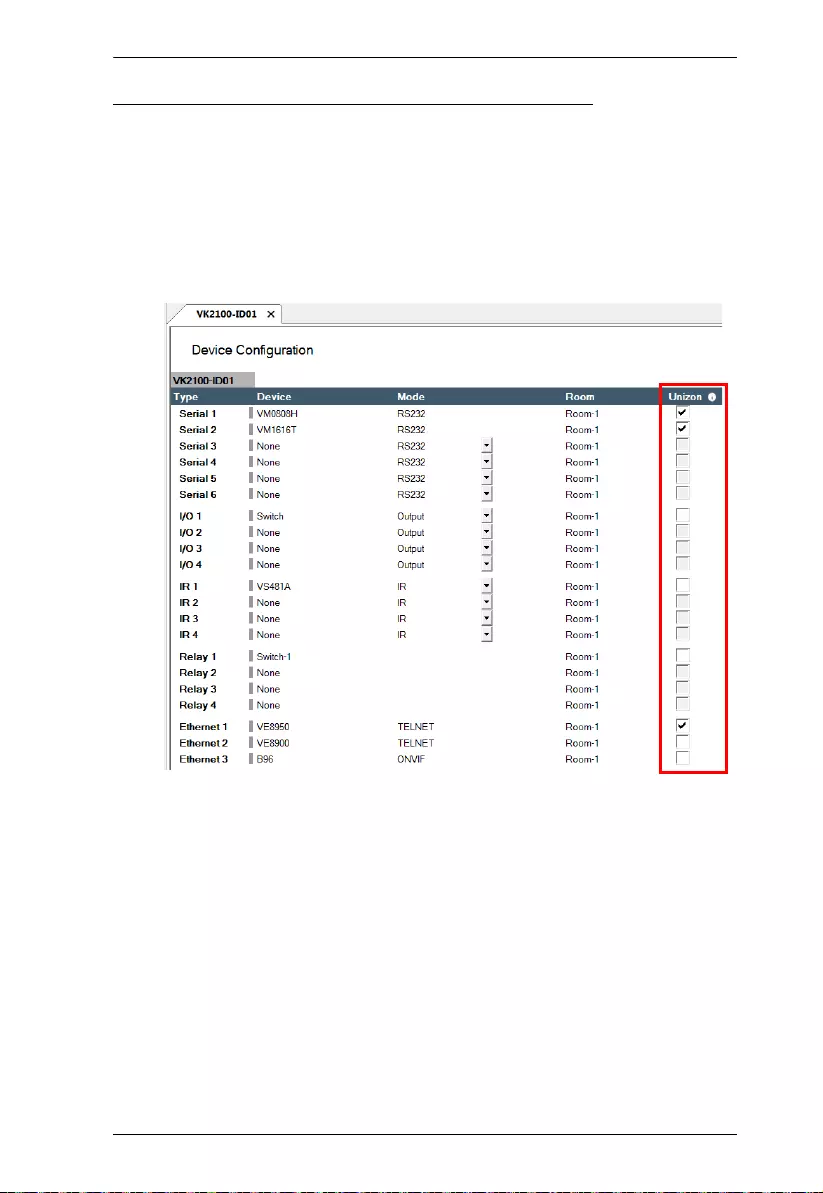
Chapter 4. ATEN Configurator (VK6000)
211
Enabling Monitoring and Control via Unizon™
Follow the steps below to enable monitoring and control of controller-managed
devices via Unizon™.
1. In Configurator, select devices to allow management via Unizon™.
a) Open the target project and go to the Device tab.
b) In the Unizon column, select devices for remote management via
Unizon™. For example:
2. (Optional) Create parameters for monitoring and/or control. For detailed
steps, see:
Creating a Monitor Item, page 212
Creating a Control Item, page 215
3. Upload the project to the controller.
4. On Unizon™’s web interface, add the controller. For details, see ATEN
Unizon™ User Manual.
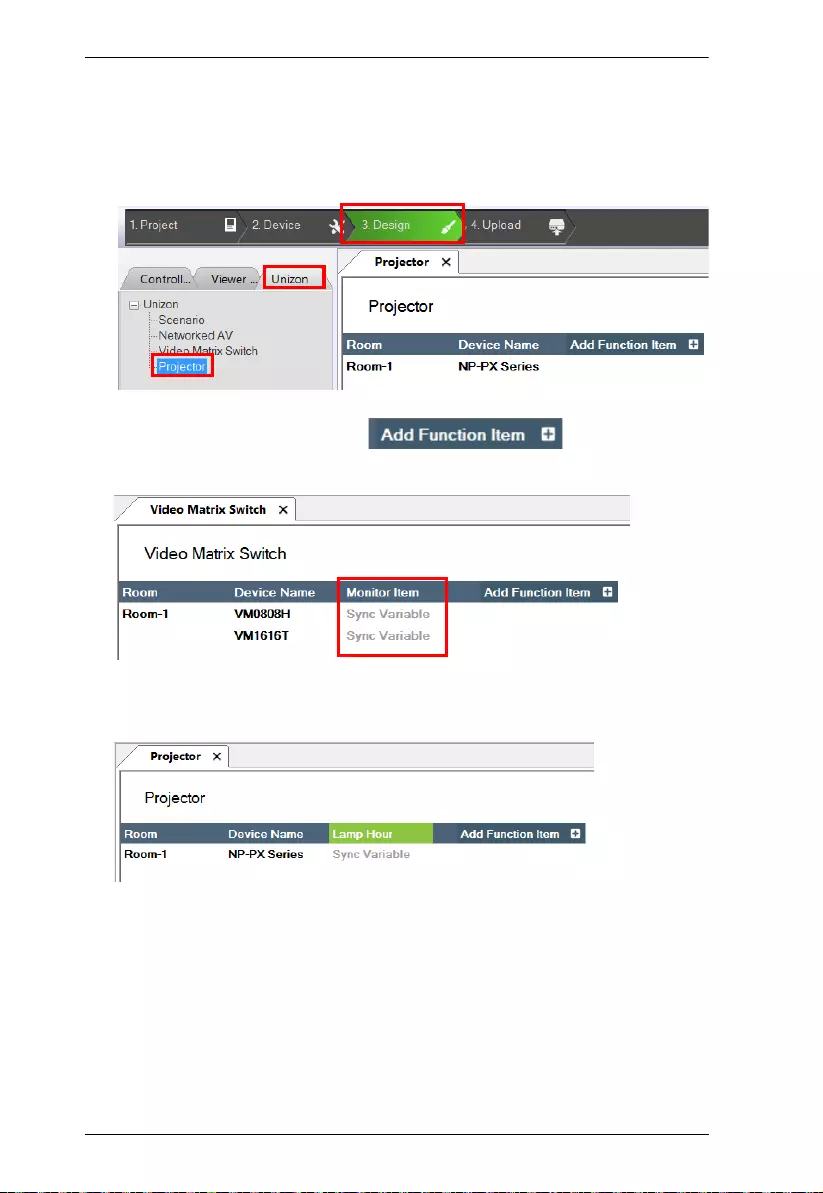
ATEN Control System User Manual
212
Creating a Monitor Item
1. Open the project file, go to Design > Unizon, and click on the device
category of the target device to open the configuration page.
Example: To add a monitor item to a third-party projector, click Projector.
2. In the configuration page, click and then select
Add Monitor Item in a pop-up dialog box. A new monitor item is added.
3. Double-click the header Monitor Item to rename the parameter.
Example: Rename it to Lamp Hour.
4. Create a variable to store the value of the parameter and optionally
configure alert settings.
Example: Create a variable to store the accumulated lamp hour and set up
an alert at a specific number.
a) Under the monitor item you just created, click Sync Variable. The
Properties panel appears on the right.
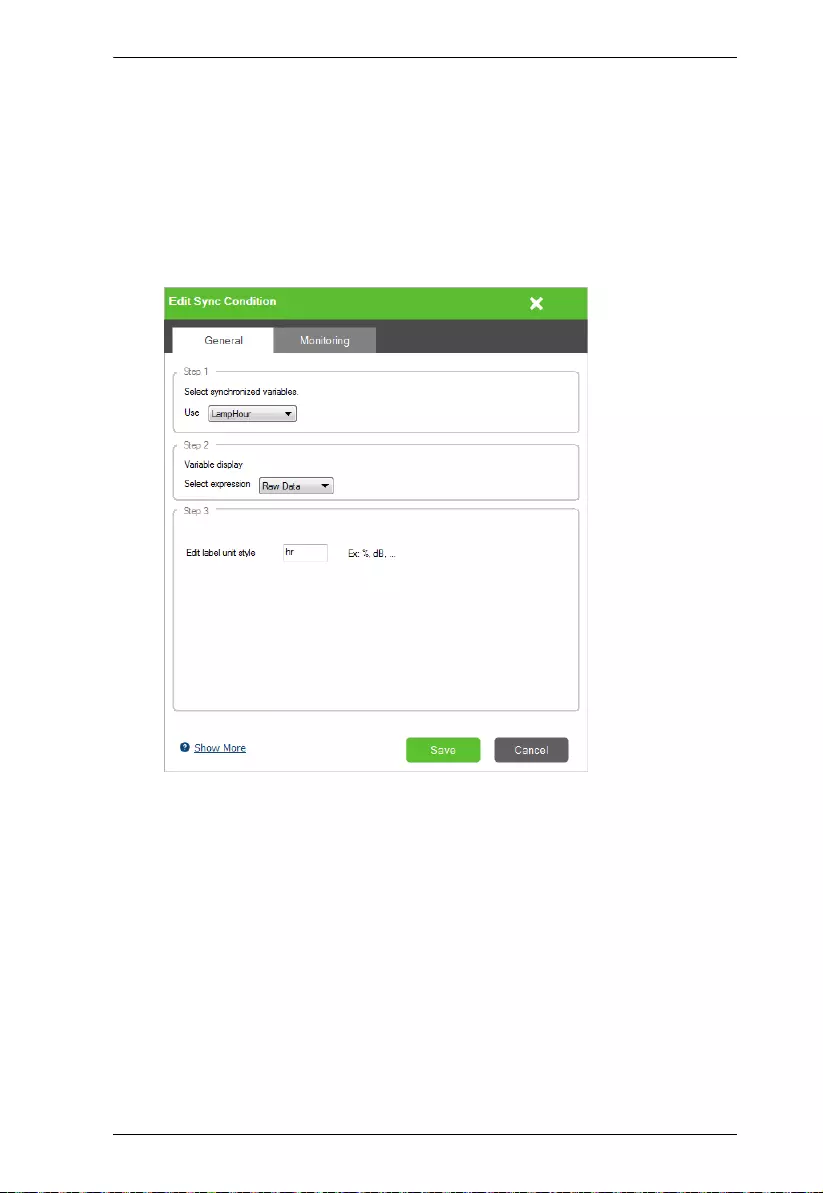
Chapter 4. ATEN Configurator (VK6000)
213
b) In the Properties panel, click Set Sync Condition. The Edit Sync
Condition dialog box appears.
c) In the General tab, click the first drop-down menu and select Create
Vari a ble to create a variable. For details about creating variables, see
Variables, page 203.
d) In the General tab, select the variable you just created and configure
related settings. For example:
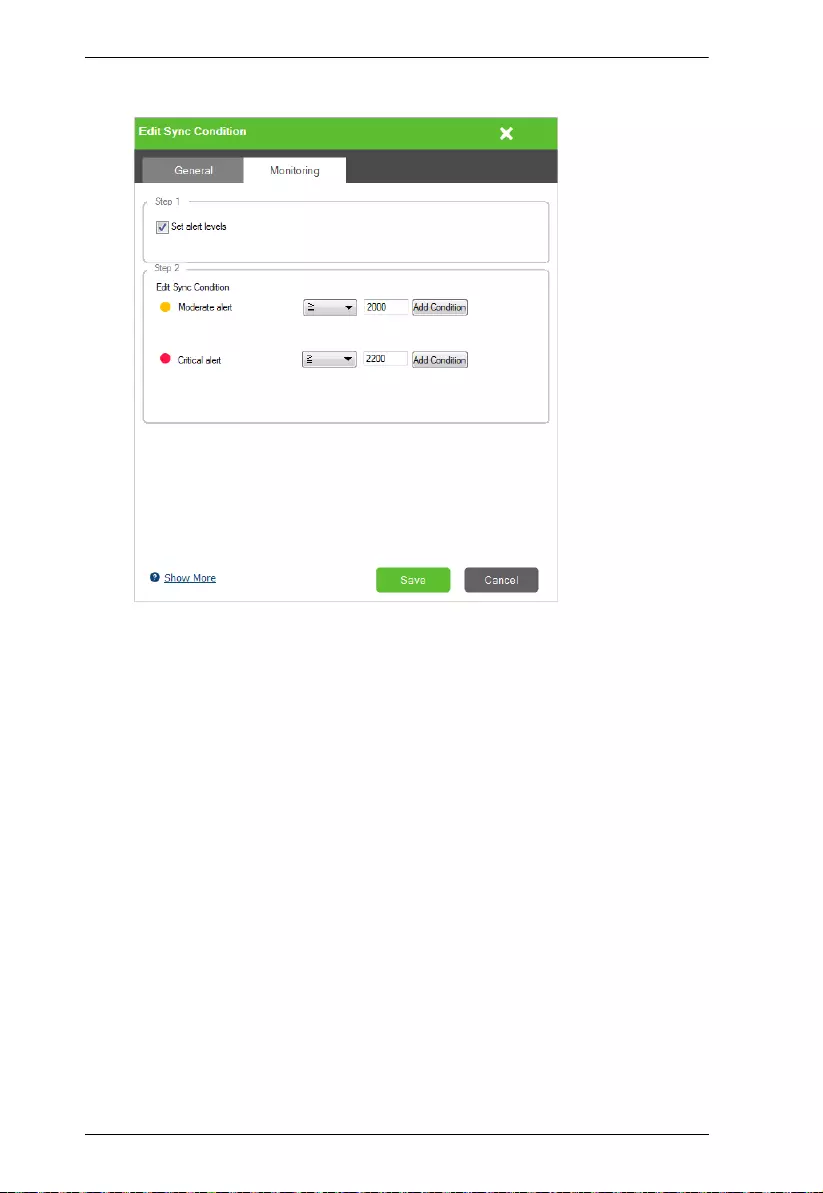
ATEN Control System User Manual
214
e) Optionally set up alerts for this monitor item. For example:
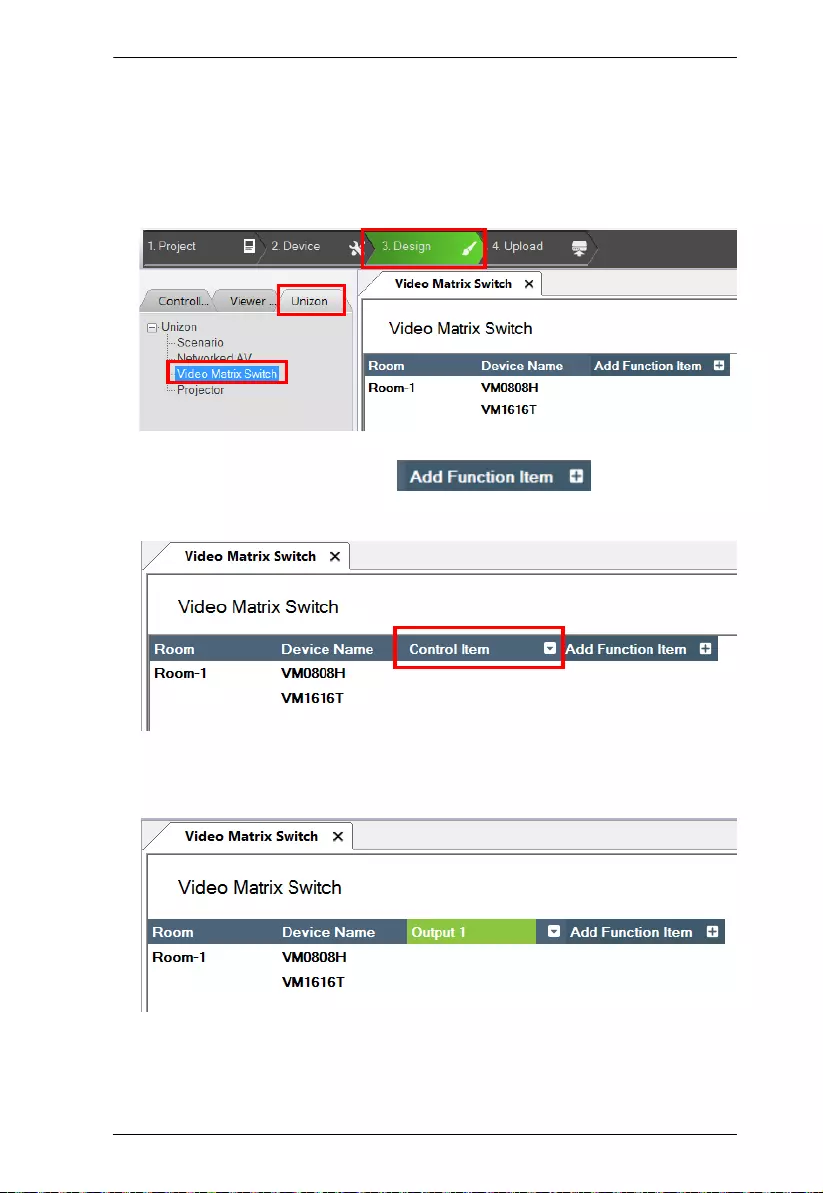
Chapter 4. ATEN Configurator (VK6000)
215
Creating a Control Item
1. Open the project file, go to Design > Unizon, and click on the device
category of the target device to open the configuration page.
Example: To add a control item to a Video Matrix, click Video Matrix
Switch.
2. In the configuration page, click and then select
Add Control Item in a pop-up dialog box. A new control item is added.
3. Double-click the header Control Item to rename the parameter.
Example: Rename it to Output 1.
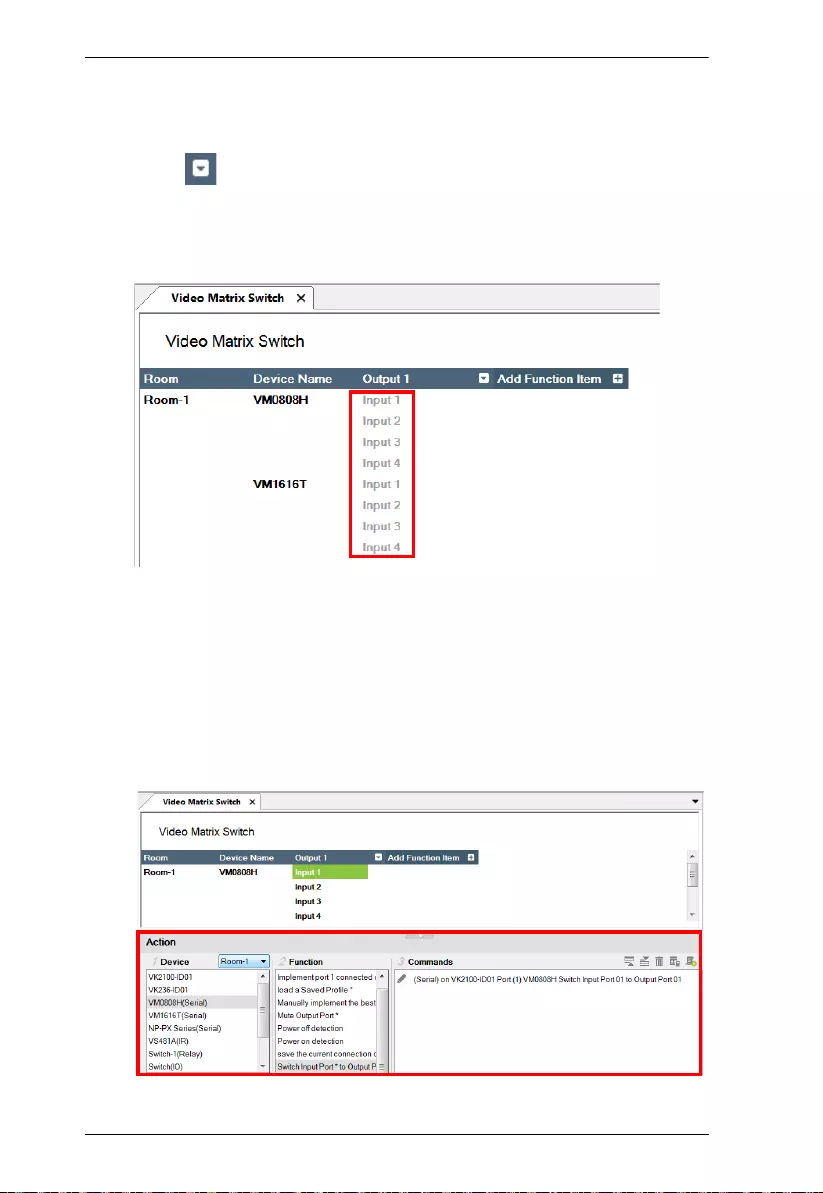
ATEN Control System User Manual
216
4. Add and configure control options to this item.
Example: Create input 1 to 4 as options for switch the source on output 1.
a) Click .
b) In the pop-up dialog box, type the name of the control option and click
Create. Proceed to create all the control options as required.
Example: Type Input 1 and click Create. Add Input 2, 3, and 4.
c) Click Input 1 and add the action in the Action panel. Proceed to
configure each control action.
Note:
The same entries are created for all devices in the list. Skip this step if
the control action does not apply.
For full details about configuring control actions, see Configuring
Button/Slider Bar Actions, page 155.
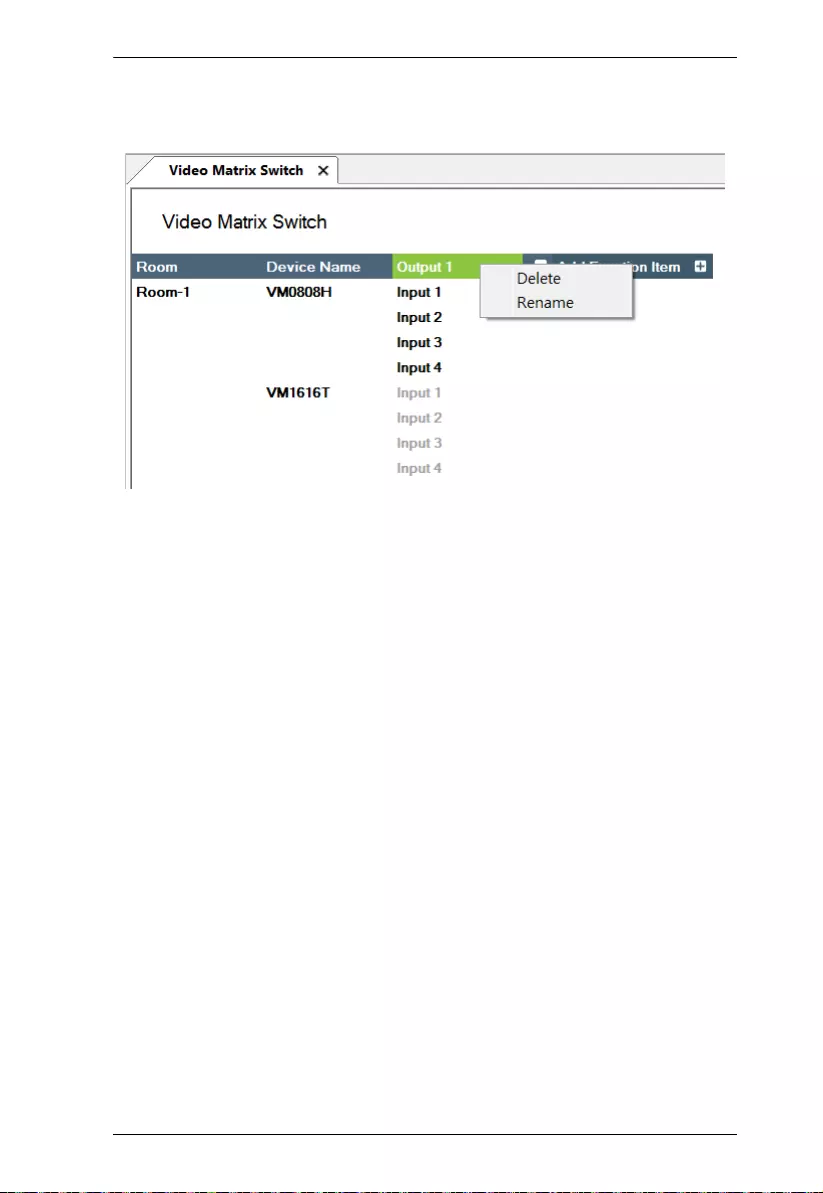
Chapter 4. ATEN Configurator (VK6000)
217
Removing a Monitor / Control Item
To remove a monitor or control item, right-click the header and select Delete.
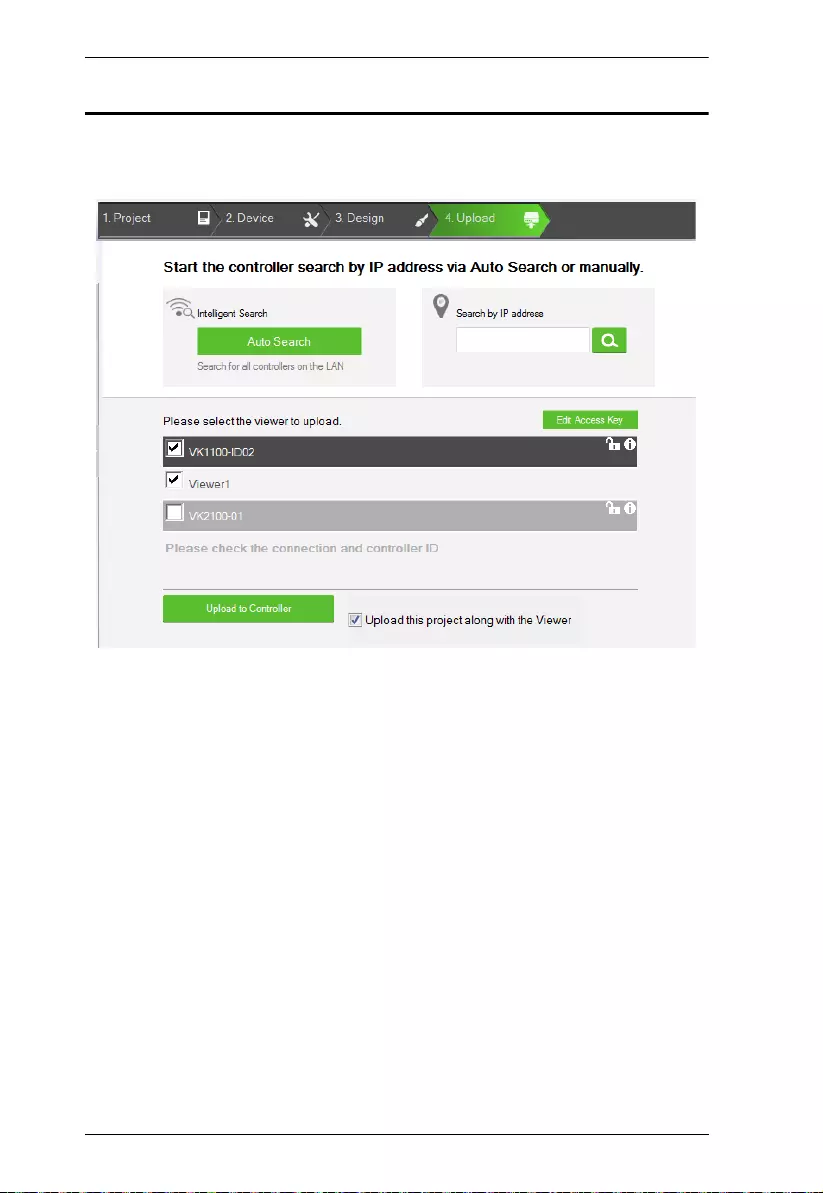
ATEN Control System User Manual
218
The Upload Tab
The Upload page allows you to upload Viewers and/or back up projects to con-
trollers.
To back up a project and its Viewers to a controller:
1. Browse for the ATEN controller where you wish to save the configured
Viewers.
Auto Search: Browses for controllers on the same LAN with the
Configurator.
Search by IP address: Use this function to browse for controllers that
are on different LANs to the Configurator.
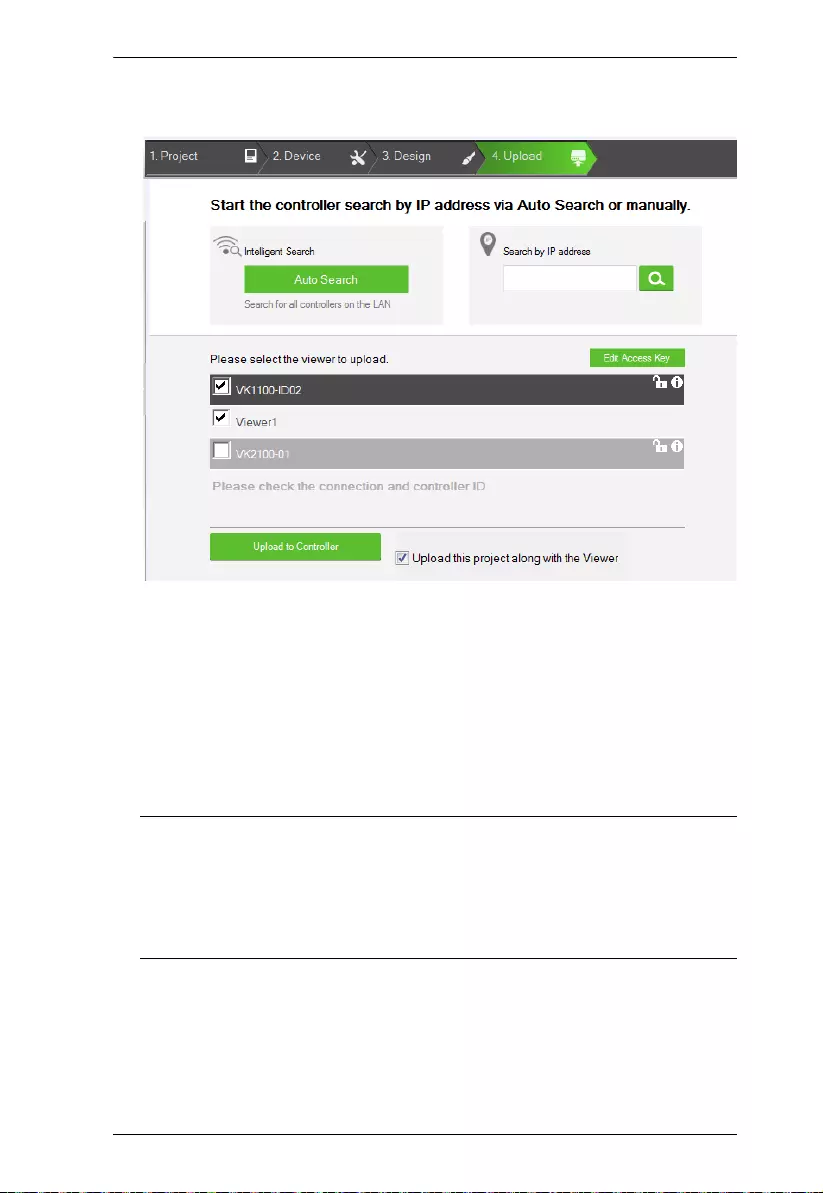
Chapter 4. ATEN Configurator (VK6000)
219
2. Verify the selected controller and viewer and configure the selection if
required.
Controller highlighted black: This is the controller that is found in the
network and its ID matches the one you specified in this project file.
The viewers created for the controller are listed below this item.
Controller highlighted gray: This is the controller that also exists in the
network, but does not match the controller ID specified in this project
file.
3. Optionally click on the following to configure password authentication
settings.
Note: Due to security concerns, the access key of any ATEN controller
will need to be modified at least once before the controller can be
accessed for any of its functions. If you have not modified the access
key, the upload will not be performed. To resolve this issue, log in
to the controller’s web interface and follow the on-screen prompt to
modify the access key.
Edit Access Key: Click to edit the access key you entered for
uploading Viewers to the controller and download Viewers from a
mobile device.

ATEN Control System User Manual
220
Note: A valid access key should only contain upper-case alphabets,
lower-case alphabets, and/or numerals. : An access key is required
to upload Viewers to the controller and download Viewers from a
mobile device.
: An access key is not required to upload Viewers to the
controller and download Viewers from a mobile device.
: The access key has been changed on the controller’s web
interface (Dashboard). To change the lock status, click on the icon and
type the new access key to proceed.
4. Click Upload to Controller.
Note: By default, the project file is uploaded along with your selected
Viewers. To only upload the selected Viewers, click Also upload
project file to disable the function.

Chapter 4. ATEN Configurator (VK6000)
221
Viewing Controller Information
Click to view the controller’s information.
IP Address: Displays the IP address.
MAC Address: Displays the MAC address.
License: Displays the number of licenses available and in use.
Select License: Allows you to load a new license file.
Reset License: Resets all license(s) in use by mobile devices. This will
disconnect all mobile device connections to the controller.
Firmware Version: Displays the firmware version.
Capacity: Displays the amount of space available for uploading Viewers.
Viewers: Lists the Viewers currently stored on the controller.
Remove Viewer: Click the trash can icon to remove the Viewer stored
on the controller.
Project: Lists the project file currently stored in the controller.

ATEN Control System User Manual
222
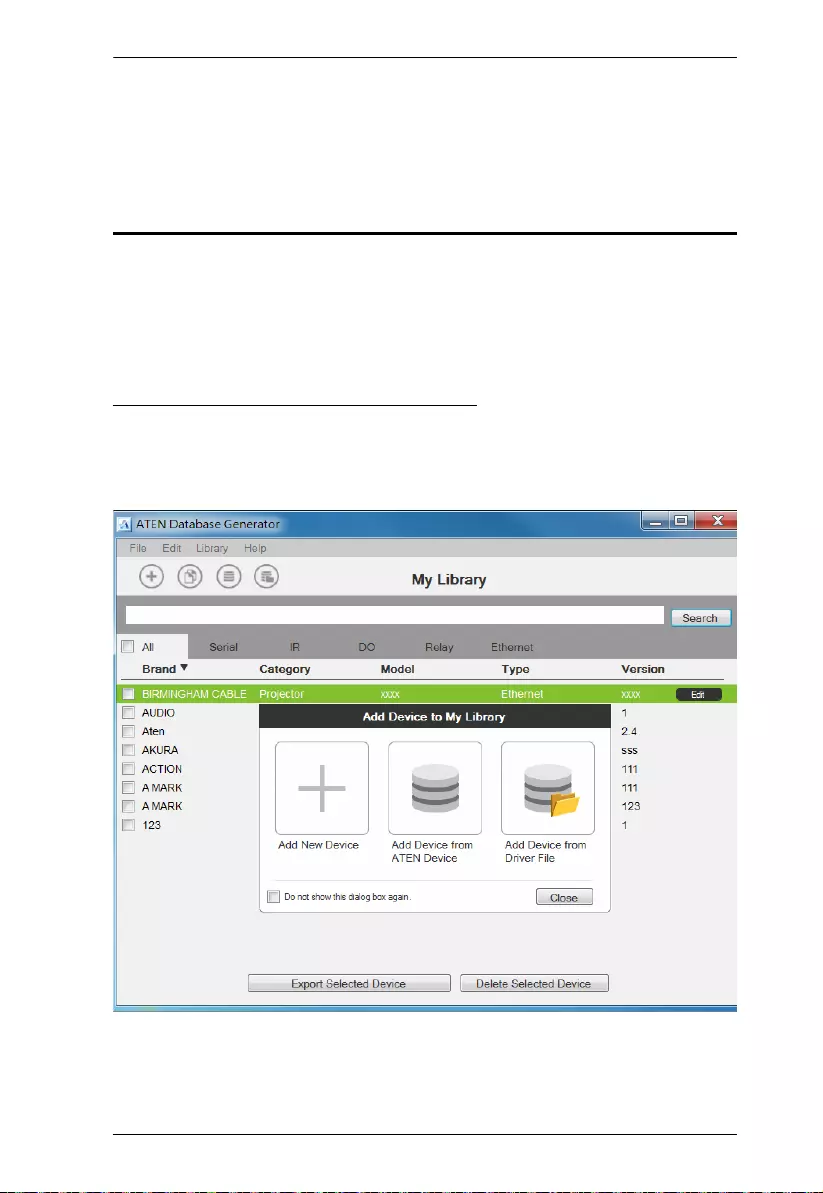
Chapter 5. ATEN Database Generator
223
Chapter 5
ATEN Database Generator
Overview
The ATEN Database Generator is a repository that allows you to establish and
store commands for operating devices managed by ATEN Control System, and
reuse them when configuring Viewers.
Accessing the Database Generator
In ATEN Configurator, goto Tools
>
Database Generator. The following
window appears with the Add Device to My Library dialog box opened if you
are accessing the Database Generator for the first time.

ATEN Control System User Manual
224
Menu Description
Add New Device Configure a custom hardware device to add to My Library.
Add Device from
ATEN Device Library
Add devices from the ATEN Device Library to My Library.
Add Device from
Driver File
Add devices from a database file (*.vkd) to My Library.
Check Box Click Do not show this dialog again to prevent the dialog from
appearing when the Database Generator is opened. Use the
Preferences menu option to bring the dialog window back.
Close Click the Close button to exit the dialog window.
Add New Device Configure a custom hardware device to add to My Library.
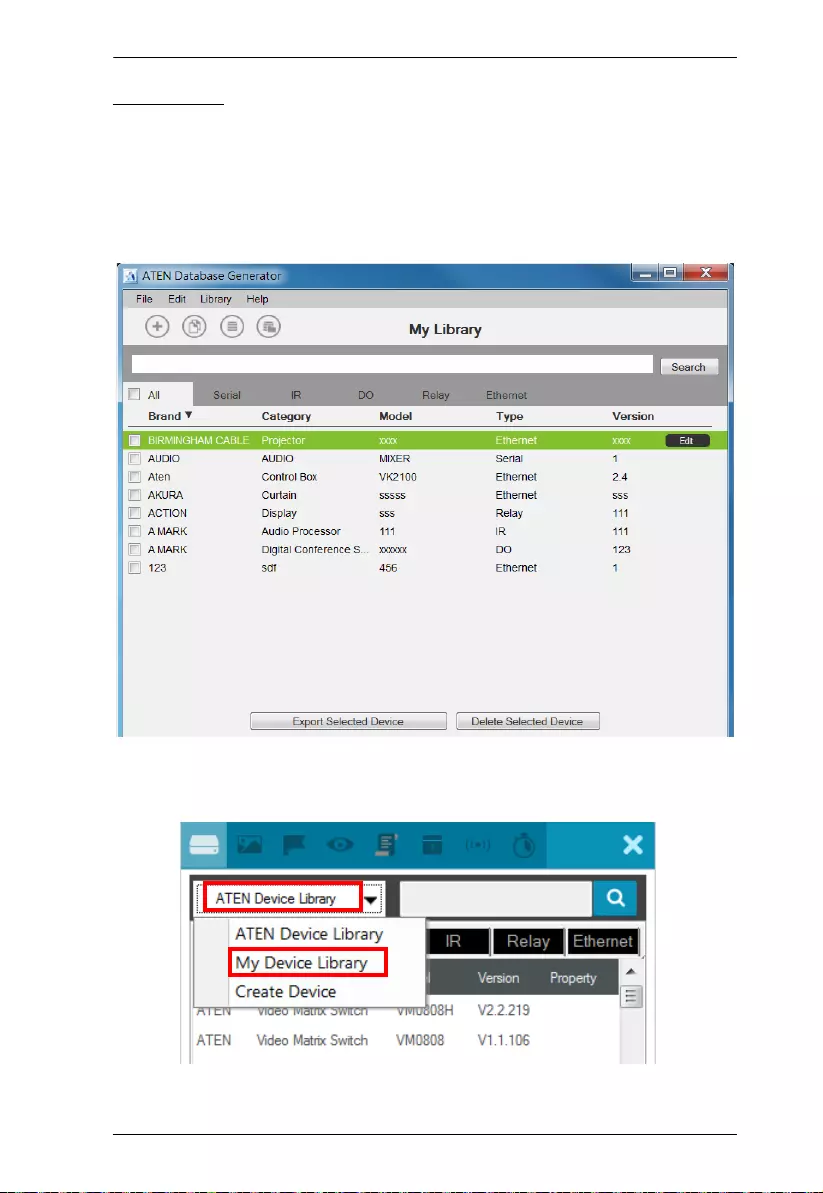
Chapter 5. ATEN Database Generator
225
My Library
My Library allows you to create custom hardware devices which can be
selected to configure ports on the controller. My Library lists all the hardware
devices that you have created, added, and edited using the Database Generator.
You can create new hardware devices or add existing devices from the ATEN
Device Library (page 247). These devices can then be selected from My
Device Library for use.

ATEN Control System User Manual
226
Function Tabs
More functions can be accessed from the function tabs toward the top of the
My Library window. Refer to the table below for information about each
function.
Tab Description
File The File menu provides options to:
Add New Device: Configure a custom hardware device
to add to Device Library.
Add Device from ATEN Device Library: Add devices
from the ATEN Device Library to My Library.
Add Device from Driver File: Add devices from a data-
base file (*.vkd) to My Library.
Export My Library: Saves My Library as a database file
(*.vkd) that can be imported later.
Export Selected Device: Saves the selected device(s)
as a database file (*.vkd) that can be imported later.
Controller Connection: Searches for a controller to
test the connection or run the learning mode for the IR
port.
Quit: Exits the program.
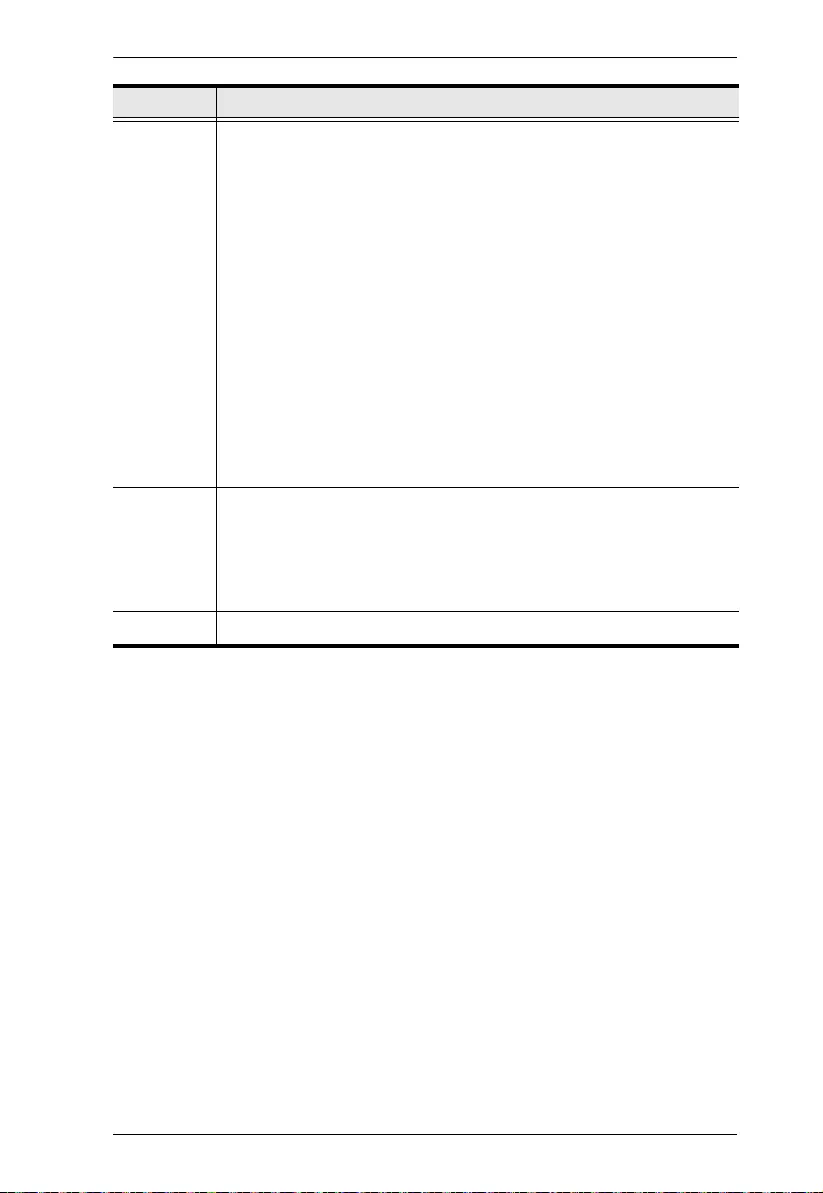
Chapter 5. ATEN Database Generator
227
Edit The Edit menu provides options to:
Delete: Deletes the selected devices from the data-
base.
Duplicate: Makes a copy of the selected device(s) and
adds them to the library with the extension “-Copy”
Preferences: Provides options to:
Set the Language
Show Add Device dialog on startup
Show IR Learning tips
Set the IR Learning Timeout - how long to attempt a
connection to an IR device before IR learning stops.
Library Provides a list of the Libraries that you can open to select
devices from and edit or add to My Library. The libraries
that are listed here appear when you select a database
using Add Device from Driver File.
Help Provides support and software version information.
Tab Description
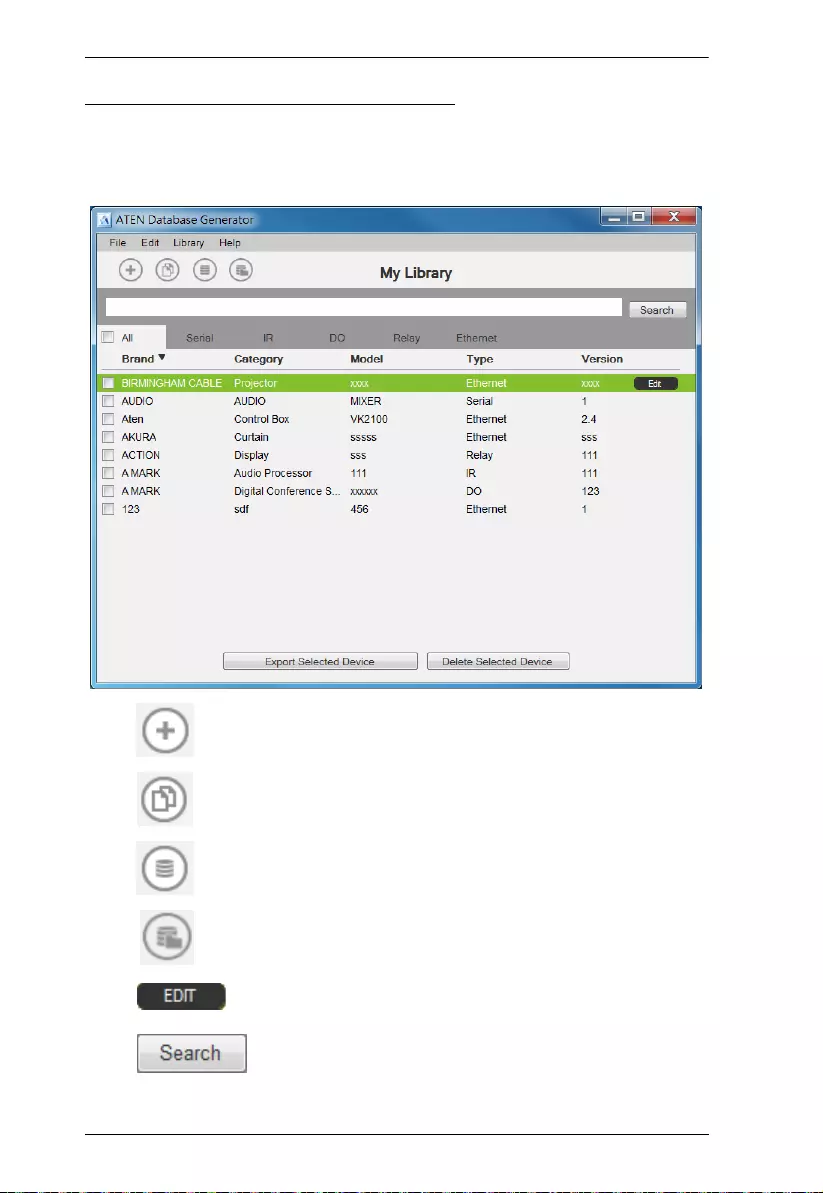
ATEN Control System User Manual
228
Controls on the My Library Window
You can add new devices by creating a new device, duplicating an existing
device, selecting a device from the ATEN Library or importing a driver file.
Use the check boxes to select individual devices or All to select the entire list.
Click to add a new custom device to the database.
Select a device and click this icon to create a duplicate.
Click to add and edit a device from the ATEN Device Library.
Click to add a device from the driver file.
Select a device and click Edit to change the settings.
Key in word strings then click Search to find a device.

Chapter 5. ATEN Database Generator
229
Click All, Serial, IR, DO, Relay or Ethernet to filter the list by type.
Click Brand, Category, Model, Type or Version to sort the devices.
Click Export Selected Device to save the selected devices.
Click Delete Selected Devices to remove the selected devices.

ATEN Control System User Manual
230
Editing / Adding a New Device
To edit or add a device to My Library, do the following:
1. From the menu select File
→
Add New Device, or select a device from My
Library and click Edit.
2. Under General, use the drop-down menus or type in the Brand Name,
Category, Model and Ve r s io n .
Note: The Category determines what buttons are auto generated when a
Viewer page is created for the device.
3. Use the History button to open the Version History editor and make notes
about the updates being made to the device configuration. You can create
and use different versions of the same device and track the changes. The
version history can be viewed and different versions selected from the
ATEN Configurator, under device Properties.
4. Check the hardware type and configure the device. ATEN database
generator supports serial, IR, digital output, relay, and Ethernet devices.
For more information about configuring each of these device type devices,
refer to the following sections.
Serial: See Serial Device, page 231.
IR: See IR Device, page 235.
Digital output: See Digital Output Device, page 237.
Relay: See Relay Device, page 238.
Ethernet: See Ethernet Device, page 239.
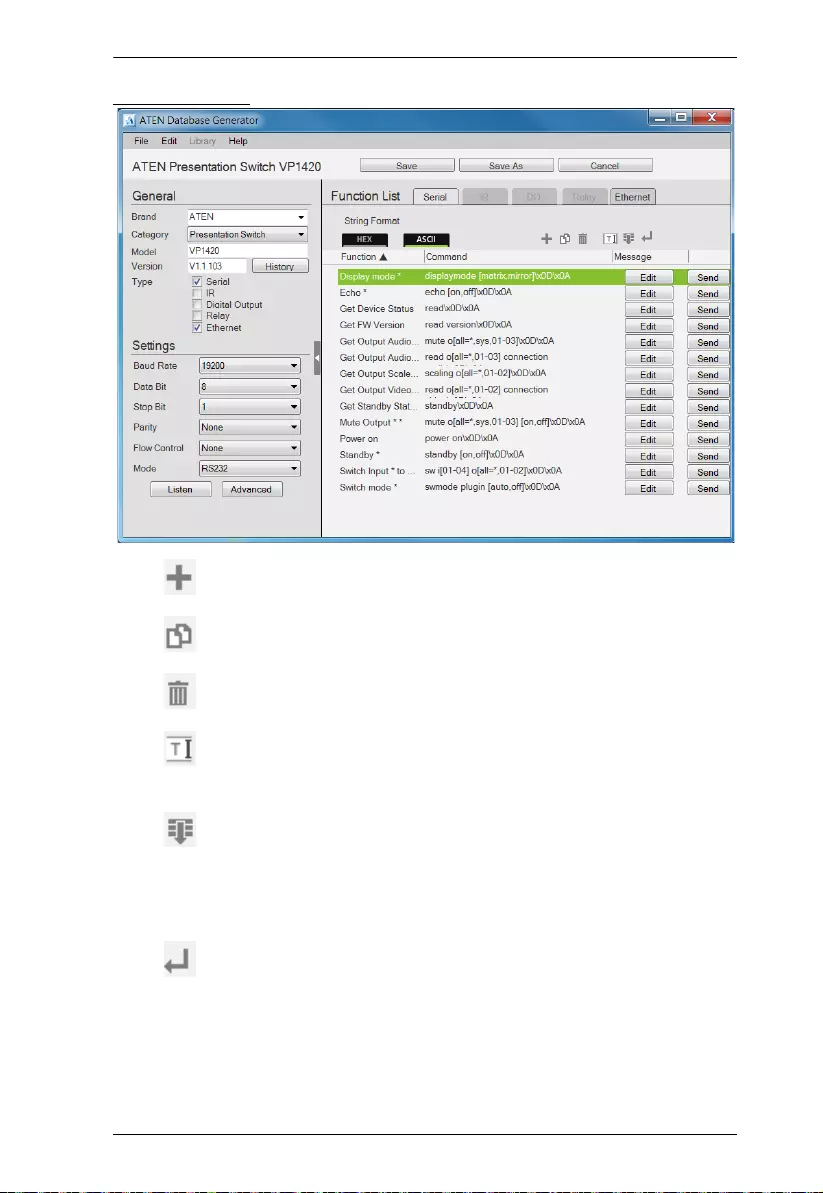
Chapter 5. ATEN Database Generator
231
Serial Device
Click to add an Action.
Click to create a duplicate of the Action.
Click to delete the selected action.
Click to enter a string within () which allows the text to be edited
from the VK6000 in the Button Action - Commands list (see page 155).
Click to add a drop menu into a Command string, then enter the
number sequence in the brackets []. The Function name must include
an asterisk (*) for each drop menu in the Command string.The drop-
down menu will appear where the (*) is entered in the Function name.
Click to add an Enter into the Command string.
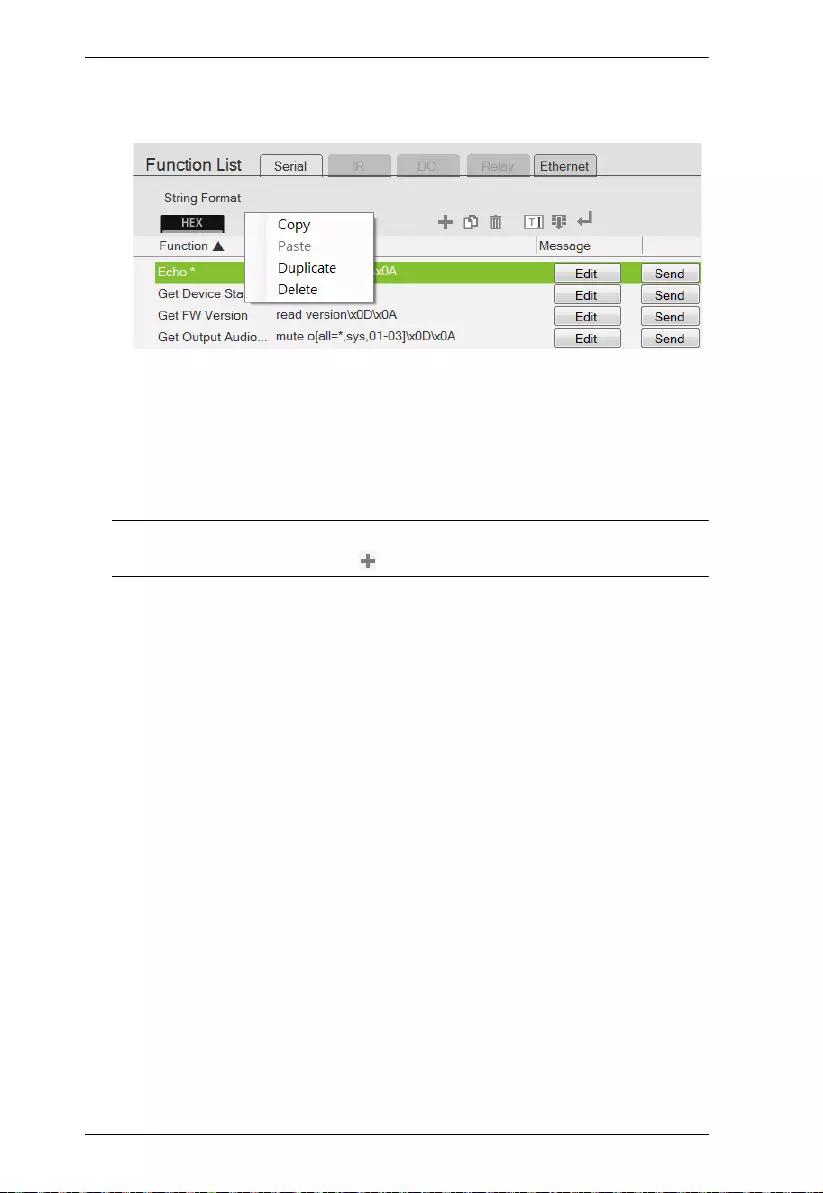
ATEN Control System User Manual
232
Right-click one or more serial commands to copy and paste them as
Ethernet commands of all protocols (except HTTP/HTTPS):
Settings – Use the drop-down menus to set the: Baud Rate, Data Bit, Stop
Bit, Parity, Flow Control and Mode settings.
Listen – Use this function to create a list of device parameters that you
want the controller to monitor by receiving notifications on setting or
status changes of the specified parameters.
Note: To set up queries for the status of a device parameter, go to the
Function List and click to add the querying action as a command.
Advanced
Delay Interval – Sets a time delay for each command before they
are sent to the device.
Feedback Timeout – Sets the maximum interval that the
controller allows in between parts of a feedback message. If the
controller has not received any feedback for longer than the
specified Feedback Timeout, the controller identifies the last bit
of the received information as the end of a feedback message.
Receive Duration – Sets the allowed duration of time for the
serial device to receive a complete message from the controller.
Keep Connection Alive – Specify an interval that the controller
waits before sending the specified command to test if the
connection to the serial device is up or down.
Function List – Use this section to configure the device functions by
adding actions to the list.
String Format – Use the buttons to select HEX or ASCII. To use HEX
strings with ASCII one, select ASCII and type \x before typing the
HEX strings.
Note: HEX strings are also supported under the ASCII format.
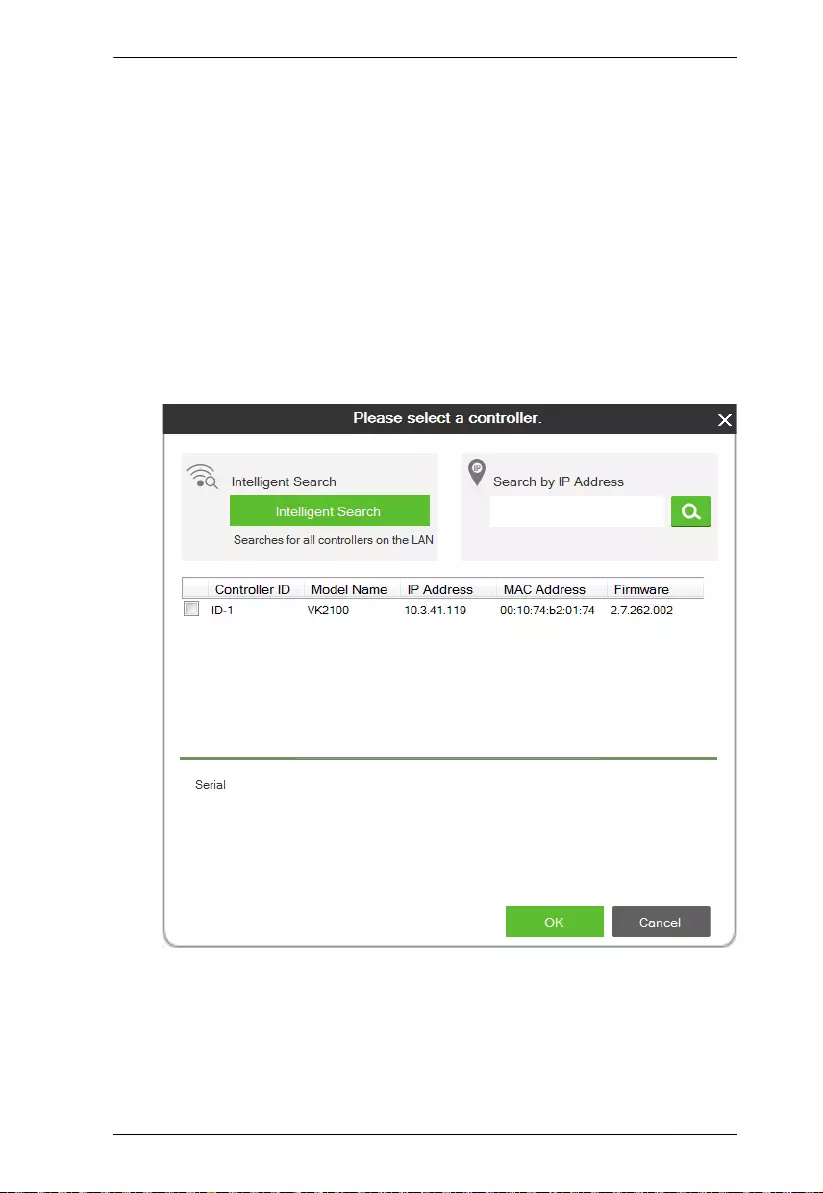
Chapter 5. ATEN Database Generator
233
Function – Lists the actions created for a device. A Function name
must include an asterisk (*) if you are adding a drop menu to the
Command string. Double-click to edit the function name.
Command – Shows the command string created for the action.
Double-click to edit the string.
Message – The Message column is used to create and store feedback
and/or queries for the corresponding command.
For more information about adding feedback, see Testing
Commands, page 243.
For more information about creating queries, see Configuring
Queries, page 245.
Click Send to connect to a controller and test the typed command.
Click to select a controller from the list. Use the Refresh button to
refresh the list. To browse for controllers in the LAN, click the
Intelligent Search button or type the IP address of the controller.
Click OK to proceed to test the command. For details, see Testing
Commands, page 243.

ATEN Control System User Manual
234
Text Command Tools
The following formats allow you to enter command strings with text that
provide special features. These formats work in Serial and Ethernet commands.
() entering text in () allows the command to be edited in the VK6000.
Example: (A1 A9) (A8 B6) – this command string will provide two
editable text boxes from the VK6000 in the Button Action - Commands list
which allow you to change the command string:
=
using the equals sign before a text command allows you to type in
words which will show up in a drop-down menu to describe the command,
rather than show the text command itself.
Example: [Power On=0A,Power Off=0B,Standby Mode=0C] – this
command string will provide a drop-down menu with three choices using
the text before the equal signs to describe each command – from the
VK6000 in the Button Action - Commands list:
““
quotation marks allow three symbols (, = @) to be added to a
command that uses the equal sign as described in the example above.
Three symbols not allowed within the quotation marks include (“” () []).
Quotation marks can be used to the left of
=
in a HEX command; on either
side of
=
in an ASCII command; and anywhere in an Ethernet command.
HEX Example: [“Power=On”=0A,”POWER=Off”=0B]
ASCII Example: [“Power=On”=pwn,”POWER=Off”=pwf]
In the HEX example, “Power=On” allows the equal sign to be inserted
before =0A. If the quotes are removed, the command Power=On=0A
would fail as an Invalid String.
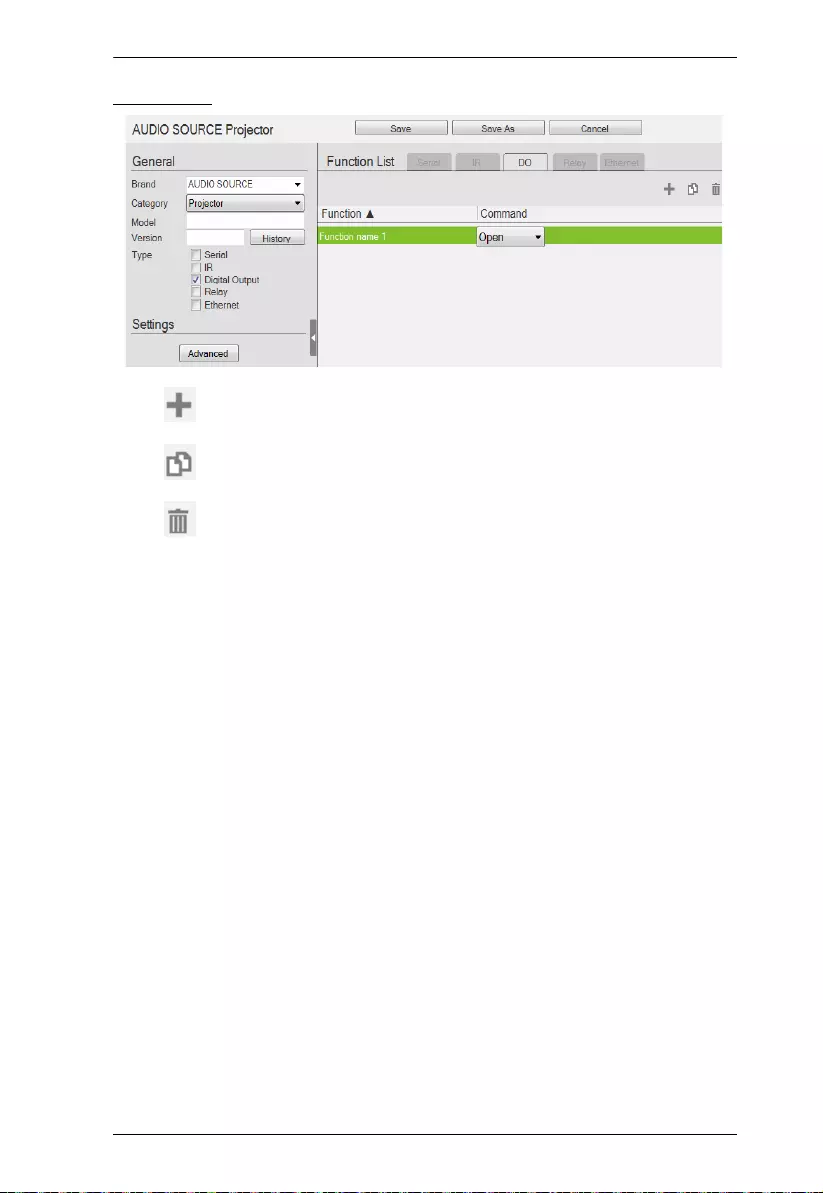
Chapter 5. ATEN Database Generator
235
IR Device
Click to add an Action.
Click to create a duplicate of the Action
Click to delete the selected action.
Settings – Use the drop-down menu to set the Repeat setting (number of
times a signal is sent): 1 Time, 2 Times or 3 Times (Default).
Advanced
Delay Interval – Sets a time delay for each command before they
are sent to the IR device.
Receive Duration – Sets the allowed duration of time for the IR
device to receive a complete message from the controller.
Function List – Use this section to configure the IR functions by adding
actions to the list.
Quick Mode – Click to run Learning Mode for all IR actions in the
Function List. When the Quick Mode window opens, click Start, a
pop-up window appears to select a controller. Check a box to select a
controller and click Select. Click Start a second time to run Quick
Mode using the Learn instructions below.
Function – Lists the actions created for a device. Double-click to edit
the Function the name.
Status – Reports the status (Tested , Failed, Learned) of the Learn and
Test buttons.
Learn – Use to transfer commands from an IR remote to the Control
Box. Click Learn. The Select Controller window appears.
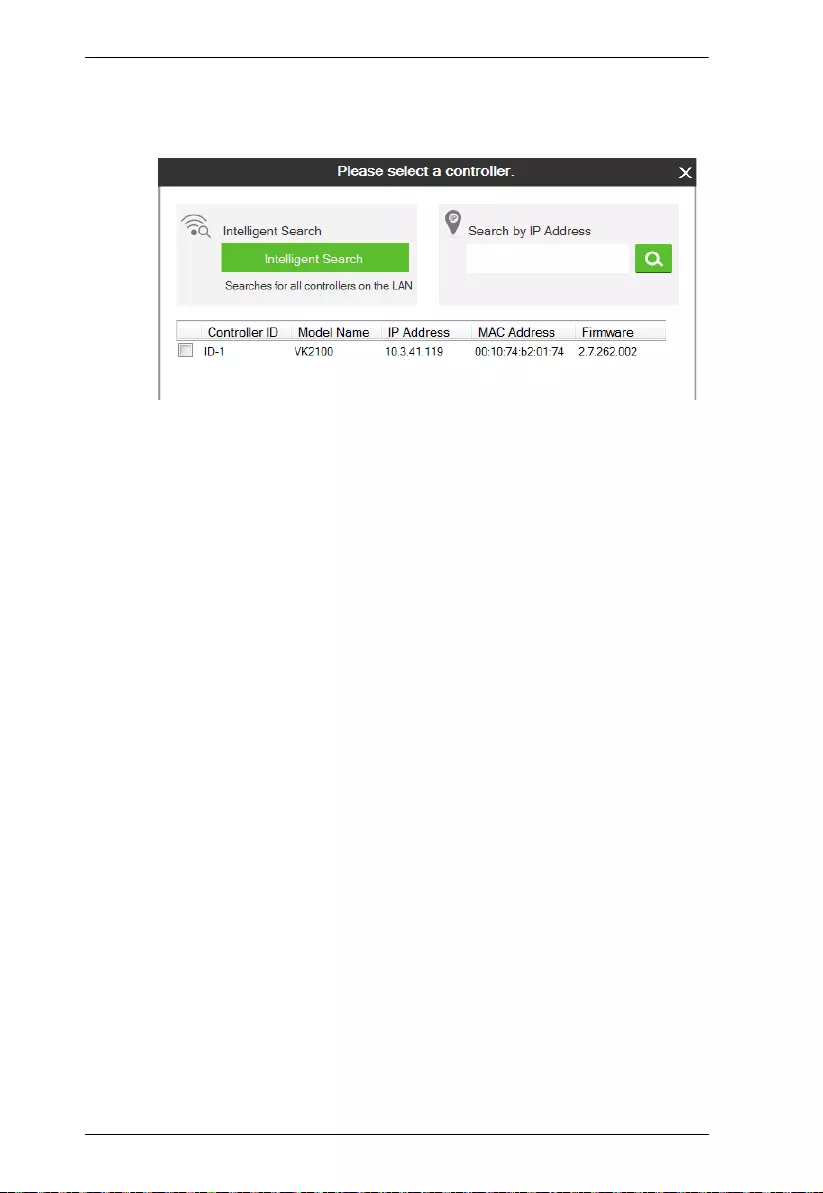
ATEN Control System User Manual
236
Click to select a controller from the list. Use the Refresh button to
refresh the list. To browse for controllers in the LAN, click the
Intelligent Search button or type the IP address of the controller.
Click Learn a second time to start learning mode. When the IR
Learn LED flashes green, point the IR remote at the Control
Box’s front panel IR Receiver and push a button on the remote.
Press the button on the remote just as you would when using it
with the hardware device. If the device responds to a long hold or
quick tap of the remote’s button then you must press the button in
the same manor (long hold or quick tap) when it using for
Learning mode. The Control Box will beep and the Learn LED
will light solid (then turn off) when IR learning is successful. The
LED also turns off if Learning mode times out.
Test – Use to test if commands are sent successfully to the Control Box
and hardware device.
Click Test, a pop-up window appears to select a controller and the
IR port. Check a box to choose a controller and use the drop-down
menu to select the IR port and then click Select.
Click Test a second time to test if the IR data transmits
successfully to the Control Box. Check the hardware device to
confirm that it responded appropriately.
The Status column reports the Learn and Test results.
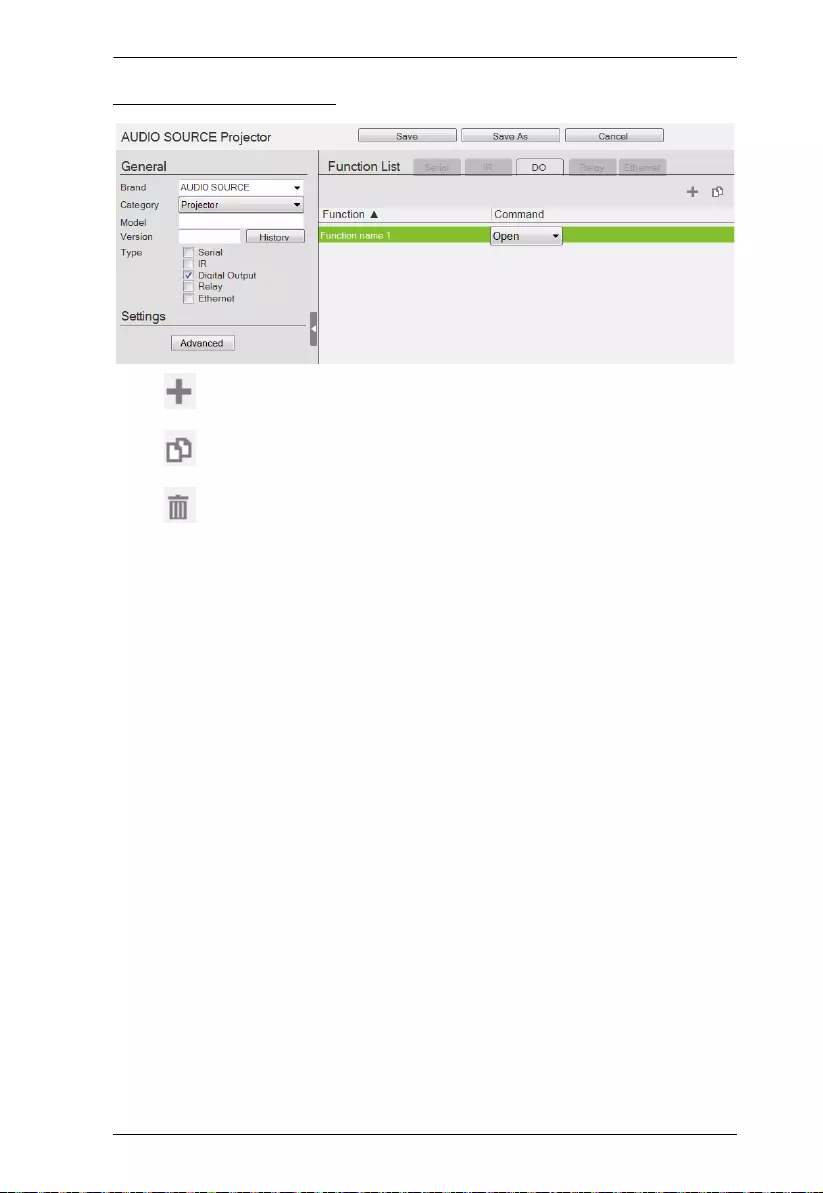
Chapter 5. ATEN Database Generator
237
Digital Output Device
Click to add an Action.
Click to create a duplicate of the Action
Click to delete the selected Action.
Advanced – Click to use the Delay Interval drop-down menu to set a
timed delay for each command before it is sent to the device.
Function List – Use this section to configure the Digital Output device
functions by adding actions to the list.
Function – Lists the actions created for a device. Double-click to edit
the Function name.
Command – Shows the command selected for the action. Click the
drop-down menu to select an action (Open, Close, Toggle, Pulse).
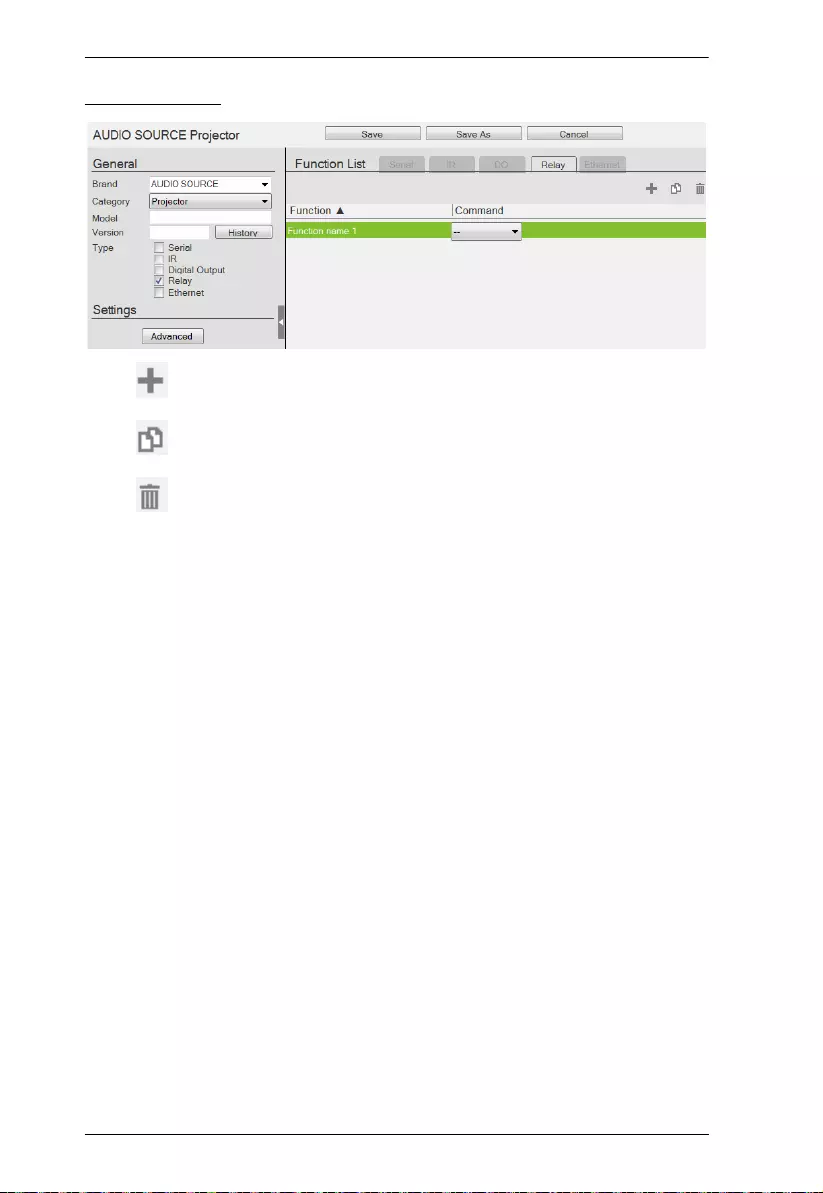
ATEN Control System User Manual
238
Relay Device
Click to add an Action.
Click to create a duplicate of the Action
Click to delete the selected Action.
Advanced – Click to use the Delay Interval drop-down menu to set a
timed delay for each command before it is sent to the device.
Function List – Use this section to configure the Relay device functions
by adding actions to the list.
Function – Lists the actions created for a device. Double-click to edit
the Function name.
Command – Shows the command selected for the action. Click the
drop-down menu to select an action (Open, Close, Toggle, Pulse).
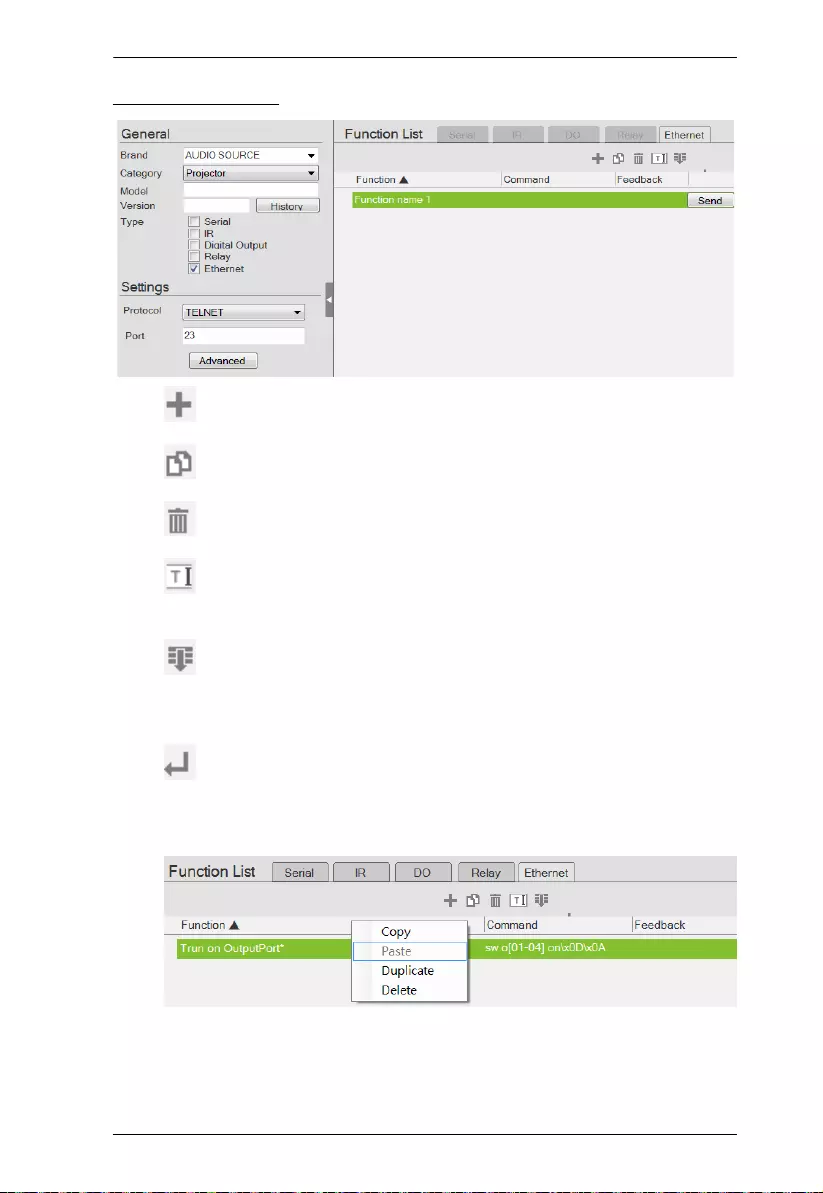
Chapter 5. ATEN Database Generator
239
Ethernet Device
Click to add an Action.
Click to create a duplicate of the Action.
Click to delete the selected action.
Click to enter a string within () which allows the text to be edited
from the VK6000 in the Button Action - Commands list (see page 155).
Click to add a drop menu into a Command string, then enter the
number sequence in the brackets []. The Function name must include
an asterisk (*) for each drop menu in the Command string.
Click to add an Enter into the Command string.
Right-click one or more Ethernet commands (except HTTP/HTTPS) to
copy and paste them as serial commands:
For special command string tools, see Text Command Tools, page 234.
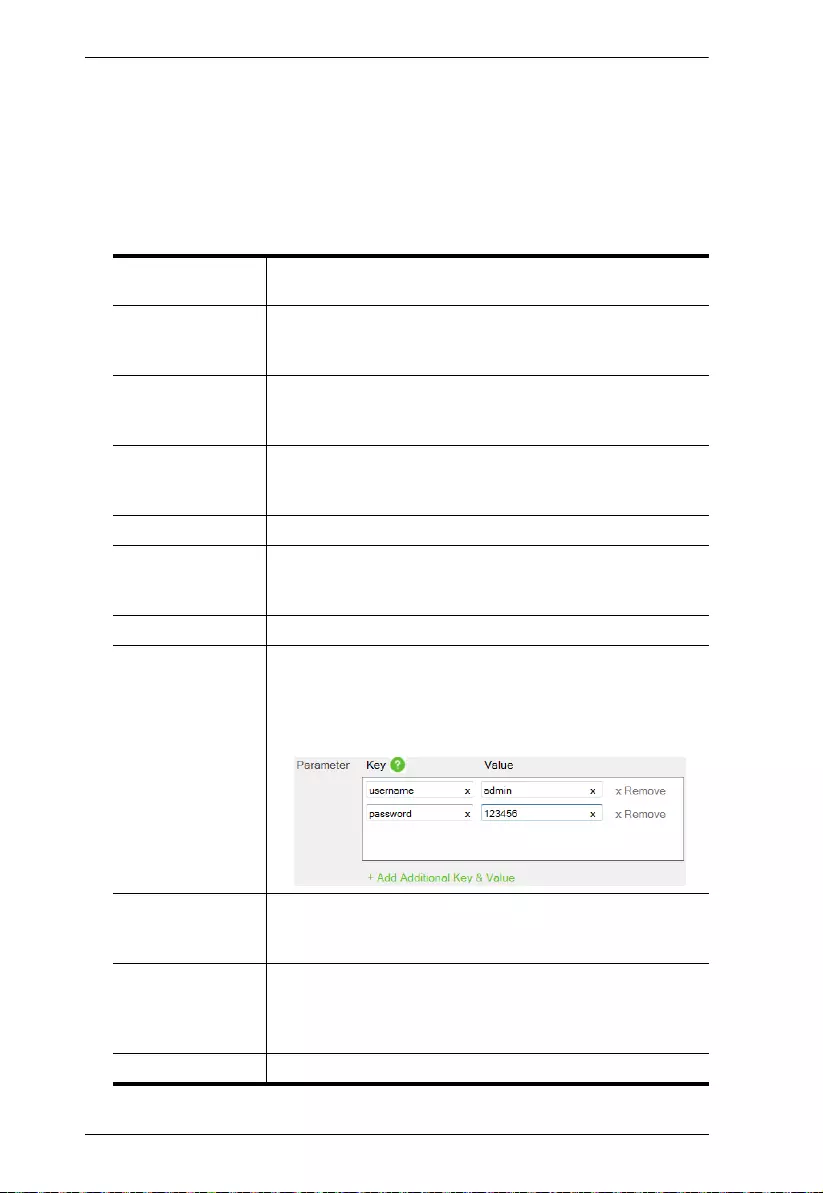
ATEN Control System User Manual
240
Settings
Protocol – Click the drop-down list to select a protocol for the device
Port – Type the port number for the device.
Advanced – Click to access the following settings. The supported
settings may vary depending on the device protocol and authentication
type.
Delay Interval Sets a time delay for each command before they are
sent to the device.
Delay Time after
Login
Sets a time interval that the controller waits to request
for login credentials of a device after establishing
connection with the device.
Receive Duration Sets the allowed duration of time for the Ethernet
device to receive a complete message from the
controller.
Send command
after successful
connection
Enter a First and Second Command to send to the
device after a successful connection has been
established.
Auth Type Sets the authentication type for the device.
Timeout Specifies the maximum time that the device allows for
receiving each feedback message from the device
before timing out.
Login Sets the command for logging in to the device.
Parameter Sets the parameters (keys) of the device that are
required for the controller to connect to the device.
For example, the device username and password are
required when connecting to the device, and the valid
values are admin and 123456 respectively.
Keep Connection
Alive
Specify an interval during which the controller sends
the specified command to make sure the it is
connected to the Ethernet device.
Automatically
reconnect if no
return message is
received
Check this box if you want to continue reconnection
attempts when no return message is received from the
device.
Use Default Click this button to restore to default settings.
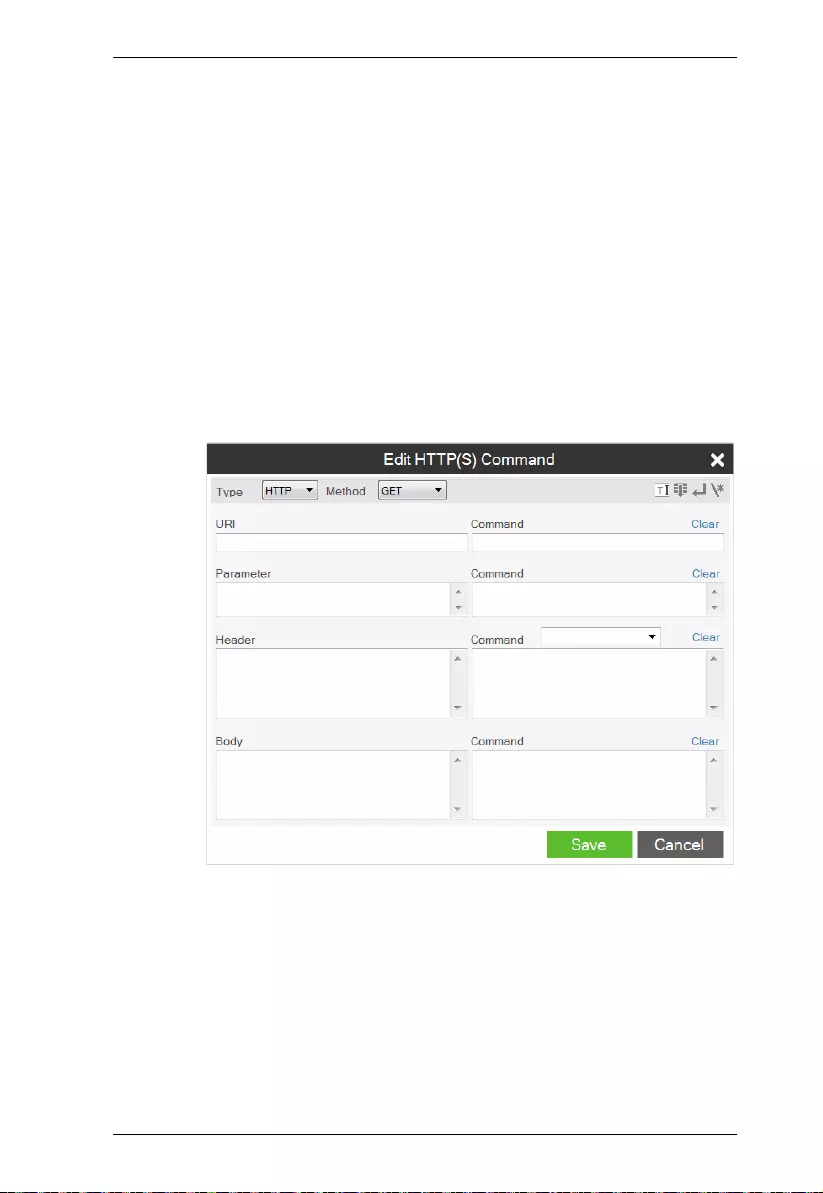
Chapter 5. ATEN Database Generator
241
Function List – Use this section to configure the device functions by
adding actions to the list.
String Format – Use the buttons to select HEX or ASCII. (TCP only)
Function – Lists the actions created for a device. A Function name
must include an asterisk (*) for each drop menu you add to the
Command string. Double-click to edit the function name. The drop-
down menu will appear where the (*) is entered in the Function name
Command – Shows the command string created for the action.
To edit a command for a Telnet, PJLINK, ONVIF, or TCP
compliant device, double-click the Command field (green area in
the interface).
To edit a command for an HTTP or HTTPS compliant device,
click the Edit button. The Edit HTTP Command window appears.
Feedback – Stores return messages generated by testing the command
strings. Double-click to manually add or remove stored messages. This
function is not applicable for ONVIF devices.
Send – Click this button to test the command for the function. The
return messages can be saved to Feedback.
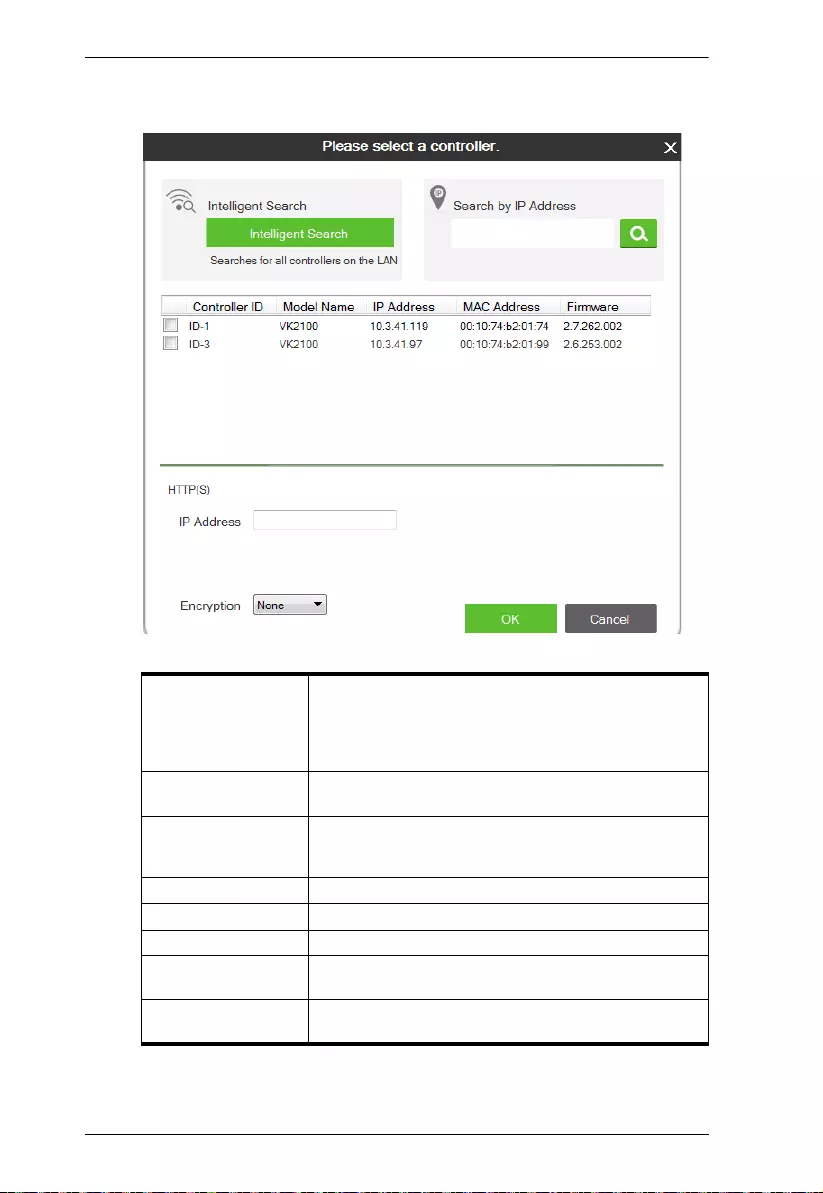
ATEN Control System User Manual
242
This screen appears when Send is clicked. Select a controller for the
device to connect and configure the fields such as device IP address.
Note: The username and password are not required for UDP and TCP
devices, and the username is not required for PJLINK devices.
Intelligent Search Click to locate controller without specifying an IP
address.This option only searches for controllers on the
same local area network. For controllers across a
network device, such as a router or switch, you must
specify the IP address.
Search by IP address Enter the IP address and click Search to locate a
controller.
Controller ID Use the check box to select the Controller, fill in the IP
Address, Username and/or Password and then click
OK. Next use the instructions below this table.
Refresh Click this button to refresh the Controller ID list.
IP Address Type the IP address of the device.
Username Type the device’s username.
Password Type the device’s password to grant access right to the
controller.
Receive message for Specifies the maximum allowed time that the device
receives messages from the selected controller.

Chapter 5. ATEN Database Generator
243
Testing Commands
After selecting a controller for the device and configure the required settings
(if any) in the select controller window, click OK to proceed to test the typed
command. The Test Command window appears.
Select which device to send command to by choosing Send to all or Send to
specific and then click Send Test Command. This window appears.

ATEN Control System User Manual
244
The test results will appear in the yellow area of the window and the feedback
messages listed in the Feedback column.
Add – Click to save a feedback message in the Saved Feedback message
window.
Pause / Continue – Click to pause sending/receiving the command/return
message.
Save & Exit – Save the feedback messages to the list and close the
window.
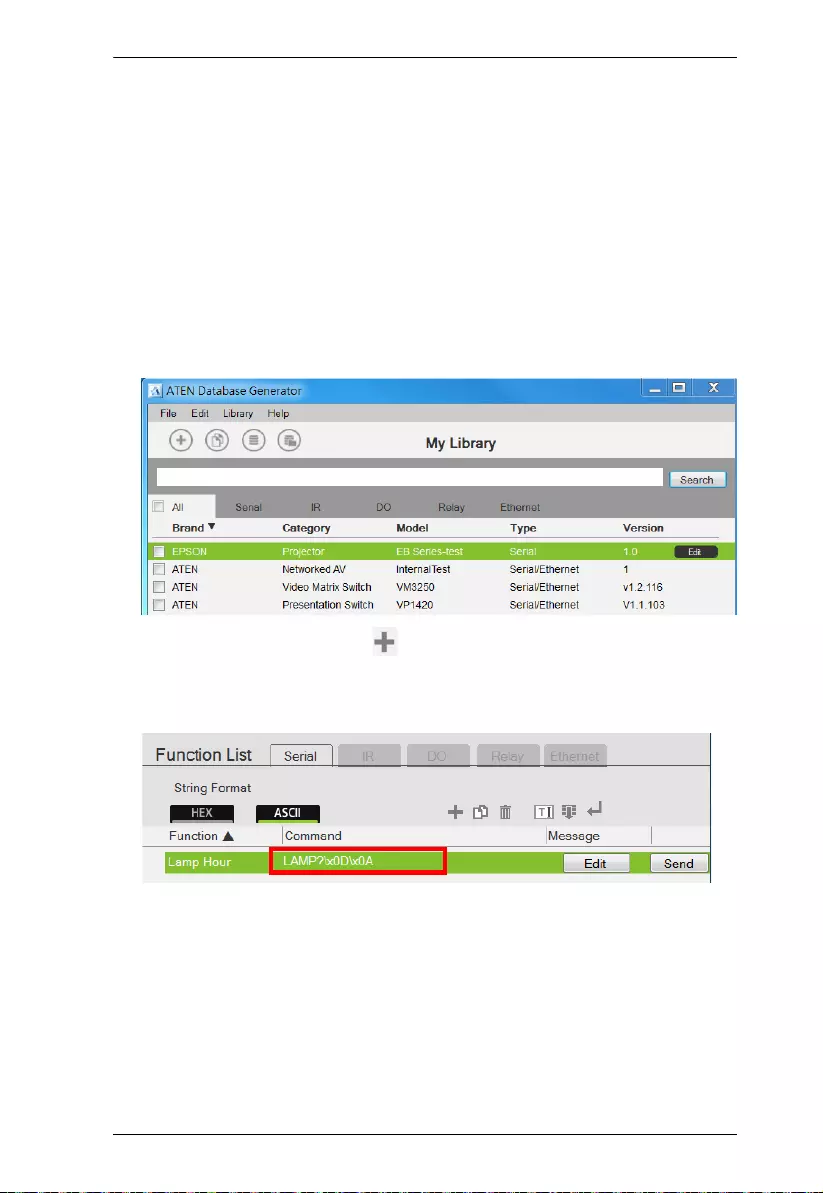
Chapter 5. ATEN Database Generator
245
Configuring Queries
You can set up queries to actively monitor parameters of a serial or Ethernet
device and store the obtained value into a variable for reuse in a control system
project.
Take the example of querying the cumulative number of hours that a projector
lamp has been used to be able to estimate the remaining lifespan and plan for
replacement in advance.
1. In Database Generator, click Edit to enter the settings page for the
projector.
2. Add a command by clicking and double-click the command column to
type the command of requesting for the cumulative lamp usage (hour).
Consult the user manual for the device to find out the operation command.
3. Set up a variable to store the queried value.
a) In the Message column, click Edit. The Edit Messages window
appears.
b) Click the Script tab and click +Add Script and name the script.
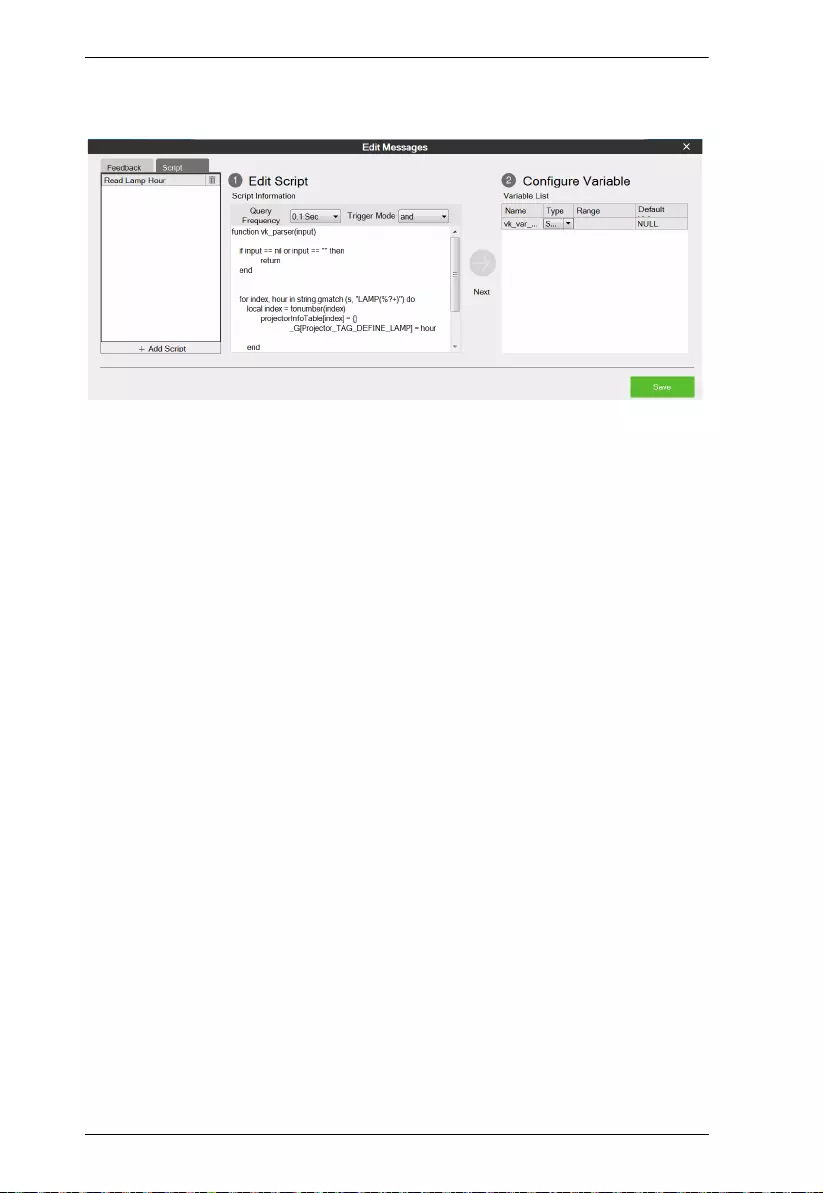
ATEN Control System User Manual
246
c) Write up a script to create a variable that stores the requested value, in
this case, the cumulative lamp hour.
d) Click Save.
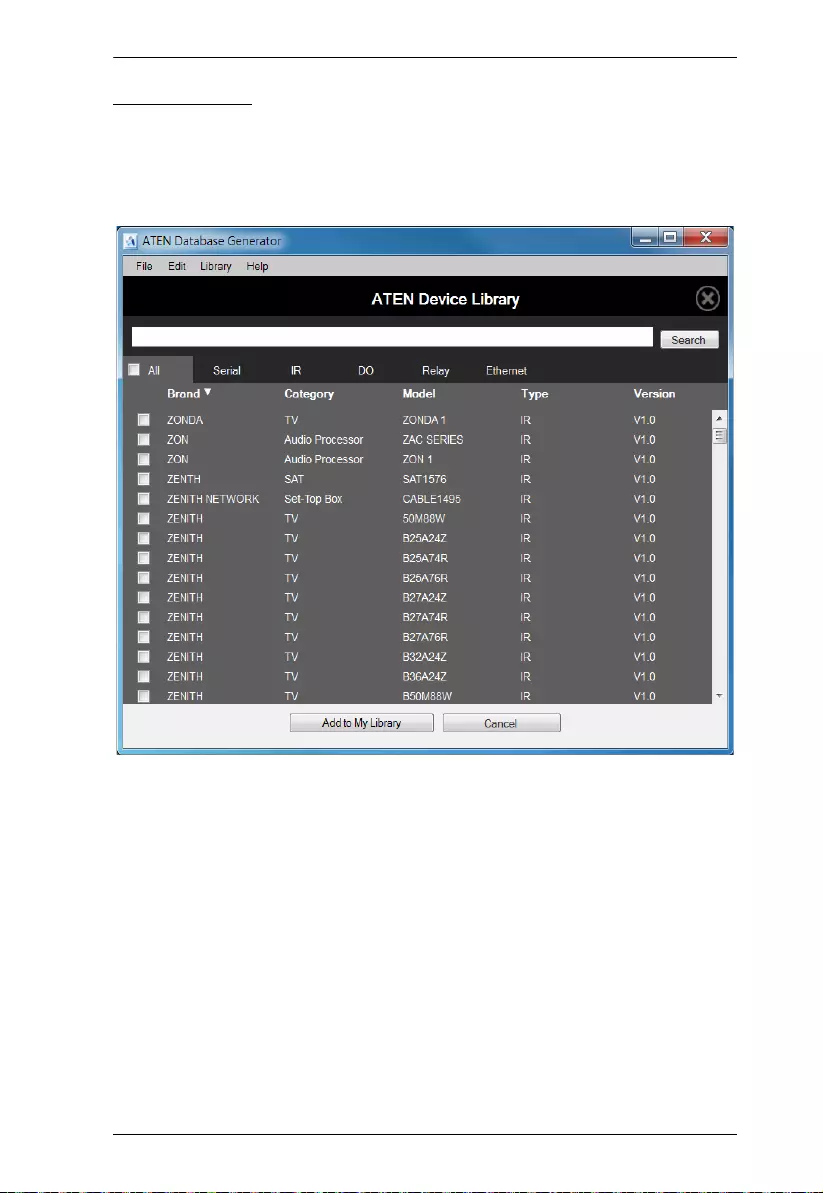
Chapter 5. ATEN Database Generator
247
ATEN Library
The ATEN Library can be accessed fromthe project bar and provides the
complete list of hardware devices available in the database. The You can add
any device in the ATEN Library to My Library. Once a device is added to My
Library, the device settings can be edited as needed.
Use the check boxes to select devices to add to My Library. Check All to
select all devices in the list.
Key in word strings then click Search to find a device.
Click All, Serial, DO, IR, Relay or Ethernet to filter the device list by
type.
Click Brand, Category, Model, Type or Version to sort the devices.
Click Add to My Library to add the selected devices to My Library.
Click Cancel to return to My Library.

ATEN Control System User Manual
248
This Page Intentionally Left Blank

Chapter 6. Remote PC Control
249
Chapter 6
Remote PC Control
Overview
While being capable of controlling serial, IR, I/O, and relay equipment, ATEN
controllers also support remote control of computers This control is achieved
with a program, ControlAssist, that grants control right to a specified ATEN
controller via the network. When a computer is installed with ControlAssist,
you can remotely perform the following:
Control PowerPoint slides
Control media files through Windows Media Player
Initiate actions on third-party programs using hotkeys that have been
defined for the programs
Perform system control such as shutting down the computer, execute
command prompt, set system volume, and run a program
Note: For a full list of supported actions, see Supported PC Control Actions,
page 260.
Specifications
Supported computers
Only Windows-based computers are supported for remote control.
Each computer is deemed as an Ethernet device to the ATEN
controller, and therefore follows the specification that each controller
can support up to 25 Ethernet devices.
To use ATEN Viewers on a Windows platform, make sure to install
Internet Explorer version 11 or later.
PowerPoint File Control
ControlAssist only supports PowerPoint files that contain 200 slides or
less, and are created using Microsoft Office 2007/2010/2013, or WPS
Office.
ControlAssist only supports the following PowerPoint file formats:
pps, ppt, and pptx.
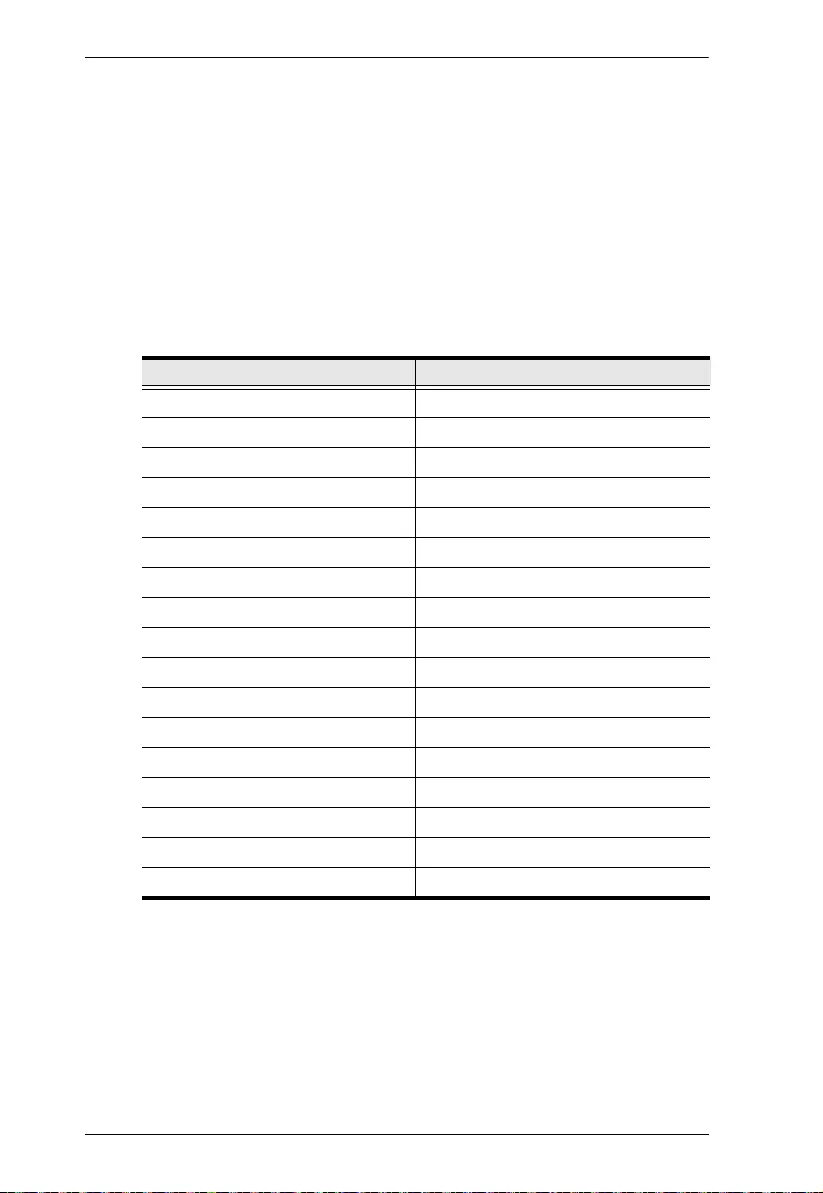
ATEN Control System User Manual
250
Media File Control
ControlAssist only supports media files created using Windows Media
Player.
When a media file is remotely enabled and controlled using an ATEN
Viewer, the file opens in Windows Media Player and this setting can
not be changed.
If you encounter any issues playing a media file, try install a third-
party video codec.
ControlAssist only supports control of the following media file
formats:
Category File Formats
Windows Media format asf, wma, wmv, wm
Windows Media Metafiles asx, was, wvx, wmx, wpl
Microsoft Digital Video Recording dvr-ms
Windows Media Download Package wmd
Audio Visual Interleave avi
Moving Pictures Experts Group mpg, mpeg, m1v, mp2, mpa, mpe, m3u
Musical Instrument Digital Interface mid, midi, rmi
Audio Interchange File Format aif, aifc, aiff
Sun Microsystems and NeXT au, snd
Audio for Windows wav
CD Audio Track cda
Indeo Video Technology ivf
Windows Media Player Skins wmz, wms
QuickTime movie file mov
MP4 audio file m4a
MP4 video file mp4, m4v, mp4v, 3g2, 3pg2, 3gp, 3gpp
Windows audio file aac, adt, adts

Chapter 6. Remote PC Control
251
Setting Up Remote PC Control
Follow the steps below to install the required programs on the target
computers, configure the associated controller, and customize the Viewer for
remote PC control.
1. Make sure you have installed Microsoft Visual C++ Redistributable for
Visual Studio 2015 to the target computer. To download the package, go to
https://www.microsoft.com/en-us/download/details.aspx?id=48145
2. Install ControlAssist on the computer you wish to control. For detailed
steps, see Installing ControlAssist on Target Computers, page 251.
3. Add the computer into the control system. For detailed steps, see Adding
Target Computers to the Control System, page 254.
4. Create a control interface to be used on a licensed mobile device.
For detailed steps, see Configuring a Control Interface, page 256.
For details on licenses, see Licenses for Mobile Control, page 78.
Installing ControlAssist on Target Computers
Follow the steps below to install ControlAssist on the computers you wish to
control.
1. Download ControlAssist.
a) Visit the ATEN download page:
https://www.aten.com/global/en/products/professional-audiovideo/
control-system/controlassist/
b) Search for “VK6000”. A list of downloads for VK6000 appears.
c) Click ControlAssist_Vx.x.xxx.zip to download.
2. From the downloaded file, double-click ControlAssist_Setup to install
the program. An installation wizard appears.
3. Follow the on-screen instruction to complete the installation.
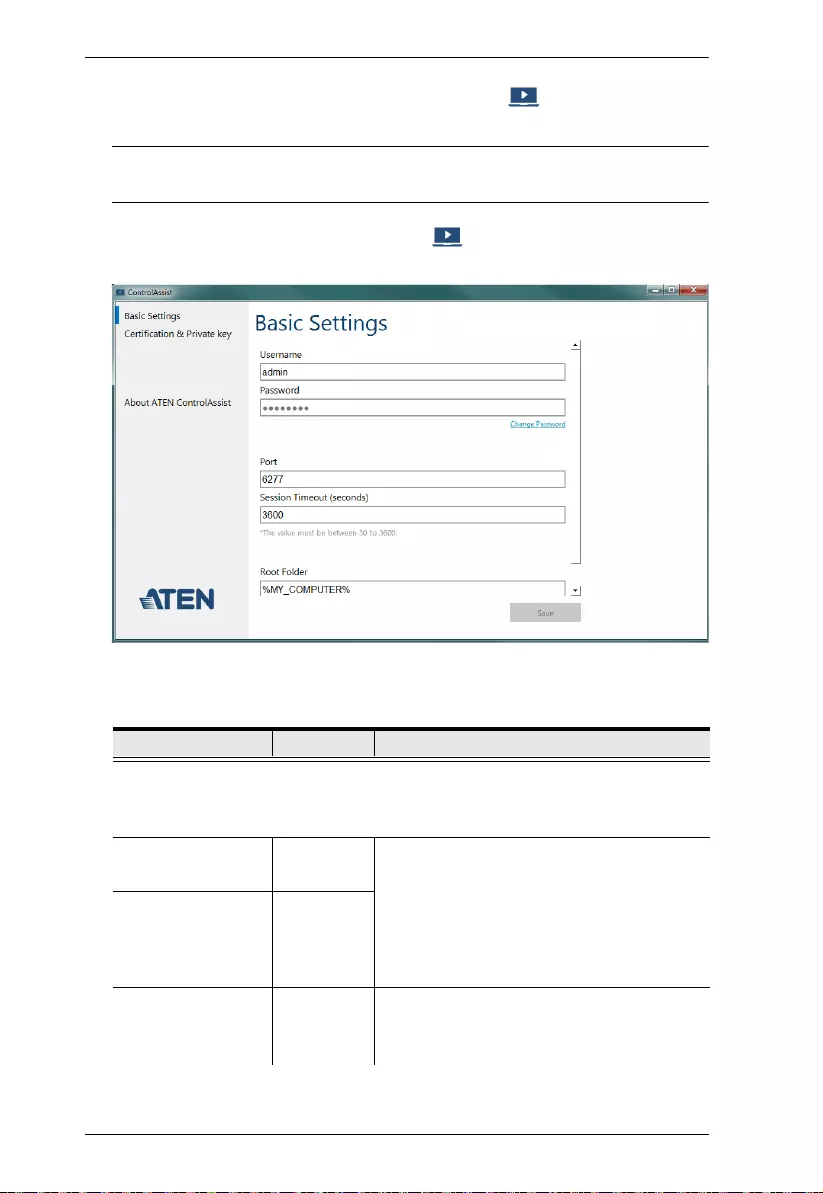
ATEN Control System User Manual
252
4. When the installation is complete, ControlAssist runs in the system
tray.
Note: Keep the ControlAssist program enabled in the system tray to allow
the controller to establish connection with the computer.
5. To configure ControlAssist, right-click in the system tray and select
Settings. This window appears.
Click the Basic Settings, Certification & Private Key, or About ATEN
ControlAssist to access the following settings/information.
Control Default Description
Basic Settings
The settings with which an ATEN controller needs to establish connection with the
computer and to gain control right.
Username admin The credentials required for an ATEN
controller to establish connection with the
computer.
Note: To change the username and
password, make sure to log in the computer
using an Administrator account.
Password password
Port 6277 The port through which ATEN Configurator
establishes connection with the
ControlAssist-installed computer.
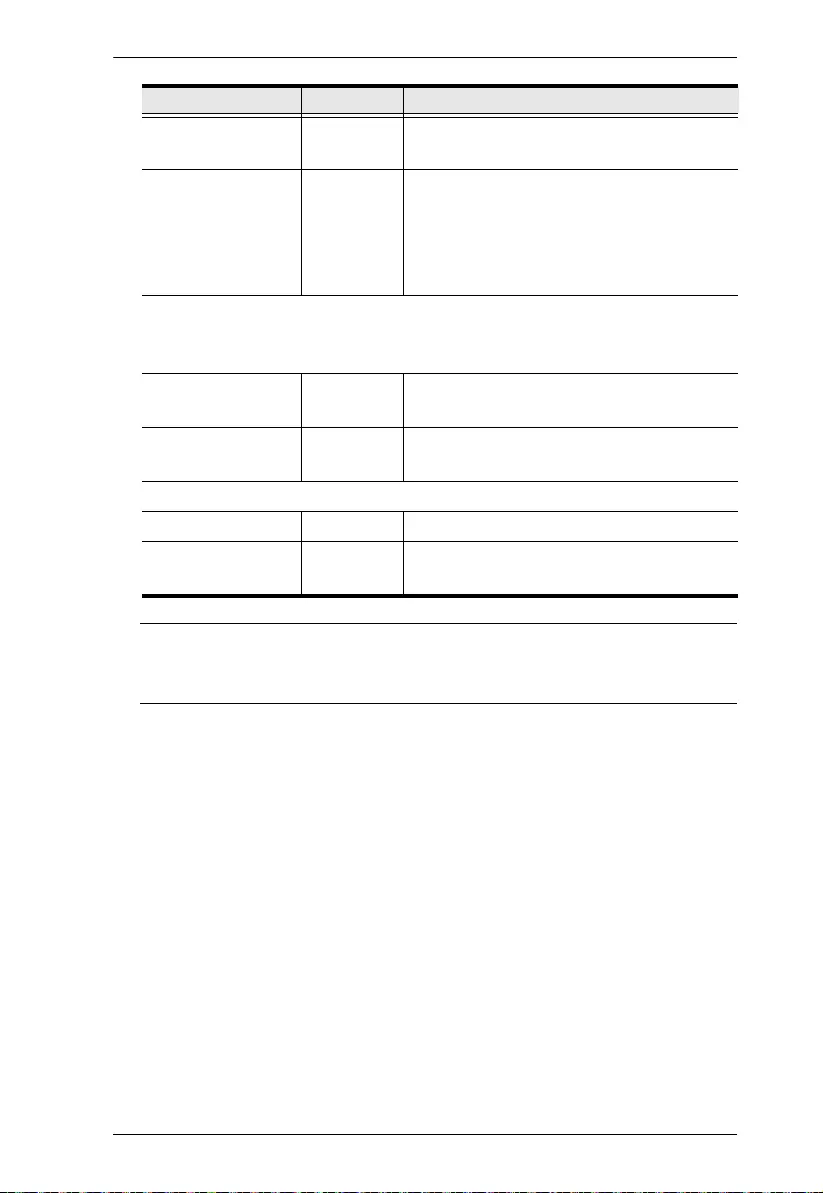
Chapter 6. Remote PC Control
253
Note: If the text in the ControlAssist window appears oversized, change
the desktop font size to its default, and then log in the computer
again to resolve the issue.
Session timeout 3600 The maximal time allowed for the controller to
establish connection with ControlAssist.
Root Folder N/A This field specifies the computer path under
which files are display in the PowerPoint
Control and Media templates’ file list. To
display files at the computer’s partition level,
type %MY_COMPUTER% in this field.
Upload SSL Certificate and Private Key
Upload an SSL certificate and its private key to secure sessions between the
computer and the connected controller.
Certificate Default
certificate
Click Choose a file from... to browse for an
SSL certificate.
Private key Default
private key
Click Choose a file from... to browse for a
private key SSL certificate.
About ATEN ControlAssist
Version N/A Indicates the release version.
Visit Official Website N/A Click to open the official website for more
information.
Control Default Description
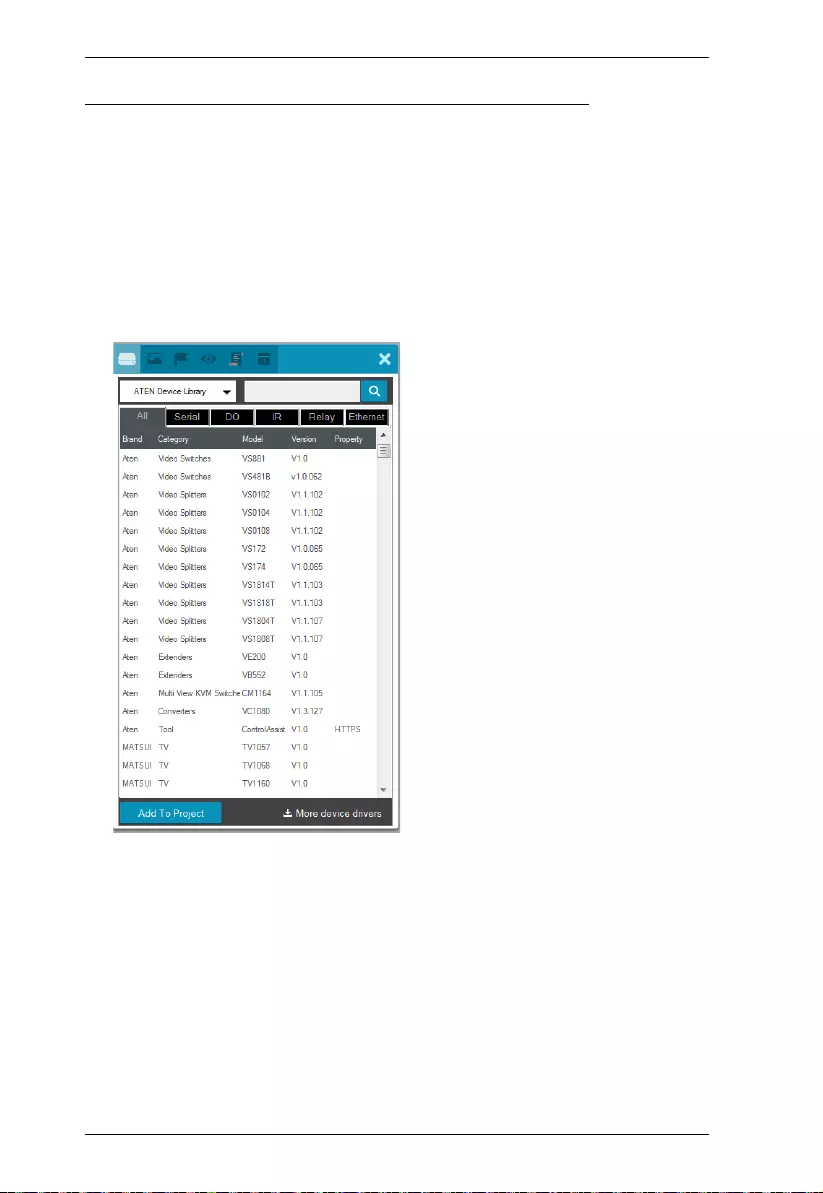
ATEN Control System User Manual
254
Adding Target Computers to the Control System
After you have installed ControlAssist on the computers you wish to control,
follow the steps below to establish connection between the controller and the
target computers.
1. From ATEN Configurator, locate and open your project file.
2. Click the Device tab, and from the Ethernet device type category, click on
a blank device or click Add More Devices to add one.
3. Click Library. This window appears.
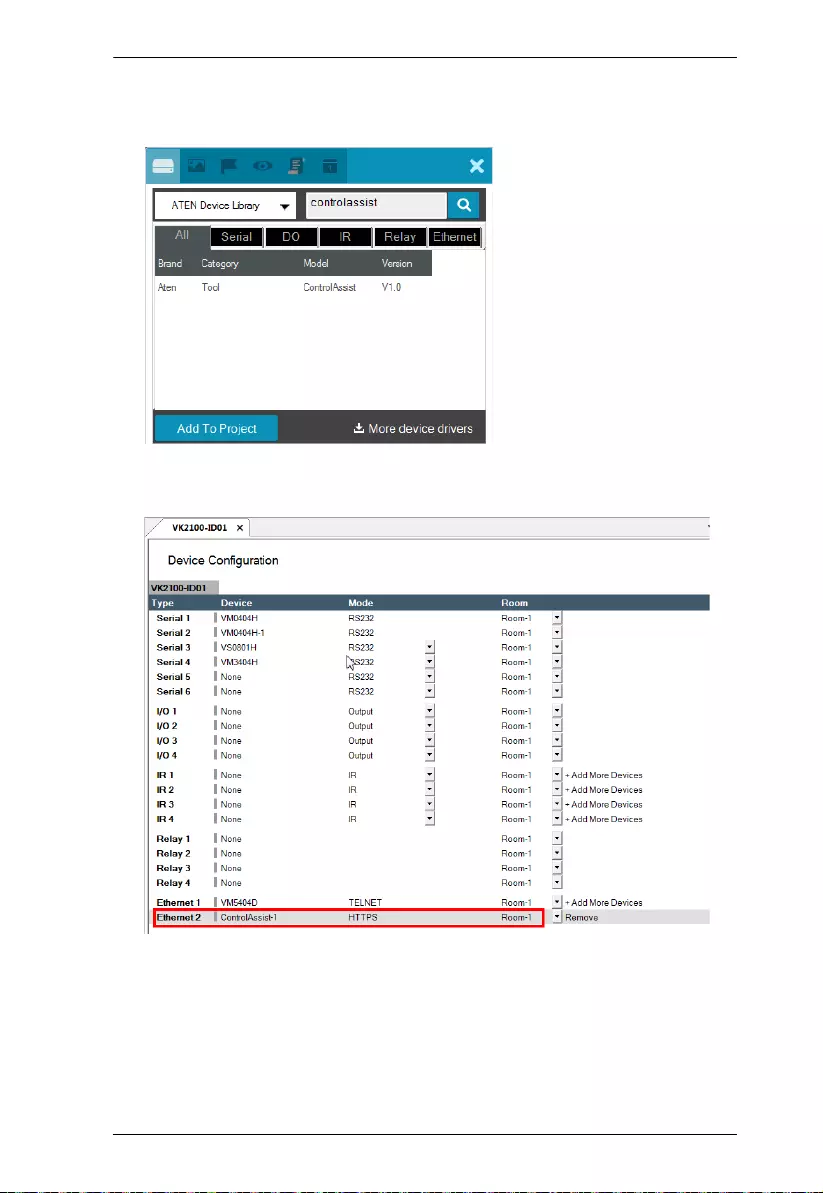
Chapter 6. Remote PC Control
255
4. Use the search box to search for “controlassist” to load the ControlAssist
database. This screen appears.
5. Click Add to Project. This computer, identified as an Ethernet device
installed with ControlAssist, appears in the Device Configuration List.
6. Select the newly added device and configure the Properties settings on the
right of the interface.
Hint: If you have more than one computers installed with ControlAssist,
change the device name to distinguish these PCs.
For details on Properties settings, see Ethernet Device Properties,
page 116.
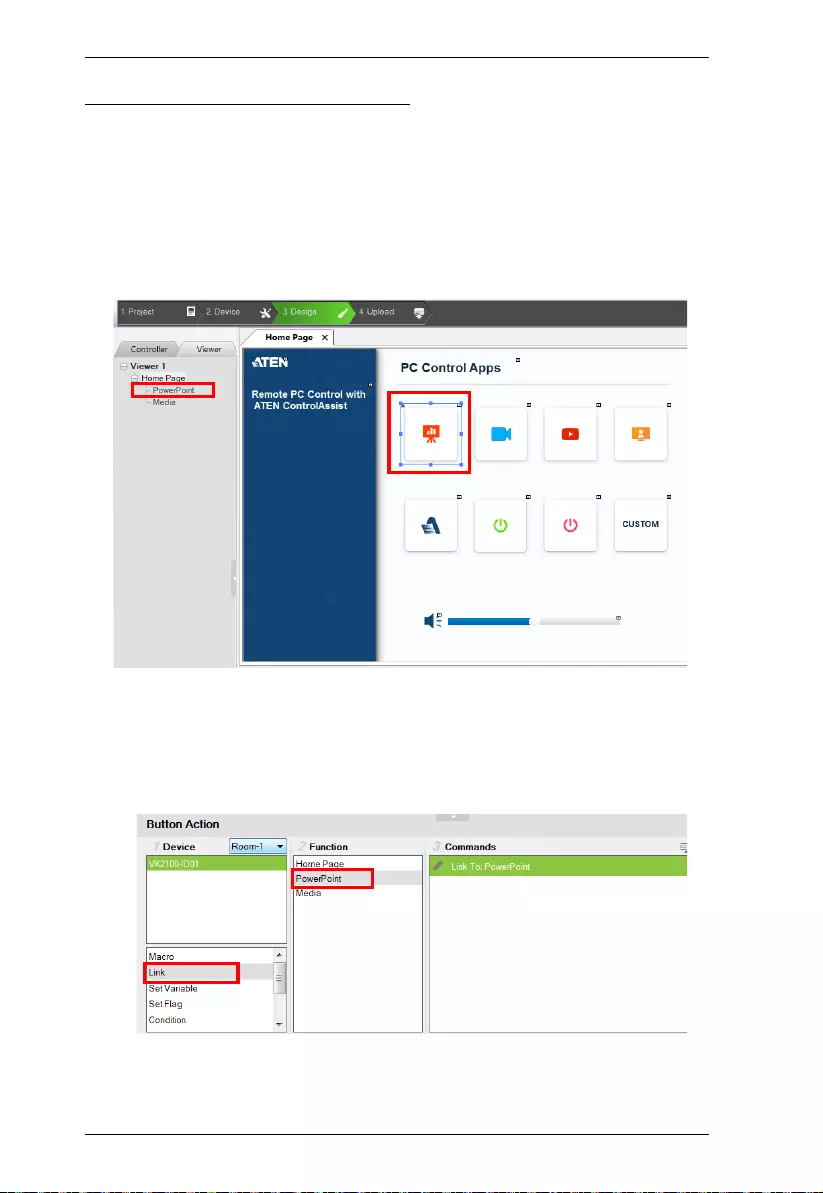
ATEN Control System User Manual
256
Configuring a Control Interface
Example 1:
Follow the steps below to create a control interface that allows you to browse
and play any file from the specified root folder (see page 251) in the target
computer. You can follow the same logic for creating a media control page.
1. In the Design tab, make sure your home page contains a presentation
button and the Viewer contains a PowerPoint page.
2. Configure the button to have it link to the PowerPoint page if pressed in
the Viewer.
a) Click the presentation button.
b) Select Link and then double-click the PowerPoint page.
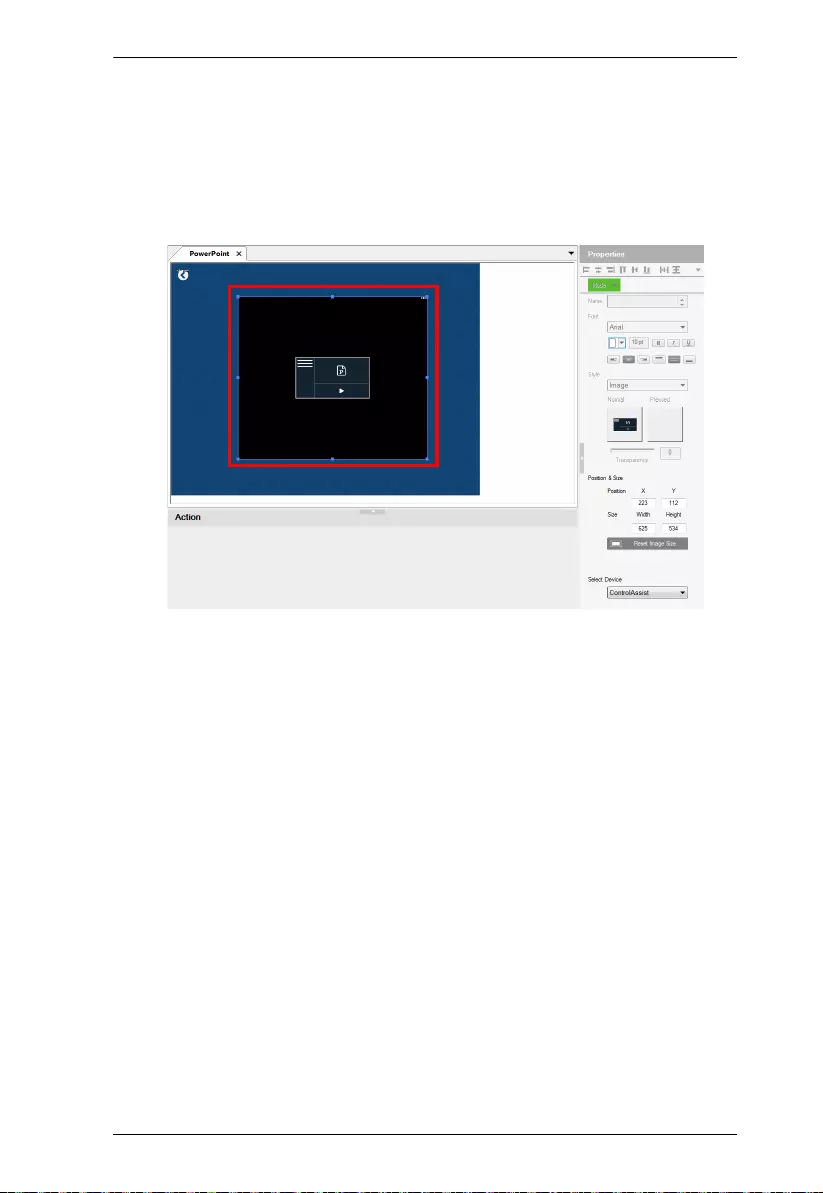
Chapter 6. Remote PC Control
257
3. Configure the PowerPoint page if you did not use a built-in Viewer
template.
a) In the left sidebar, click PowerPoint.
b) In the PowerPoint page, right-click any blank spot and select
PowerPoint Control Template. A pre-made screen is added.
c) In the Properties column, use the Select Device drop-down menu to
select the PC that stores the PowerPoint files you want to play.
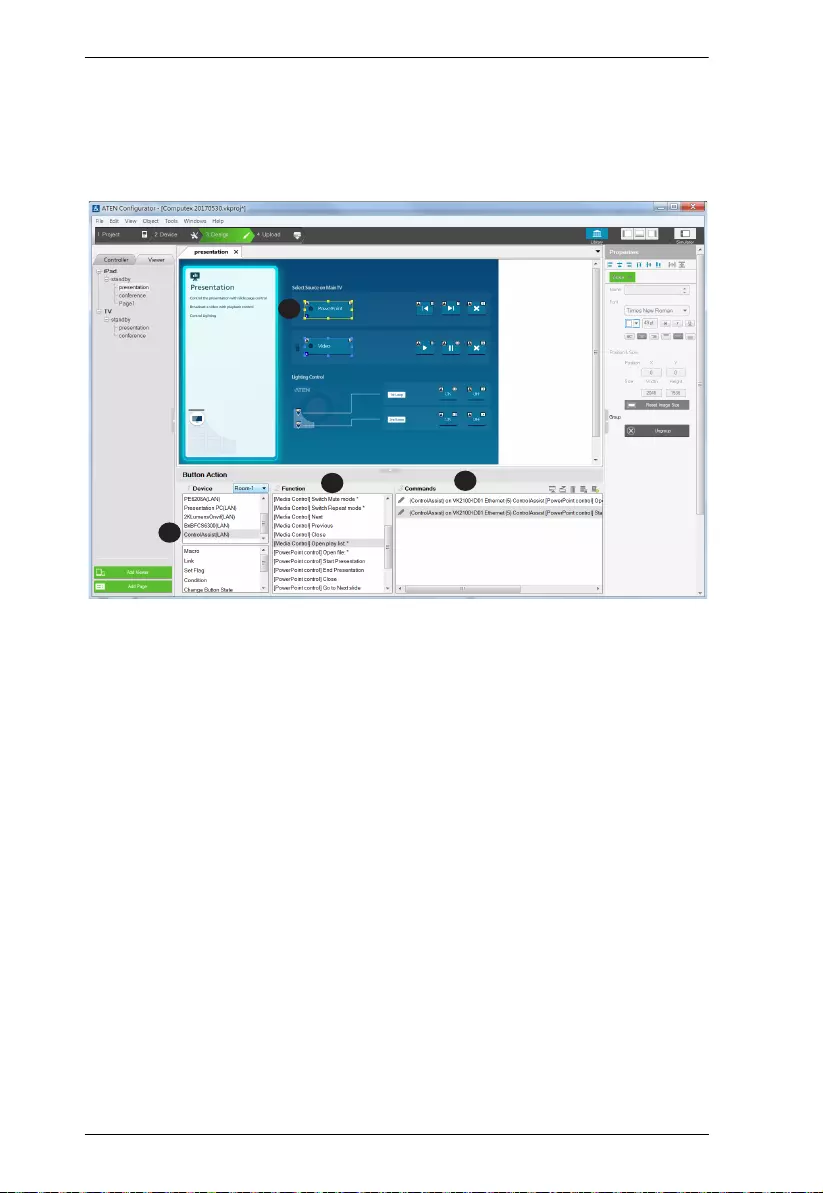
ATEN Control System User Manual
258
Example 2:
Follow the steps below to create a quick access button for opening and playing
a specific PowerPoint file. You can follow the same logic to create a button for
opening and playing a specific media file.
1. Create an outlook for the interface.
a) In ATEN Configurator, click the Design tab.
b) Click Add Page and rename the page to “presentation”.
c) Customize the interface and add control buttons using the Properties
settings in the right-hand column. For details, see Configuring Control
Interfaces, page 120.
2. Define the action of each button. For example, for the PowerPoint button to
open and start a slide show when pressed, do the following:
a) In the preview pane, click the PowerPoint button.
b) Select ControlAssist (LAN).
c) Double-click [PowerPoint] Open file and then [PowerPoint] Start
presentation.
d) Configure the commands and arrange them in the order of execution.
Tip: The asterisk (*) at the end of a Function indicates that it requires
configuration in the Commands column.
2b
2a
2c 2d
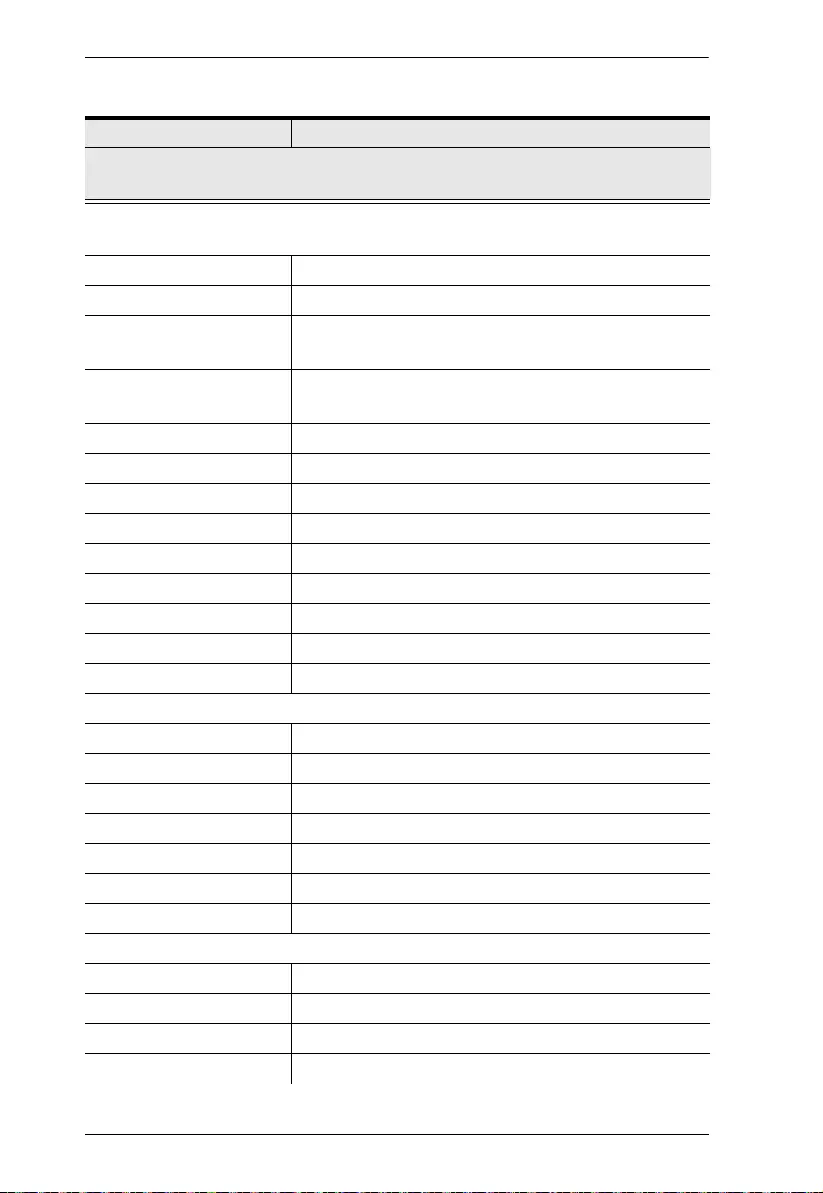
ATEN Control System User Manual
260
Supported PC Control Actions
Command Function
Note: Commands indicated with an asterisk require configuration after being added to
the Commands column in the Configurator.
[Media Control]
Note: The commands in this group apply to Windows Media Player only.
Close Closes the player.
Next Plays next in the playlist.
Open file* Opens and plays the specified file in Windows Media
Player.
Open playlist* Opens and plays the specified playlist in Windows Media
Player.
Pause Pauses the playback.
Play Plays the opened file in Windows Media Player.
Previous Plays previous in the playlist.
Set volume to* Sets the player to a specified volume.
Stop Stops the playback.
Switch to full screen mode* Enables or disables the player to full-screen display.
Switch to mute mode* Enables or disables mute mode.
Switch to repeat mode* Enables or disables repeated play.
Volume* Adjusts the player’s volume up or down.
[PowerPoint Control]
Open file* Opens the specified PowerPoint file.
Start presentation Starts the slide show of the specified PowerPoint file.
End presentation Ends the slide show of the specified PowerPoint file.
Close Closes the opened PowerPoint file.
Go to next slide* Goes to the next slide.
Go to previous slide Goes to the previous slide.
Go to slide Goes to a specified slide number.
[System Control]
Open file* Opens a specified file saved in the target computer.
Open URL* Opens a specified URL.
Run program* Runs an application.
Shut down PC Shuts down the computer.
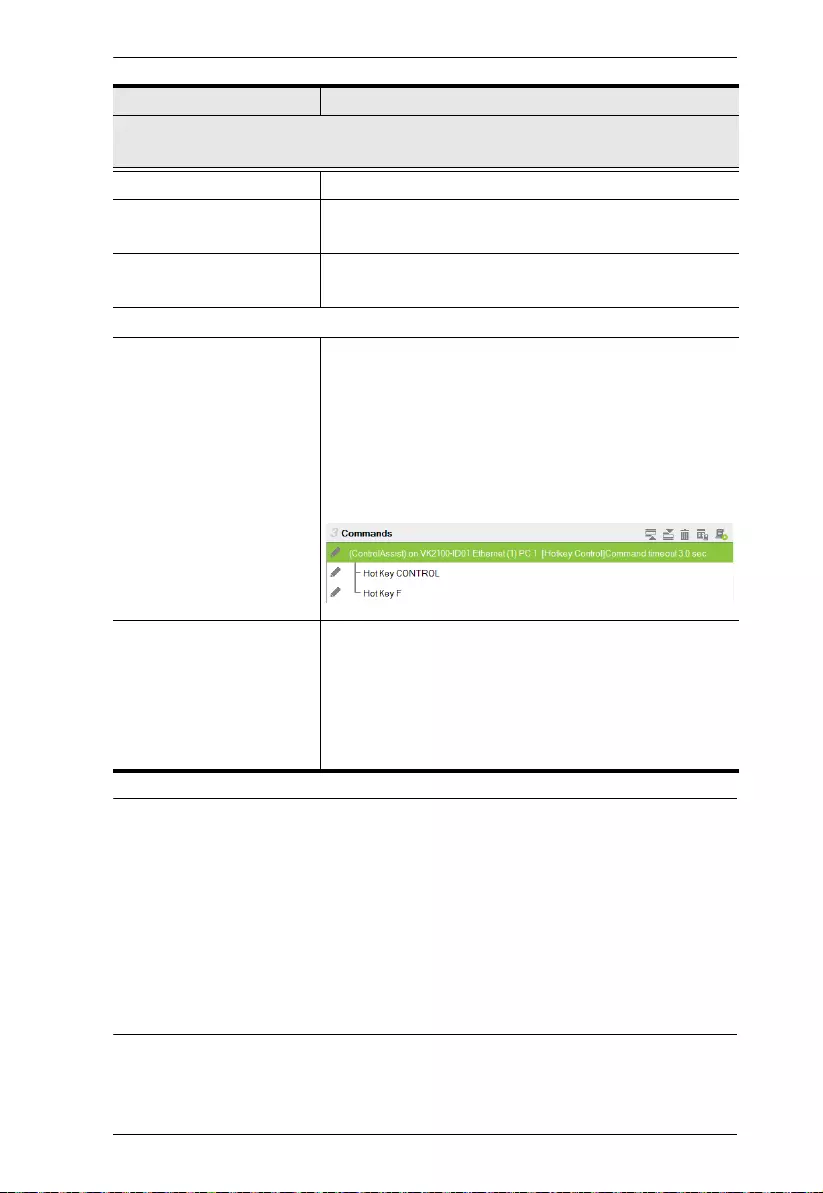
Chapter 6. Remote PC Control
261
Note: Adhere to the following guidelines when specifying file paths:
Include the file name and file extension of the target file.
Use double backward slashes between folder levels.
If the file path contains space, put the file path in double quotations.
The following are examples of valid file paths:
“C:\\ControlAssist\\Presentation.pptx”
“C:\\ControlAssist\\Presentation Demo.pptx”
Set volume* Adjusts the computer’s volume.
Execute Command
Prompt*
Executes the specified command via Command Prompt.
Bring application to top* Keeps the window of the specified program on top of
other windows that are open on the desktop.
[Hotkey Control]
Create action Executes the associated hotkey(s) on the program that
opens topmost on the computer desktop.
For example, if you have “Ctrl + f” defined as the hotkey for
extending a program to full screen in the program itself, to
remotely simulate this action, you should have one Create
action command associated with two Select key
commands, one defined as “Ctrl”, and the other as “f”:
Select key* Use this command to specify the hotkey as defined in the
target program. If the hotkey involves pressing two or
more keys at the same time, you will have two or more
Select key commands associated to one Create action
command. See the example in the Create action
command above.
Command Function
Note: Commands indicated with an asterisk require configuration after being added to
the Commands column in the Configurator.

ATEN Control System User Manual
262
This Page Intentionally Left Blank

Chapter 7. ATEN Control System App
263
Chapter 7
ATEN Control System App
Overview
The ATEN Control System App is a platform that allows you to operate your
control system using pre-made Viewers on mobile devices with an iOS,
Android, or Windows platform.
Preparation
Requirements
Make sure your mobile device uses a supported version of the mobile
operating system listed below before installing the app.
Installing the App
To install the ATEN Control System App on a mobile device, do the following:
1. From the mobile device, tap the App Store or Google Play
icon.
2. In the search box, type “aten control”.
3. Tap ATEN Control System, and then download and install the app.
4. The ATEN Control System icon appears on the mobile device.Tap
the icon to open the app.
Button Sounds
After you install the app, go to the mobile device Settings and find the ATEN
Control so that you can enable/disable the Button Sound setting.
Mobile Operating System Supported Version
iOS 10.0 or later
Android 8.0 or later
Windows 7 or later
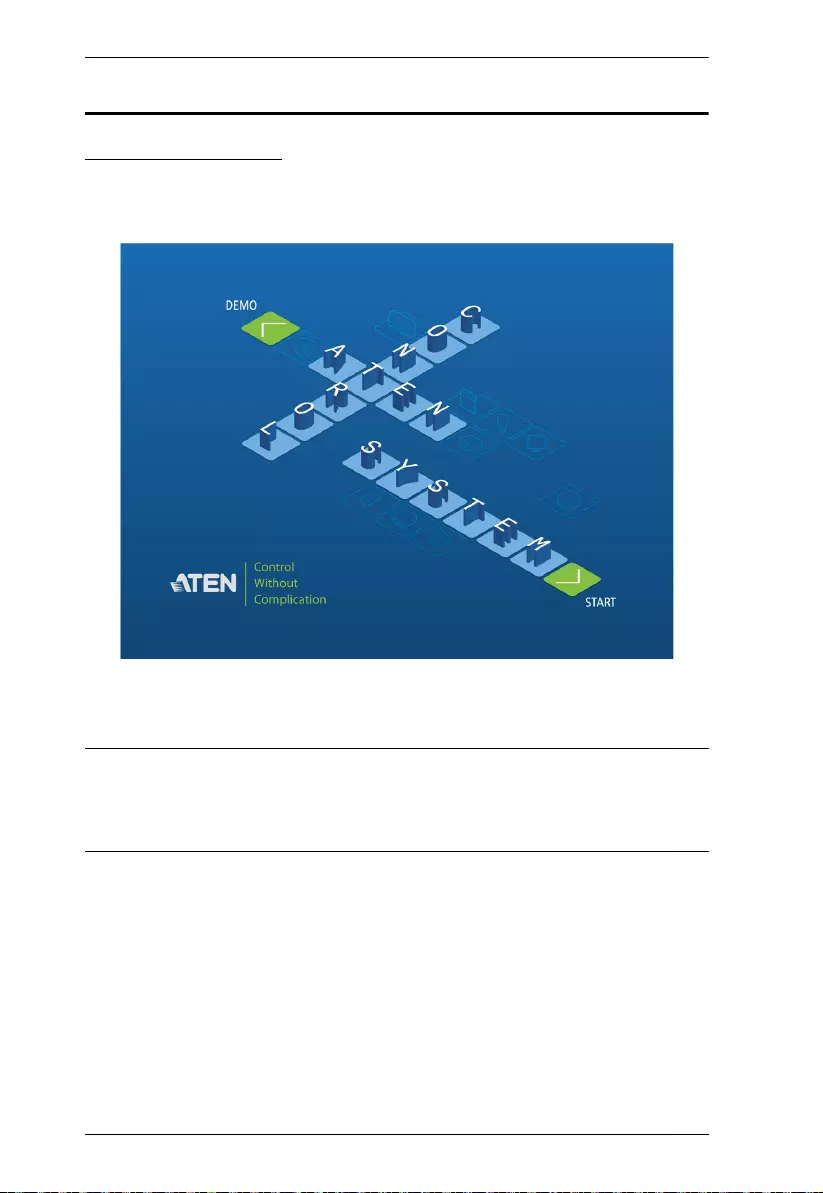
ATEN Control System User Manual
264
The ATEN Control System App
Demo/Start Screen
When you open the ATEN Control System app for the first time, the demo/start
screen appears:
Tap Demo to try the ATEN Control System app. Tap Start to find a controller
and download Viewers (see Welcome, page 269).
Note: The default demo/start screen appears until a Viewer is downloaded to
the Control System app. After a Viewer is downloaded, the default demo/start
screen will reappear only if the app is reinstalled, which will also delete all
Viewers.
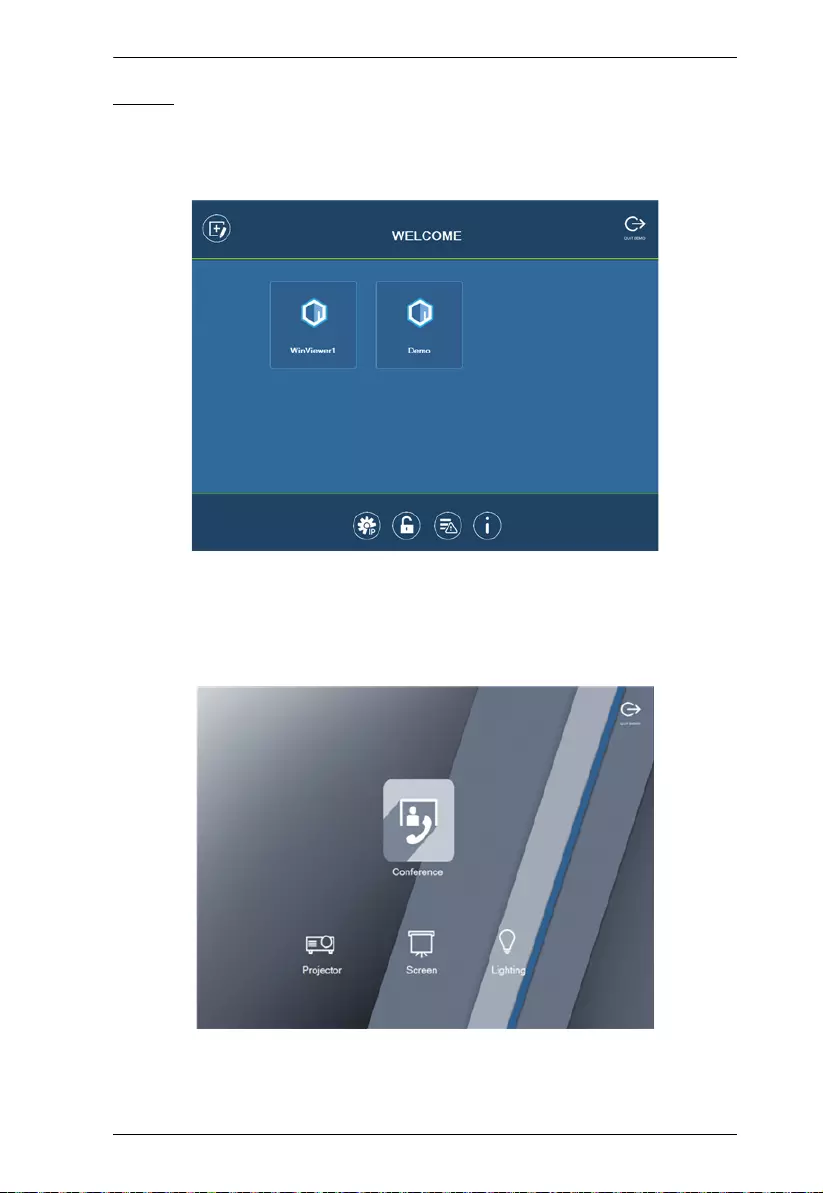
Chapter 7. ATEN Control System App
265
Demo
The Demo page provides two sample Viewers. Tap either Viewer to view the
controls of different hardware devices. To return to the demo/start page, tap
Quit Demo at the top right corner.
Select a Viewer or press any of the buttons on the Welcome page to demo the
app. The first Viewer’s name will depend on the OS of the device.
WinViewer1 / iPad / Android1
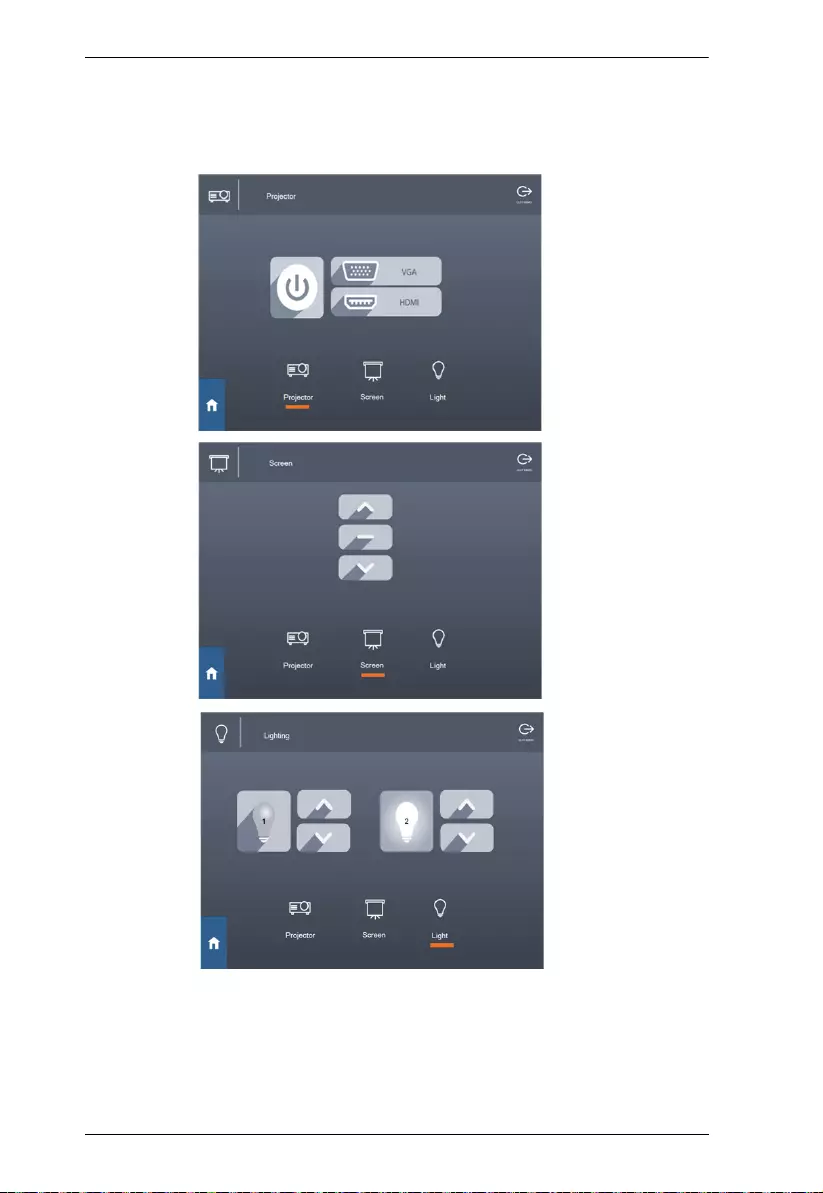
ATEN Control System User Manual
266
This demo shows a Conference call interface with controls for a Projector,
Screen and Lighting. Tap any of the device icons to open each of the
following control pages:
.
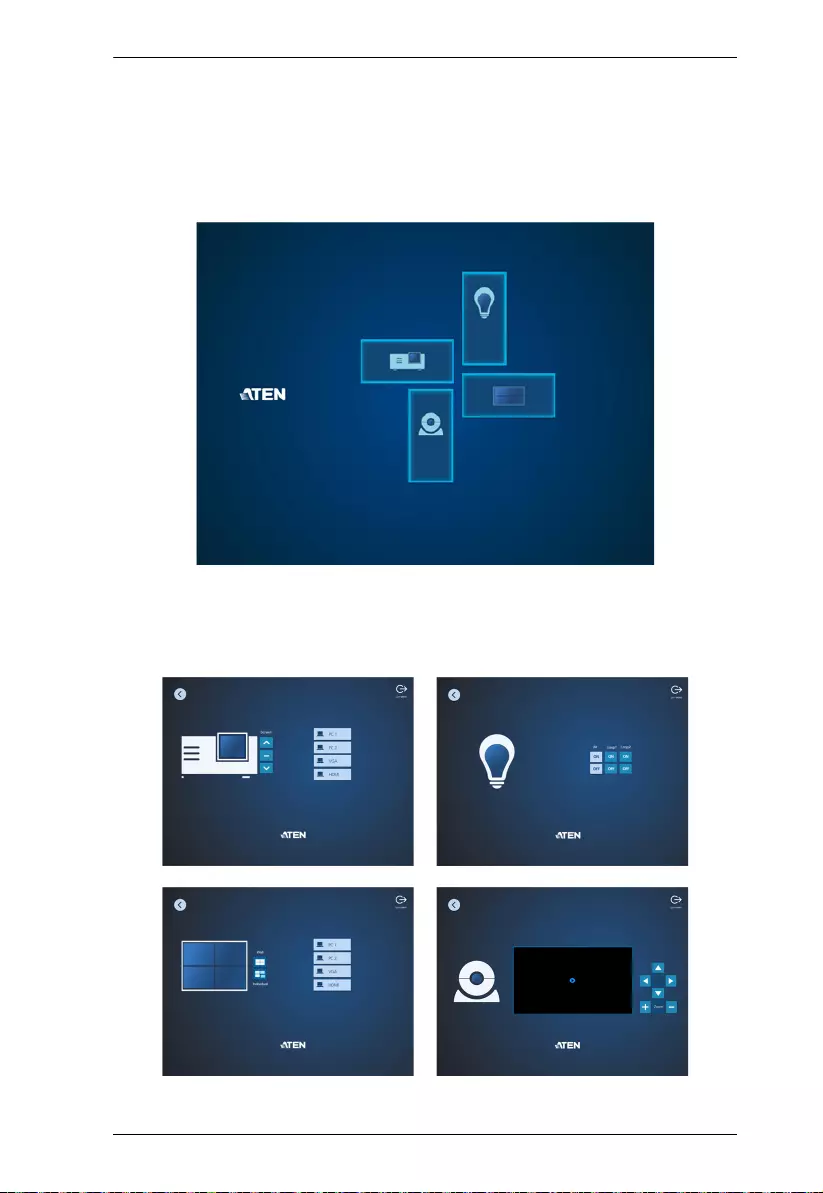
Chapter 7. ATEN Control System App
267
Demo
This demo shows different buttons that can be pressed to control the Projector,
Lights, Video Wall and Camera. Tap the icons to view control pages for each
device. Tap the Quit Demo icon to return to the previous page, or press on the
background until the logout dialog appears.
Control Pages

ATEN Control System User Manual
268
The images above show control pages for the Projector, Lights, Video Wall
and Camera in Demo. Tap the Home icon in the lower left corner to return to
the previous page, or press on the background until the logout dialog appears.
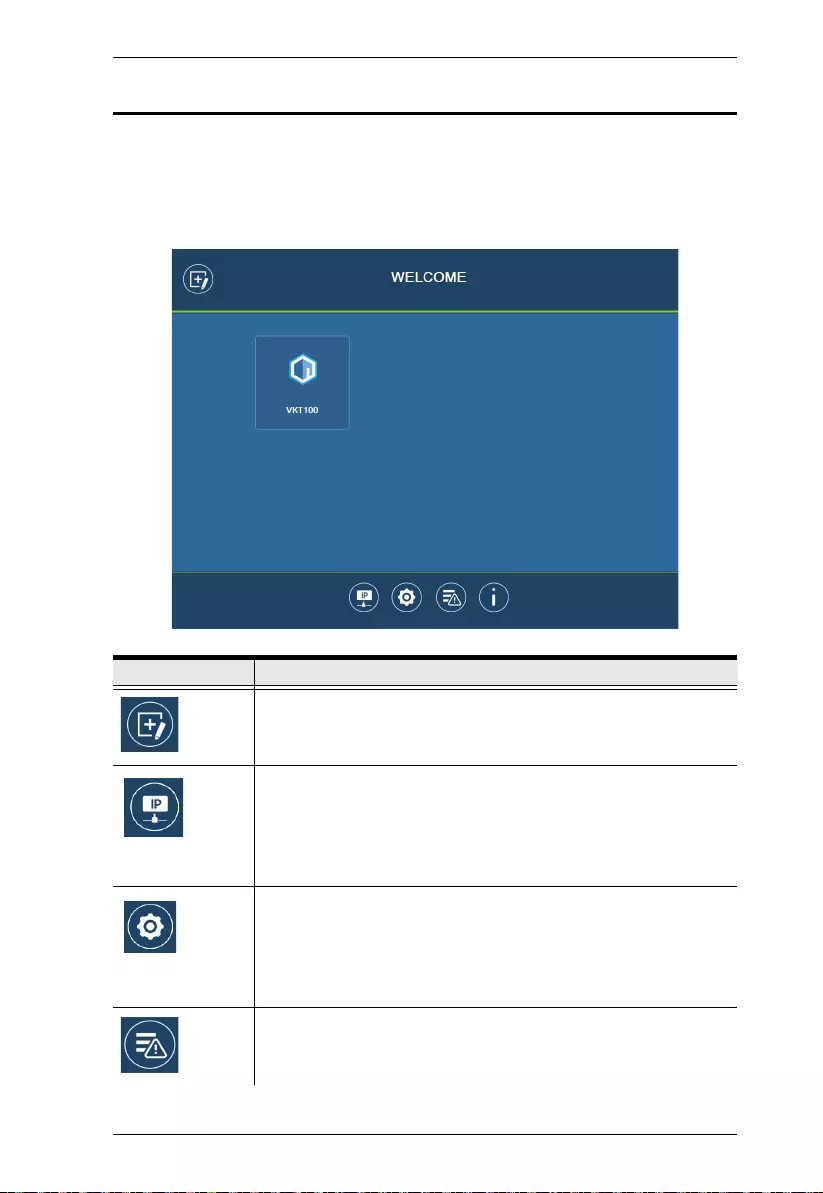
Chapter 7. ATEN Control System App
269
Welcome
The Welcome screen is the home screen of the ATEN Control System app. It
lists the Viewers and provides administrative options. Tap a Viewer to open the
controls for a room (see Configuring Control Interfaces, page 120), or use the
administrative options listed below.
Icon Description
Manage Viewer – Use this page to add, update, and remove
downloaded Viewers. See page 271 for details.
Manage LANDevice – Use this page to access controller’s web
console or configure the network settings for controllers and the
devices that they manage. See page 272 for details.
Preference – Use this page to set a password for accessing the
appor configure the app’s usage settings. See page 275 for
details.
Log Report – Use this page to lookup logs to troubleshoot
connectivity issues. See page 277 for details.
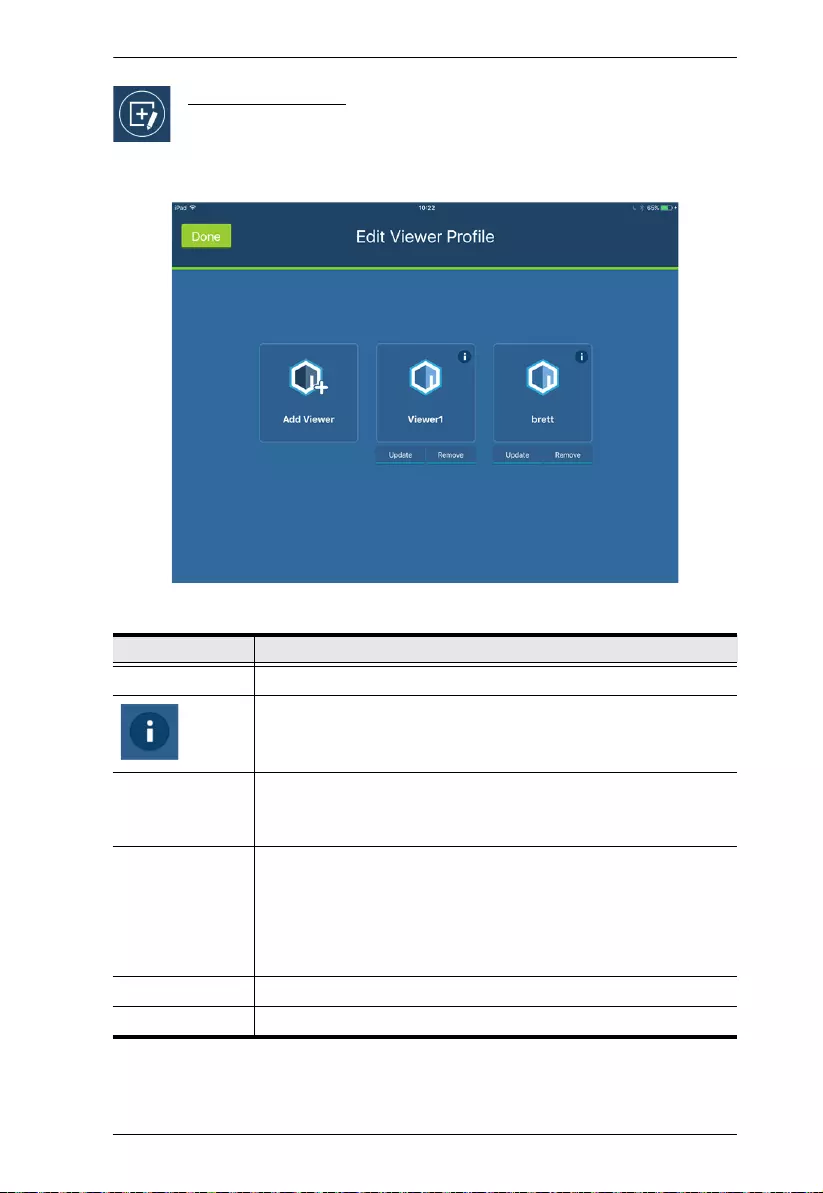
Chapter 7. ATEN Control System App
271
Manage Viewer
The Manage Viewer page allows you to add, update, and remove
downloaded Viewers. To download Viewers, tap Add Viewer (see
Preference, page 275).
Icon Description
Add Viewer Tap Add Viewer to download Viewers. See page 280 for details.
Tap the Information icon to view the MAC Address, IP Address
and Controller ID of the controller associated with the Viewer.
Update Tap Update to connect to the controller and download an updated
version of the Viewer. After the update, the “Downloaded
Successfully” prompt will appear
Remove Tap Remove to delete the Viewer. A dialog box will appear to
confirm deletion of the Viewer.
Tap Delete to remove the Viewer, or Cancel to cancel the deletion.
Note: Viewers are only deleted on the mobile device, and will still
be available on the controller.
Done Tap Done to return to the Welcome page.
Add Viewer Tap Add Viewer to download Viewers. See page 280 for details.
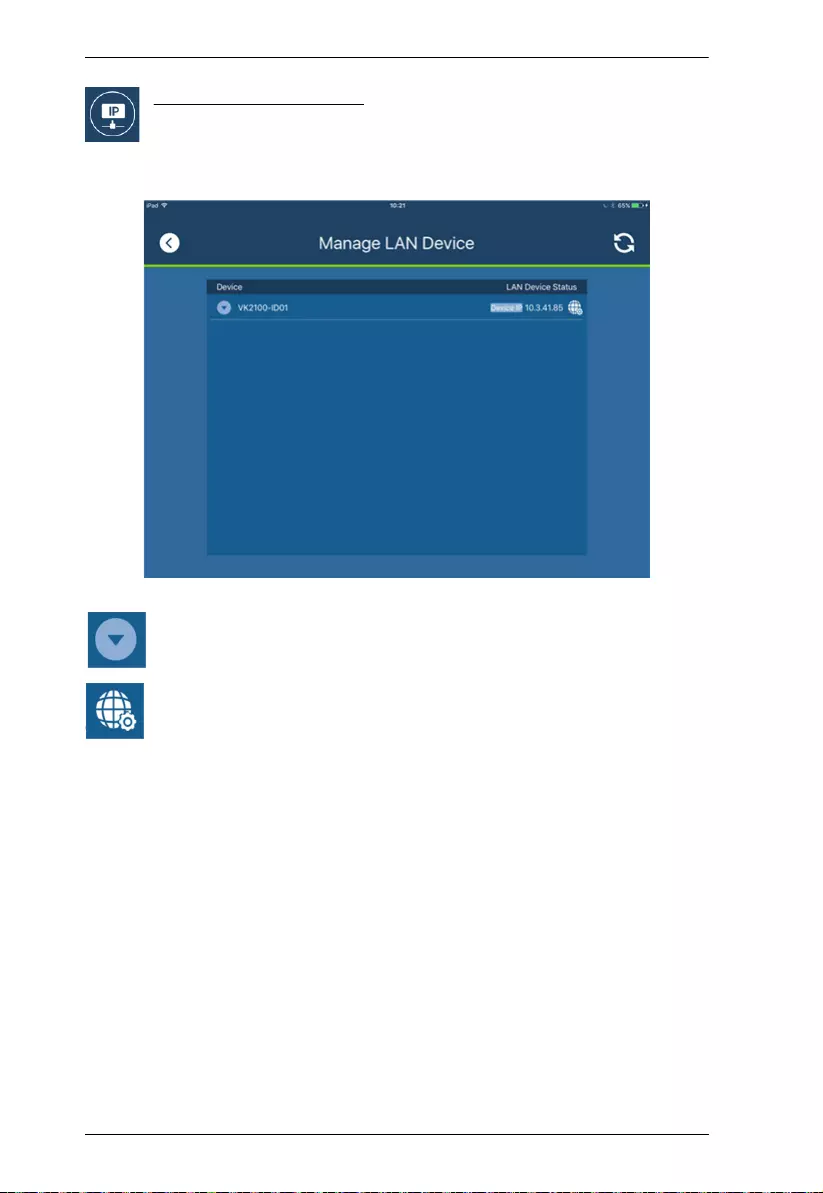
ATEN Control System User Manual
272
Manage LAN Device
The Manage LAN Device page allows you to edit network settings for
the controllers and LAN devices added in the Configurator software
(see Device Library, page 119).
Tap to expand controllers to view connected LAN devices.
Tap to open the web GUI (Chapter 3, Web-Based Configuration and
Control).
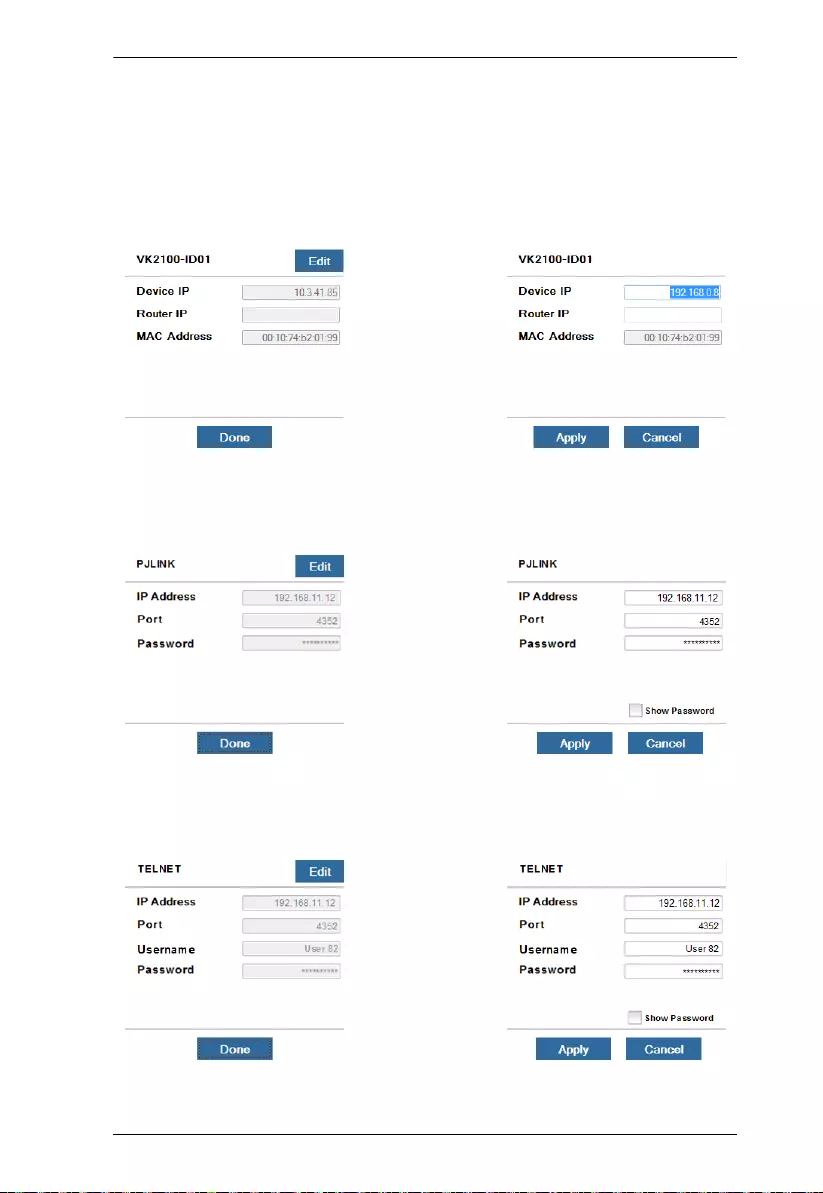
Chapter 7. ATEN Control System App
273
Depending on the LAN device you select, different options are available.Tap
on a device to open the settings page. Use Edit to change settings, Apply to
save or OK to exit.
Controller
PJLink Projector
Telnet
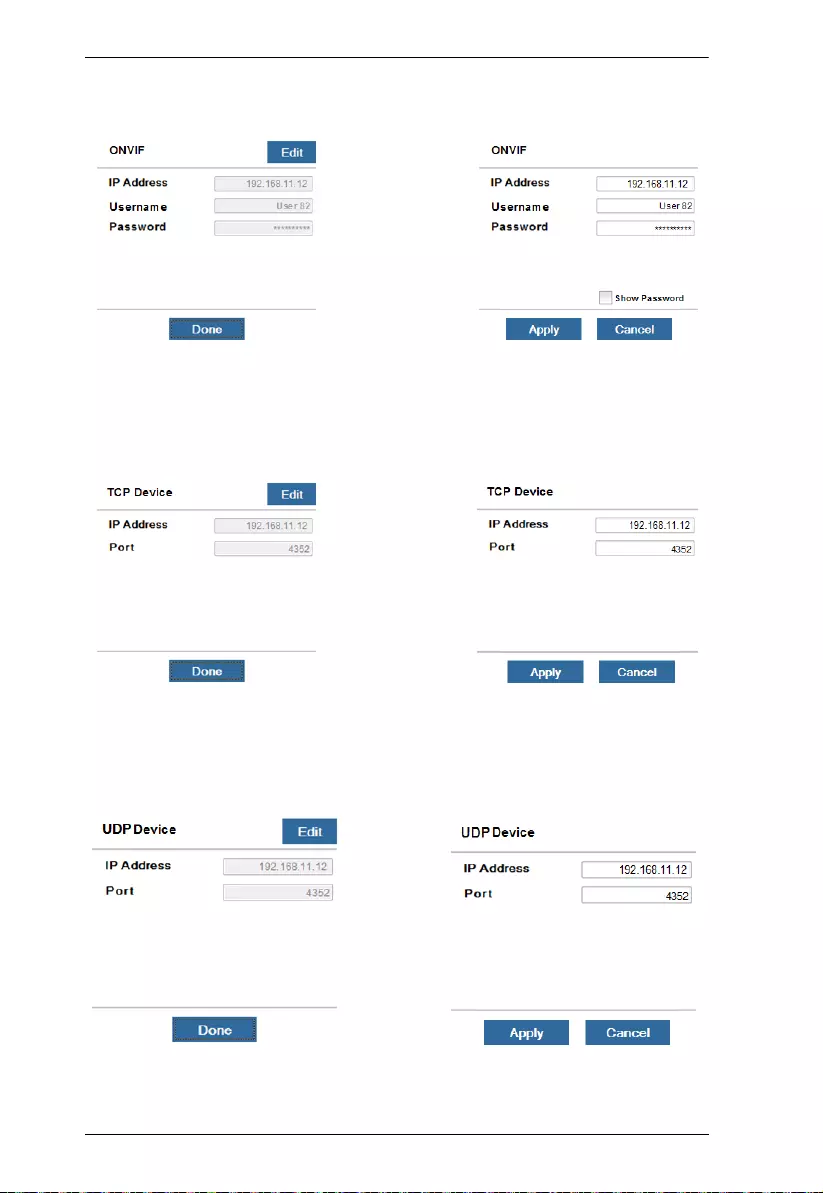
ATEN Control System User Manual
274
ONVIF
TCP
UDP
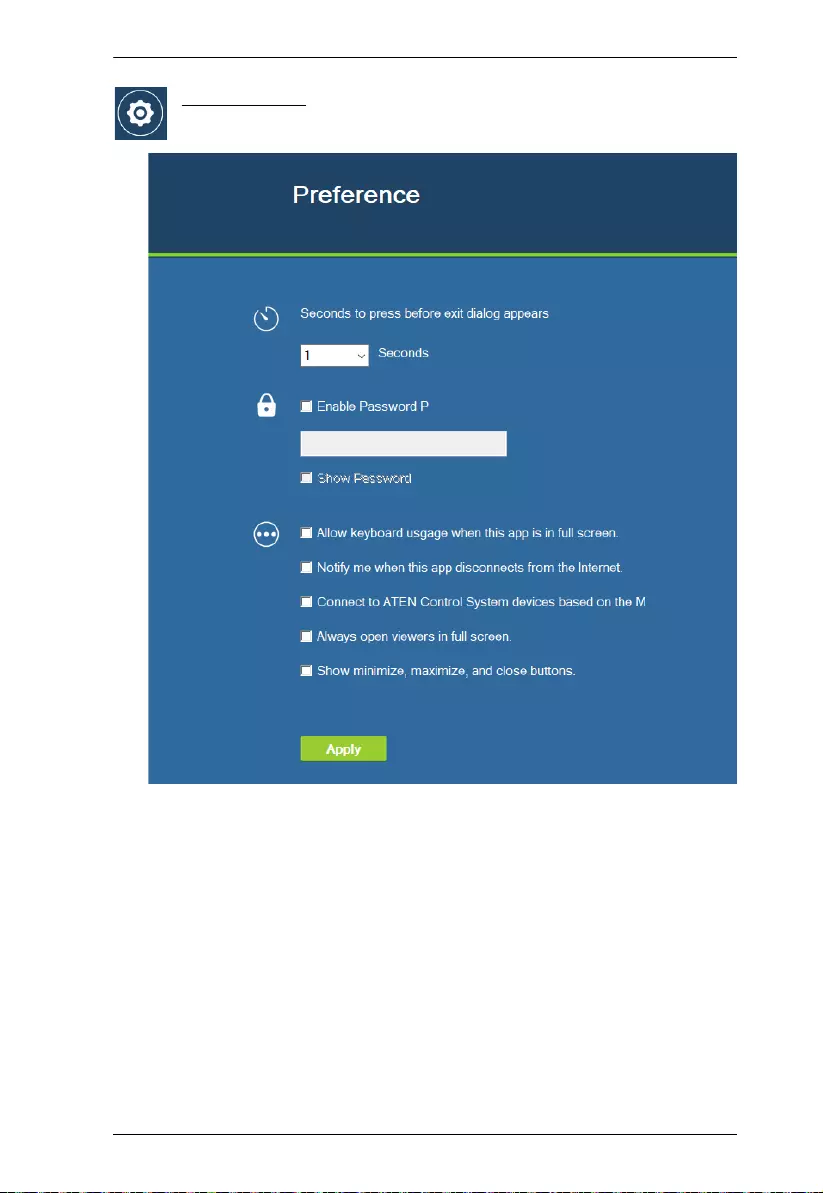
Chapter 7. ATEN Control System App
275
Preference
The Preference page provides the following settings.
Seconds to press before the exit dialog appears: This sets the duration of
idle time. When the app idles for the specified duration, an Exit dialog
appears to check if the user wants to close the app.
Enable Password: Enable password authentication for accessing the app.
Allow keyboard usage when this app is in full screen: Enable this
option to allow keyboard operation when the app is in full screen.
Notify me when this app disconnects from the Internet: Select this
option to notify the user when the app disconnects from the Internet.
Connect to ATEN Control System devices based on the Manage
Device IP list: Select this option for the app to identify and connect to
controllers by IP address instead of the controller ID, This is useful when

ATEN Control System User Manual
276
you create projects by duplication, in which case you do not need to re-
configure the controller ID in each project.
Always open viewers in full screen: This setting is only available when
using the app on a Windows platform. Enable this setting to open Viewers
(i.e. control pages, for examples see page 265) in full screen.
Show minimize, maximize, and close buttons: This setting is only
available when using the app on a Windows platform. Enable this setting
to show the minimize, maximize, and close buttons at the top-right corner
of a Viewer (i.e. control page, for examples see page 265).
Show alert messages for Ethernet devices managed by the controller:
This setting is only available when using the app on an iOS platform.
Enable this setting to receive status notifications for the managed Ethernet
devices.
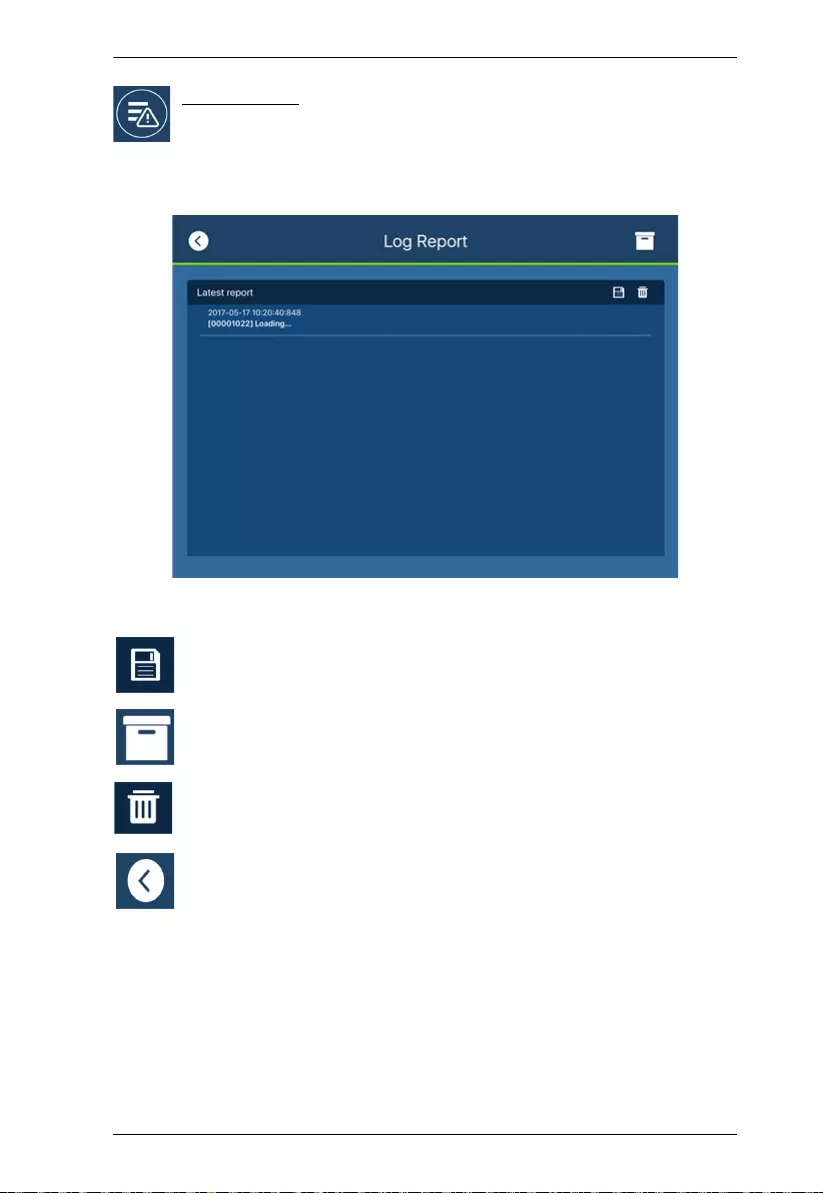
Chapter 7. ATEN Control System App
277
Log Report
The Log Report page lists information and errors which can be used
to troubleshoot issues. Tap and drag the list to scroll through the
logs. Tap Back to exit.
Tap Save to save the log file.
Tap Report History to view saved logs (see page 278).
Tap Delete to delete the log information.
Tap Back to exit.
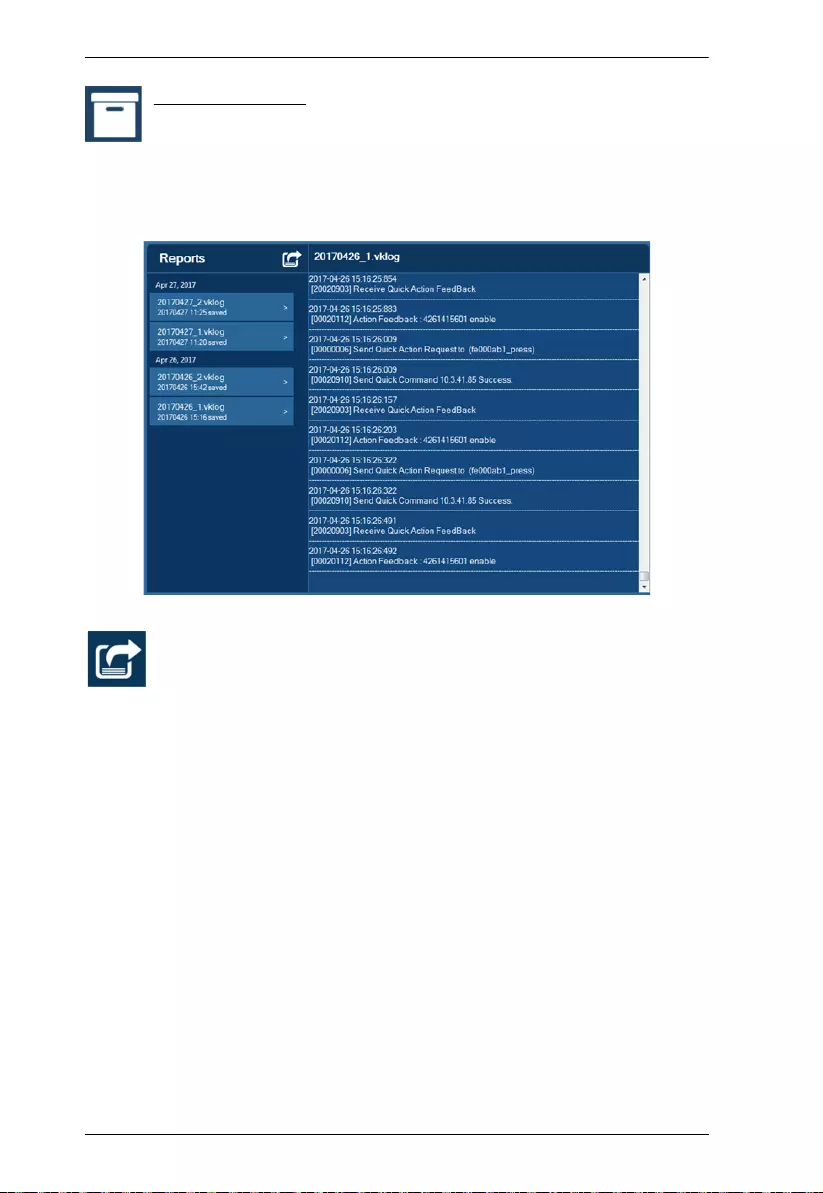
ATEN Control System User Manual
278
Report History
When you tap Report History, you can view and export logs. Saved
log files are listed by date in the left column. Tap a log file to view it
in the window to the right. Tap and drag the list to scroll through the
logs. Tap Back to exit.
Tap Export to send the log as an e-mail attachment.
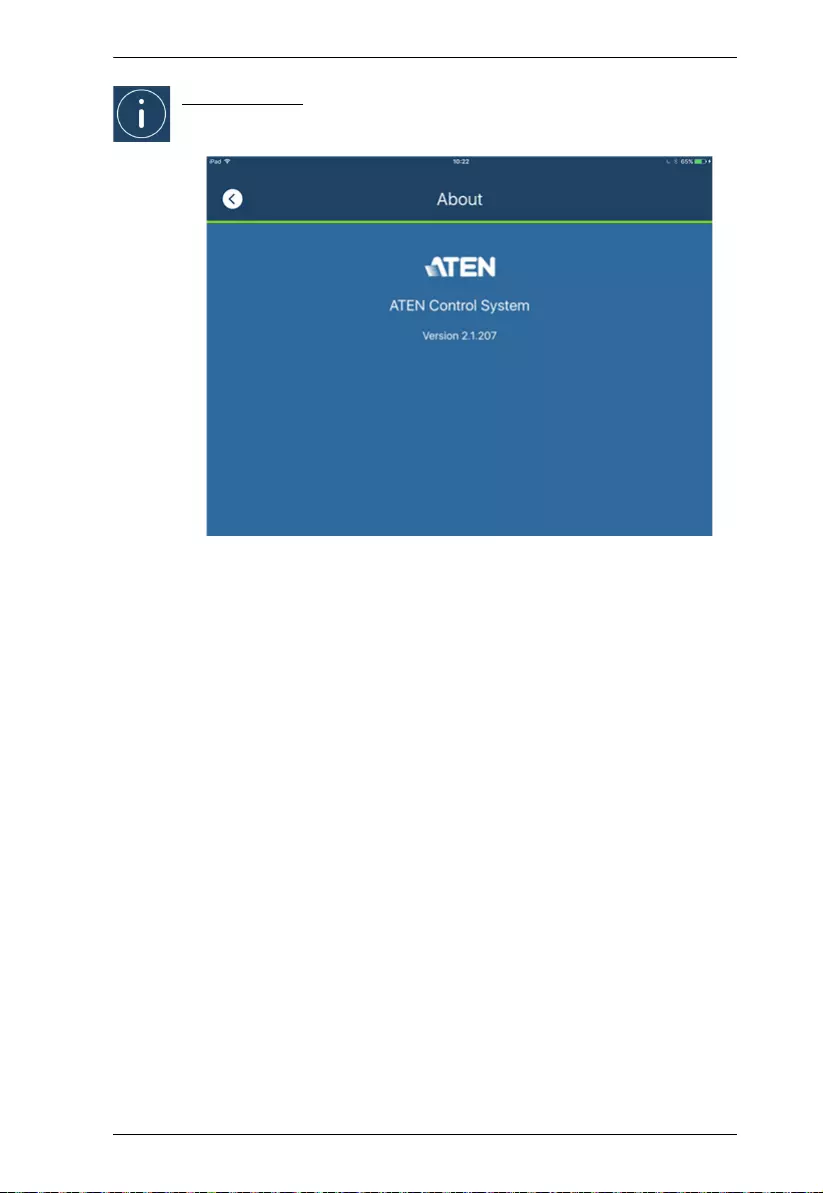
Chapter 7. ATEN Control System App
279
Information
The Information page displays the ATEN Control System’s version.
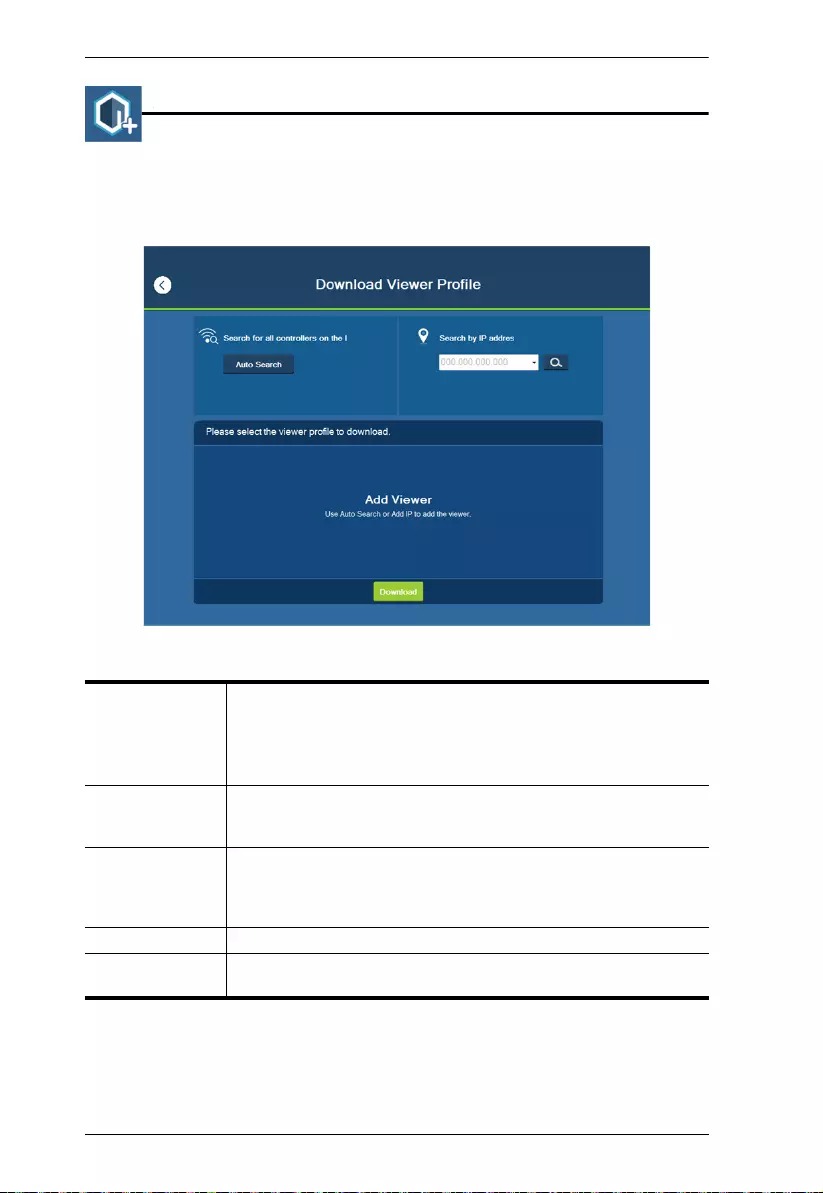
ATEN Control System User Manual
280
Download Viewer
The Download Viewer page allows you to search for controllers and
download Viewers. This page is accessed from Welcome
→
Manage
Viewer
→
Add Viewer.
Search by IP
Address
Tap to enter a controller’s IP address, then tap the Search icon to
find it. When controllers are found on the network, they are listed in
the Add Viewer box.
A Search History drop-down menu will appear for previously
searched IP addresses.
Auto Search Auto Search allows you to search for controllers without specifying
an IP address. The controller must be powered on and connected
to the same local network.
Add Viewer This panel lists the controllers that have been found on the network.
Each controller lists Viewers that can be downloaded to the mobile
device. To upload Viewers to a controller, see The Upload Tab,
page 218.
Back Icon Back returns you to the Welcome page.
Download After you select the Viewers you want to download, click Download
to start the process.
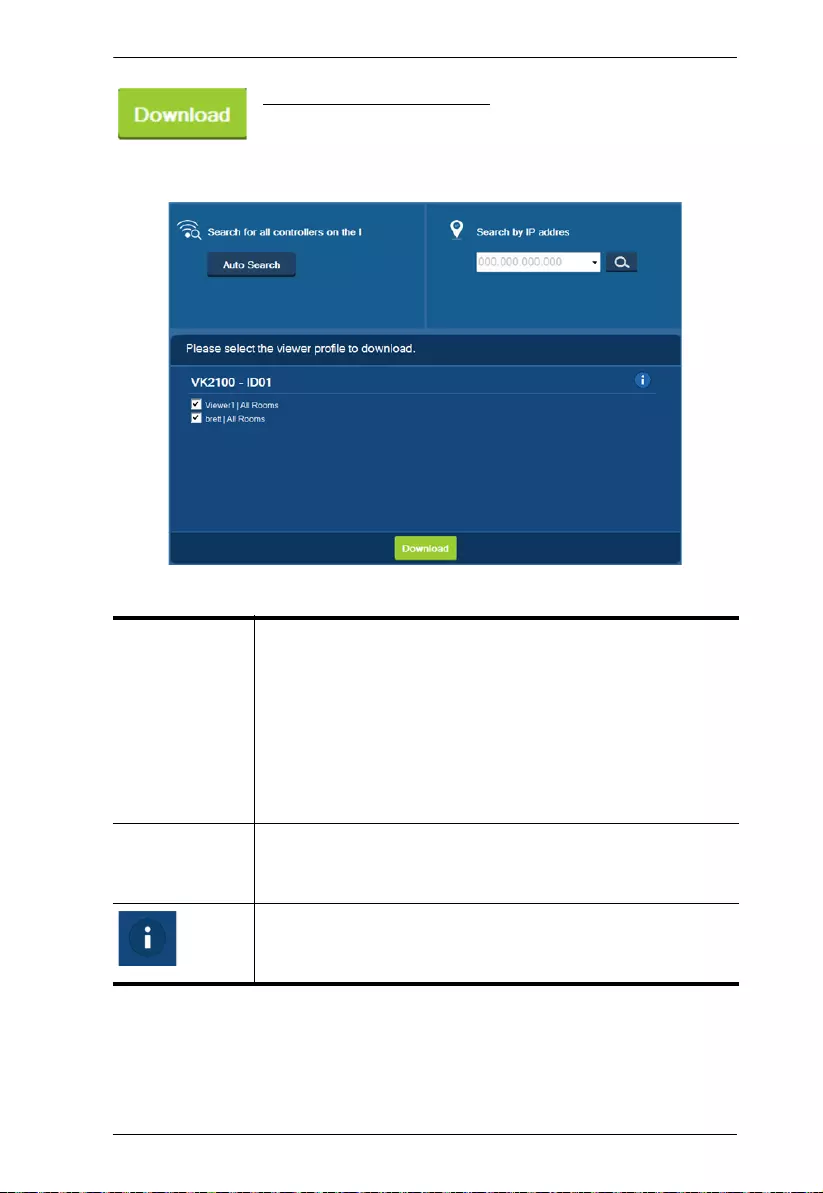
Chapter 7. ATEN Control System App
281
Downloading Viewers
When controllers are found, they appear in the Add Viewer
panel. Check the boxes of the Viewers you would like to
download, then tap Download.
Add Viewer The main window lists the controllers that have been found on the
network. Under each controller is a list of Viewers with a check box.
Use the check boxes to select the Viewers you want to download,
then click Download. If the Lock icon appears, you will be
prompted to enter the access key.
After Viewers download, the “Downloaded Successfully” prompt
appears. Tap Done to return to the Welcome page where the
Viewers will be listed.
Note: After you download a Viewers to the mobile device, the
default Welcome screen no longer appears.
Access Key When the a Viewers requires an access key a window appears
prompting you to enter the key. Enter the correct access key and
then click OK to download the Viewers from the controller. To set
the access key, see The Upload Tab, page 218.
Tap the Information icon to view the IP Address, MAC Address
and License information of the controller. The license information
provides the total number of licenses available and the number in
use.

ATEN Control System User Manual
282
This Page Intentionally Left Blank

Appendix
283
Appendix
Safety Instructions
General
Read all of these instructions. Save them for future reference.
Follow all warnings and instructions marked on the device.
This product is for indoor use only.
Do not place the device on any unstable surface (cart, stand, table, etc.). If
the device falls, serious damage will result.
Caution: Risk of explosion if the battery is replaced by an incorrect type.
Always dispose of used batteries according to the proper instructions.
Do not use the device near water.
Do not place the device near, or over, radiators or heat registers.
The device cabinet is provided with slots and openings to allow for
adequate ventilation. To ensure reliable operation, and to protect against
overheating, these openings must never be blocked or covered.
The device should never be placed on a soft surface (bed, sofa, rug, etc.) as
this will block its ventilation openings. Likewise, the device should not be
placed in a built in enclosure unless adequate ventilation has been provided.
Never spill liquid of any kind on the device.
Unplug the device from the wall outlet before cleaning. Do not use liquid
or aerosol cleaners. Use a damp cloth for cleaning.
The device should be operated from the type of power source indicated on
the marking label. If you are not sure of the type of power available,
consult your dealer or local power company.
To prevent damage to your installation it is important that all devices are
properly grounded.
Do not allow anything to rest on the power cord or cables. Route the
power cord and cables so that they cannot be stepped on or tripped over.
Position system cables and power cables carefully; Be sure that nothing
rests on any cables.
Never push objects of any kind into or through cabinet slots. They may
touch dangerous voltage points or short out parts resulting in a risk of fire
or electrical shock.

ATEN Control System User Manual
284
Do not attempt to service the device yourself. Refer all servicing to
qualified service personnel.
If the following conditions occur, unplug the device from the wall outlet
and bring it to qualified service personnel for repair.
The power cord or plug has become damaged or frayed.
Liquid has been spilled into the device.
The device has been exposed to rain or water.
The device has been dropped, or the cabinet has been damaged.
The device exhibits a distinct change in performance, indicating a need
for service.
The device does not operate normally when the operating instructions
are followed.
Only adjust those controls that are covered in the operating instructions.
Improper adjustment of other controls may result in damage that will
require extensive work by a qualified technician to repair.
Avoid circuit overloads. Before connecting equipment to a circuit, know
the power supply’s limit and never exceed it. Always review the electrical
specifications of a circuit to ensure that you are not creating a dangerous
condition or that one doesn’t already exist. Circuit overloads can cause a
fire and destroy equipment.

Appendix
285
Rack Mount
Before working on the rack, make sure that the stabilizers are secured to
the rack, extended to the floor, and that the full weight of the rack rests on
the floor. Install front and side stabilizers on a single rack or front
stabilizers for joined multiple racks before working on the rack.
Always load the rack from the bottom up, and load the heaviest item in the
rack first.
Make sure that the rack is level and stable before extending a device from
the rack.
Use caution when pressing the device rail release latches and sliding a
device into or out of a rack; the slide rails can pinch your fingers.
After a device is inserted into the rack, carefully extend the rail into a
locking position, and then slide the device into the rack.
Do not overload the AC supply branch circuit that provides power to the
rack. The total rack load should not exceed 80 percent of the branch circuit
rating.
Make sure that all equipment used on the rack – including power strips and
other electrical connectors – is properly grounded.
Ensure that proper airflow is provided to devices in the rack.
Ensure that the operating ambient temperature of the rack environment
does not exceed the maximum ambient temperature specified for the
equipment by the manufacturer.
Do not step on or stand on any device when servicing other devices in a
rack.
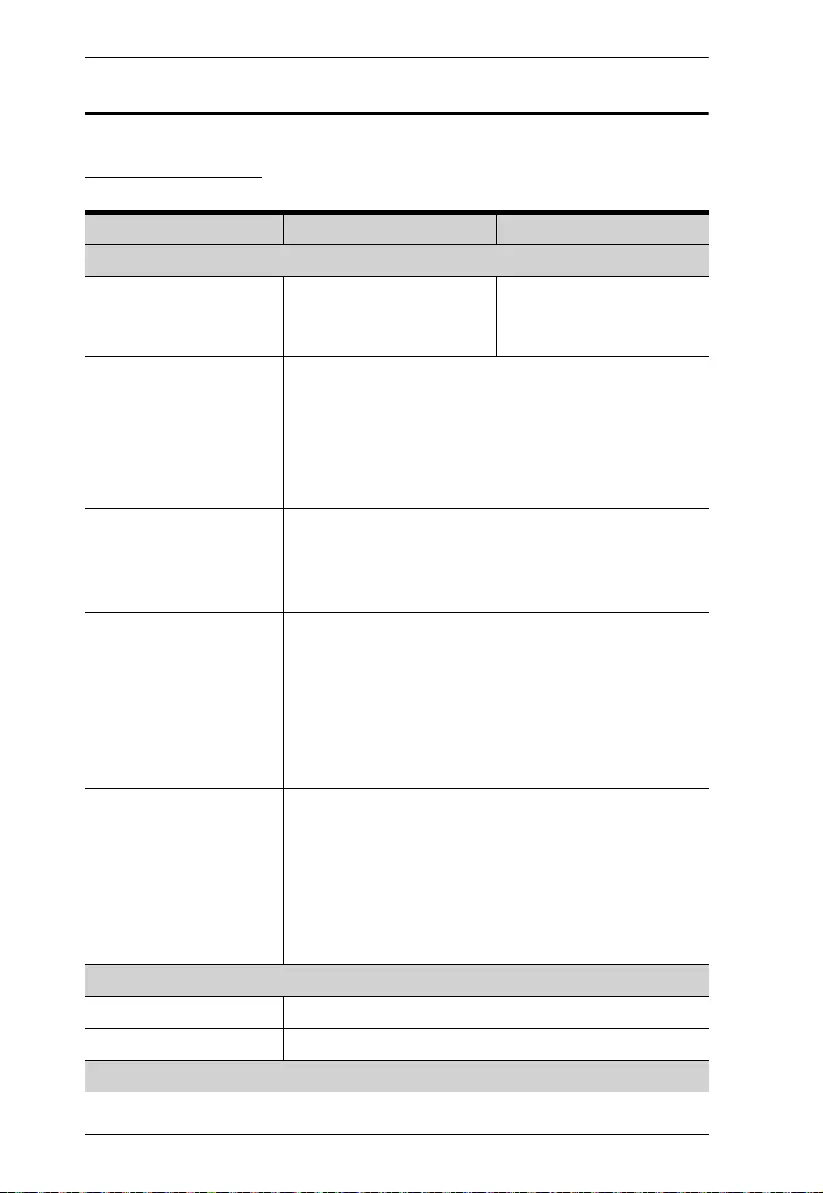
ATEN Control System User Manual
286
Specifications
VK0100 / VK0200
VK0100 VK0200
Interface
Keypad Layout Up to 14 layout variations
using 4 ~ 8 buttons
Up to 125 layout
variations using 6 ~ 12
buttons
Serial • 2 x Bidirectional RS-232 Port (2 x 3-Pole Terminal
Block Connector)
• Baud Rate: 300 to 115200 (default: 9600)
• Data Bit: 8 (default) or 7
• Stop Bit: 1 (default) or 2
• Parity: None (default), even or odd
Relay • 2 x Relay Channel (2 x 2-Pole Terminal Block
Connector)
• Normally open, isolated Relays
• Contact Rating: Max 24 VDC, 1A
Digital Input • 1 x Digital Input Channel (1 x 2-Pole Terminal
Block Connector);
• VDC Mode
- Input Voltage Range: 0 to 5 VDC
- Programmable Range: 1 to 5 VDC
• Dry Contact Mode
- Pull-up 2k ohms to + 5 VDC
Ethernet • 1 x RJ-45 Female, 10/100Base-T
• Supported Protocol: ARP, ICMP, TCP/IP, DHCP,
HTTPS, SSH
• DHCP-enabled. The following default IP settings
will be used if no IP is assigned within 30 seconds:
IP: 192.168.0.60
Subnet Mask: 255.255.255.0
Switches & Buttons
Controller ID Switch 1 x 16-segment Switch
Reset Button 1 x Semi-recessed Pushbutton
Power
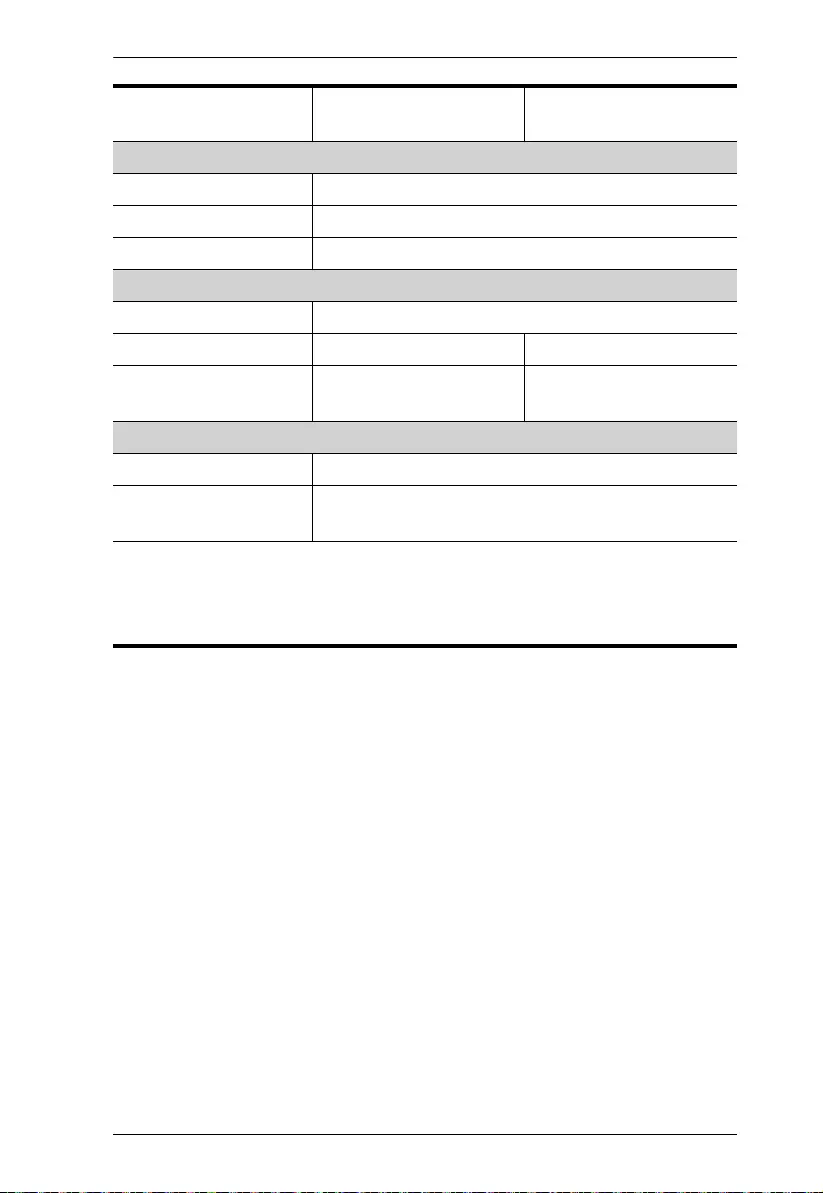
Appendix
287
Power Consumption DC5V:1.1W:5BTU
DC48V:1.375W:6BTU
DC5V:1.15W:5BTU
DC48V:1.44W:7BTU
Environmental
Operating Temperature 0 – 50°C
Storage Temperature –20 – 60°C
Humidity 0 - 80% RH, Non-Condensing
Physical Properties
Housing Plastic
Weight 0.35 kg (0.77 lb) 0.38 kg (0.84 lb)
Dimension 11.63 x 7.06 x 4.84 cm
(4.58 x 2.78 x 1.91 in)
8.32 x 14.76 x 4.84 cm
(3.28 x 5.81 x 1.91 in)
Mobile Control License
No. of free licenses 0
Max. no. of paid
licenses
10
Note: Each time a mobile device connects to an ATEN Control Pad for
remote control, one license on the Control Pad will be occupied. To purchase
and add additional licenses to your Control Pad, contact your local sales
representative for more information.
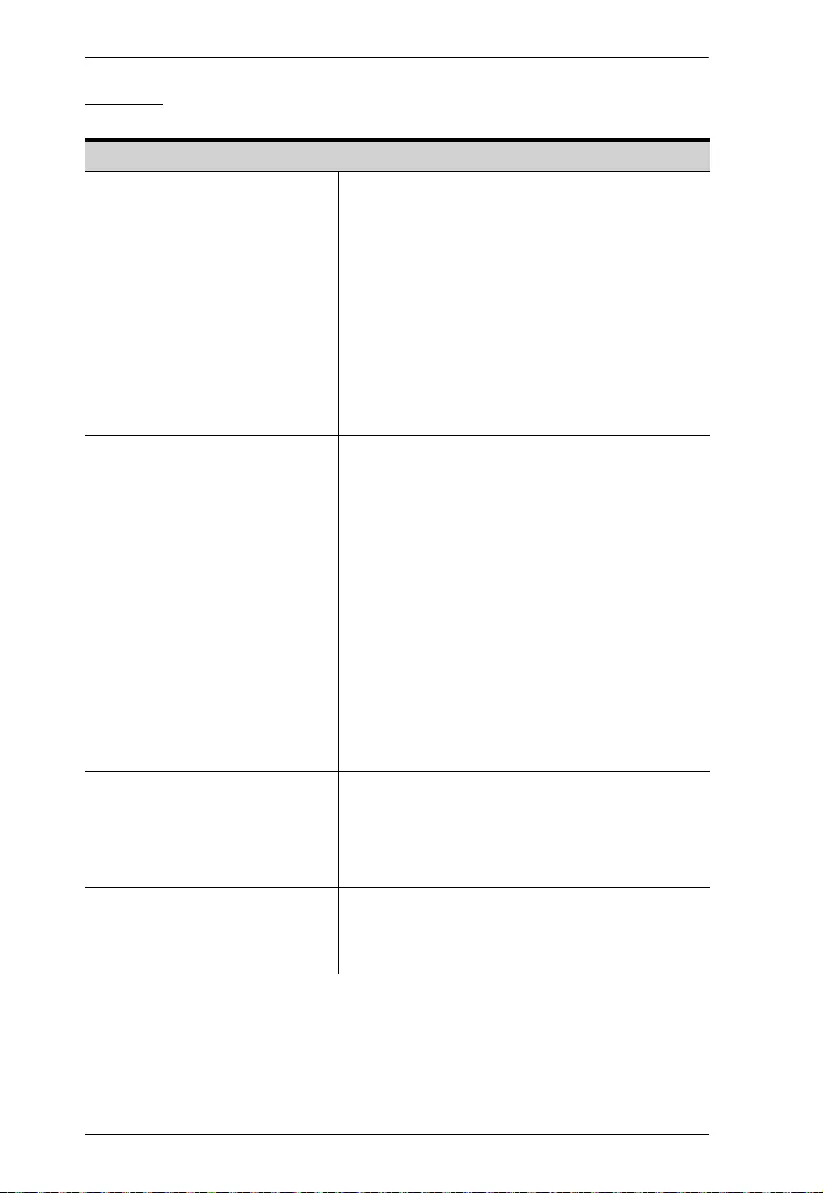
ATEN Control System User Manual
288
VK1100
Interface
Serial 2 x Programmable bidirectional
RS-232/422/485 ports (2 x DB9 male
connectors, configurable via pin
assignments)
Baud Rate: 300 to 115200 (default: 9600)
Data Bit: 8 (default) or 7
Stop Bit: 1 (default) or 2
Parity: None (default), Even, or Odd
Flow Control: None (default) RTS/CTS
IR/Serial 2 x Programmable IR / Unidirectional
RS-232 Ports (1 x 3-Pole Terminal Block
Connectors)
IR:
Carrier Frequency: 10KHz~455KHz
Serial:
Baud Rate: 300 to 115200 (default: 9600)
Data Bit: 8 (default) or 7
Stop Bit: 1 (default) or 2
Parity: None (default), Even, or Odd
Relay
4 x Relay Channels (2 x 4-Pole Terminal
Block Connector)
Normally Open, Isolated Relays
Contact Rating: Max 24 VDC, 2A
VDC
1 x 12 VDC Output Ports (1 x 2-Pole
Terminal Block Connectors)
Power Supply: 12 VDC, 1A Max
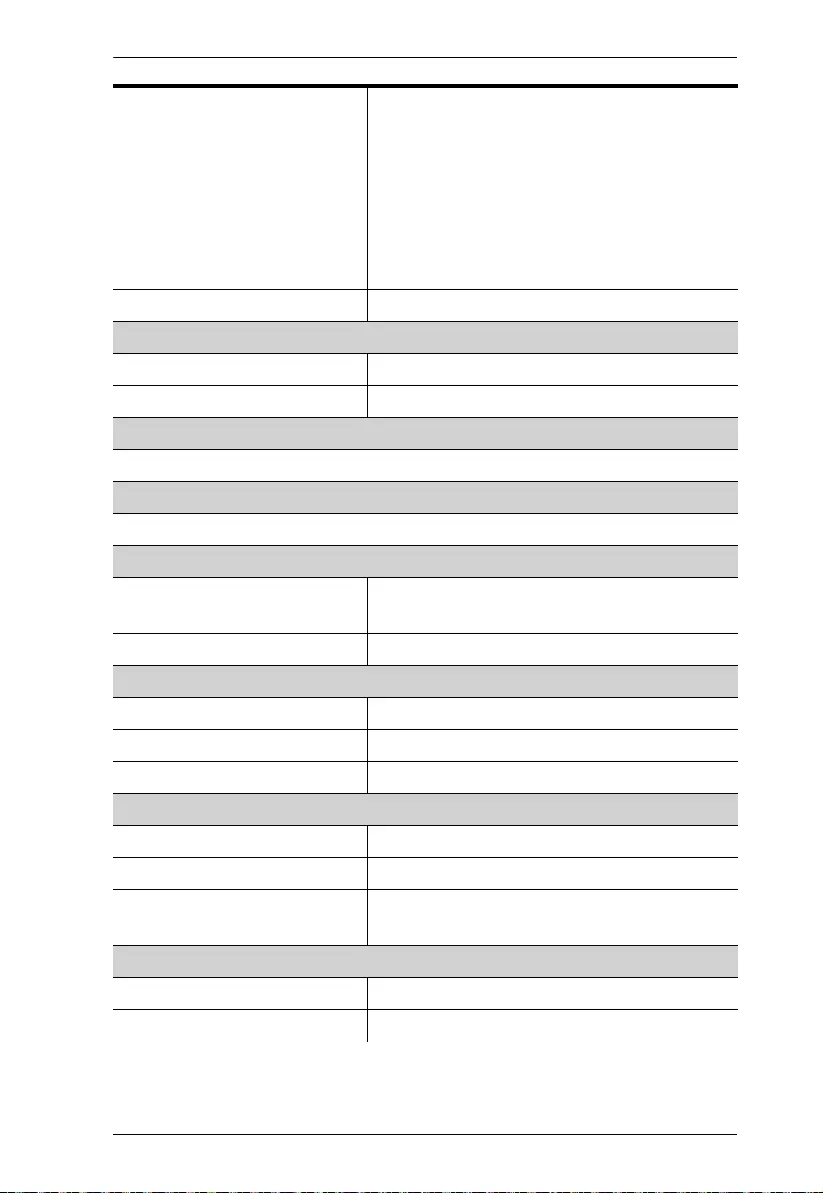
Appendix
289
Ethernet
1 x RJ-45 Female, 10/100 Base-T
Supported protocol: ARP, ICMP, TCP/IP,
DHCP, HTTPS, SSH
DHCP-enabled. Default IP settings (IP
address 192.168.0.60, subnet mask
255.255.255.0) will be automatically
applied if no IP address is assigned after
connecting to the network for 30 seconds.
USB 1 x USB Type-A
Switches
Controller ID 1 x 16-Segment Switch
Power 1 x on/off Switch
IR Learning
1 x IR Receiver LED
Reset Button
1 x Semi-recessed pushbutton
Power
Power Consumption AC110V:5.4W:87BTU
AC2V:5.4W:87BTU
Maximum Input Power Rating internal power: 100-240 VAC, 50-60 Hz
Environmental
Operating Temperature 0–50ºC
Storage Temperature -20–60ºC
Humidity 0–80% RH, Non-condensing
Physical Properties
Housing Metal
Weight 1.19 kg (2.62 lb)
Dimensions (L x W x H) 21.50 x 16.23 x 4.18 cm (8.46 x 6.39 x 1.65
in.)
Mobile Control License
No, of free licenses 2
Max. no. of licenses 16

ATEN Control System User Manual
290
The ATEN Control Box comes with two free licenses which are stored in the
device itself. Each time a mobile device connects to an ATEN
Control Box for remote control, one license on the Control Box will be
occupied. To purchase and add additional licenses to your Control Box,
contact your local sales representative for more information.
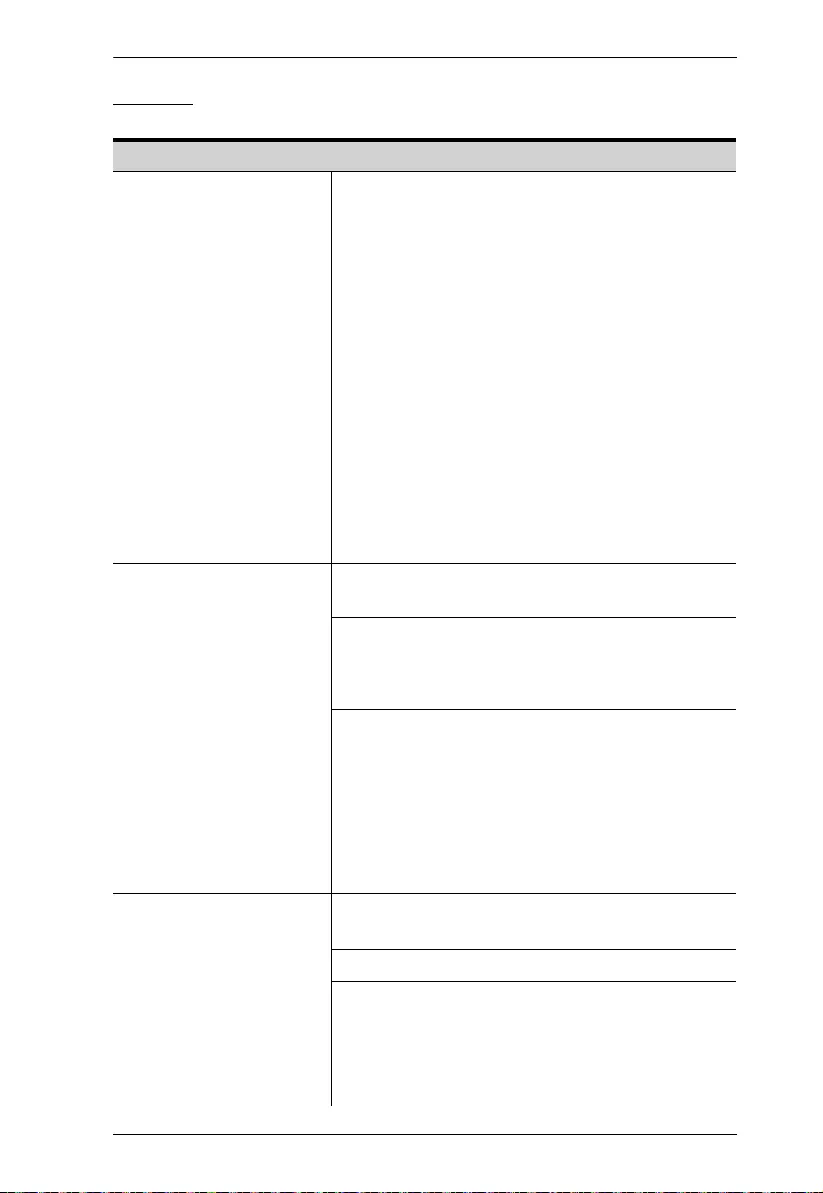
Appendix
291
VK2100
Interface
Serial 4 x Programmable Bidirectional RS-232/422/485
Ports (4 x DB9 Male Connectors, Configurable
via Pin Assignments)
Baud Rate: 300 to 115200 (default: 9600)
Data Bit: 8 (default) or 7
Stop Bit: 1 (default) or 2
Parity: None (default), Even or Odd
Flow Control: None (default) RTS/CTS
2 x Bidirectional RS-232 Ports (2 x 3-Pole
Terminal Block Connectors)
Baud Rate: 300 to 115200 (default: 9600)
Data Bit: 8 (default) or 7
Stop Bit: 1 (default) or 2
Parity: None (default), Even or Odd
IR/Serial 4 x Programmable IR / Unidirectional RS-232
Ports (2 x 4-Pole Terminal Block Connectors)
IR:
TTL level (0 to 5 V)
Carrier Frequency: 10KHz~455KHz
Serial:
Serial: Unidirectional RS-232 ( + - 5 V)
Baud Rate: 300 to 1150 (default: 9600)
Data Bit: 8 (default) or 7
Stop Bit: 1 (default) or 2
Parity: None (default), Even, or Odd
I/O 4 x Programmable Digital Input / Output
Channels (1 x 5-Pole Terminal Block Connector)
Digital Output: 250 mA sink from 12 VDC
Digital Input:
VDC Mode
Input Voltage Range: 0 to 24 VDC
Programmable Range: 1 to 24 VDC
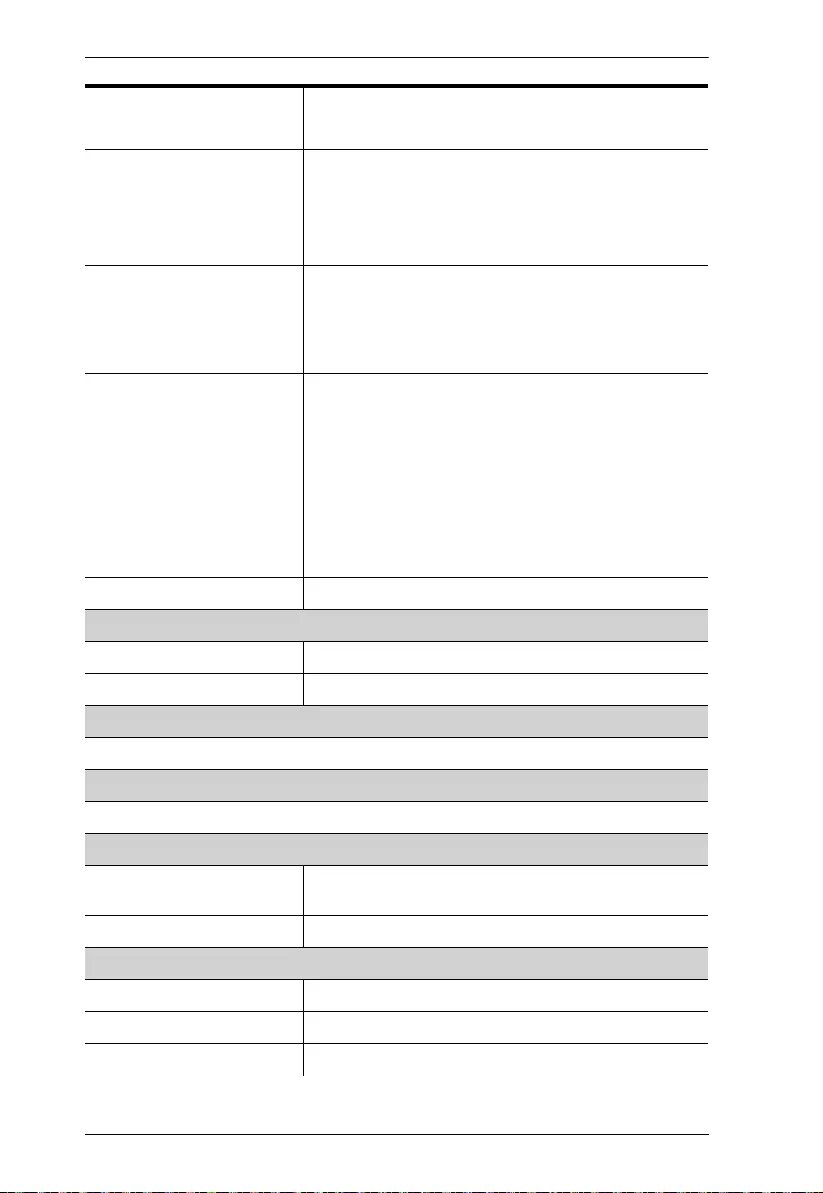
ATEN Control System User Manual
292
Dry Contact Mode:
Pull-up 2k ohms to + 12 VDC
Relay
4 x Relay Channels (2 x 4-Pole Terminal
Block Connector)
Normally Open, Isolated Relays
Contact Rating: Max 24 VDC, 2A
VDC
4 x 12 VDC Output Ports (2 x 4-Pole Terminal
Block Connectors)
Power Supply: 12 VDC, 2A Max (Shared By 4
Ports)
Ethernet
1 x RJ-45 Female, 10/100 Base-T
Supported protocol: ARP, ICMP, TCP/IP,
DHCP, HTTPS, SSH
DHCP-enabled. Default IP settings (IP
address 192.168.0.60, subnet mask
255.255.255.0) will be automatically applied if
no IP address is assigned after connecting to
the network for 30 seconds.
USB 1 x USB Type-A
Switches
Controller ID 1 x 16-Segment Switch
Power 1 x on/off Switch
IR Learning
1 x IR Receiver LED
Reset Button
1 x Semi-recessed pushbutton
Power
Power Consumption AC110V:4.8W:135BTU
AC2V:5.7W:140BTU
Max. Input Power Rating Internal power: 100-240 VAC, 50-60 Hz
Environmental
Operating Temperature 0–50ºC
Storage Temperature -20–60ºC
Humidity 0–80% RH, Non-condensing

Appendix
293
Physical Properties
Housing Metal
Weight 2.64 kg (5.81 lb)
Dimensions (L x W x H) 43.72 x 16.32 x 4.40 cm (17.21 x 6.43 x 1.73 in.)
Mobile Control License
No, of free licenses 2
Max. no. of licenses 16
Note: The ATEN Control Box comes with two free licenses which are stored
in the device itself. Each time a mobile device connects to an ATEN
Control Box for remote control, one license on the Control Box will be
occupied. To purchase and add additional licenses to your Control Box,
contact your local sales representative for more information.
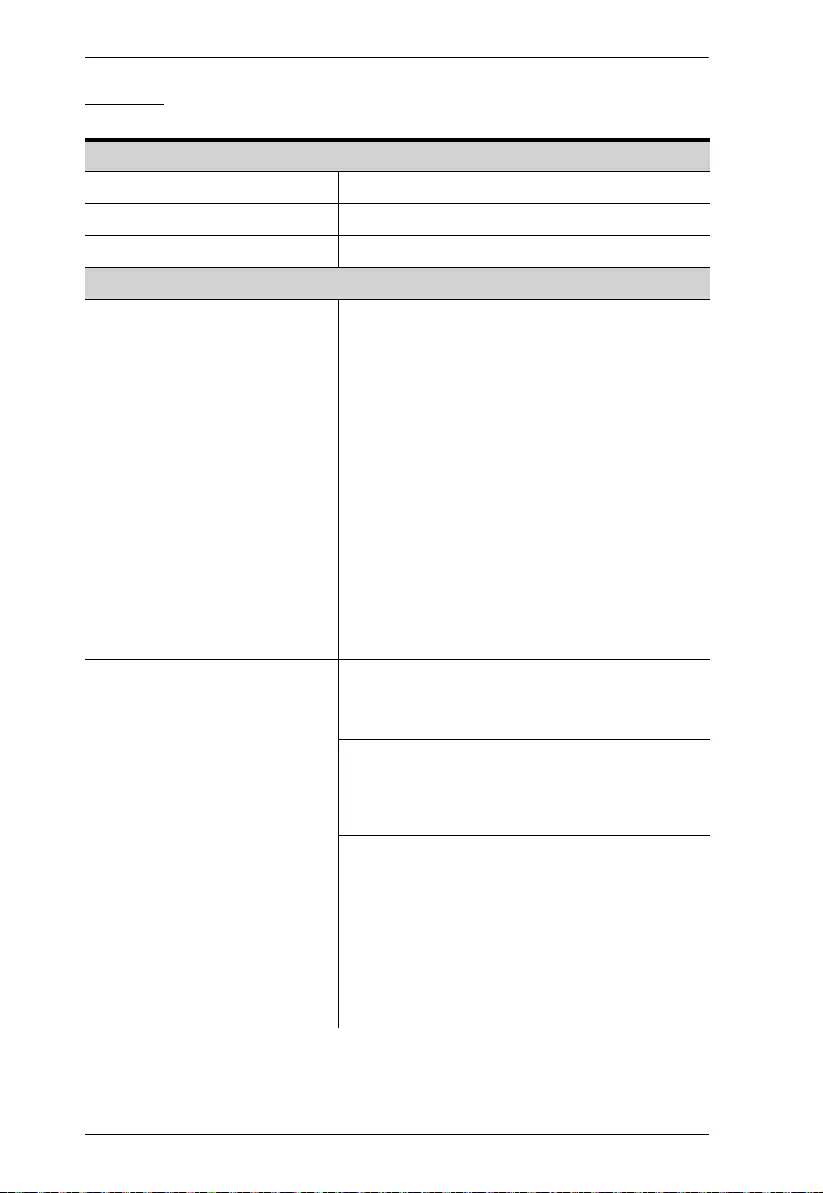
ATEN Control System User Manual
294
VK1200
System
CPU Quad-core Processor
SD RAM 1 GB
Flash Memory 8 GB
Interface
Serial 1 x Programmable bidirectional
RS-232/422/485 port (1 x 5-pole terminal
block connector)
1 x Programmable bidirectional RS-232 port
(1 x 3-pole terminal block connector)
Baud Rate: 300 ~ 115200 (default: 9600)
Data Bit: 8 (default) or 7
Stop Bit: 1 (default) or 2
Parity: None (default), Even, or Odd
Flow Control: None (default) RTS/CTS
(for 5-pole terminal block)
IR/Serial 2 x Programmable IR / Unidirectional
RS-232 Ports (2 x 2-Pole Terminal Block
Connectors)
IR:
Carrier Frequency: 10 ~ 455 kHz
Signal Level: TTL (0 ~ 5 V DC)
Serial:
Baud Rate: 300 ~ 115200 (default: 9600)
Data Bit: 8 (default) or 7
Stop Bit: 1 (default) or 2
Parity: None (default), Even, or Odd
Signal Level: TTL (0 ~ 5 V DC)
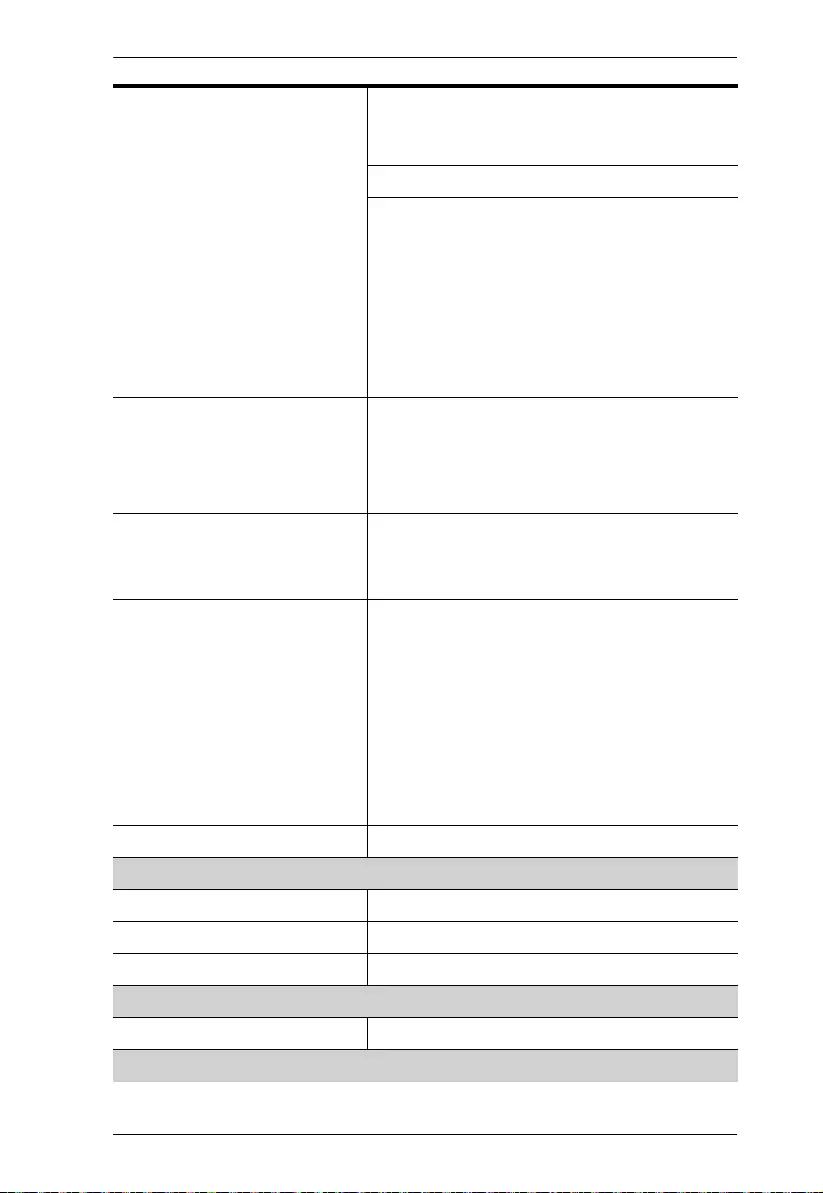
Appendix
295
I/O 2 x Programmable Digital Input / Output
Channels (1 x 3-Pole Terminal Block
Connector)
Digital Output: 300 mA sink from 24 V DC
Digital Input:
VDC Mode
Input Voltage Range: 0 ~ 24 V DC
Programmable Range: 1 ~ 24 V DC
Dry Contact Mode
Pull-up 2 kΩ to +12 V DC
Relay
4 x Relay Channels (2 x 4-Pole Terminal
Block Connector)
Normally Open, Isolated Relays
Contact Rating: Max 24 V DC, 2 A
V DC
1 x 12 V DC Output Port (1 x 2-Pole
Terminal Block Connectors)
Power Supply: 12 V DC, 1 A Max
Ethernet
2 x RJ-45 Female, 10/100/1000 Base-T
Supported protocol: ARP, ICMP, TCP/IP,
DHCP, HTTPS, SSH
DHCP-enabled. Default IP settings (IP
address 192.168.0.60 / 192.168.1.60 for
Control LAN / LAN, subnet mask
255.255.255.0) will be automatically
applied if no IP address is assigned within
30 seconds of connecting to the network.
USB 1 x USB Type-A
LCD Panel
Size 1.6”
LCM Display 64 x 128 resolution
LCM Setting 3 x Pushbuttons (Up, Down, Enter)
Switches
Power 1 x on/off Switch
IR Learning
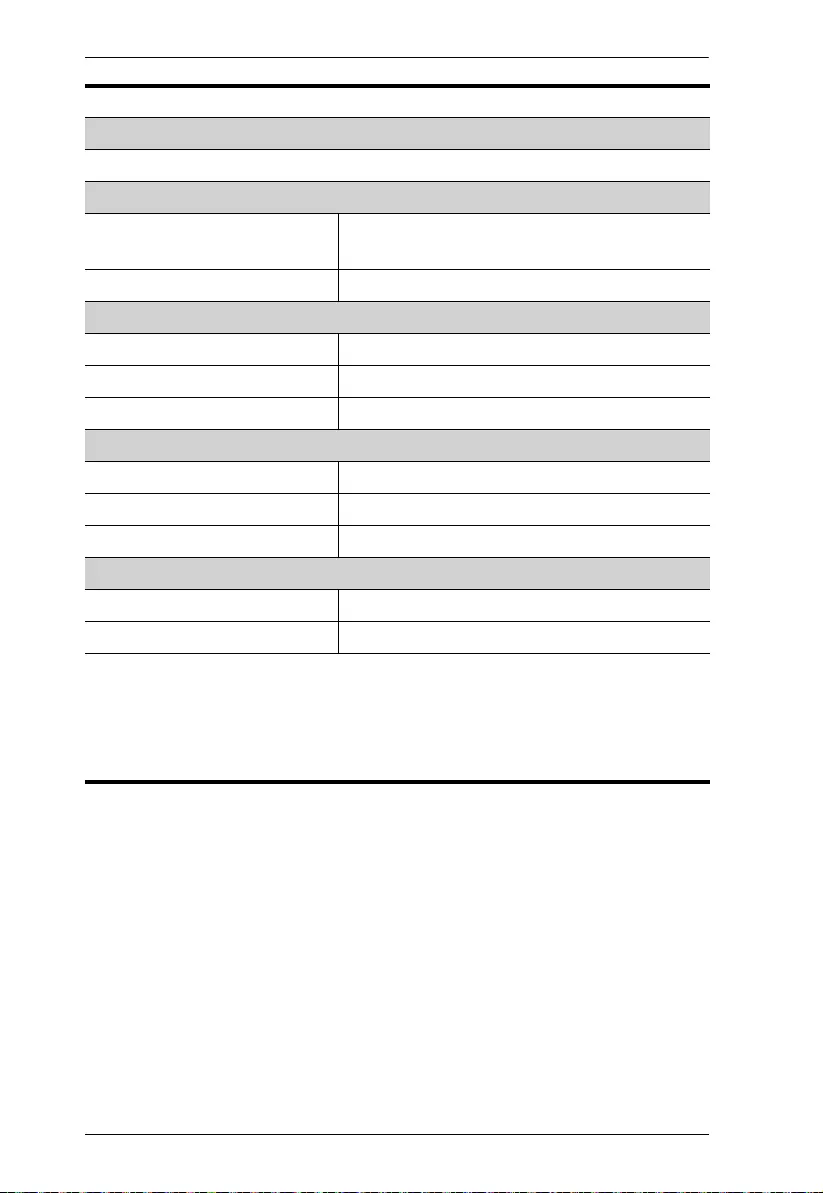
ATEN Control System User Manual
296
1 x IR Receiver LED
Reset Button
1 x Semi-recessed pushbutton
Power
Power Consumption AC 110 V : 4.7 W : 81 BTU
AC 220 V : 4.5 W : 81 BTU
Maximum Input Power Rating internal power: 100 - 240 V AC, 50 - 60 Hz
Environmental
Operating Temperature 0 – 50 ºC
Storage Temperature -20 – 60 ºC
Humidity 0 – 80% RH, Non-condensing
Physical Properties
Housing Metal
Weight 1.23 kg
Dimensions (L x W x H) 20.00 x 16.41 x 4.40 cm
Mobile Control License
No, of free licenses 2
Max. no. of licenses 32
Note: The ATEN Control Box comes with two free licenses which are stored
in the device itself. Each time a mobile device connects to an ATEN
Control Box for remote control, one license on the Control Box will be
occupied. To purchase and add additional licenses to your Control Box,
contact your local sales representative for more information.
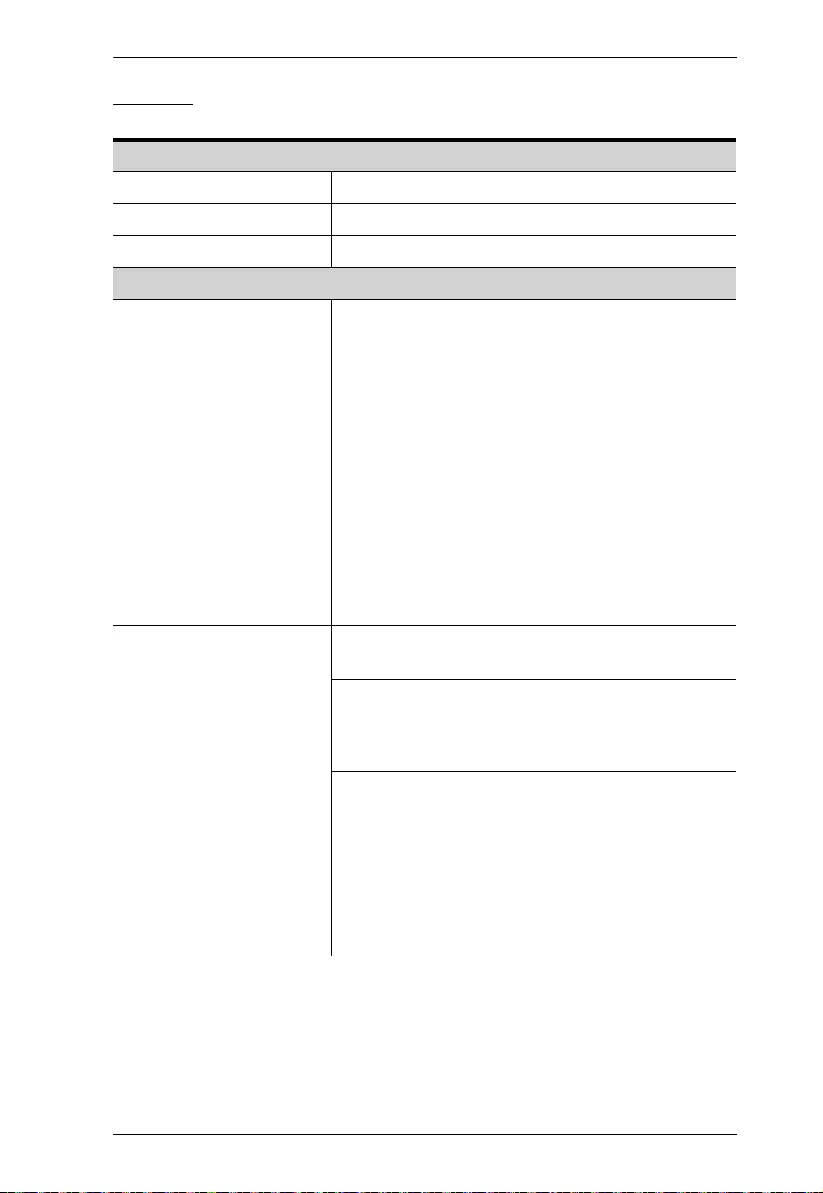
Appendix
297
VK2200
System
CPU Quad-core Processor
SD RAM 2 GB
Flash Memory 8 GB
Interface
Serial 2 x Bidirectional RS-232/422/485 Ports
(2 x 5-Pole Terminal Block Connectors)
6 x Programmable Bidirectional RS-232 Ports
(6 x 3-Pole Terminal Block Connector)
Baud Rate: 300 ~ 115200 (default: 9600)
Data Bit: 8 (default) or 7
Stop Bit: 1 (default) or 2
Parity: None (default), Even or Odd
Flow Control: None (default) RTS/CTS
(for 5-pole terminal block)
IR/Serial 8 x Programmable IR / Unidirectional RS-232
Ports (4 x 4-Pole Terminal Block Connectors)
IR:
Carrier Frequency: 10 ~ 455 kHz
Signal Level: TTL (0 ~ 5 V DC)
Serial:
Baud Rate: 300 ~ 1150 (default: 9600)
Data Bit: 8 (default) or 7
Stop Bit: 1 (default) or 2
Parity: None (default), Even, or Odd
Signal Level: TTL (0 ~ 5 V DC)
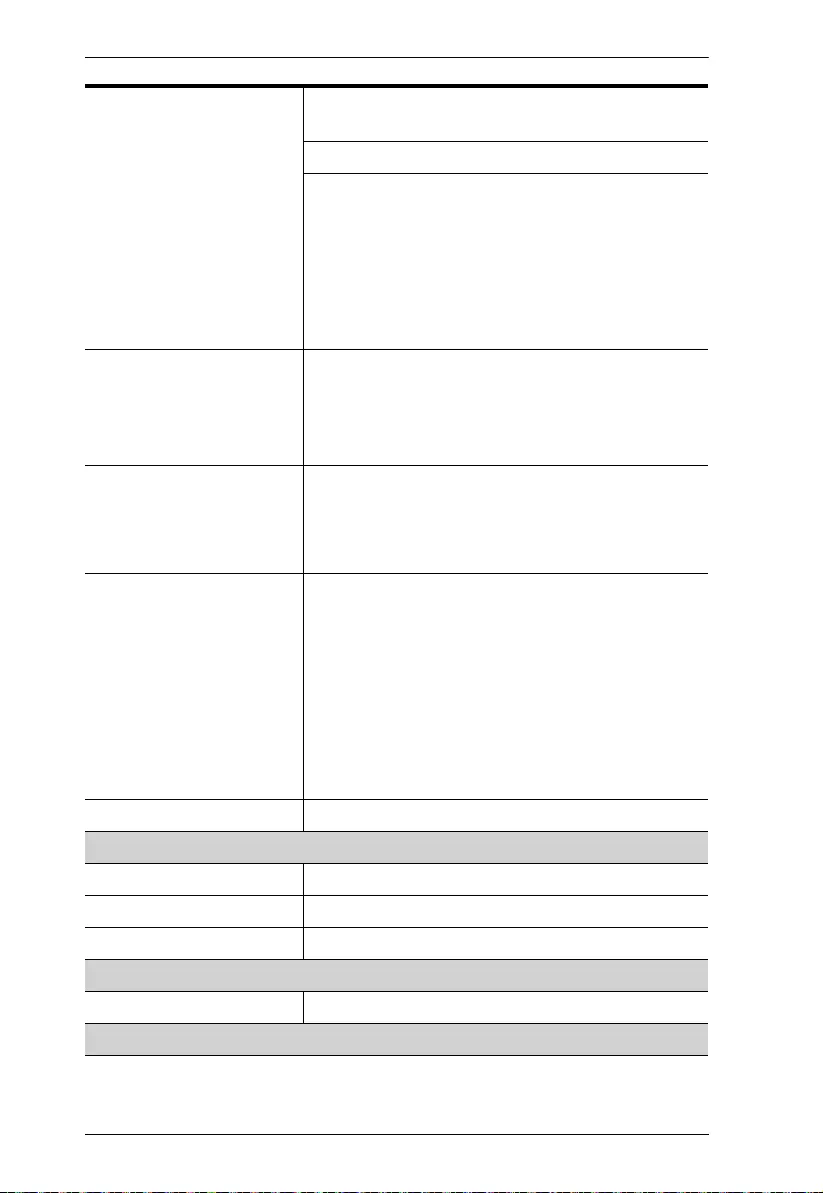
ATEN Control System User Manual
298
I/O 8 x Programmable Digital Input / Output
Channels (2 x 5-Pole Terminal Block Connectors)
Digital Output: 300 mA sink from 24 V DC
Digital Input:
VDC Mode
Input Voltage Range: 0 ~ 24 V DC
Programmable Range: 1 ~ 24 V DC
Dry Contact Mode
Pull-up 2 kΩ to +12 V DC
Relay
8 x Relay Channels (4 x 4-Pole Terminal
Block Connector)
Normally Open, Isolated Relays
Contact Rating: Max 24 V DC, 2 A
V DC
4 x 12 V DC Output Ports (2 x 4-Pole Terminal
Block Connectors)
Power Supply: 12 V DC, 2 A Max (Shared By
4 Ports)
Ethernet
2 x RJ-45 Female, 10/100/1000 Base-T
Supported protocol: ARP, ICMP, TCP/IP,
DHCP, HTTPS, SSH
DHCP-enabled. Default IP settings (IP
address 192.168.0.60 / 192.168.1.60 for
Control LAN / LAN, subnet mask
255.255.255.0) will be automatically applied if
no IP address is assigned within 30 seconds
of connecting to the network.
USB 1 x USB Type-A
LCD Panel
Size 1.6”
LCM Display 64 x 128 resolution
LCM Setting 3 x Pushbuttons (Up, Down, Enter)
Switches
Power 1 x on/off switch
IR Learning
1 x IR Receiver LED
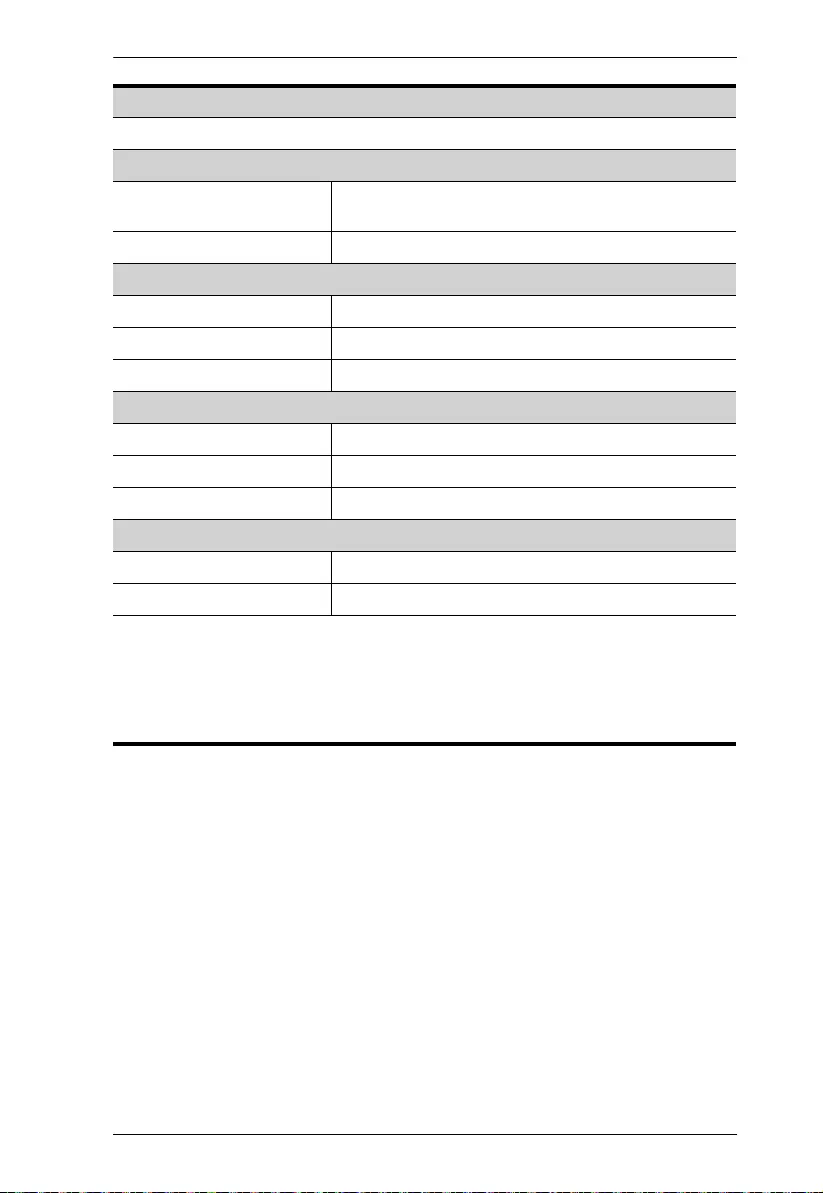
Appendix
299
Reset Button
1 x Semi-recessed pushbutton
Power
Power Consumption AC 110 V : 5.7 W : 139 BTU
AC 220 V : 6.8 W : 144 BTU
Max. Input Power Rating Internal power: 100 - 240 V AC, 50 - 60 Hz
Environmental
Operating Temperature 0 – 50 ºC
Storage Temperature -20 – 60 ºC
Humidity 0 – 80% RH, Non-condensing
Physical Properties
Housing Metal
Weight 2.62 kg
Dimensions (L x W x H) 43.24 x 16.32 x 4.40 cm
Mobile Control License
No, of free licenses 2
Max. no. of licenses 32
Note: The ATEN Control Box comes with two free licenses which are stored
in the device itself. Each time a mobile device connects to an ATEN
Control Box for remote control, one license on the Control Box will be
occupied. To purchase and add additional licenses to your ATEN
Control Box, contact your local sales representative for more information.
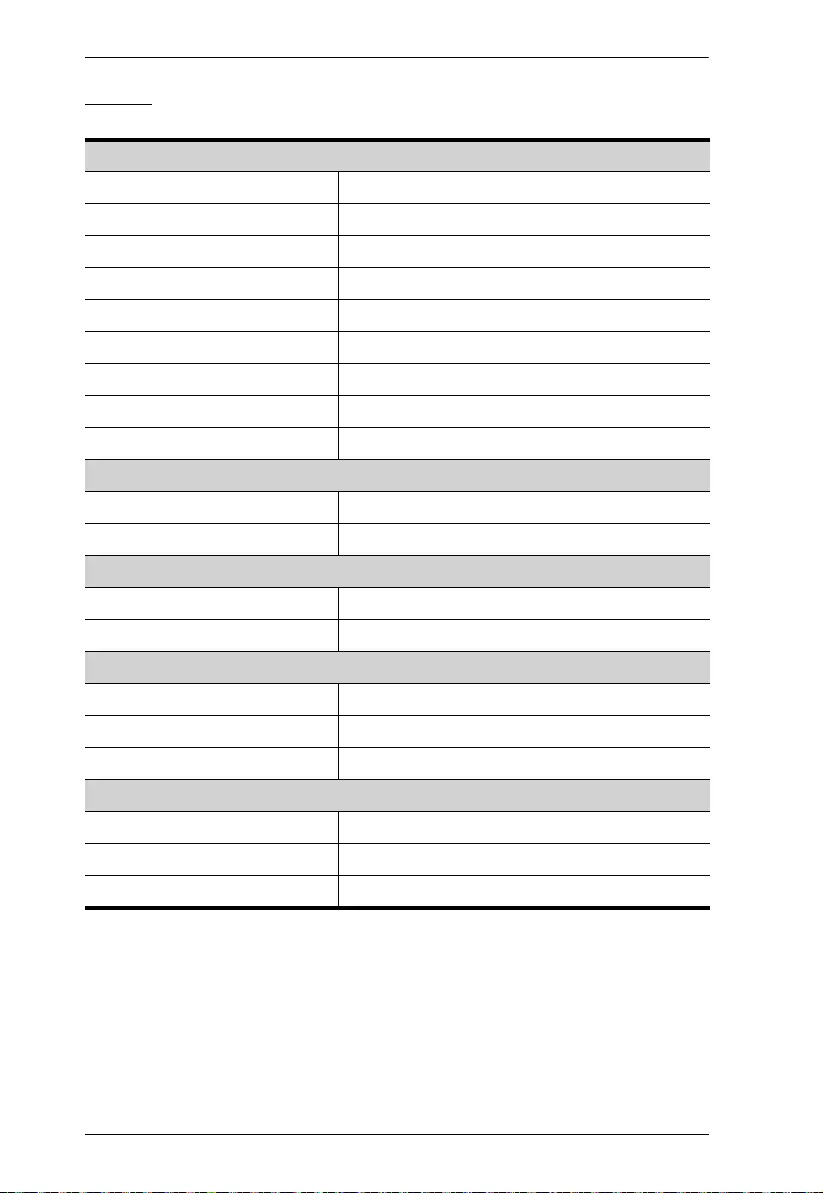
ATEN Control System User Manual
300
VK330
Panel Specifications
Display Type TFT-LCD
Size 10.1”
Touch Screen Capacitive
Resolution 1280 x 800
Aspect Ratio 16:9
Color Depth 8 bit
Contrast Ratio 800:1
Backlight LED
Viewing Angle ±85º (H), ±85º (V)
Interfaces
Ethernet 1 x 4J-45 Female, 10/100/1000 BaseT
USB 1 x USB Type-A
Power
Power over Ethernet (PoE) 802.3 af PoE / 802.3 at PoE+
Power Consumption DC48V:W
Environmental
Operating Temperature 0–40ºC
Storage Temperature -10–55ºC
Humidity 10–80% RH, Non-condensing
Physical Properties
Housing ABS + PC
Weight 0.62 kg (1.37 lb)
Dimensions (L x W x H) 25.22 x 17.78 x 2.45 cm (9.93 x 7 x 0.96 in.)
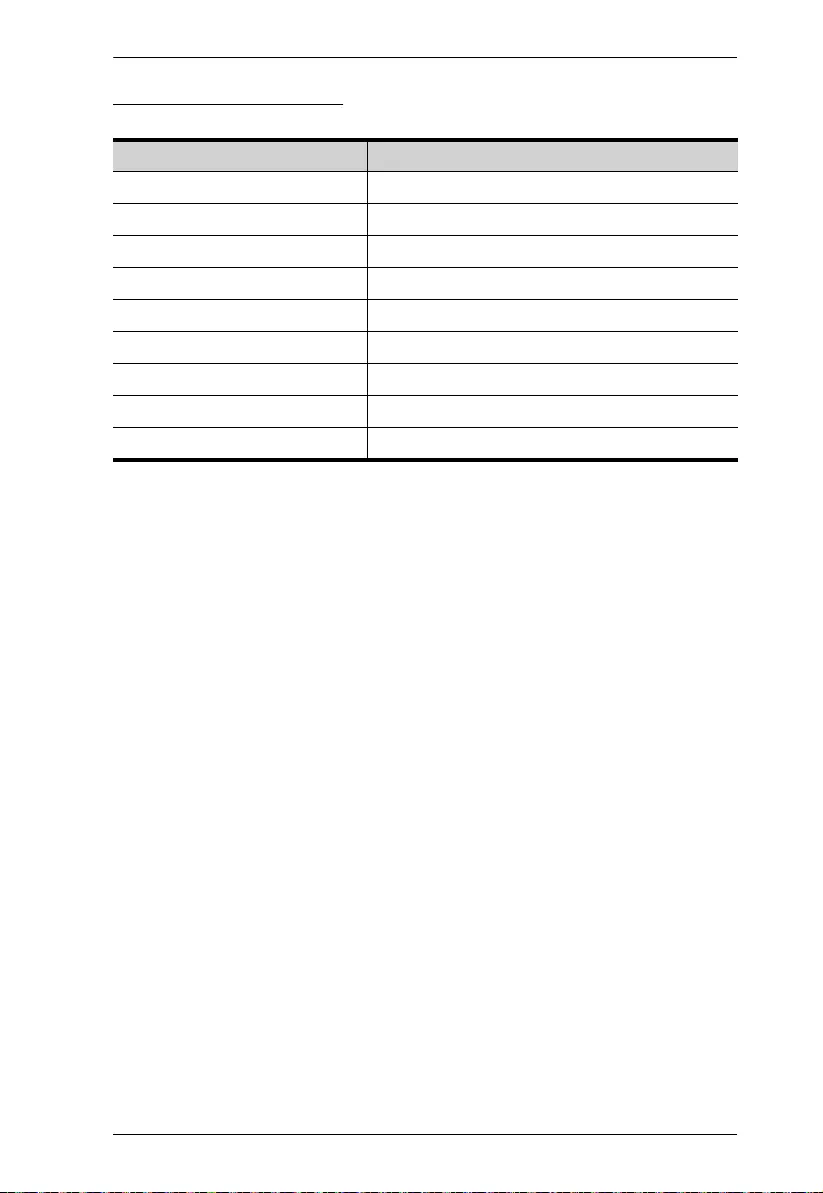
Appendix
301
Project Specifications
Project Elements Maximum Number
Rooms 16
Viewers 32
Macros 1024
Variables 1024
monitoring event 20
scheduling event 60
Viewer pages 160 per Viewer
control objects 320 per page
commands 128 per button
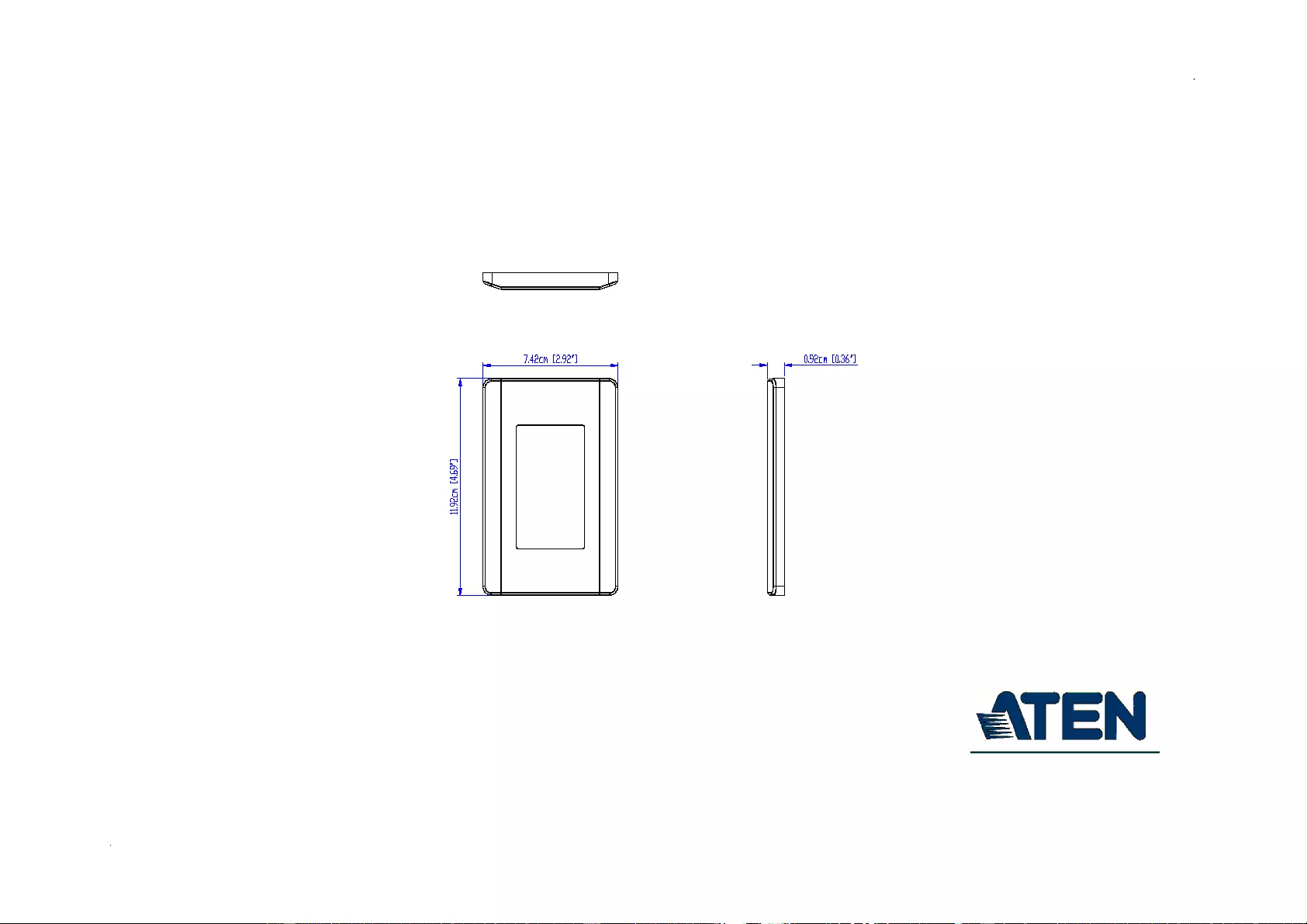
VK0100
CAD Drawings
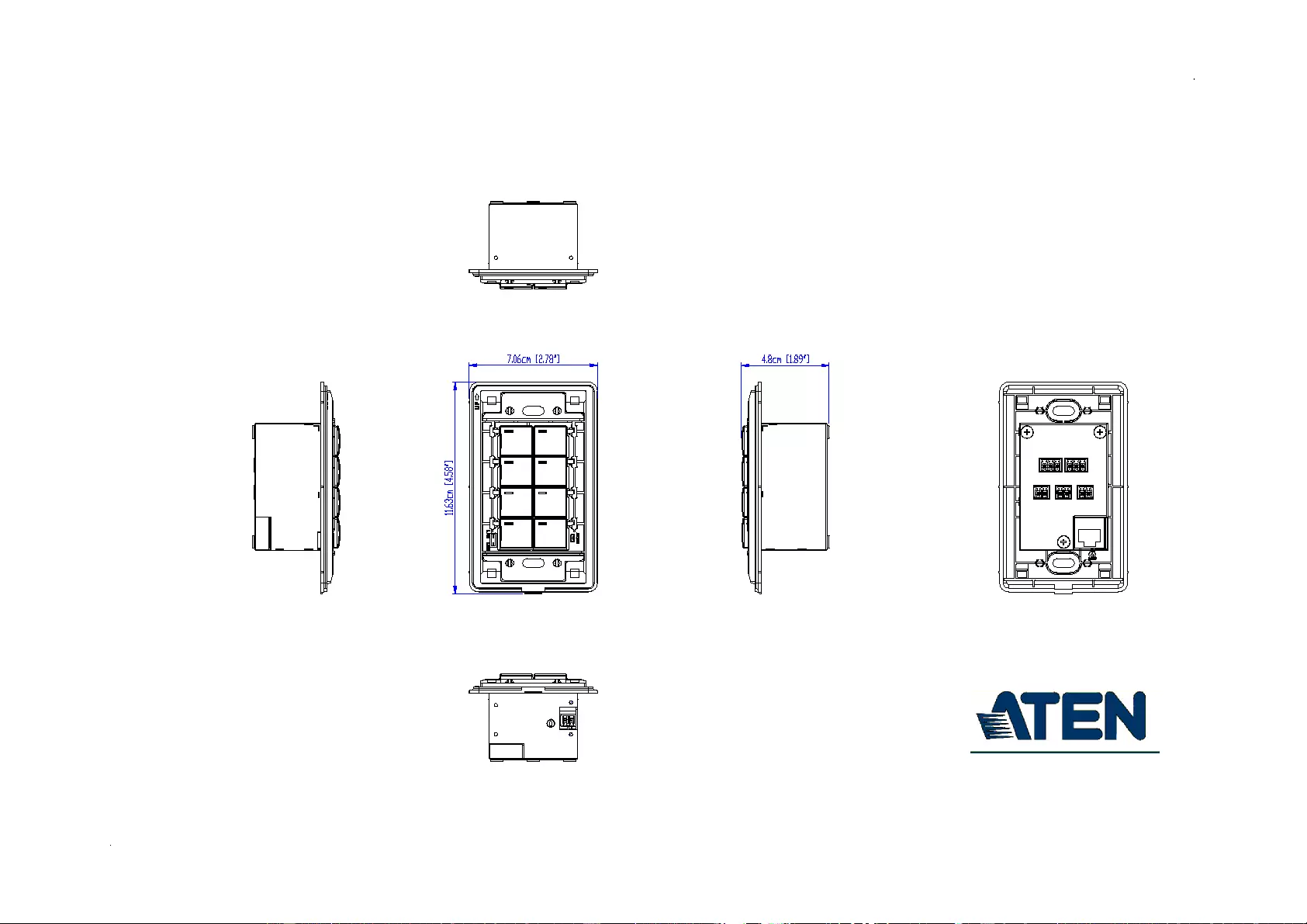
VK0100
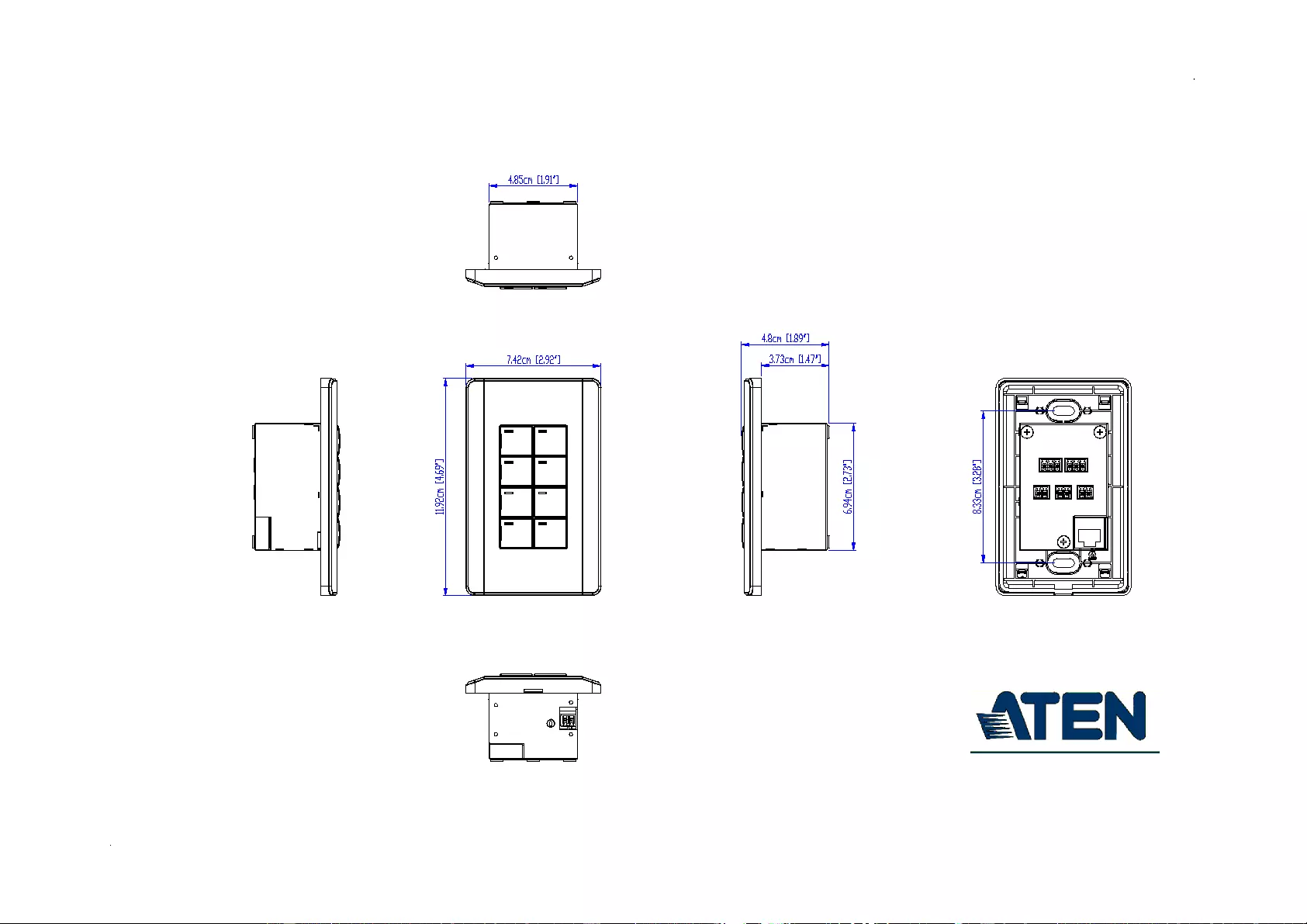
VK0100
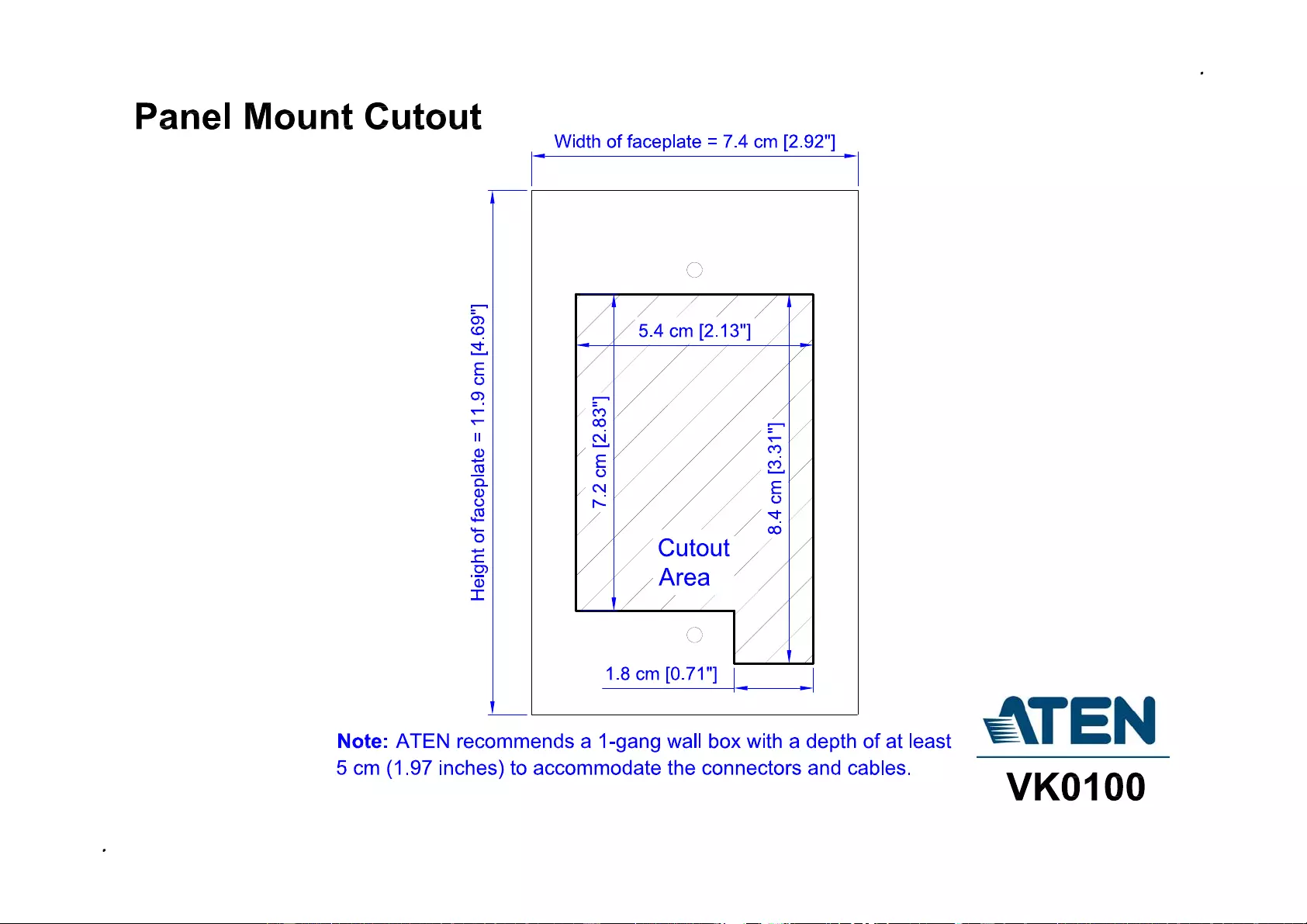
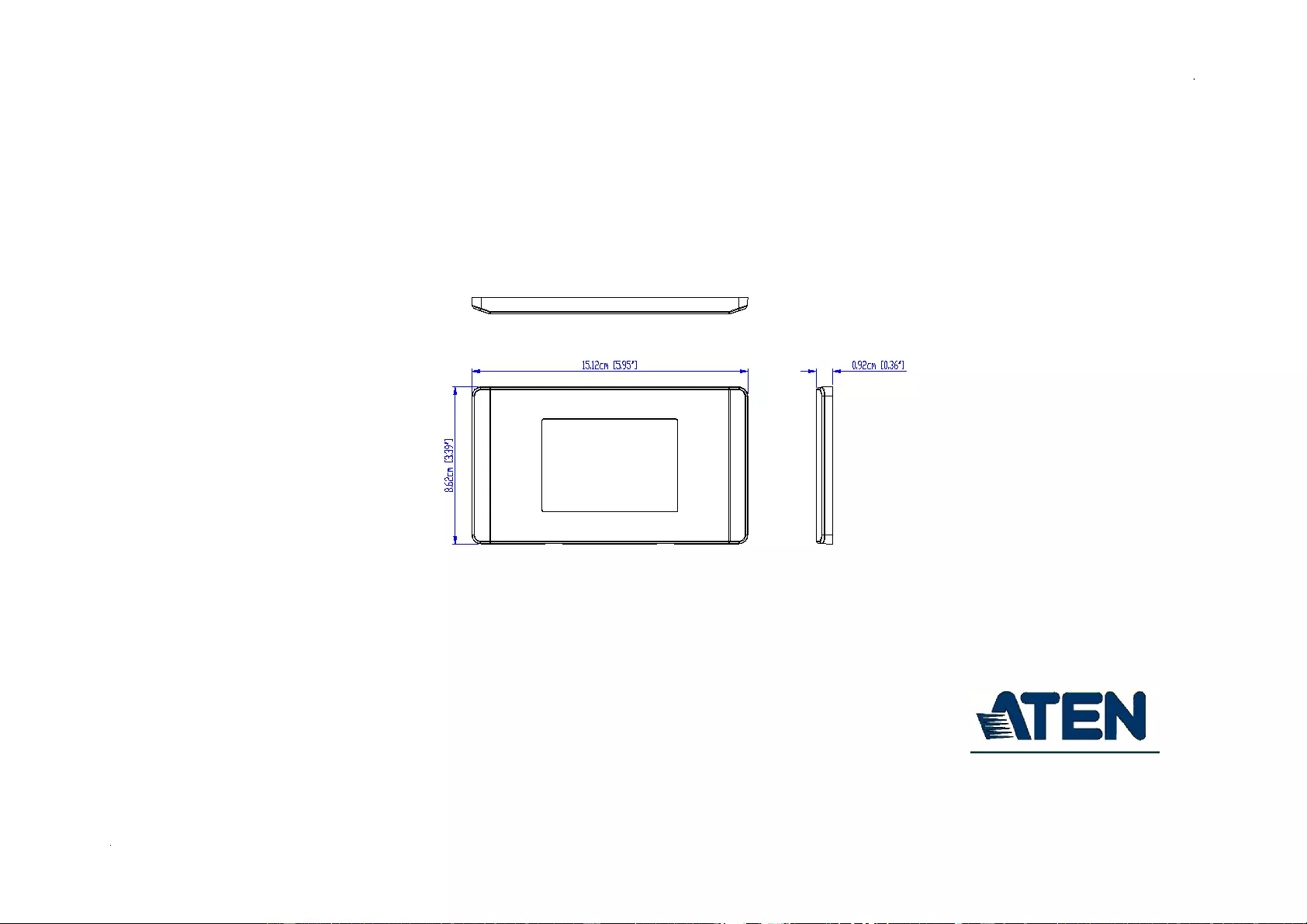
VK0200
CAD Drawings
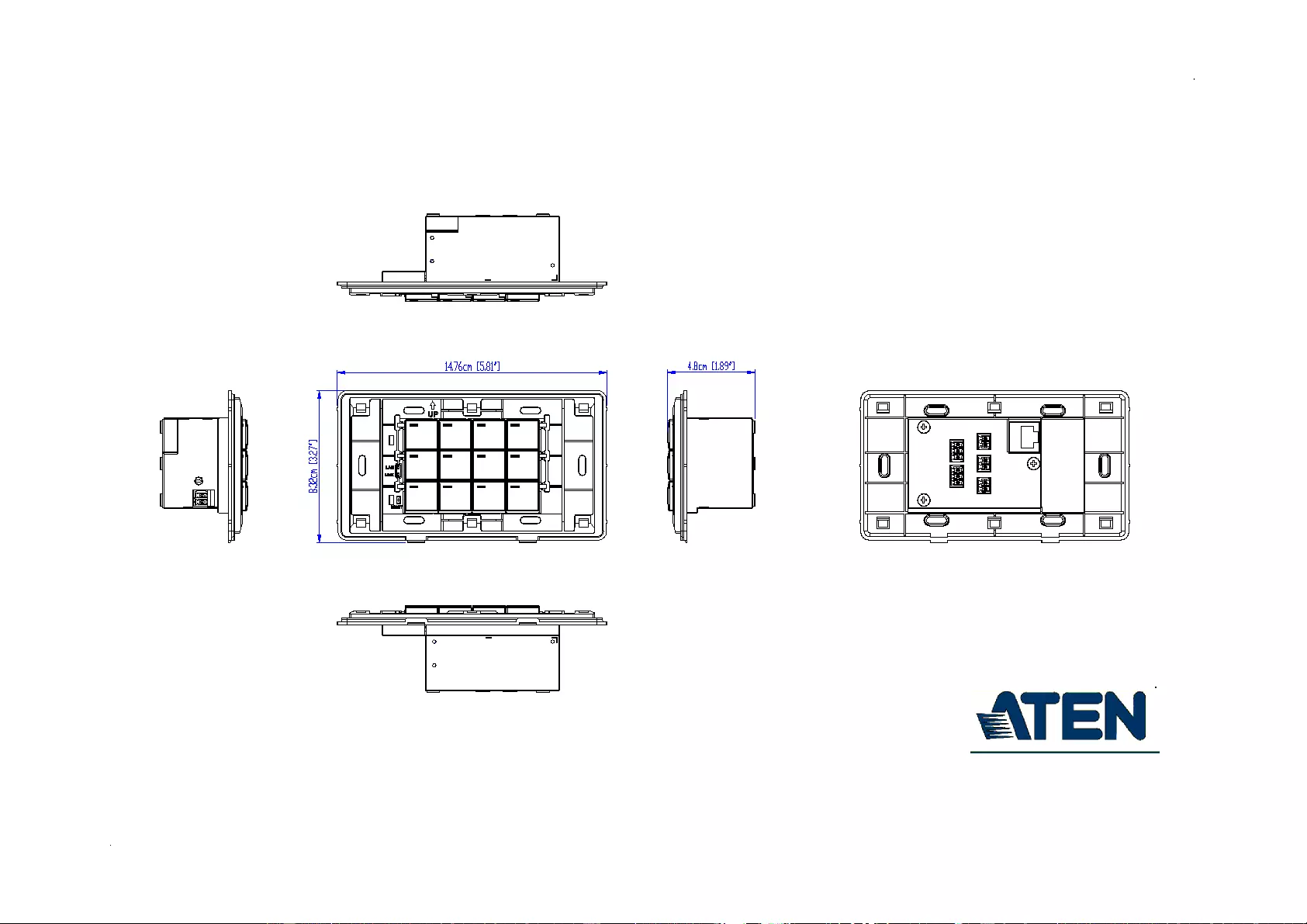
VK0200
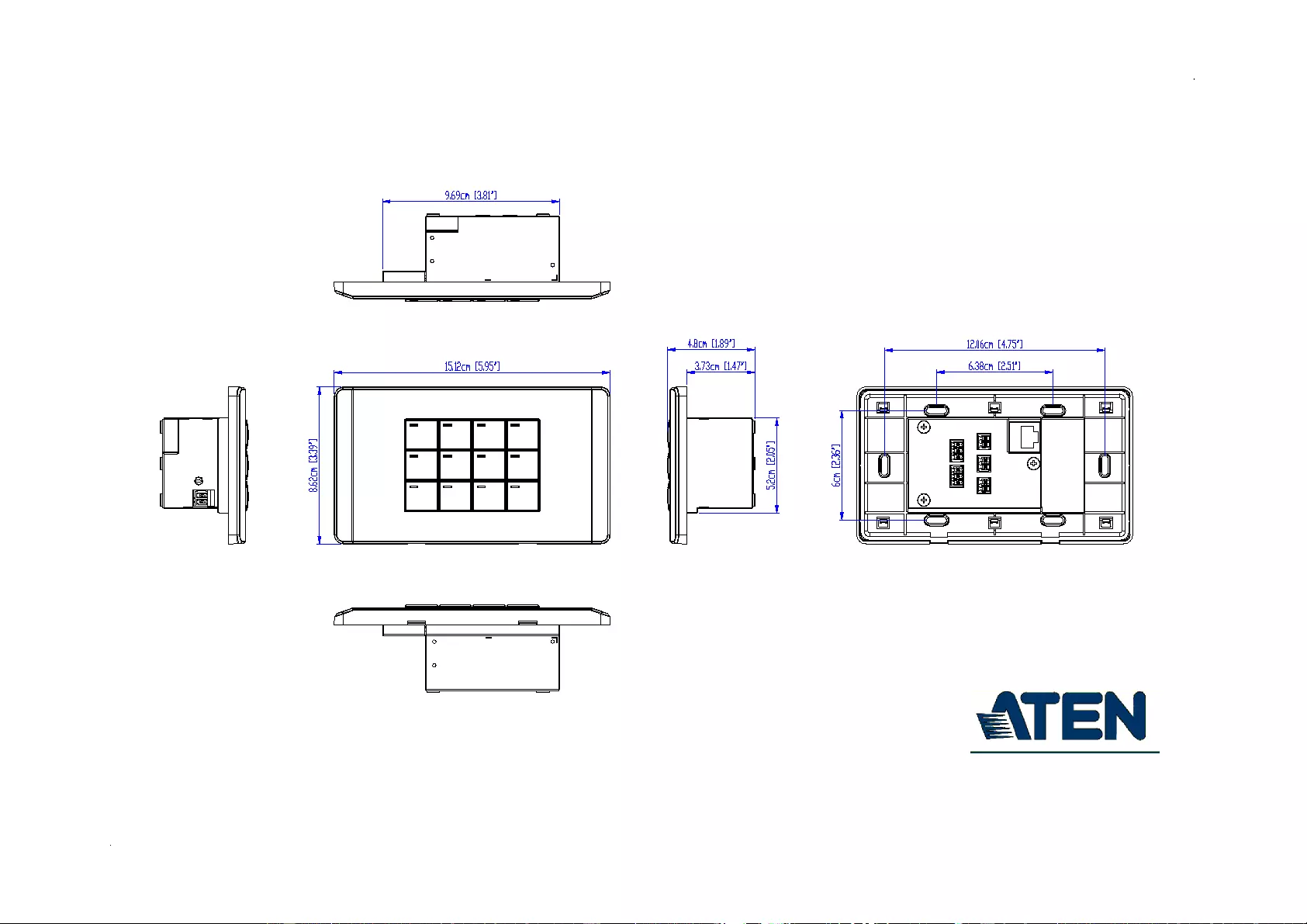
VK0200
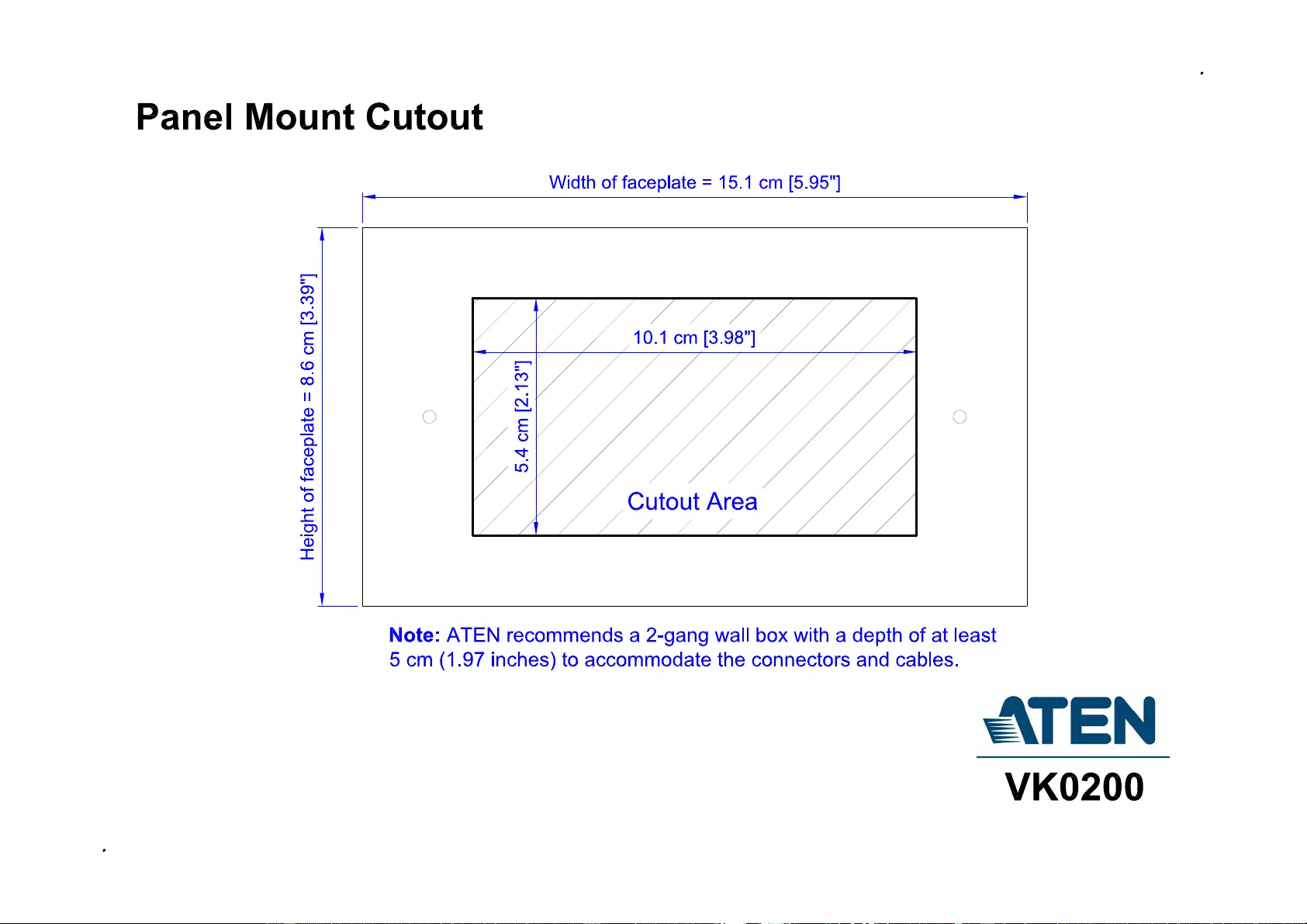
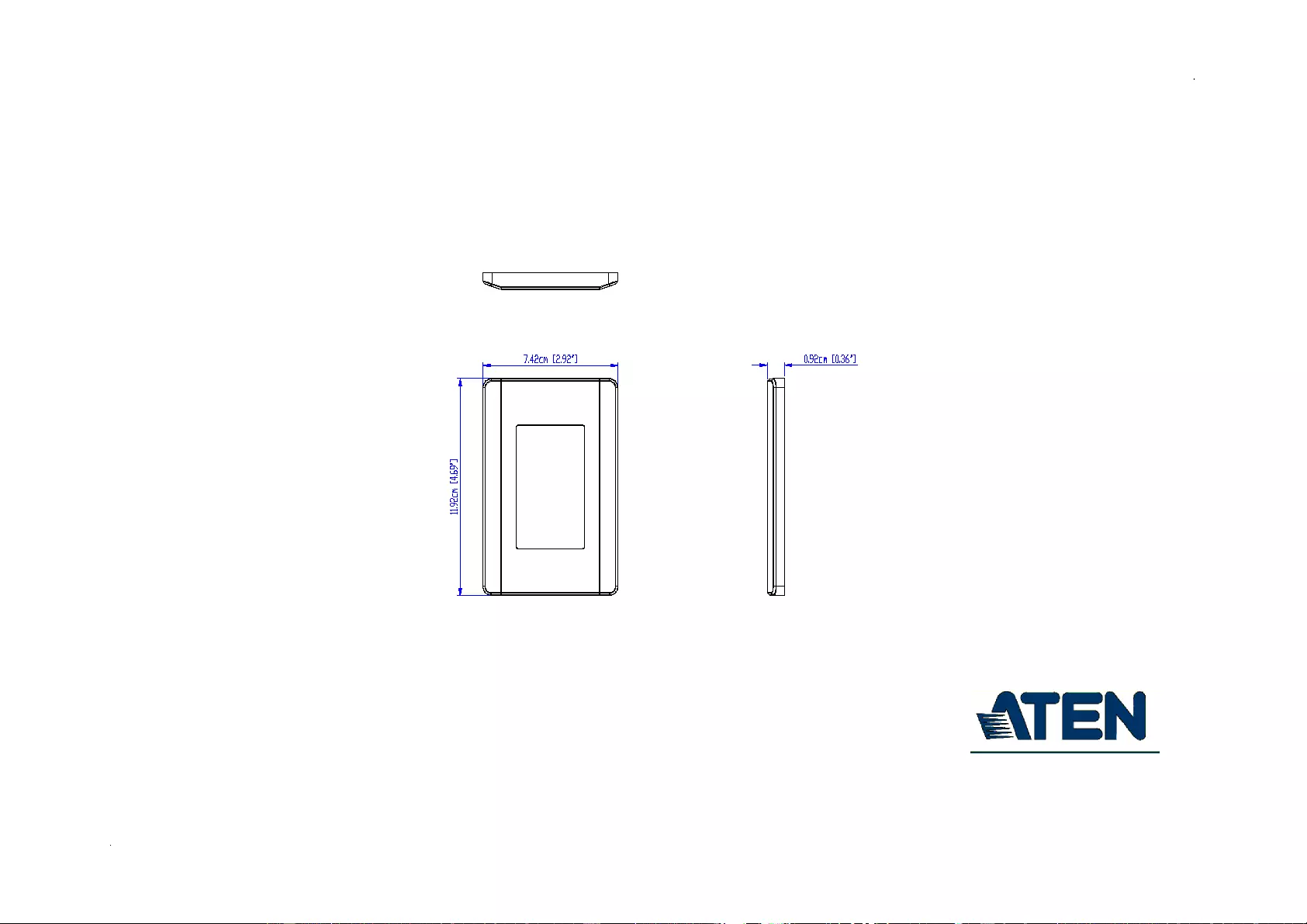
VK108US
CAD Drawings
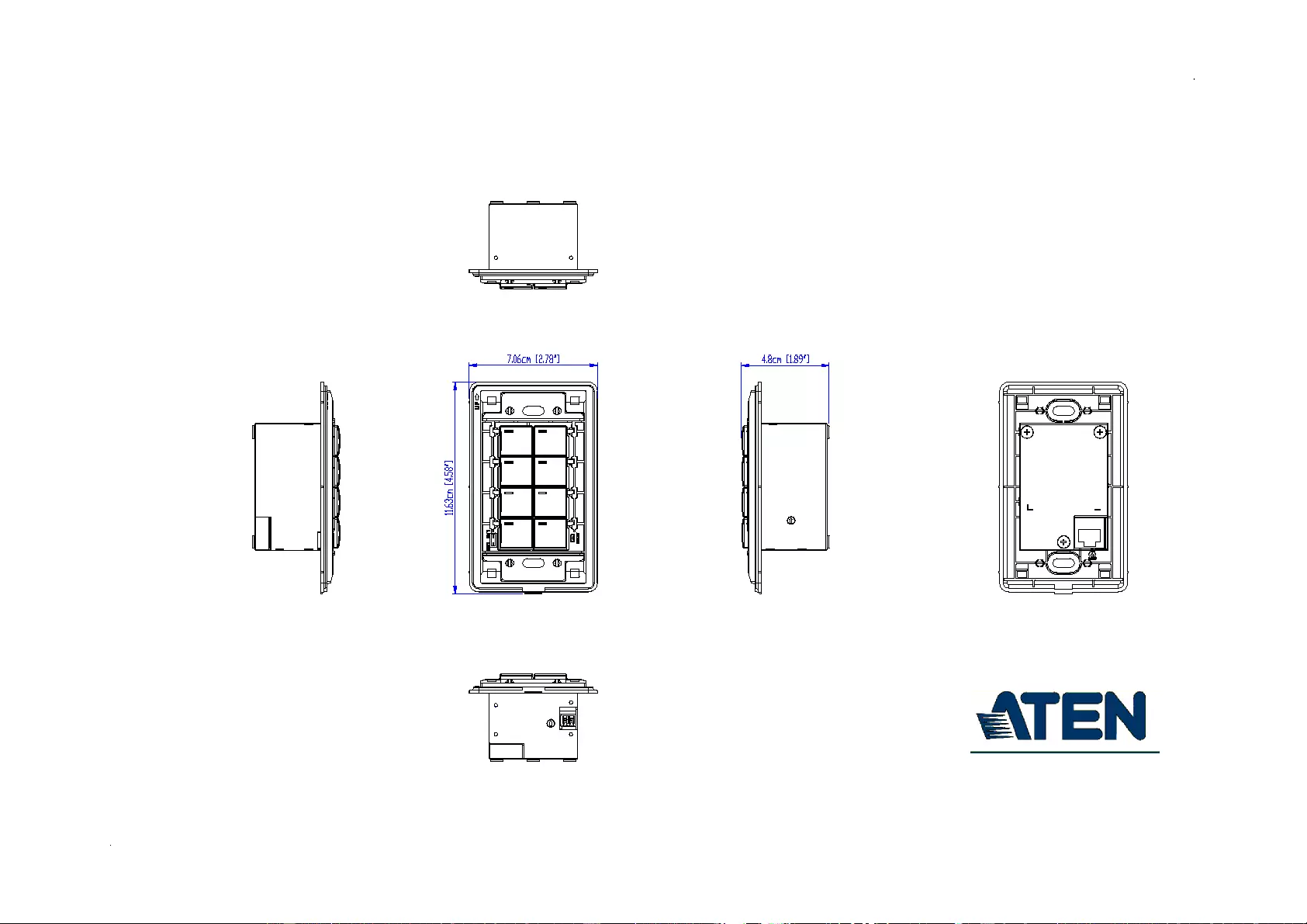
VK108US
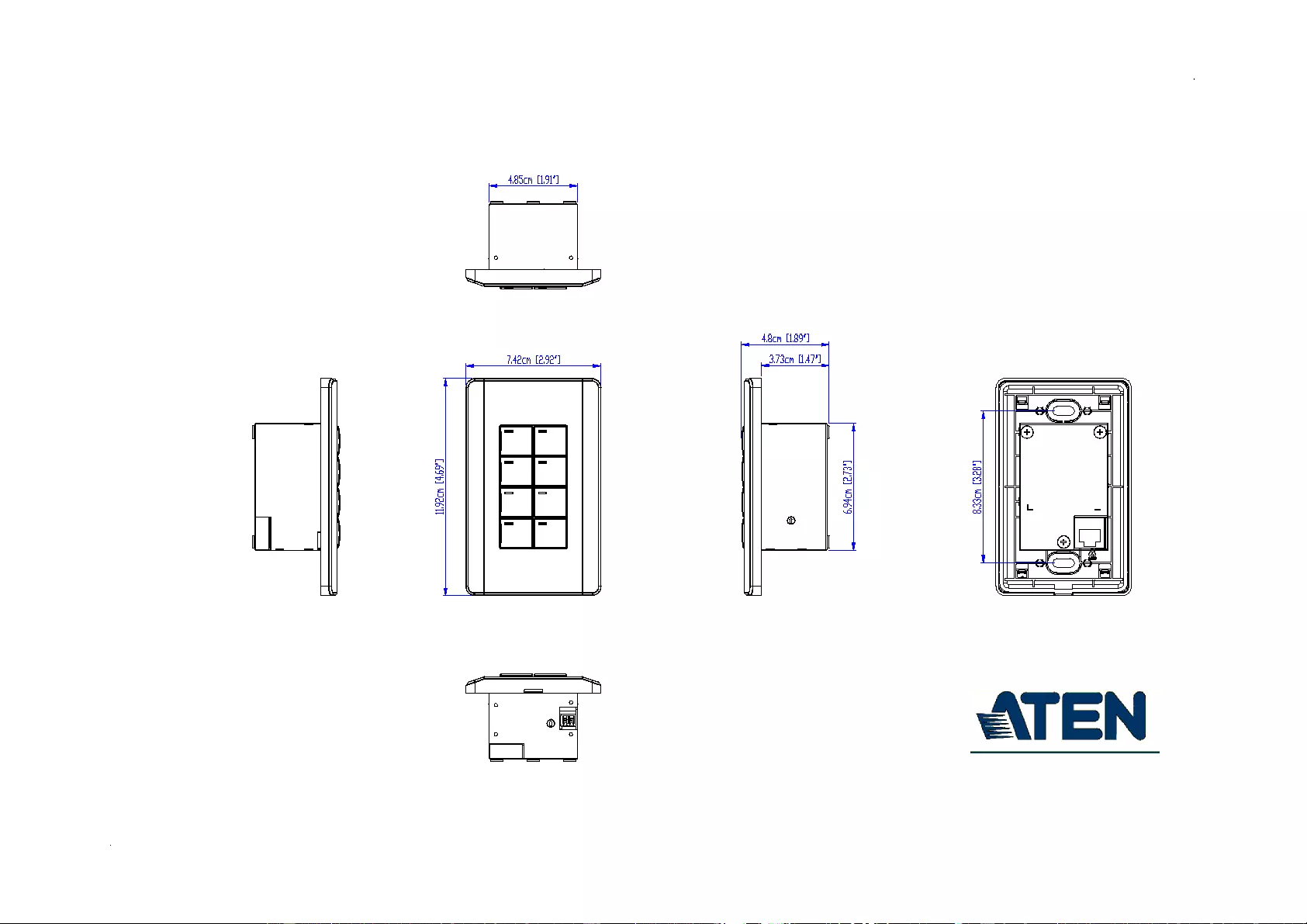
VK108US
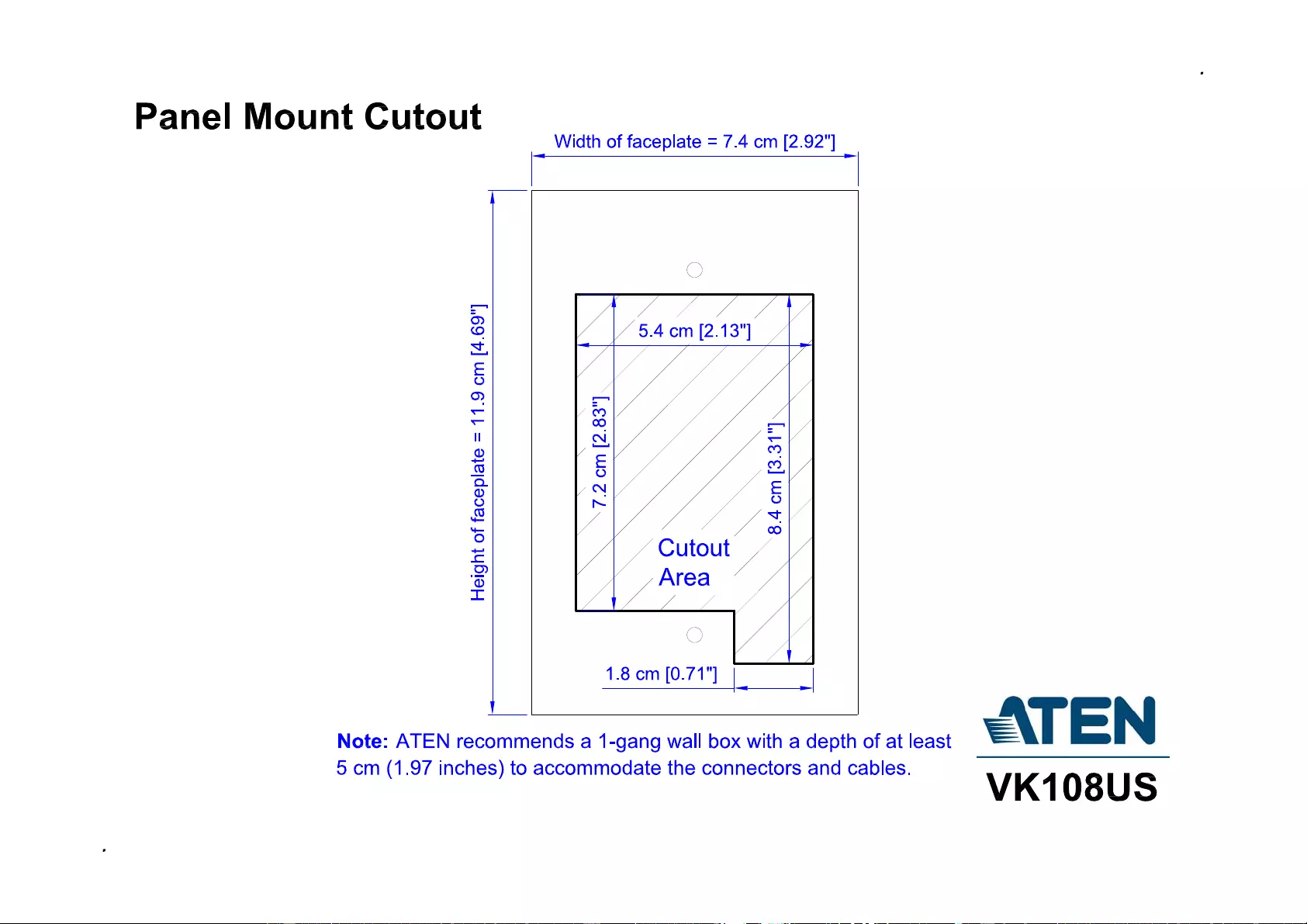
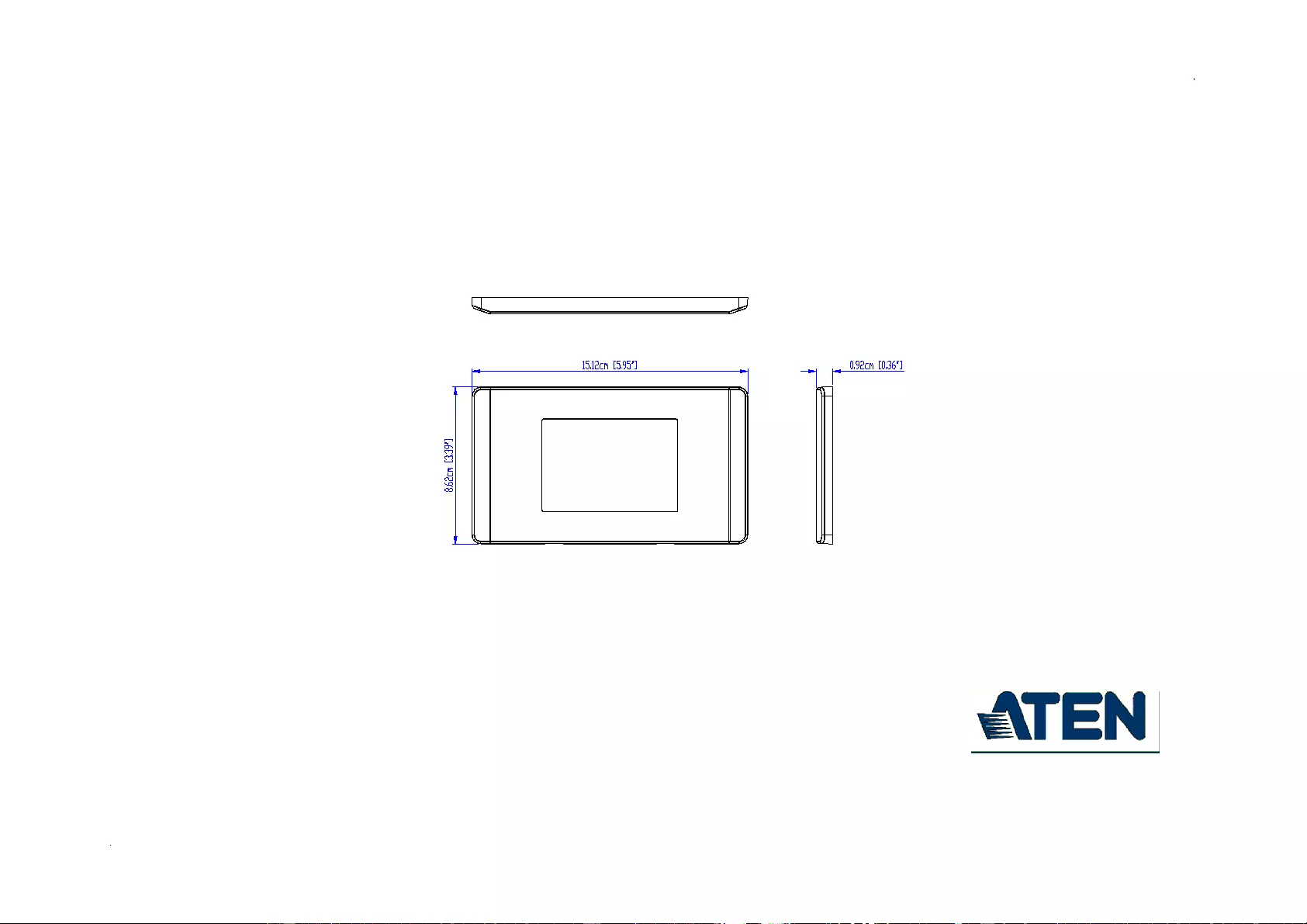
VK112EU
CAD Drawings
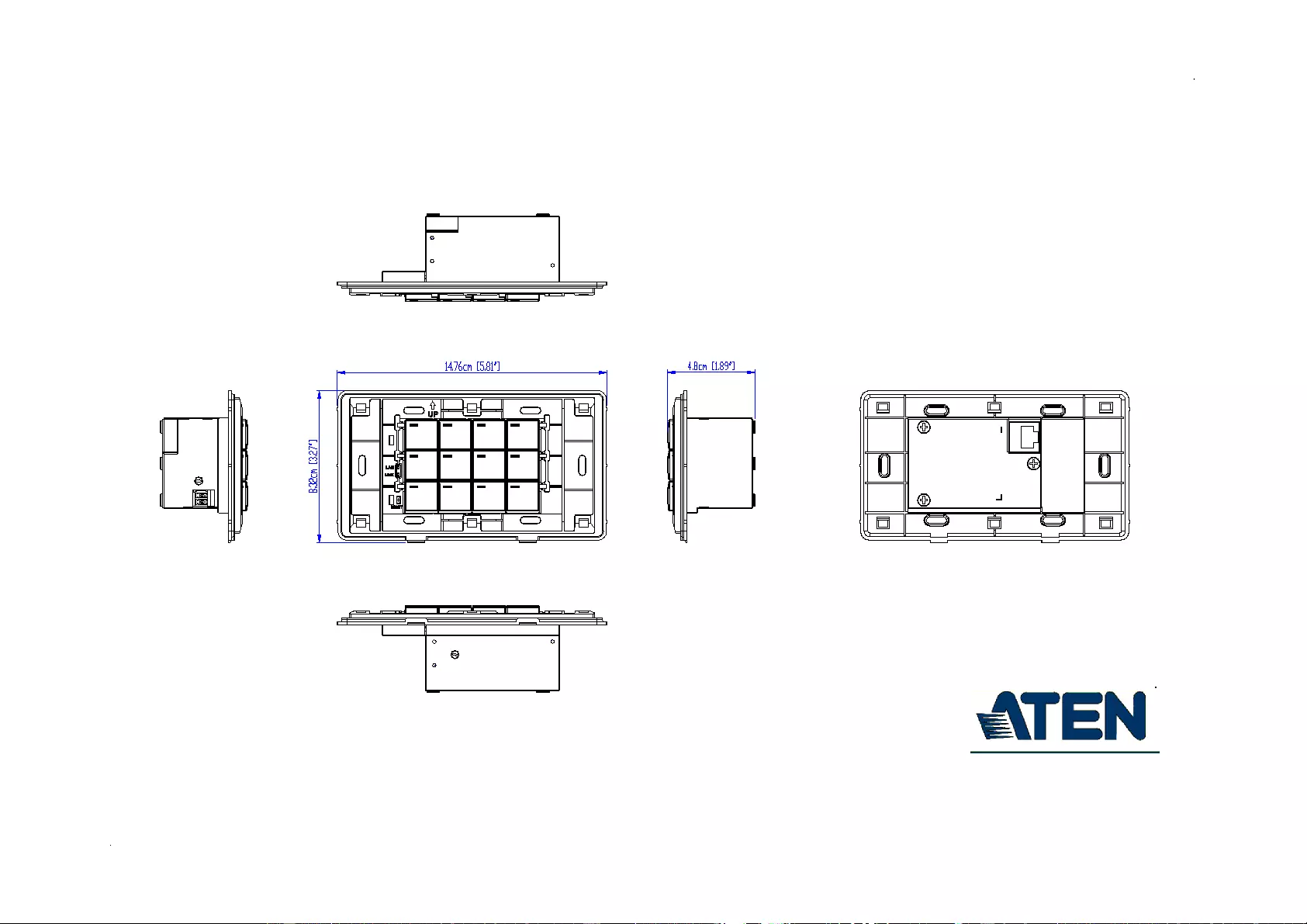
VK112EU
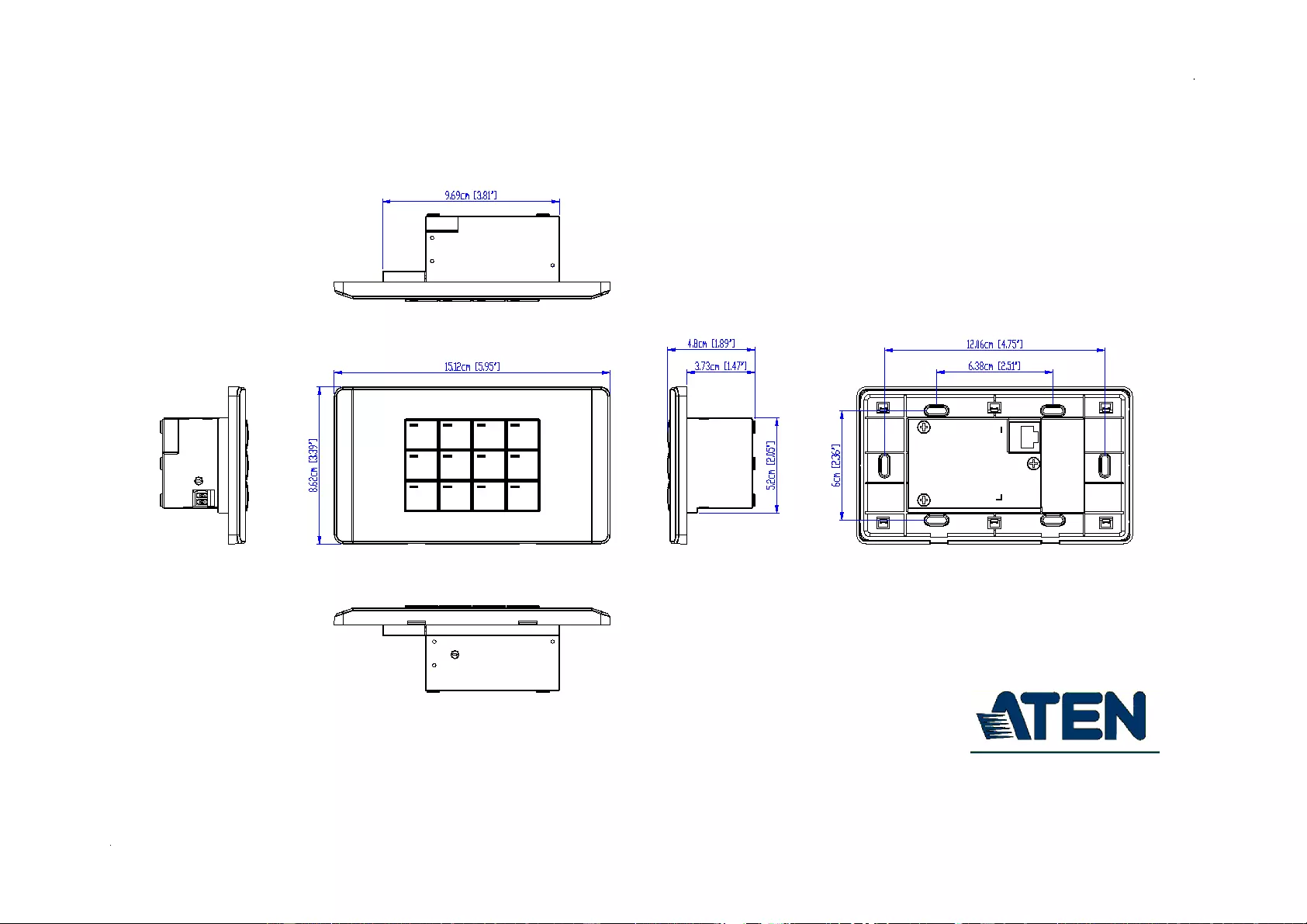
VK112EU
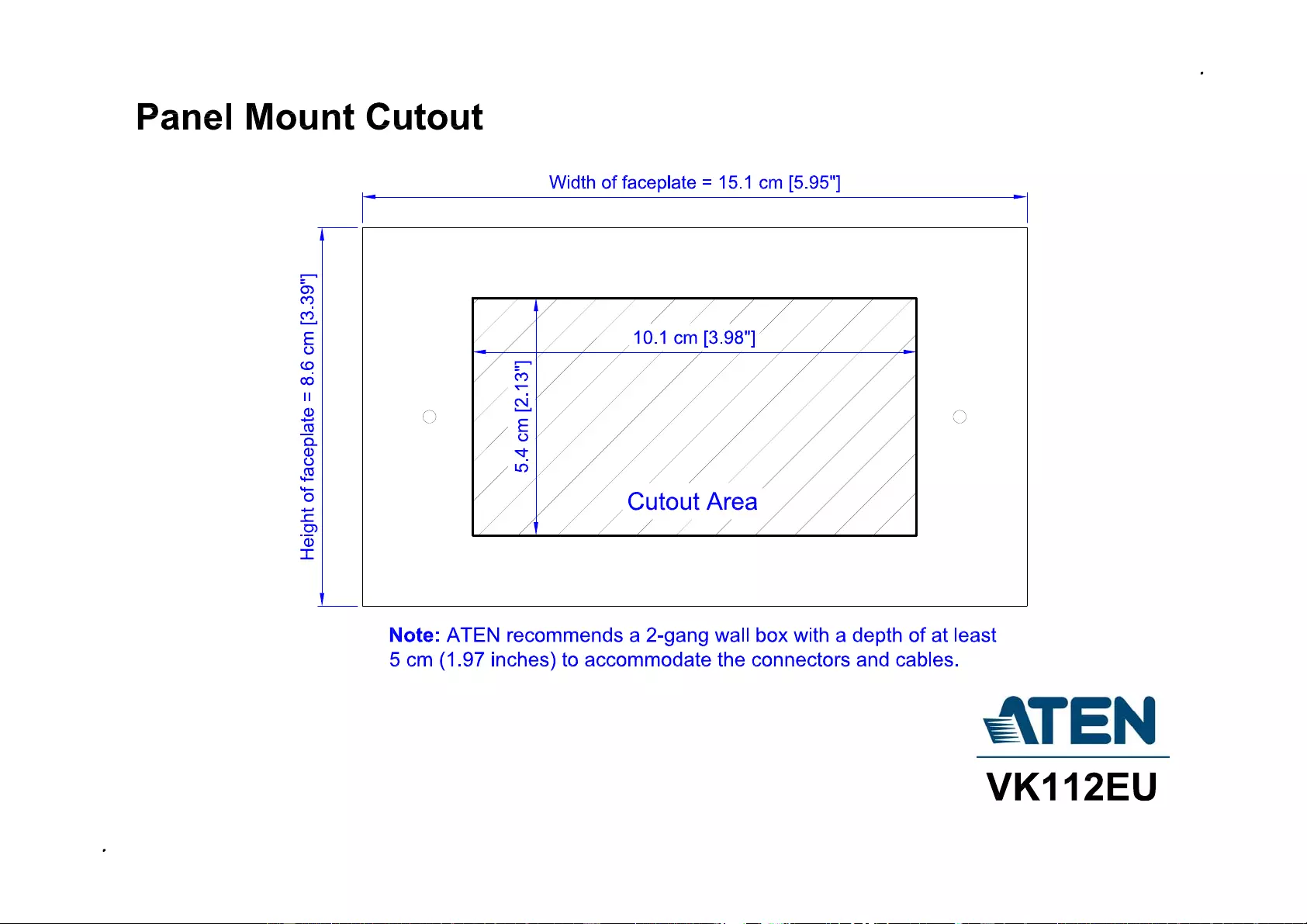
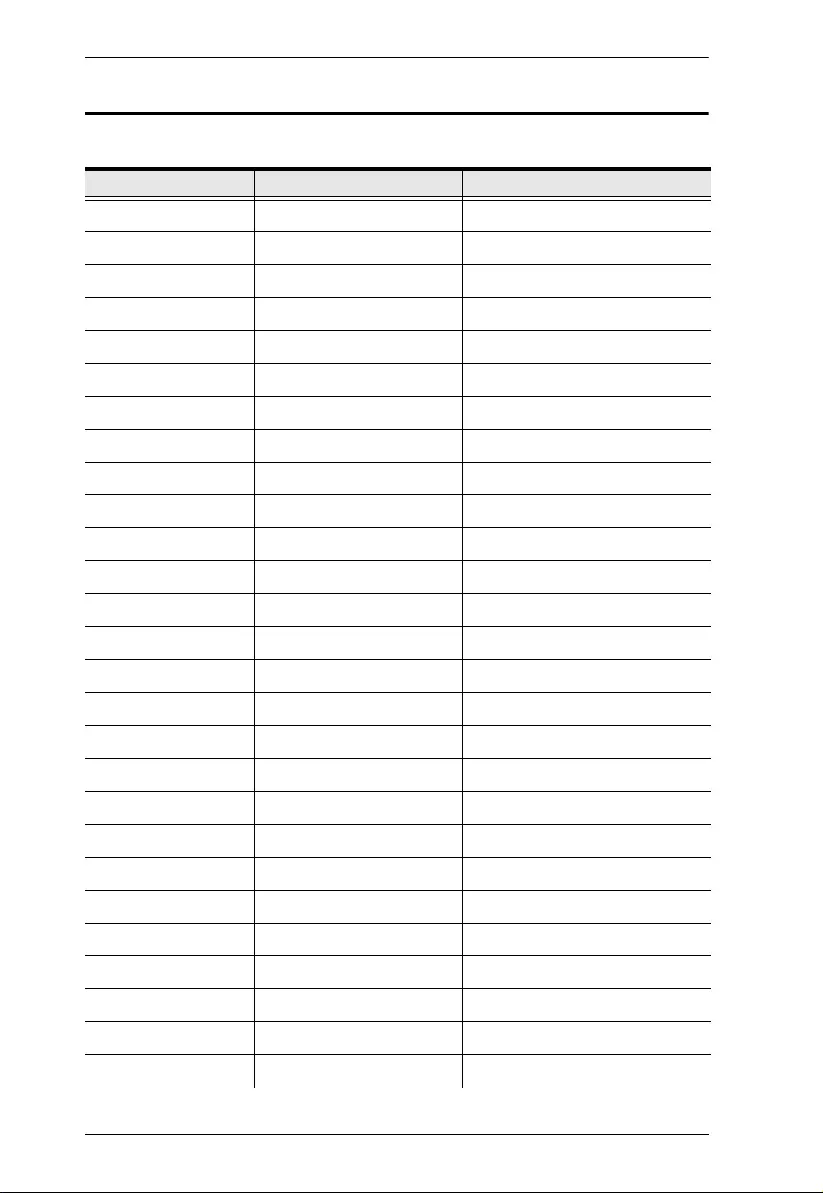
ATEN Control System User Manual
318
Datapoint Types
ATEN Control System supports the following KNX Datapoint Types (DPT):
DPT ID DPT Format DPT Name
1.001 B
1
DPT_Switch
1.002 B
1
DPT_Bool
1.003 B
1
DPT_Enable
1.004 B
1
DPT_Ramp
1.005 B
1
DPT_Alarm
1.006 B
1
DPT_BinaryValue
1.007 B
1
DPT_Step
1.008 B
1
DPT_UpDown
1.009 B
1
DPT_OpenClose
1.010 B
1
DPT_Start
1.011 B
1
DPT_State
1.012 B
1
DPT_Invert
1.013 B
1
DPT_DimSendStyle
1.014 B
1
DPT_InputSource
1.015 B
1
DPT_Reset
1.016 B
1
DPT_Ack
1.017 B
1
DPT_Trigger
1.018 B
1
DPT_Occupancy
1.019 B
1
DPT_Window_Door
1.021 B
1
DPT_LogicalFunction
1.022 B
1
DPT_Scene_AB
1.023 B
1
DPT_ShutterBlinds_Mode
1.100 B
1
DPT_Heat/Cool
2.001 B
2
DPT_Switch_Control
2.002 B
2
DPT_Bool_Control
2.003 B
2
DPT_Enable_Control
2.004 B
2
DPT_Ramp_Control

Appendix
319
2.005 B
2
DPT_Alarm_Control
2.006 B
2
DPT_BinaryValue_Control
2.007 B
2
DPT_Step_Control
2.008 B
2
DPT_Direction1_Control
2.009 B
2
DPT_Direction2_Control
2.010 B
2
DPT_Start_Control
2.011 B
2
DPT_State_Control
2.012 B
2
DPT_Invert_Control
3.007 B
1
U
3
DPT_Control_Dimming
3.008 B
1
U
3
DPT_Control_Blinds
4.001 A
8
DPT_ASCII
4.002 A
8
DPT_Char_8859_1
5.001 U
8
DPT_Scaling
5.003 U
8
DPT_Angle
5.004 U
8
DPT_Percent_U8
5.005 U
8
DPT_DecimalFactor
5.006 U
8
DPT_Tariff
5.010 U
8
DPT_Value_1_Ucount
6.001 V
8
DPT_Percent_V8
6.010 V
8
DPT_Value_1_Count
6.020 B
5
N
3
DPT_Status_Mode3
7.013 U
16
DPT_Brightness
8.011 V
16
DPT_Rotation_Angle
9.001 F
16
DPT_Value_Temp
18.001 B
1
R
1
U
6
DPT_SceneControl
20.100 N
8
DPT_FuelType
20.101 N
8
DPT_BurnerType
20.102 N
8
DPT_HVACMode
20.103 N
8
DPT_DHWMode
20.104 N
8
DPT_LoadPriority
DPT ID DPT Format DPT Name
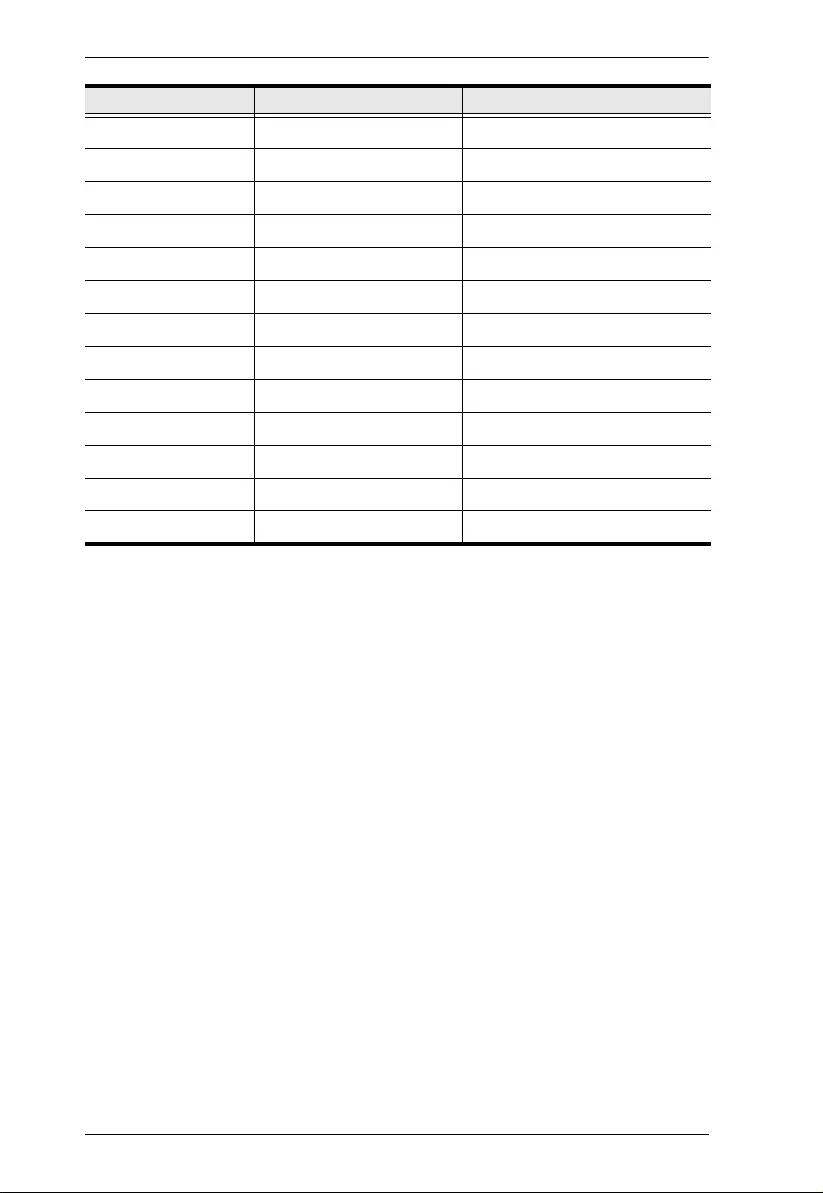
ATEN Control System User Manual
320
20.105 N
8
DPT_HVACContrMode
20.106 N
8
DPT_HVACEmergMode
20.107 N
8
DPT_ChangeoverMode
20.108 N
8
DPT_ValveMode
20.109 N
8
DPT_DamperMode
20.110 N
8
DPT_HeaterMode
20.111 N
8
DPT_FanMode
20.112 N
8
DPT_MasterSlaveMode
20.113 N
8
DPT_StatusRoomSetp
23.001 N
2
DPT_OnOff_Action
23.002 N
2
DPT_Alarm_Reaction
23.003 N
2
DPT_UpDown_Action
23.102 N
2
DPT_HVAC_PB_Action
DPT ID DPT Format DPT Name
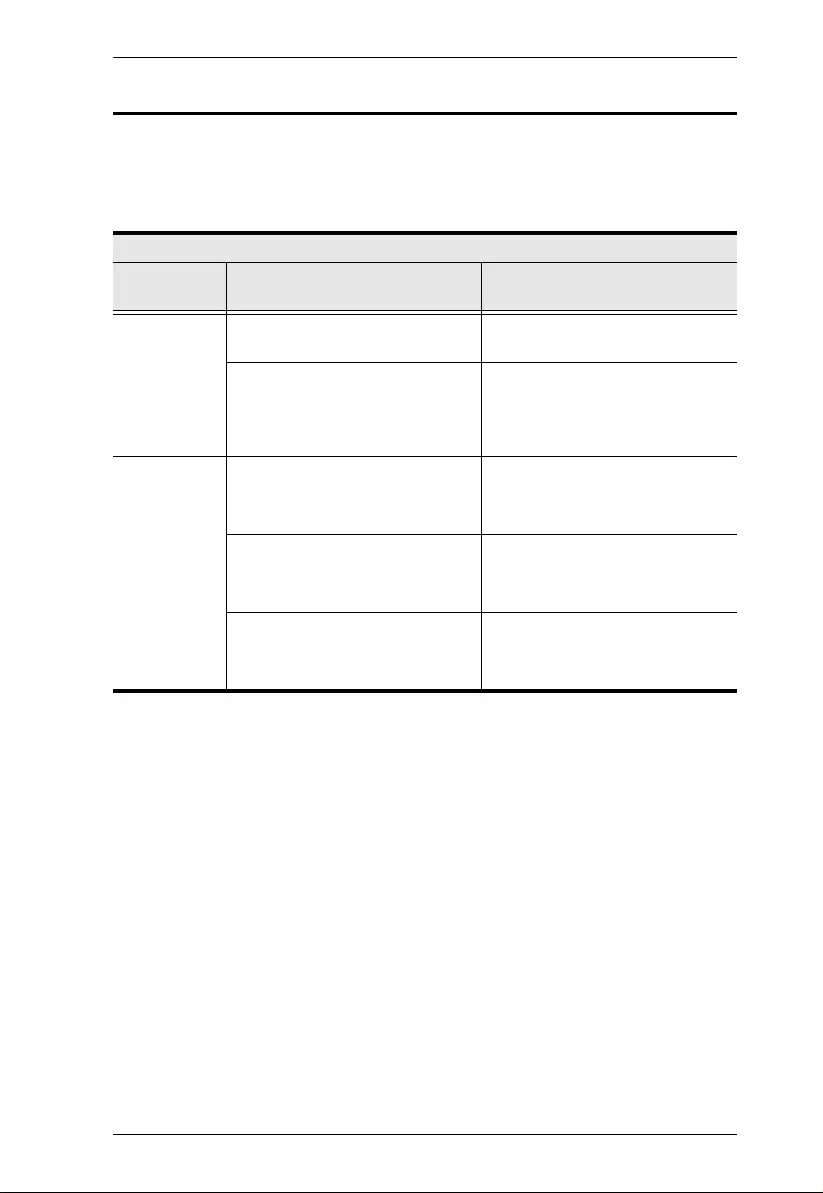
Appendix
321
ATEN Control Box Reset Button
The reset button on ATEN Control Boxes (VK1100 / VK1200 / VK2100 /
VK2200) can be used to reset system settings as described below.
Reset Button Functions
Control Box
ON/OFF Operation Description
ON Short press Resets the Control Box’s network
settings.
Press and hold until the front
panel LEDs blink once, with the
buzzer beeping once (about 8
seconds)
Resets all settings back to factory
default (deleting all Viewers,
Projects, and account/password)
but retains the network and
license settings.
OFF While pressing and holding, turn
on the Control Box, and release
when the buzzer beeps once, with
the front panel LEDs blinking.
Enters Recovery Mode without
resetting the Control Box’s
settings.
While pressing and holding, turn
on the Control Box, and release
when the buzzer beeps twice, with
the front panel LEDs blinking.
Resets all settings back to factory
default but retains the license
settings, and enters Recovery
Mode.
While pressing and holding, turn
on the Control Box, and release
when the buzzer beeps 3 times,
with the front panel LEDs blinking.
Resets all of the Control Box’s
settings, including Viewers,
Projects, account/password,
network, and licenses.
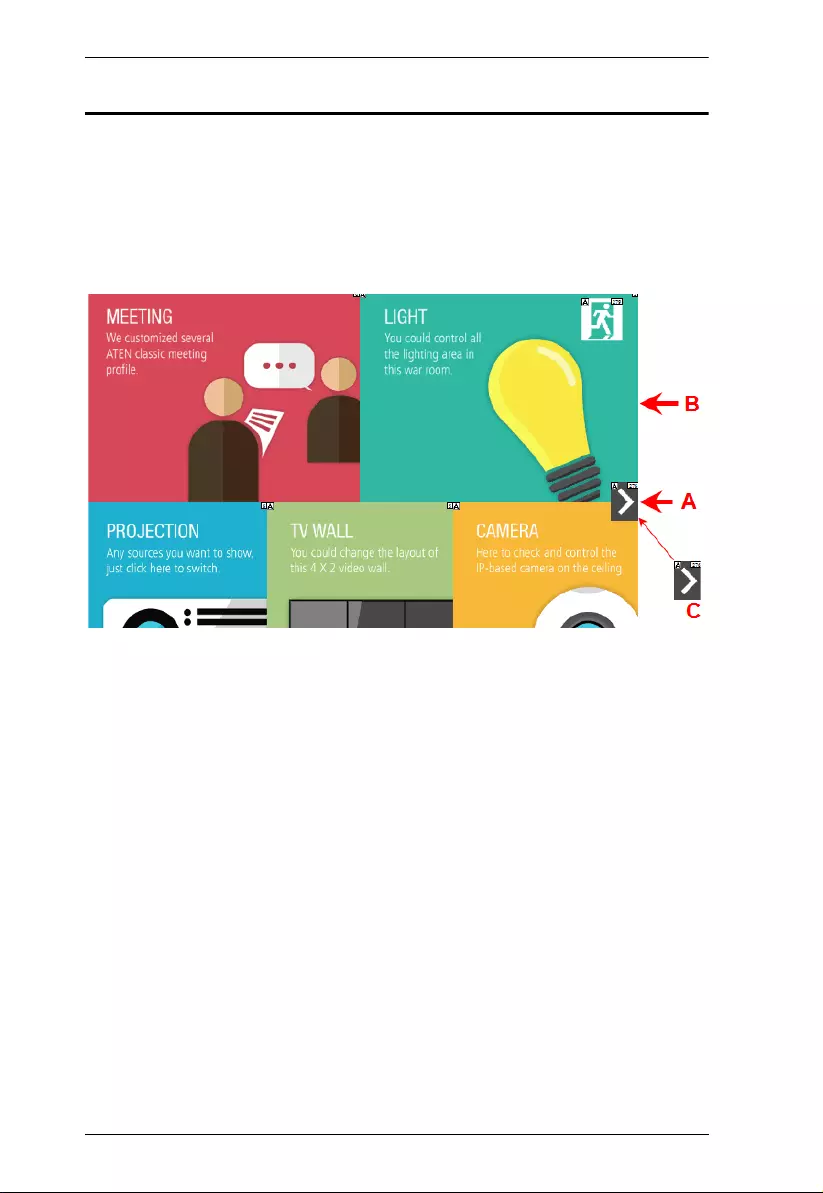
ATEN Control System User Manual
322
Windows OS Button Limitation
There is a limitation for overlapping buttons when adding buttons for a Viewer
to be used on Windows mobile devices. When two or more buttons are layered
on one another, such as (A) on top of (B), users are unable to press the top most
button (A), and instead triggers the bottom button (B) every time trying to press
(A). To resolve this issue, copy the top most button (A), and add the duplicate
(C) under both (A) and (B) on the Viewer.
When the top button (A) is pressed, the lowest button (C) is executed.

Appendix
323
Technical Support
International
For online technical support – including troubleshooting, documentation,
and software updates:
http://eservice.aten.com
For telephone support, see Telephone Support, page x:
North America
When you contact us, please have the following information ready beforehand:
Product model number, serial number, and date of purchase.
Your computer configuration, including operating system, revision level,
expansion cards, and software.
Any error messages displayed at the time the error occurred.
The sequence of operations that led up to the error.
Any other information you feel may be of help.
Email Support support@aten-usa.com
Online
Technical
Support
Troubleshooting
Documentation
Software Updates
https://eservice.aten.com
Telephone Support 1-888-999-ATEN ext 4988

ATEN Control System User Manual
324
Limited Warranty
ATEN warrants its hardware in the country of purchase against flaws in
materials and workmanship for a Warranty Period of two [2] years (warranty
period may vary in certain regions/countries) commencing on the date of
original purchase. This warranty period includes the LCD panel of ATEN LCD
KVM switches. Select products are warranted for an additional year (see A+
Warranty for further details). Cables and accessories are not covered by the
Standard Warranty.
What is covered by the Limited Hardware Warranty
ATEN will provide a repair service, without charge, during the Warranty
Period. If a product is detective, ATEN will, at its discretion, have the option
to (1) repair said product with new or repaired components, or (2) replace the
entire product with an identical product or with a similar product which fulfills
the same function as the defective product. Replaced products assume the
warranty of the original product for the remaining period or a period of 90 days,
whichever is longer. When the products or components are replaced, the
replacing articles shall become customer property and the replaced articles
shall become the property of ATEN.
To learn more about our warranty policies, please visit our website:
http://www.aten.com/global/en/legal/policies/warranty-policy/
© Copyright 2021 ATEN® International Co., Ltd.
Released: 2021-06-30
ATEN and the ATEN logo are registered trademarks of ATEN International Co., Ltd. All rights reserved.
All other brand names and trademarks are the registered property of their respective owners.


